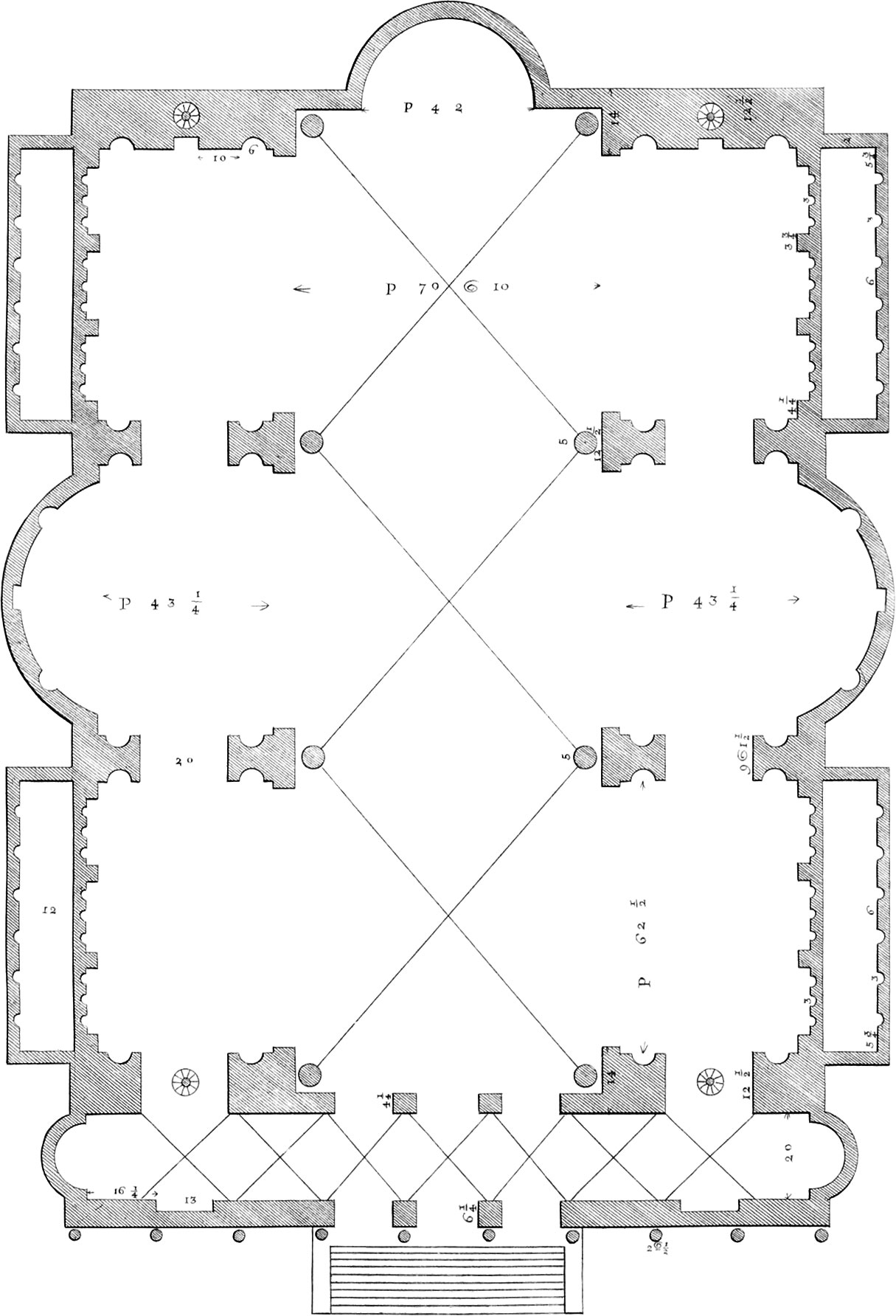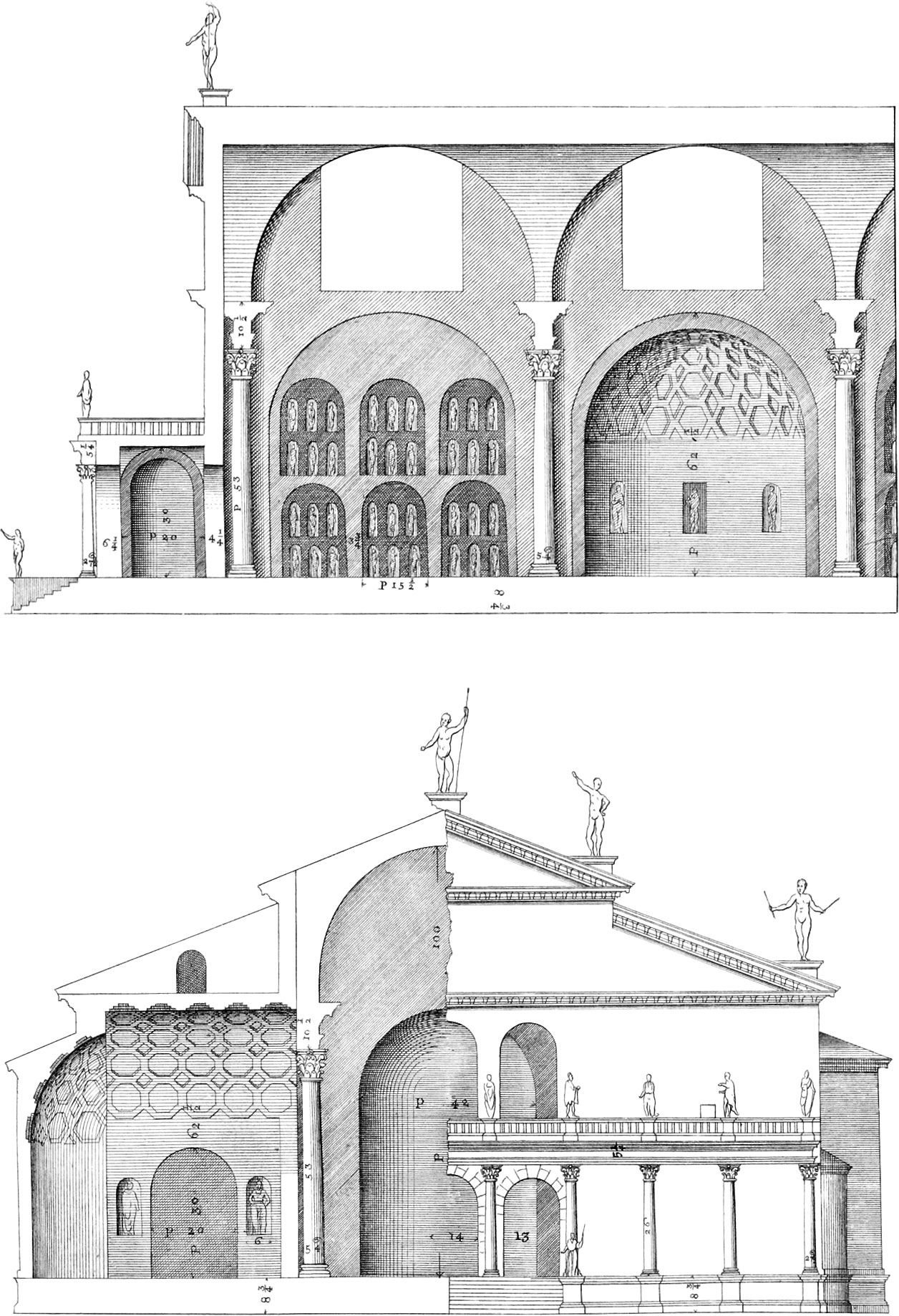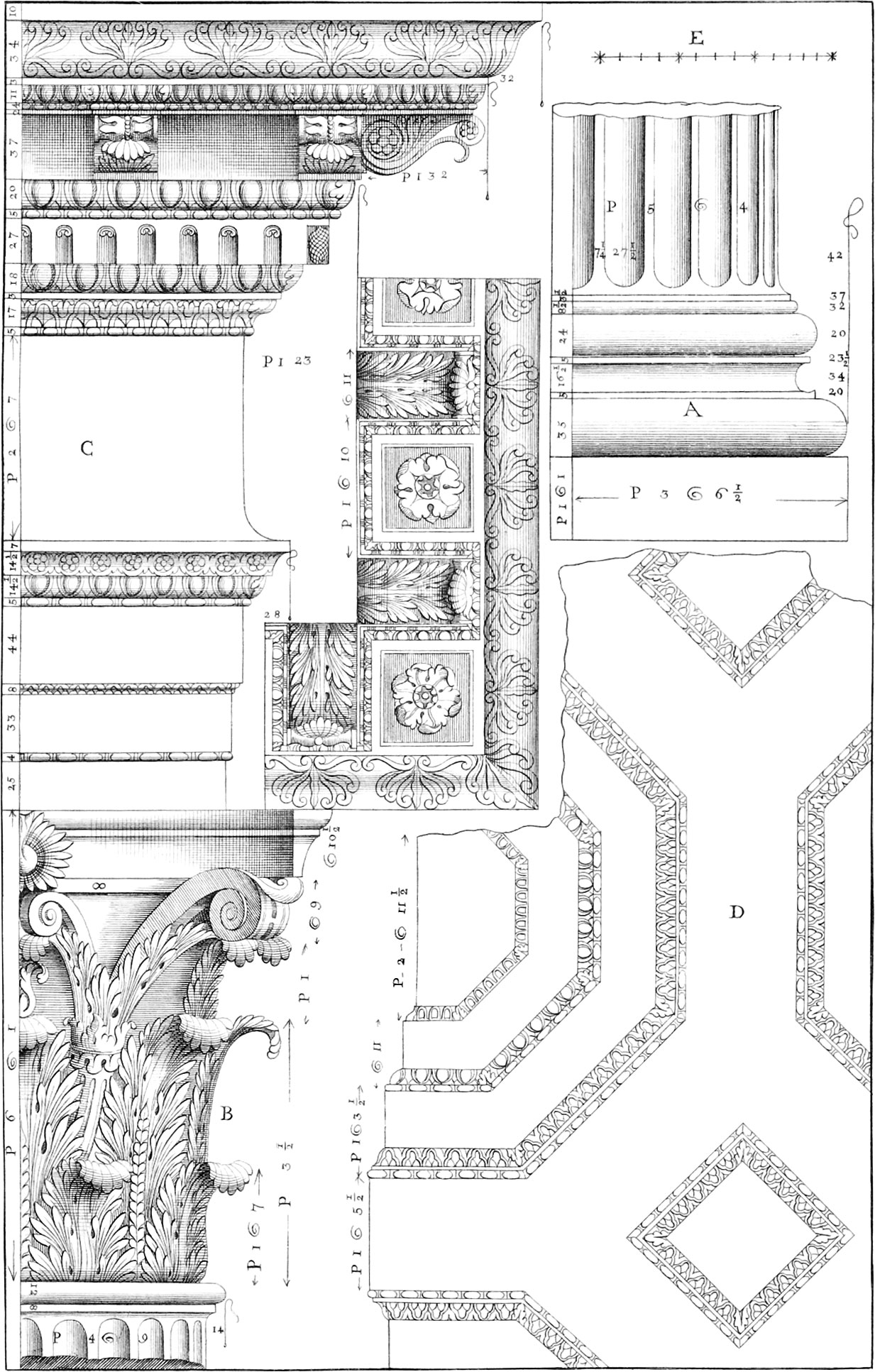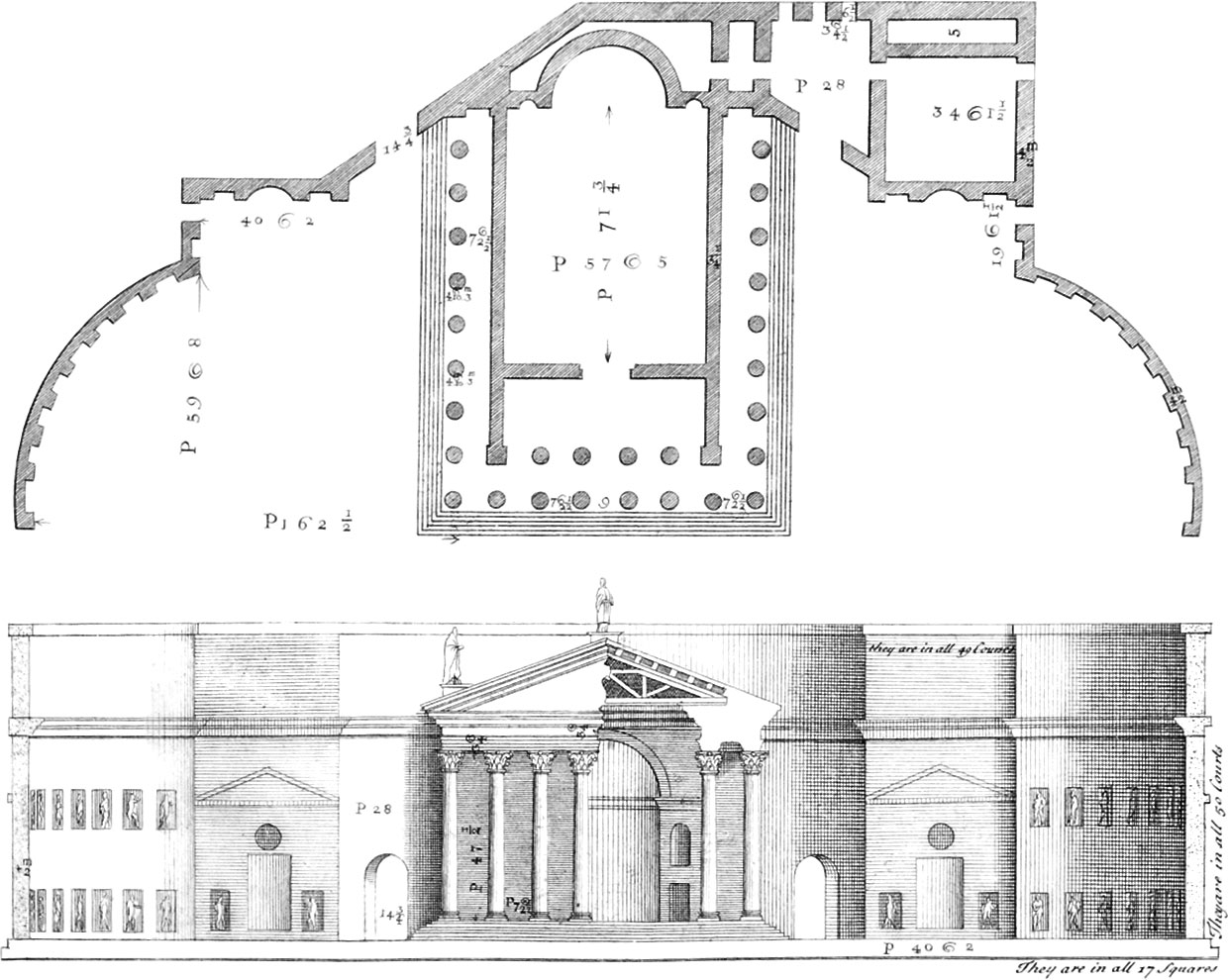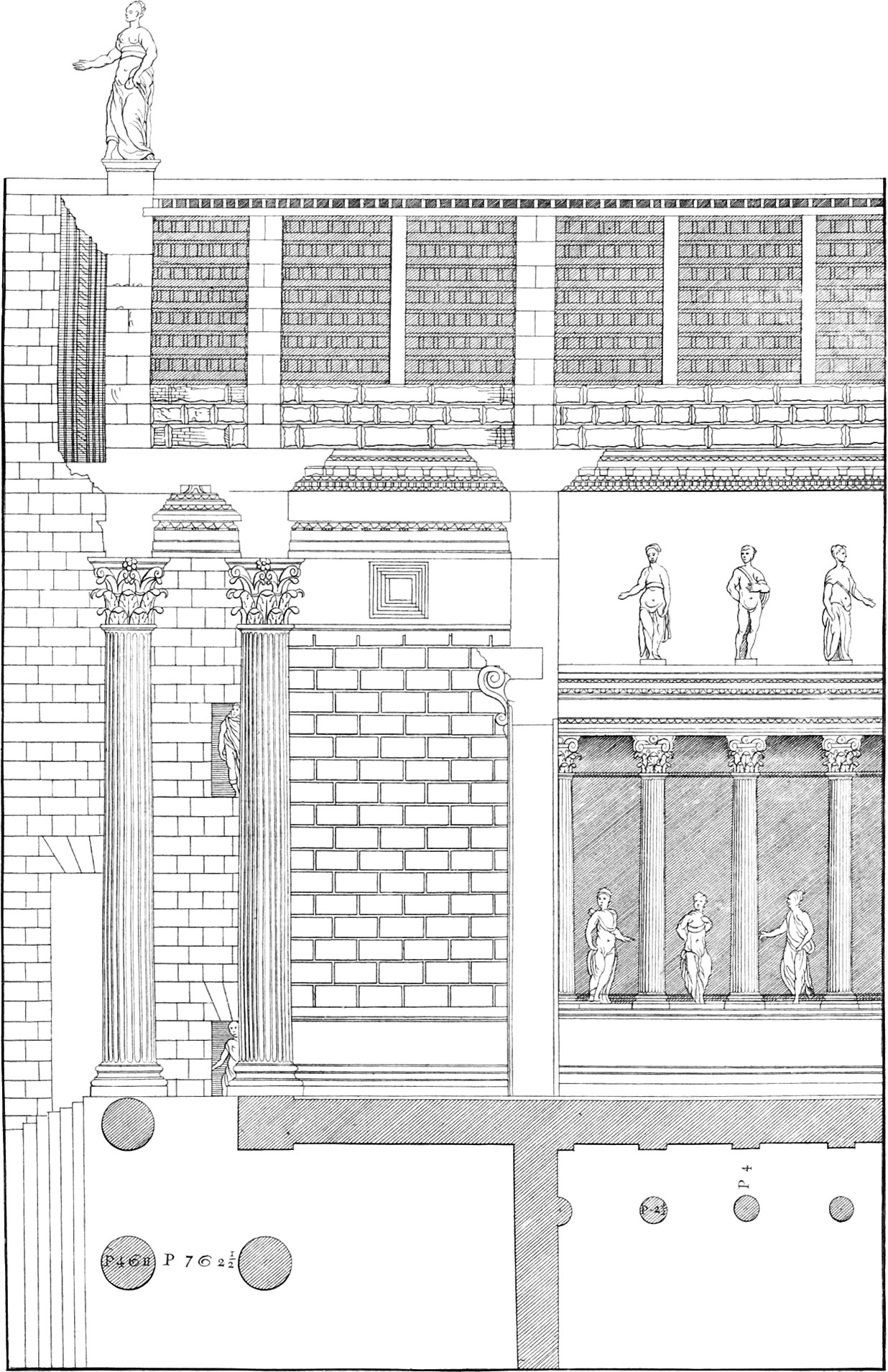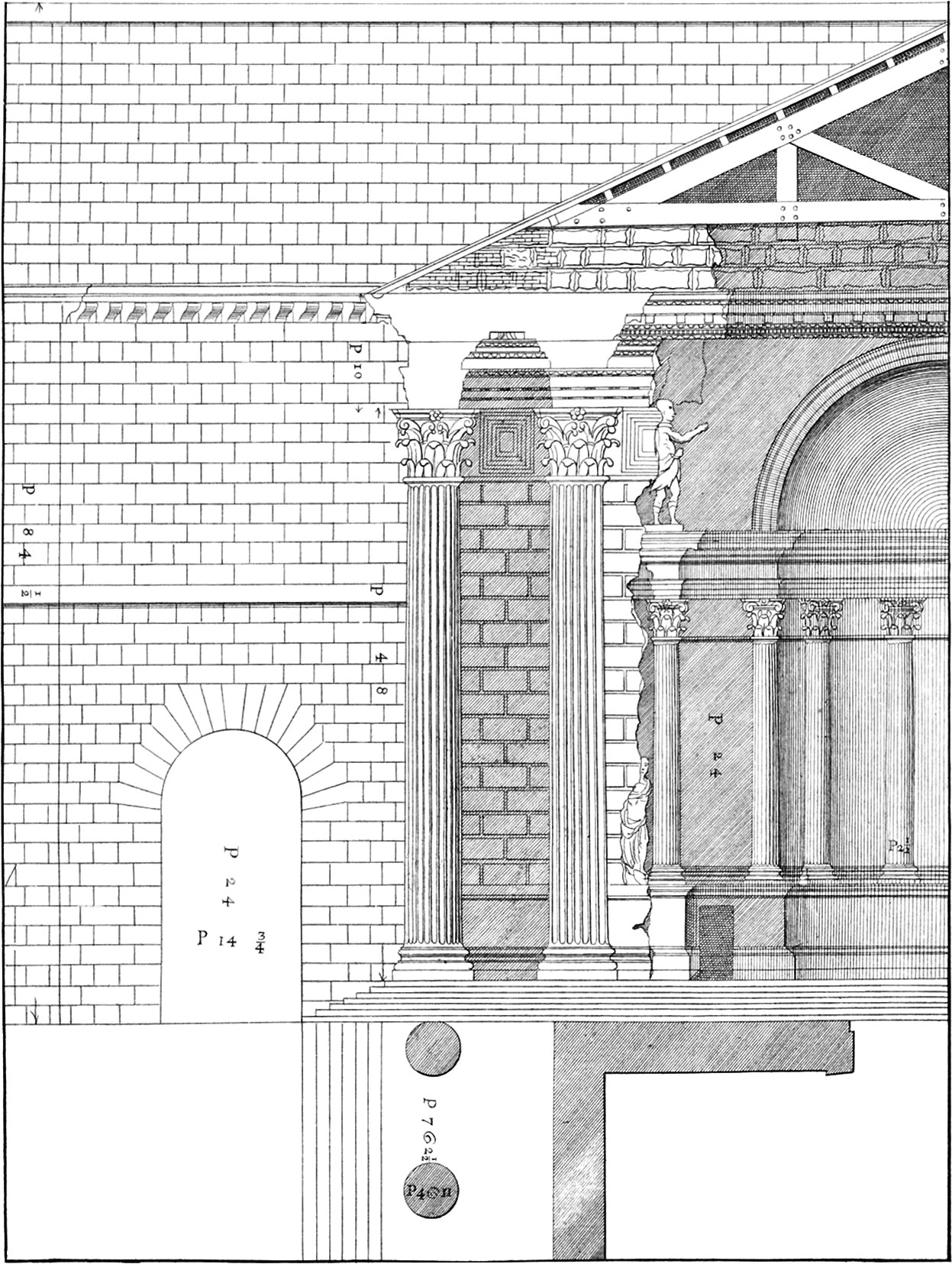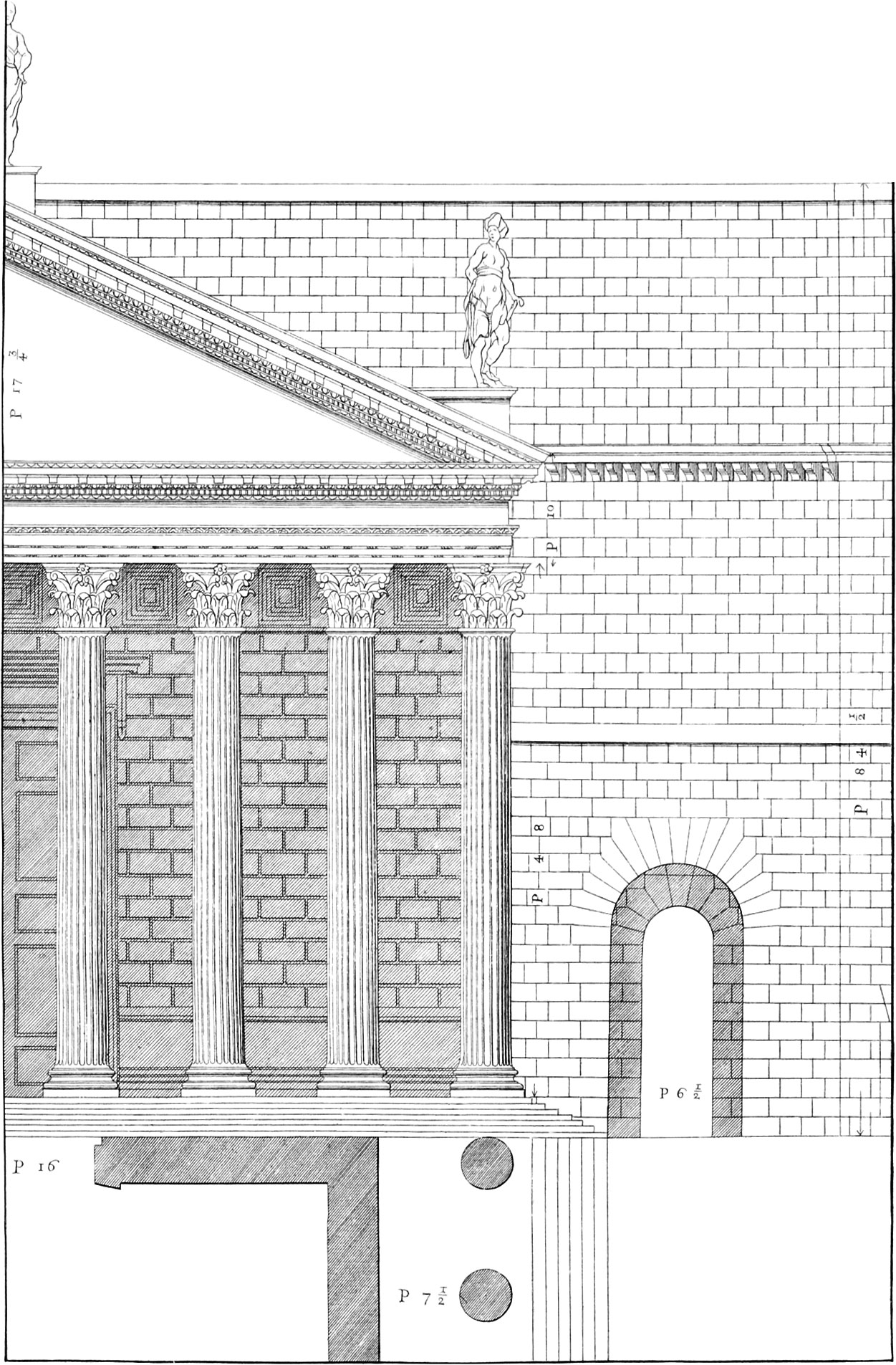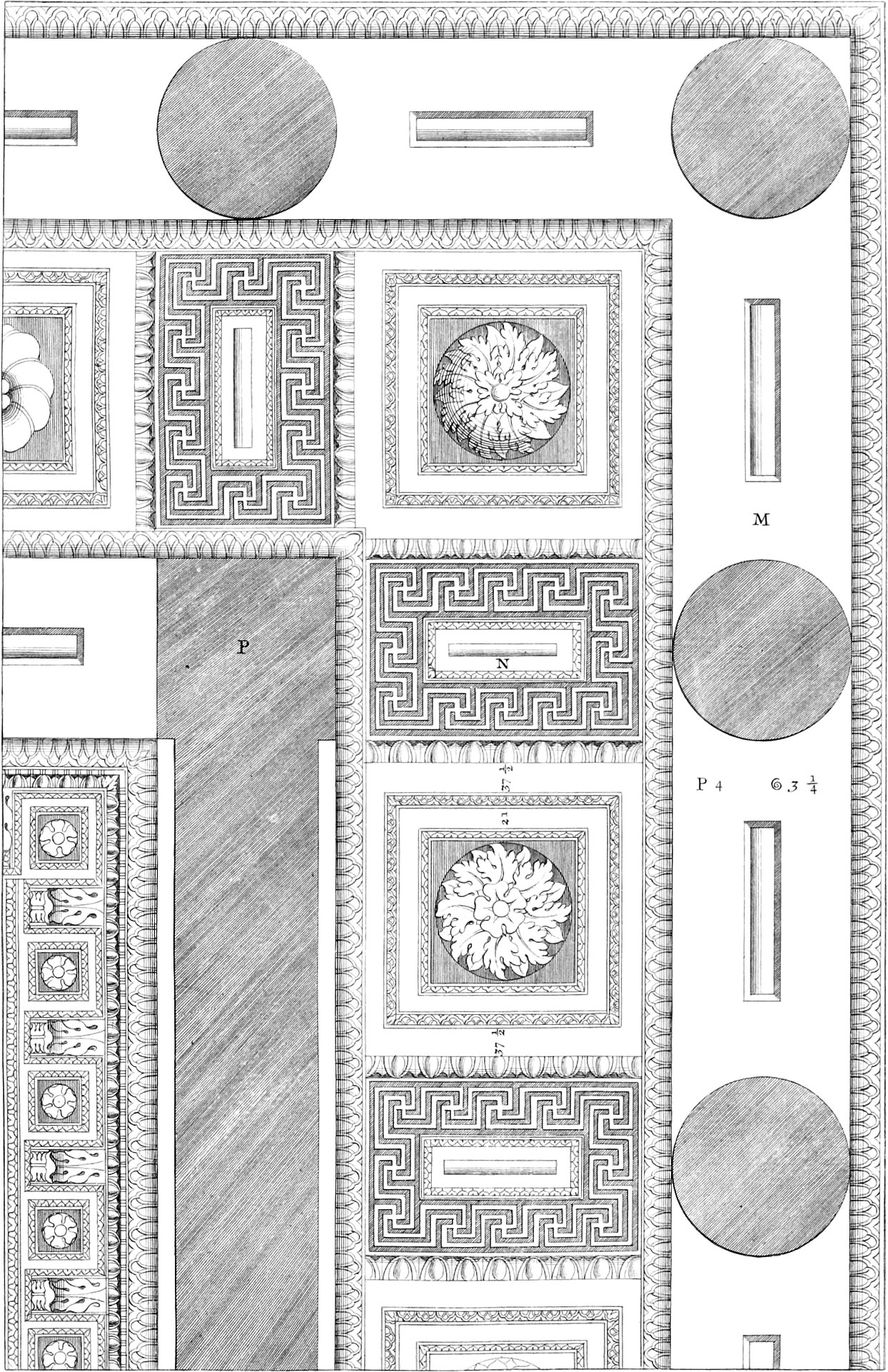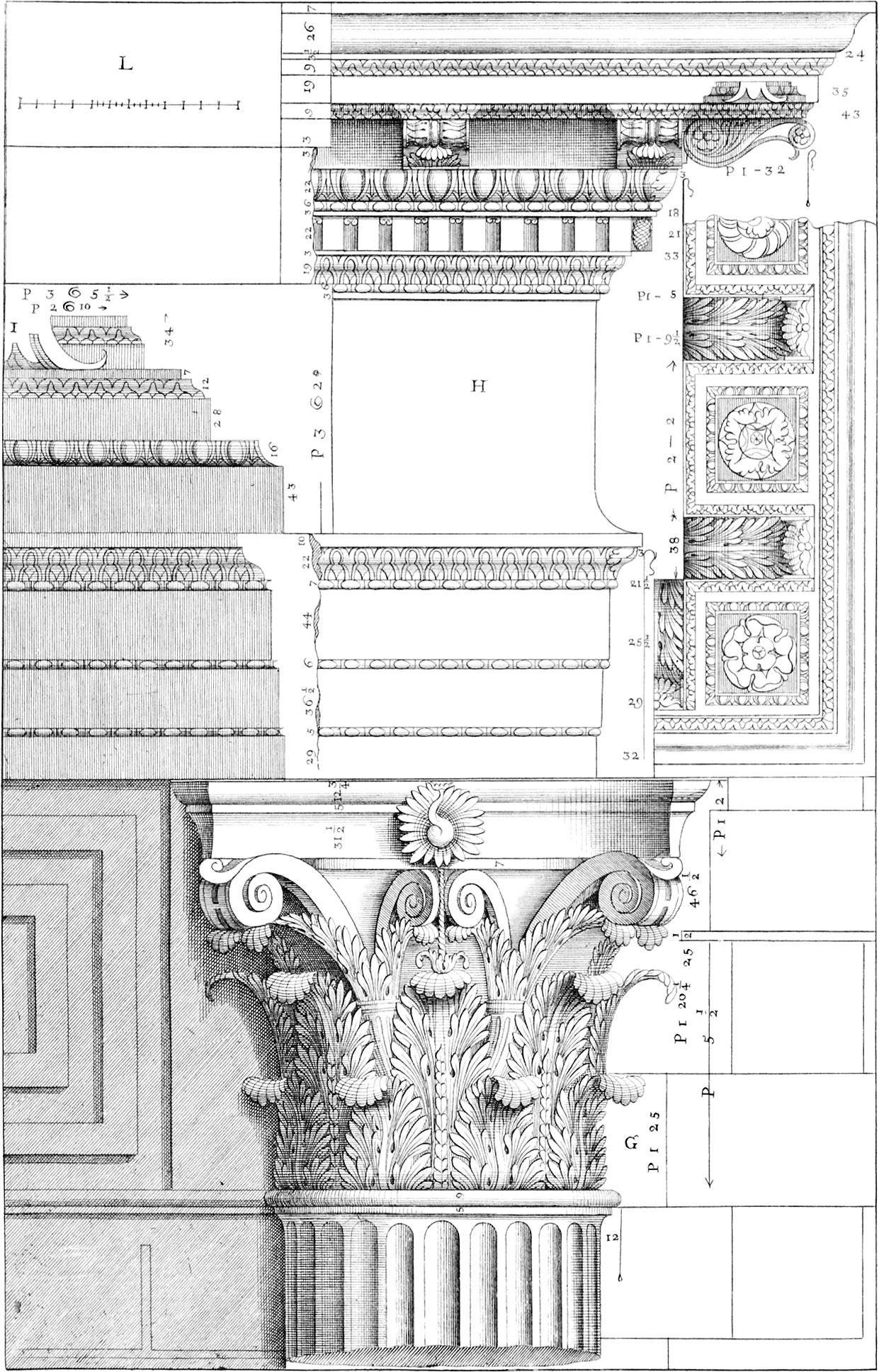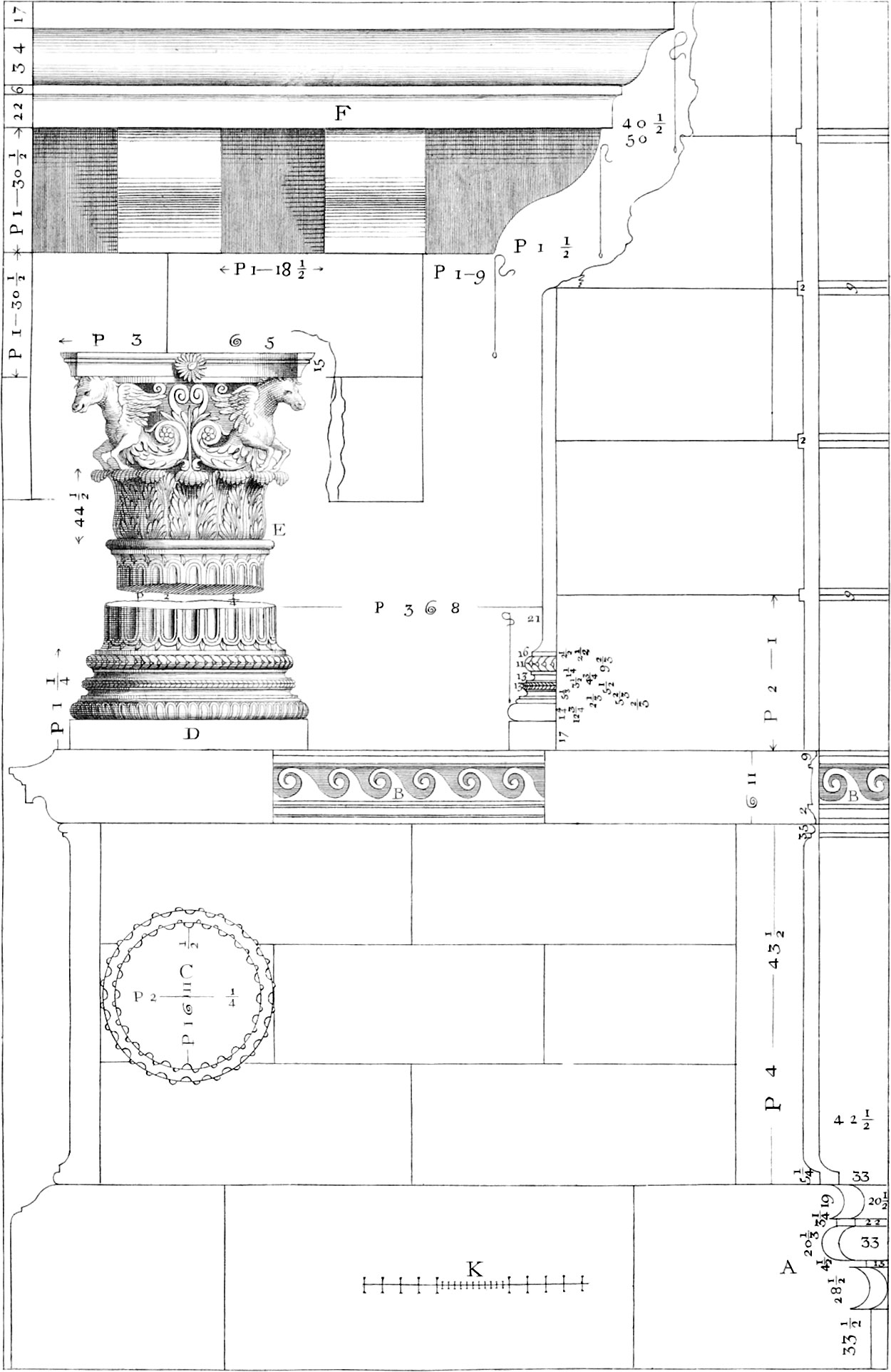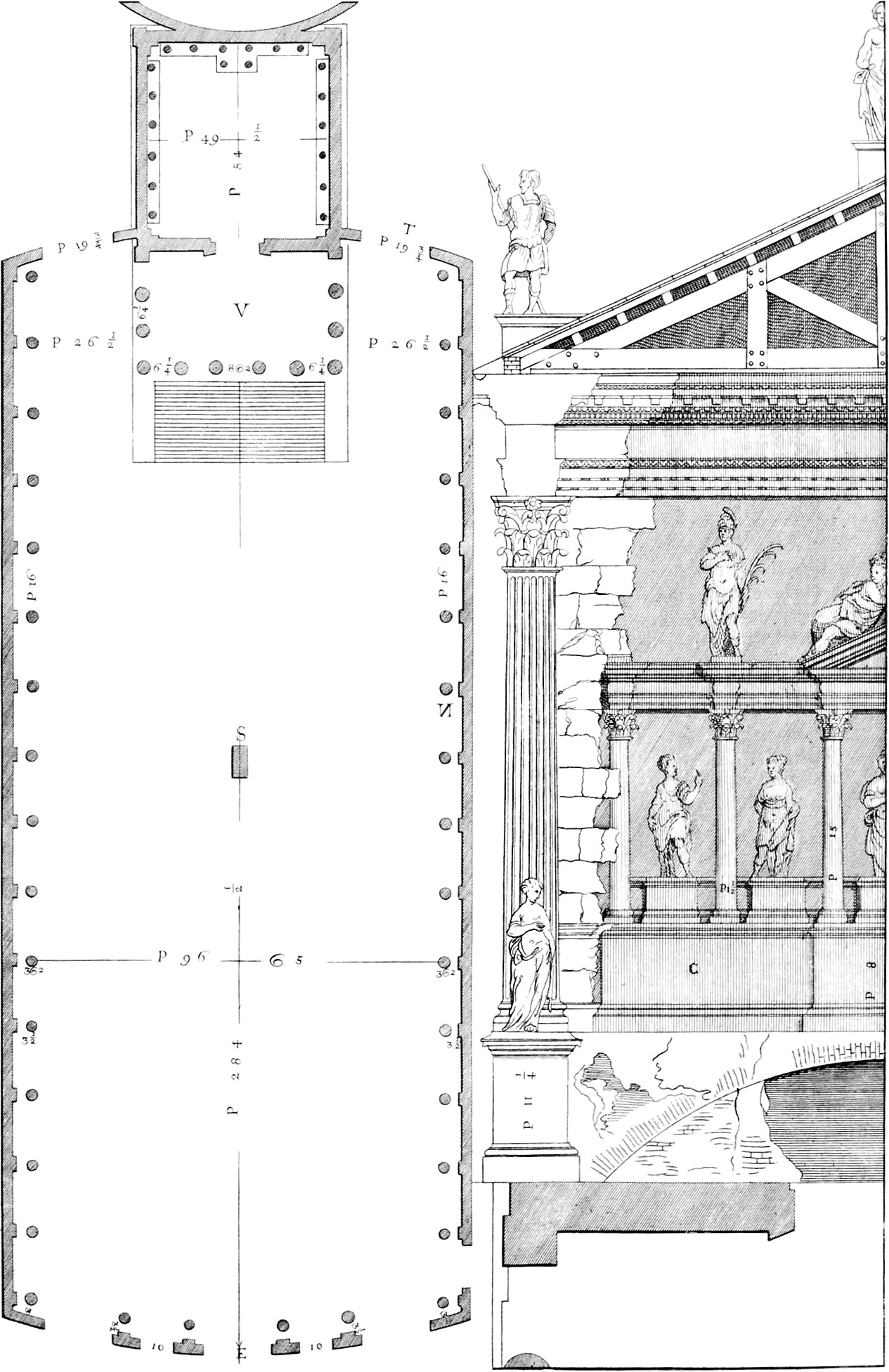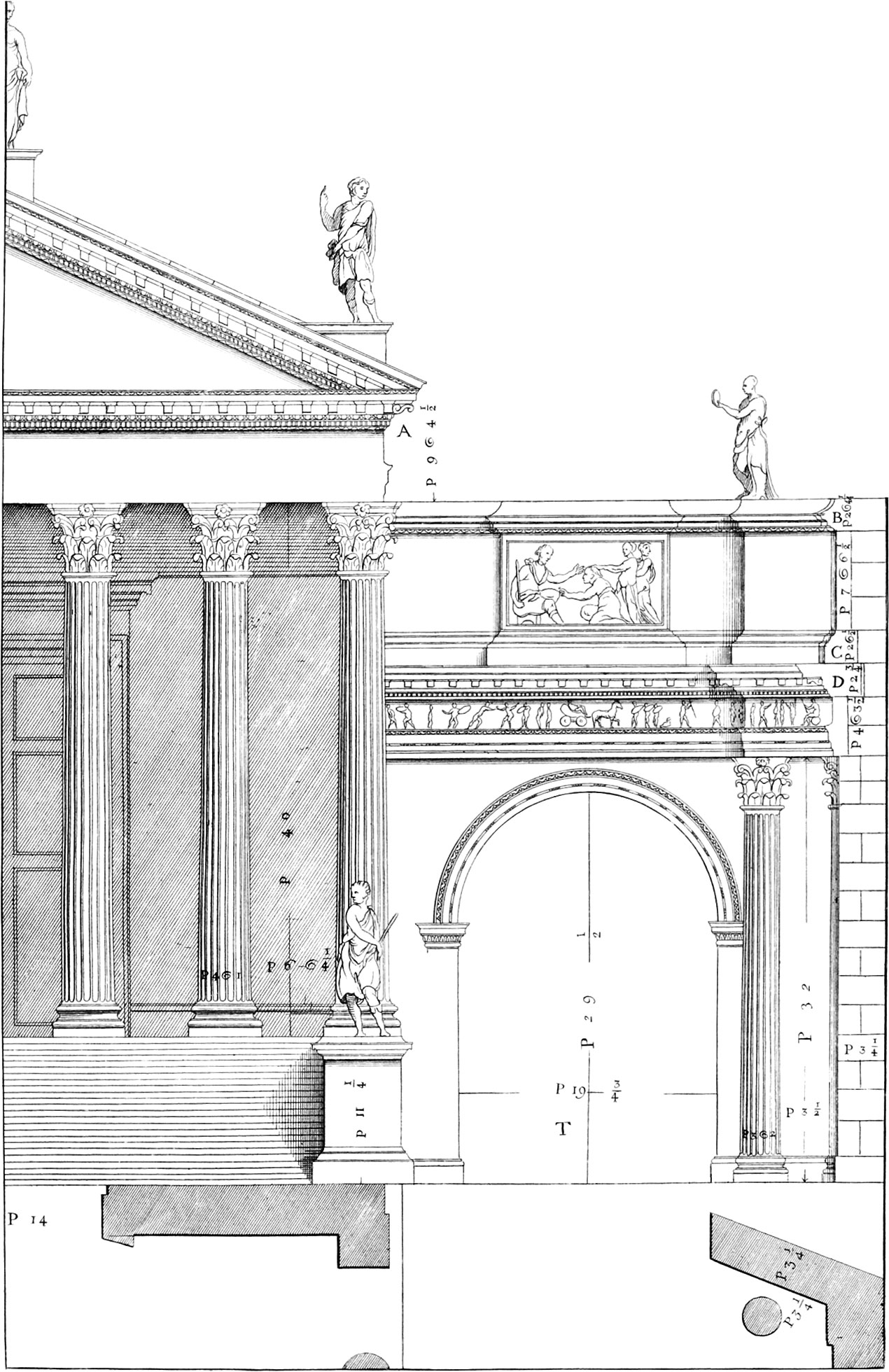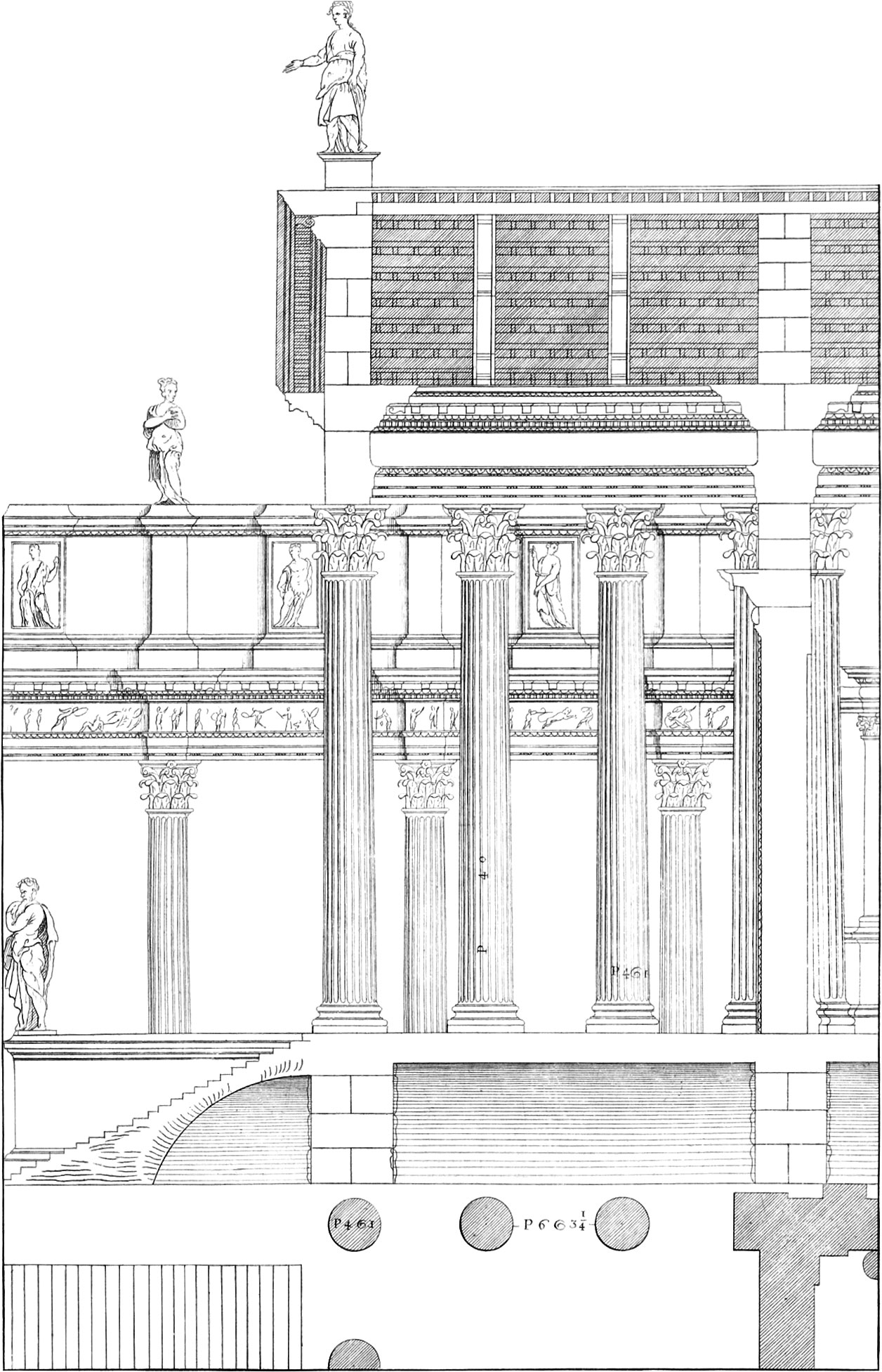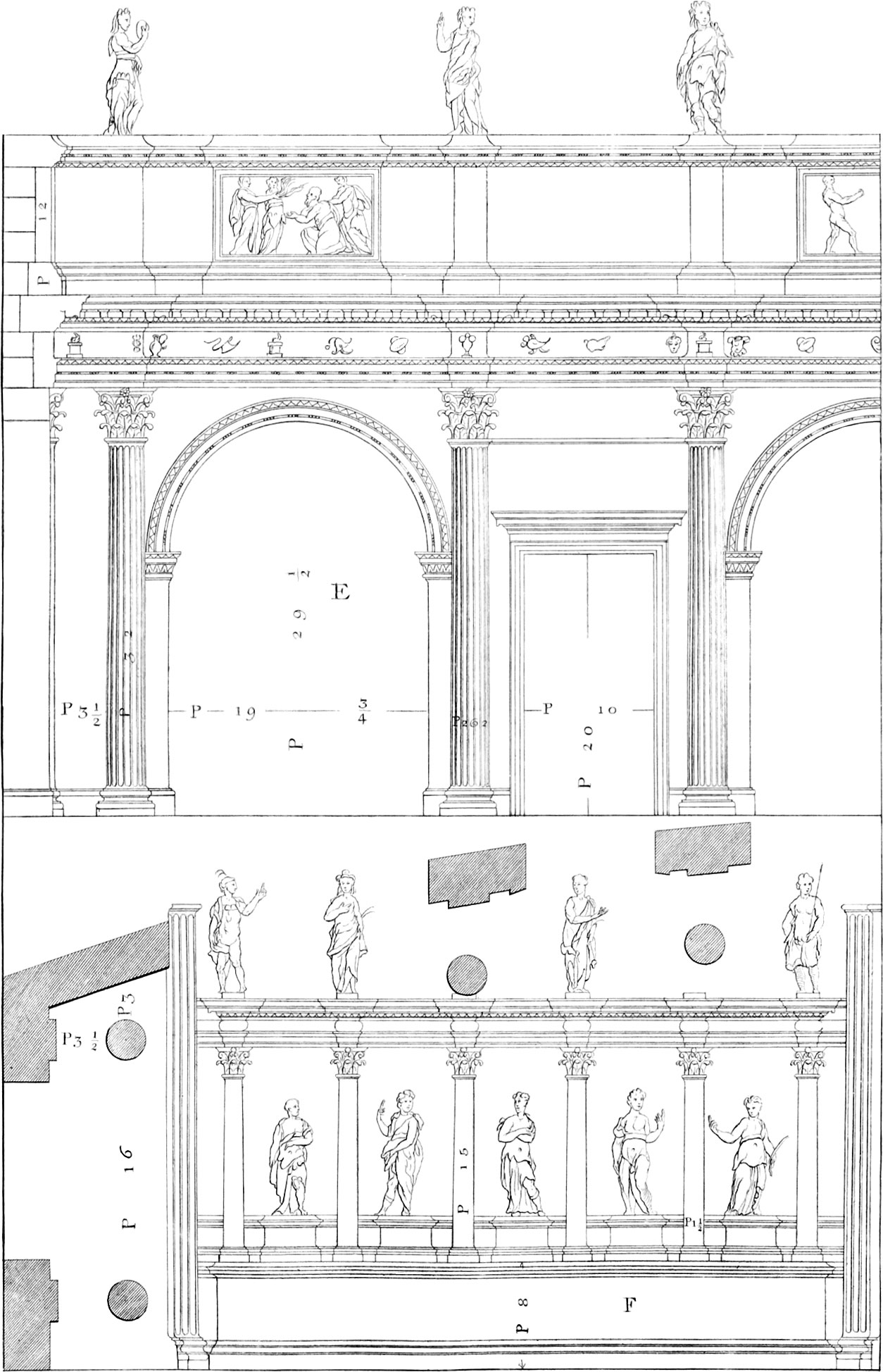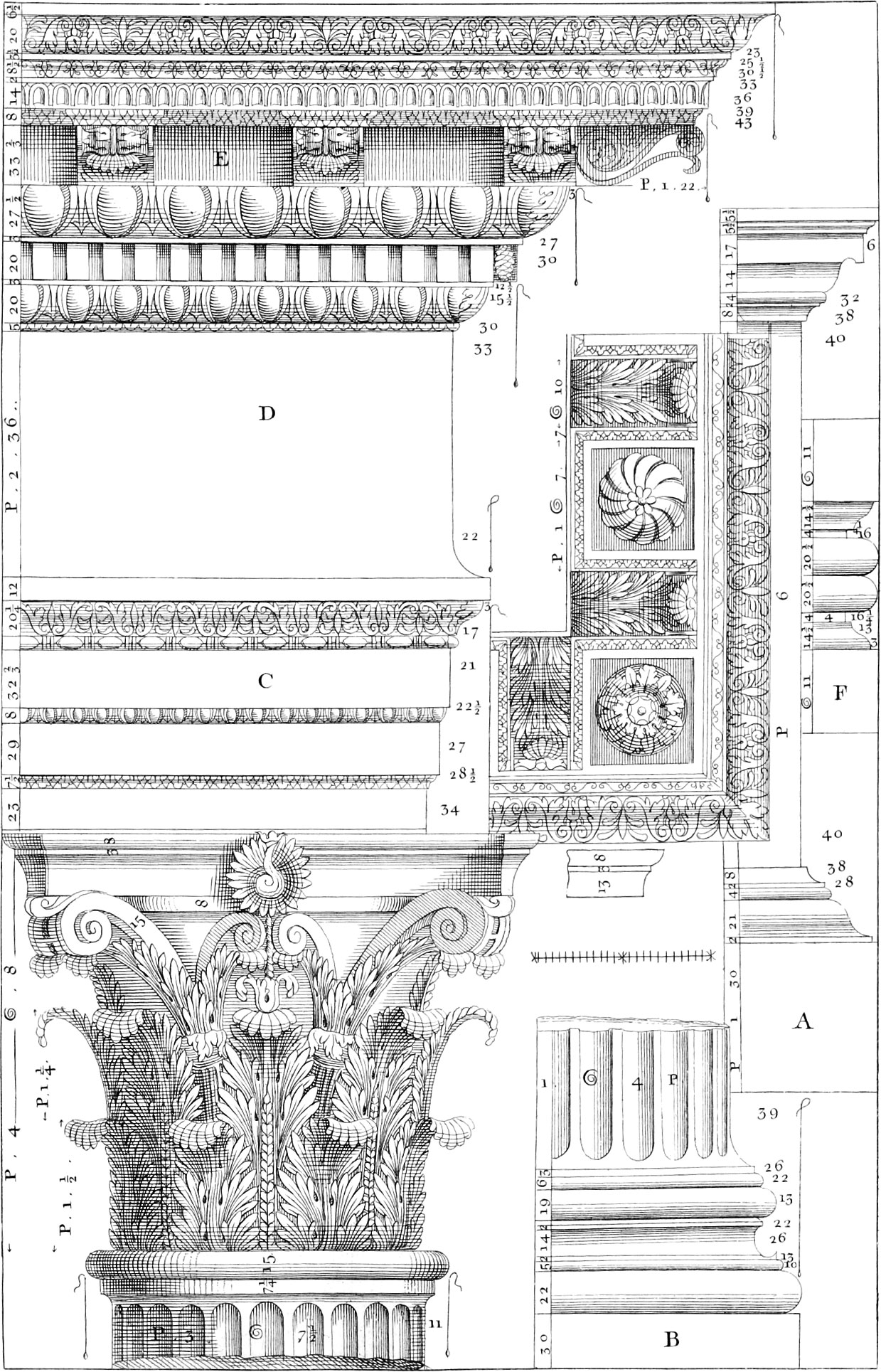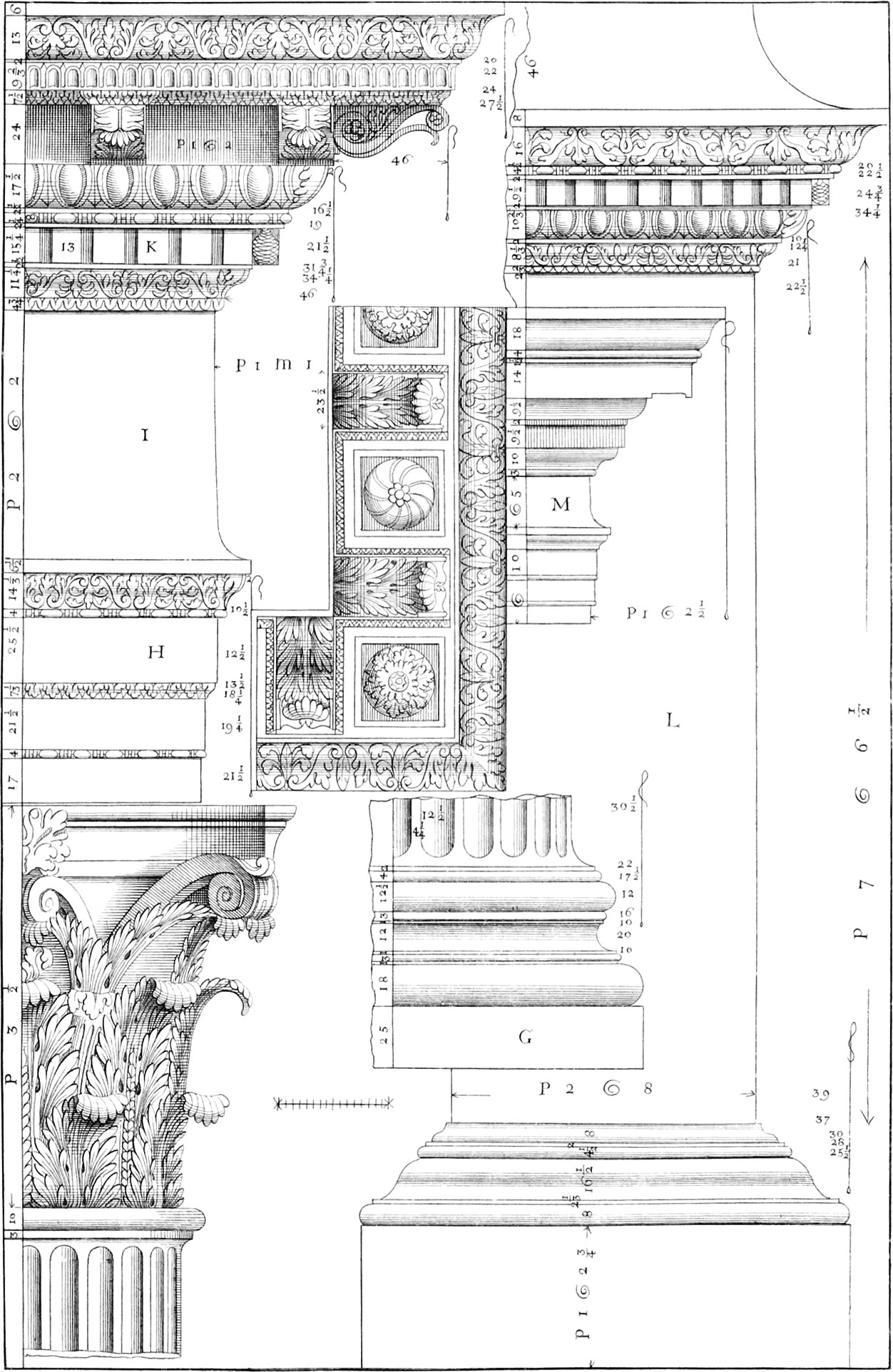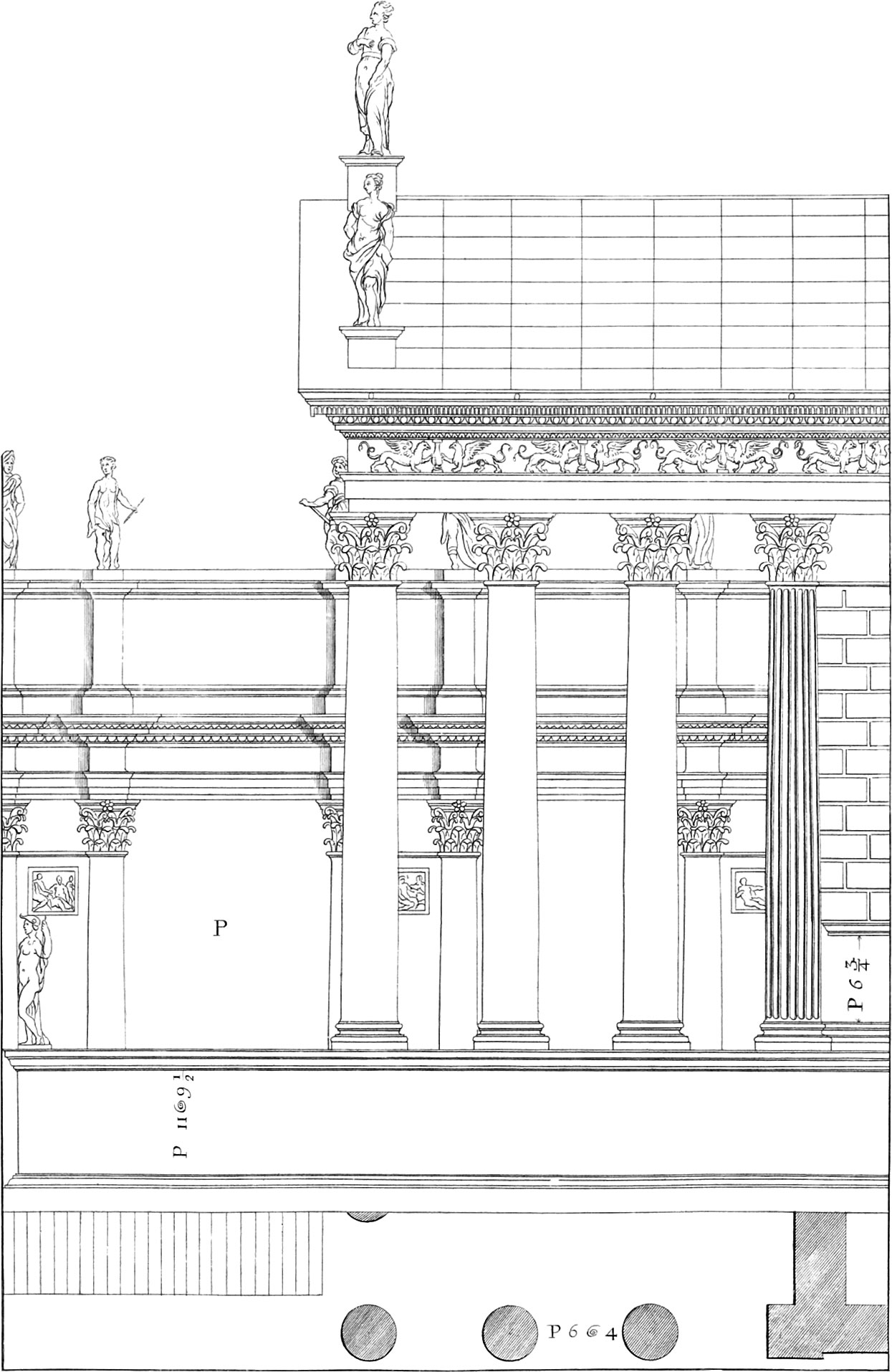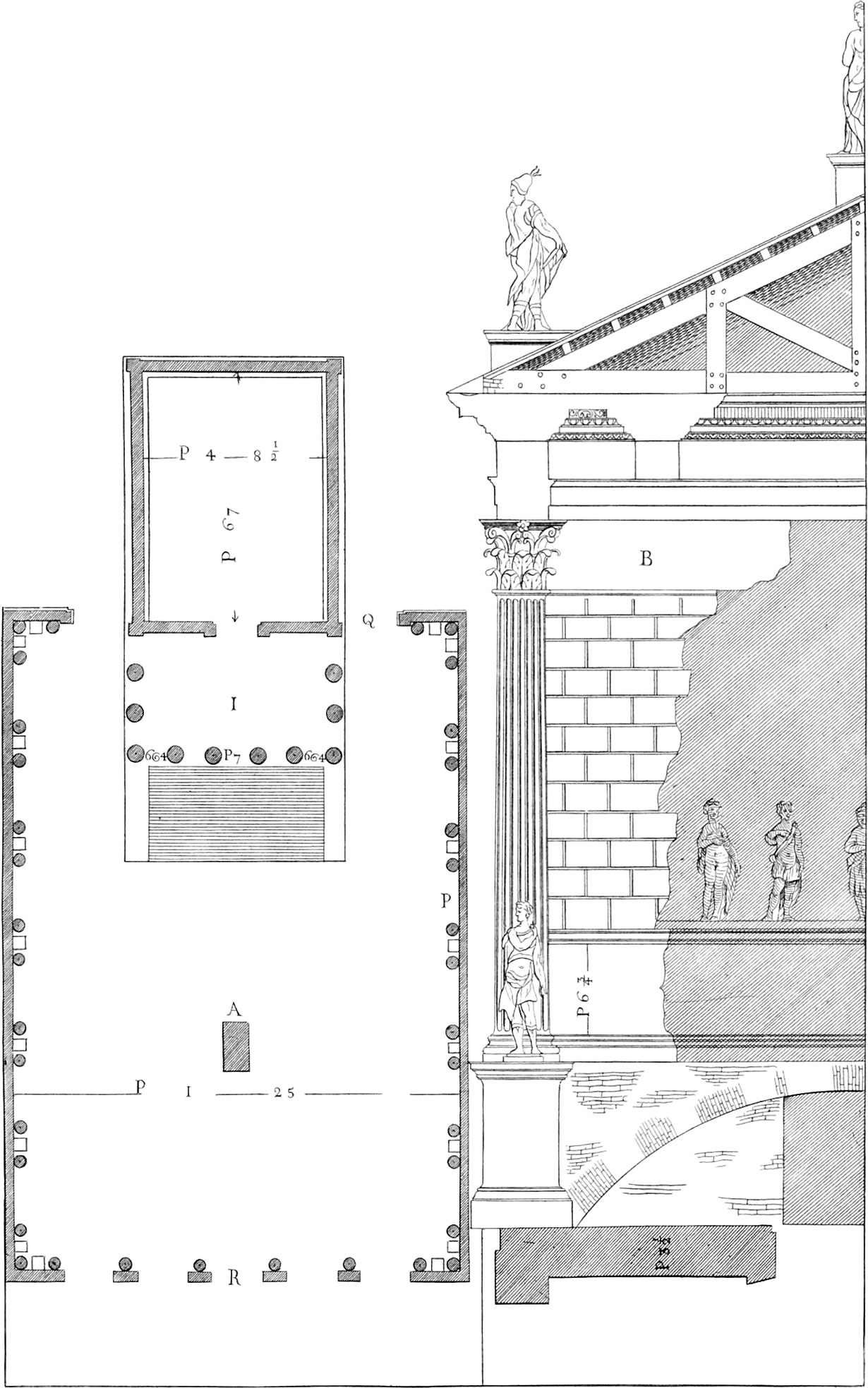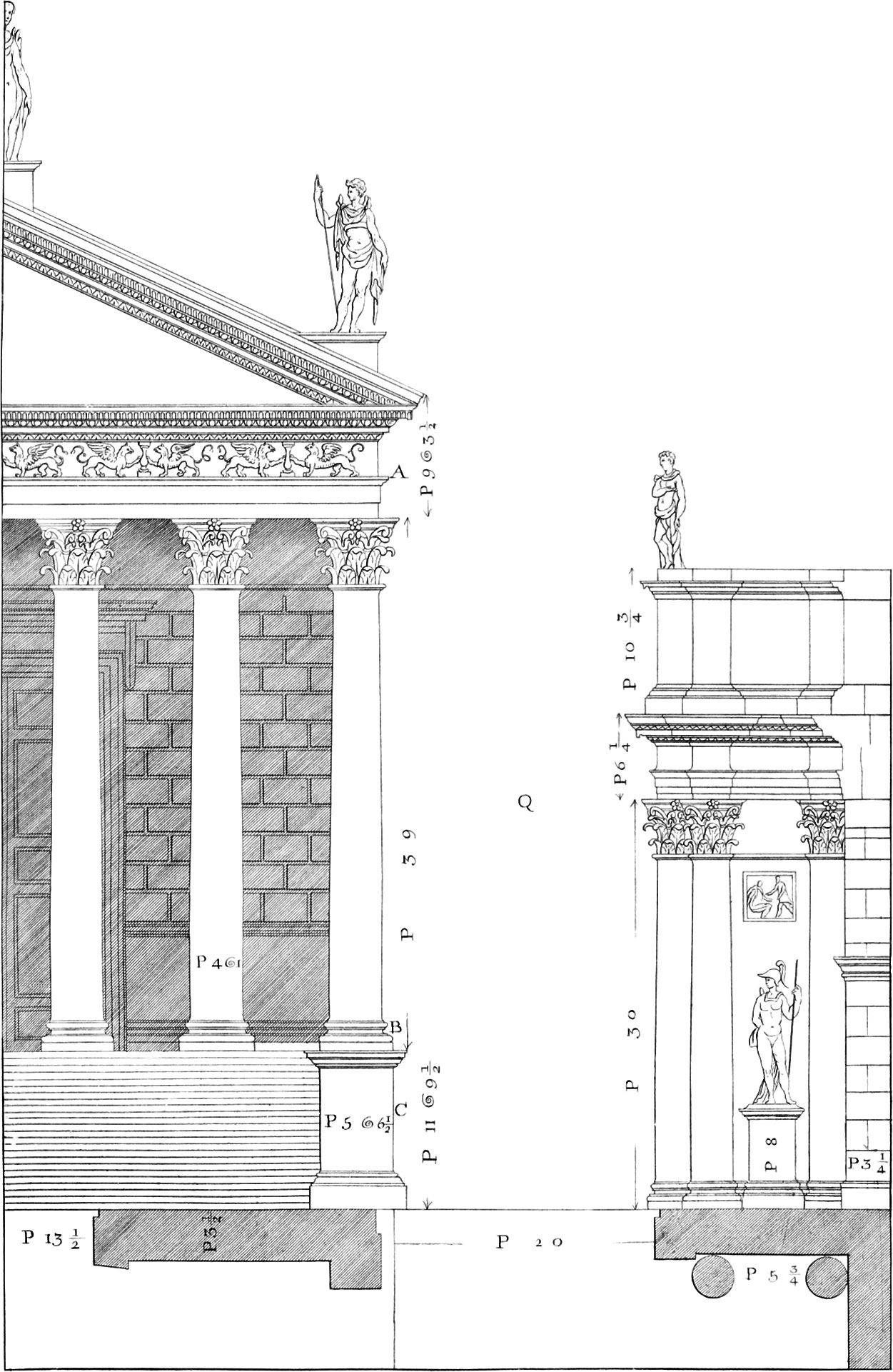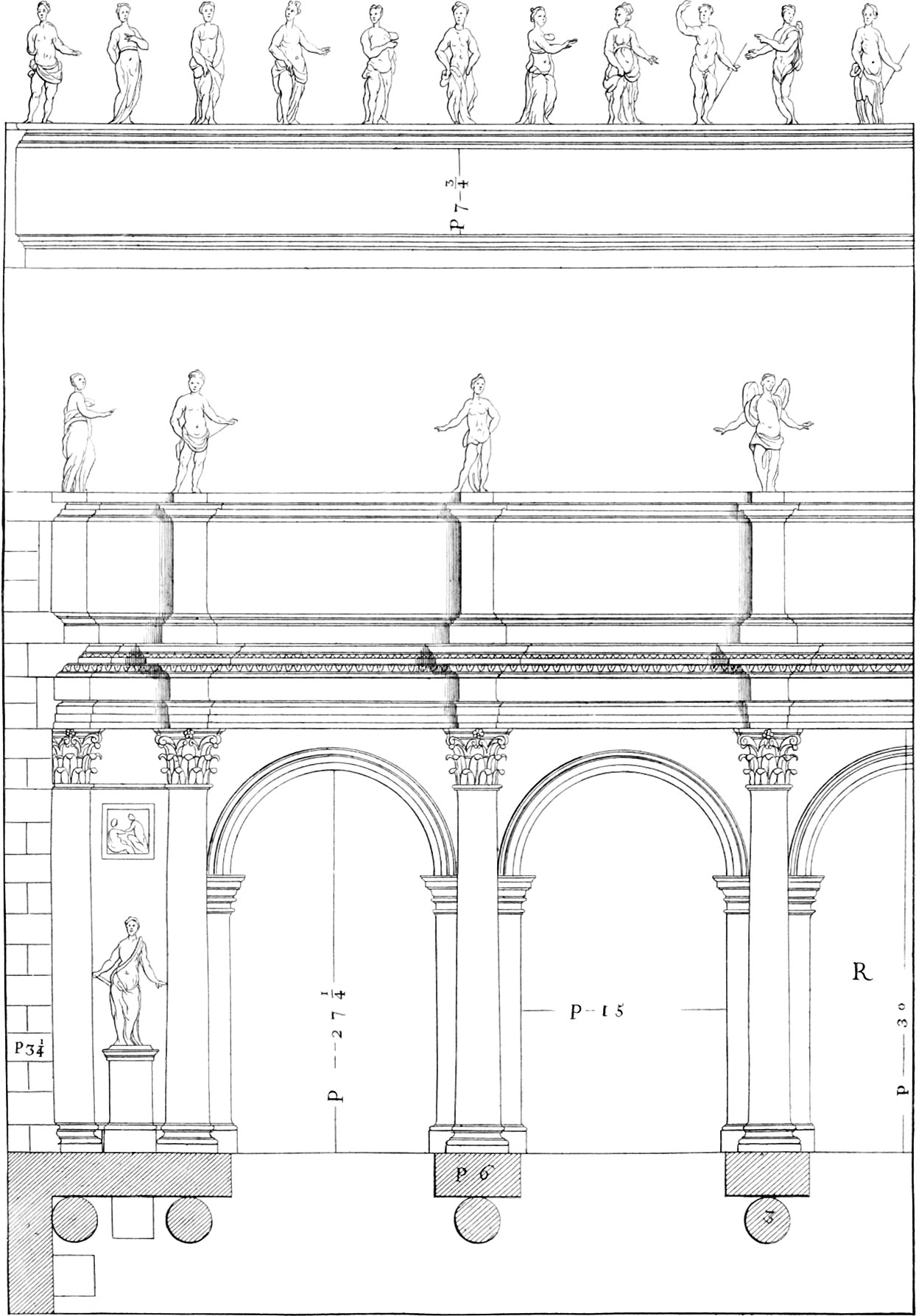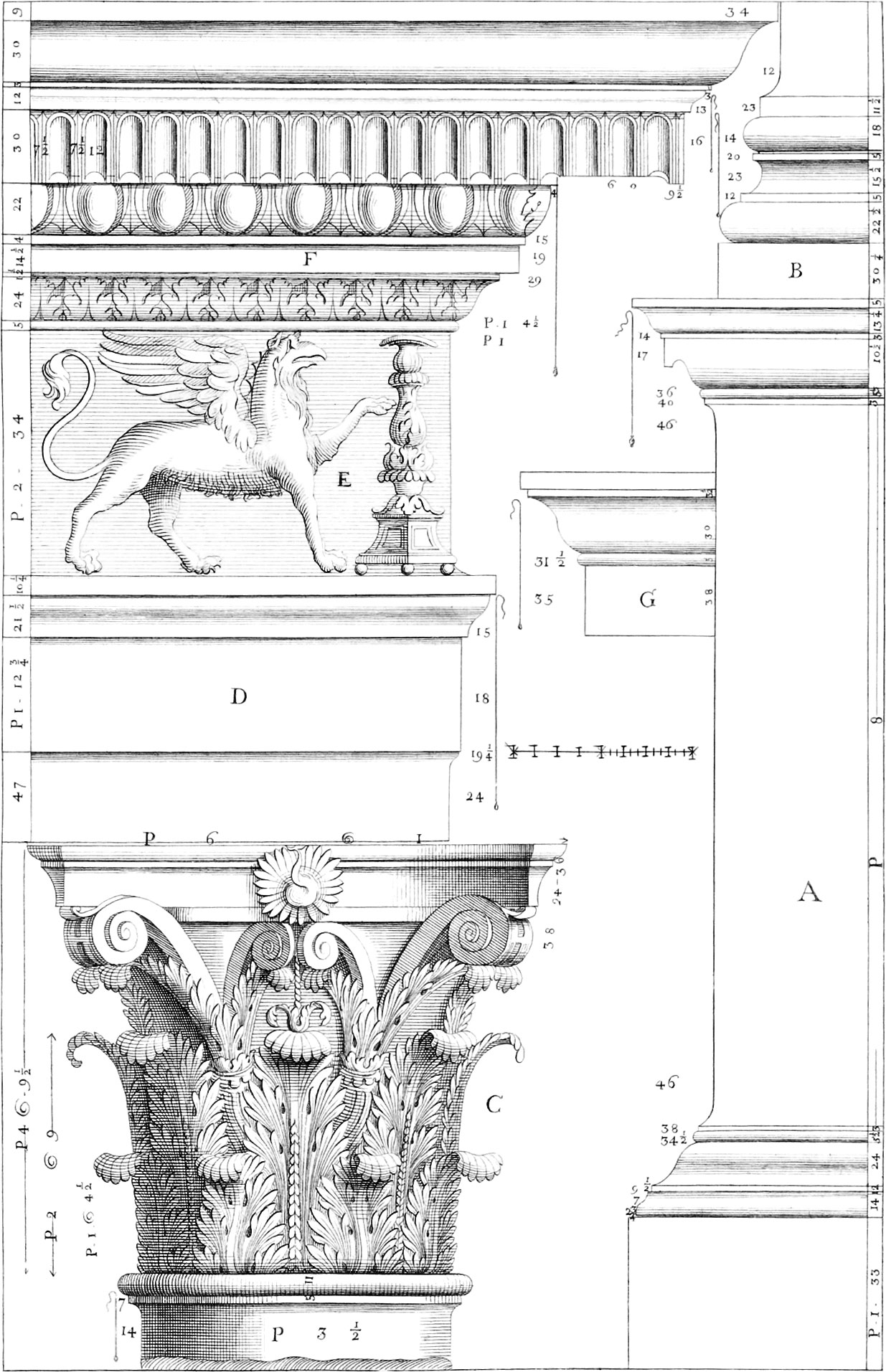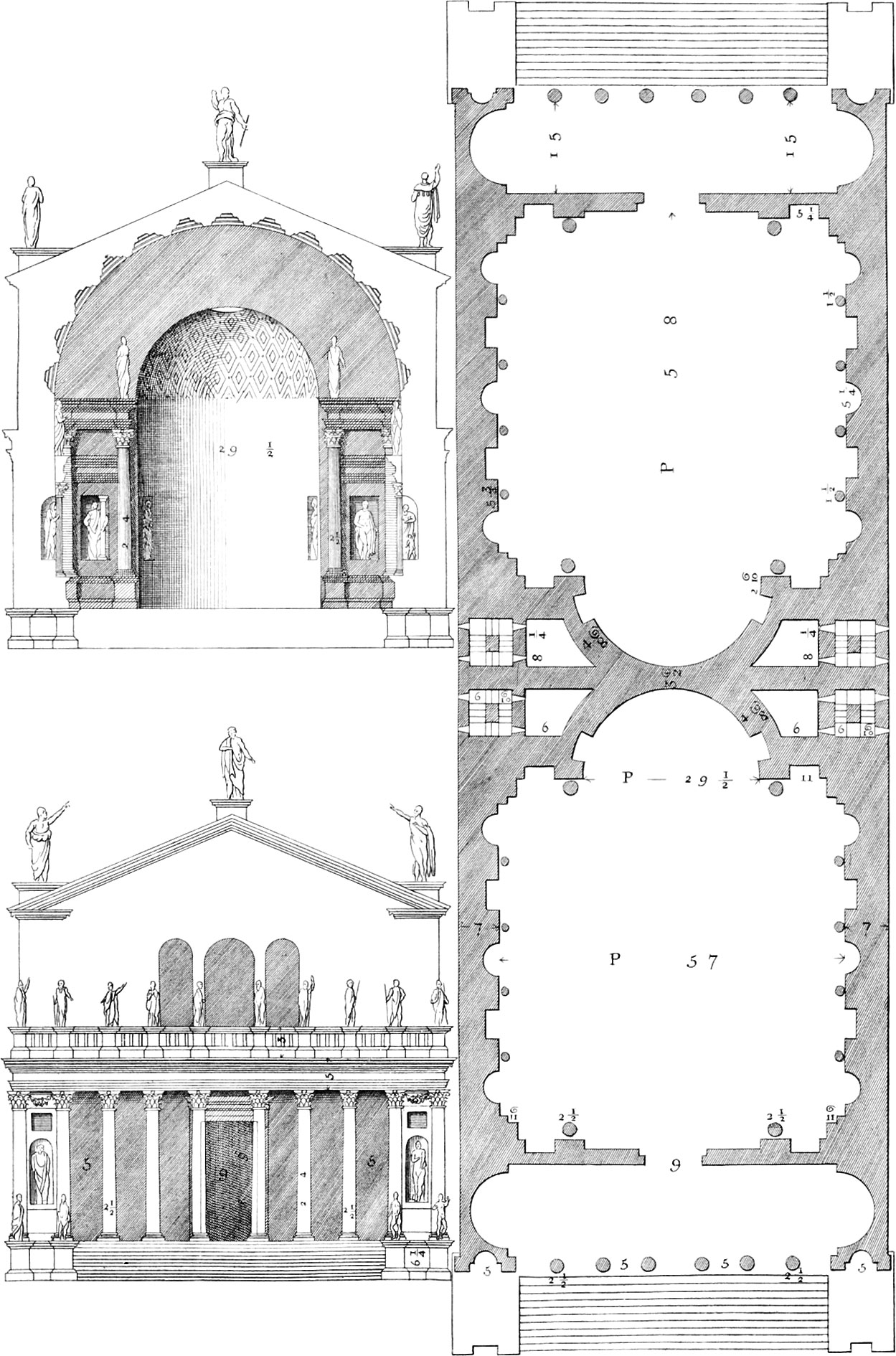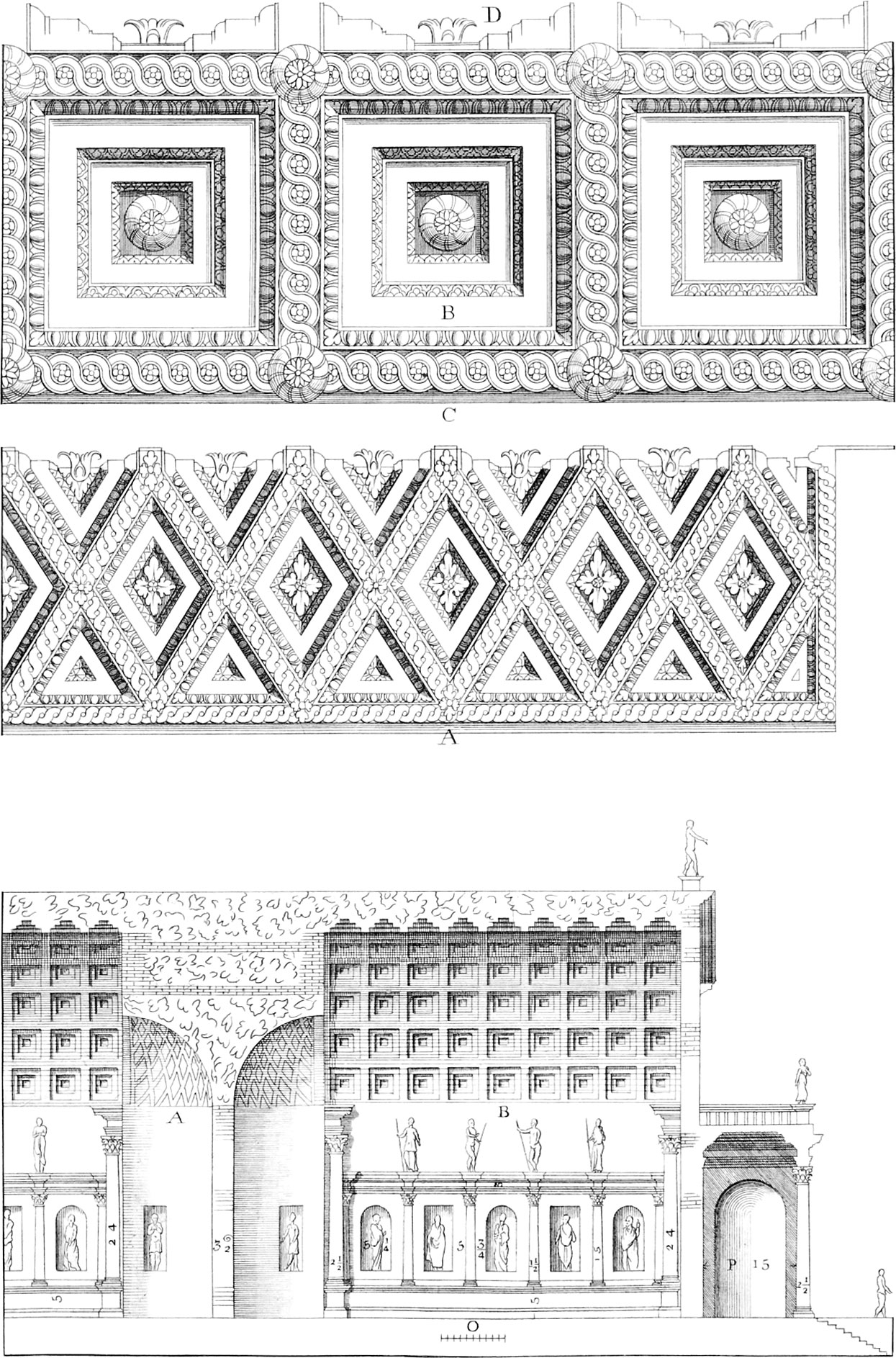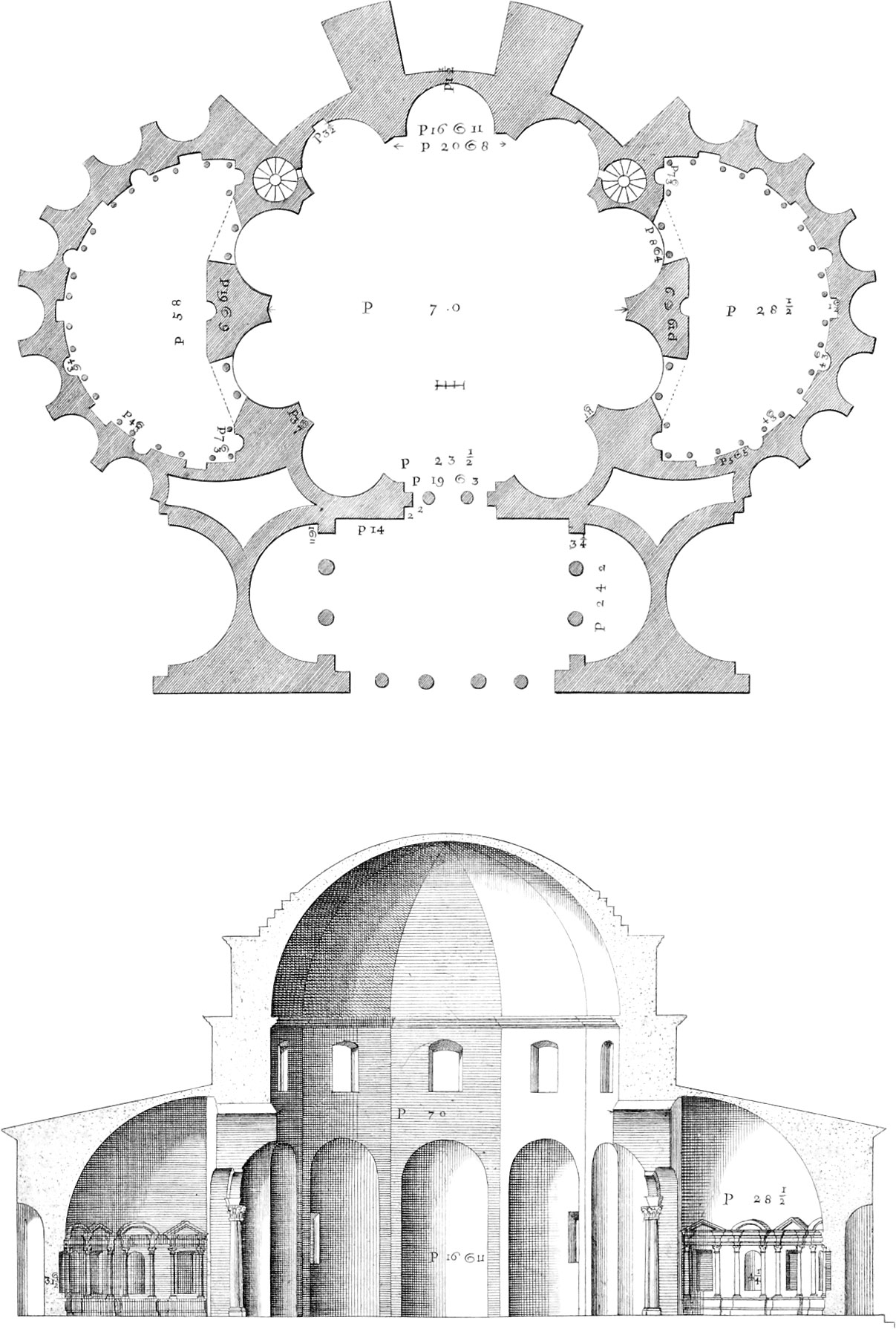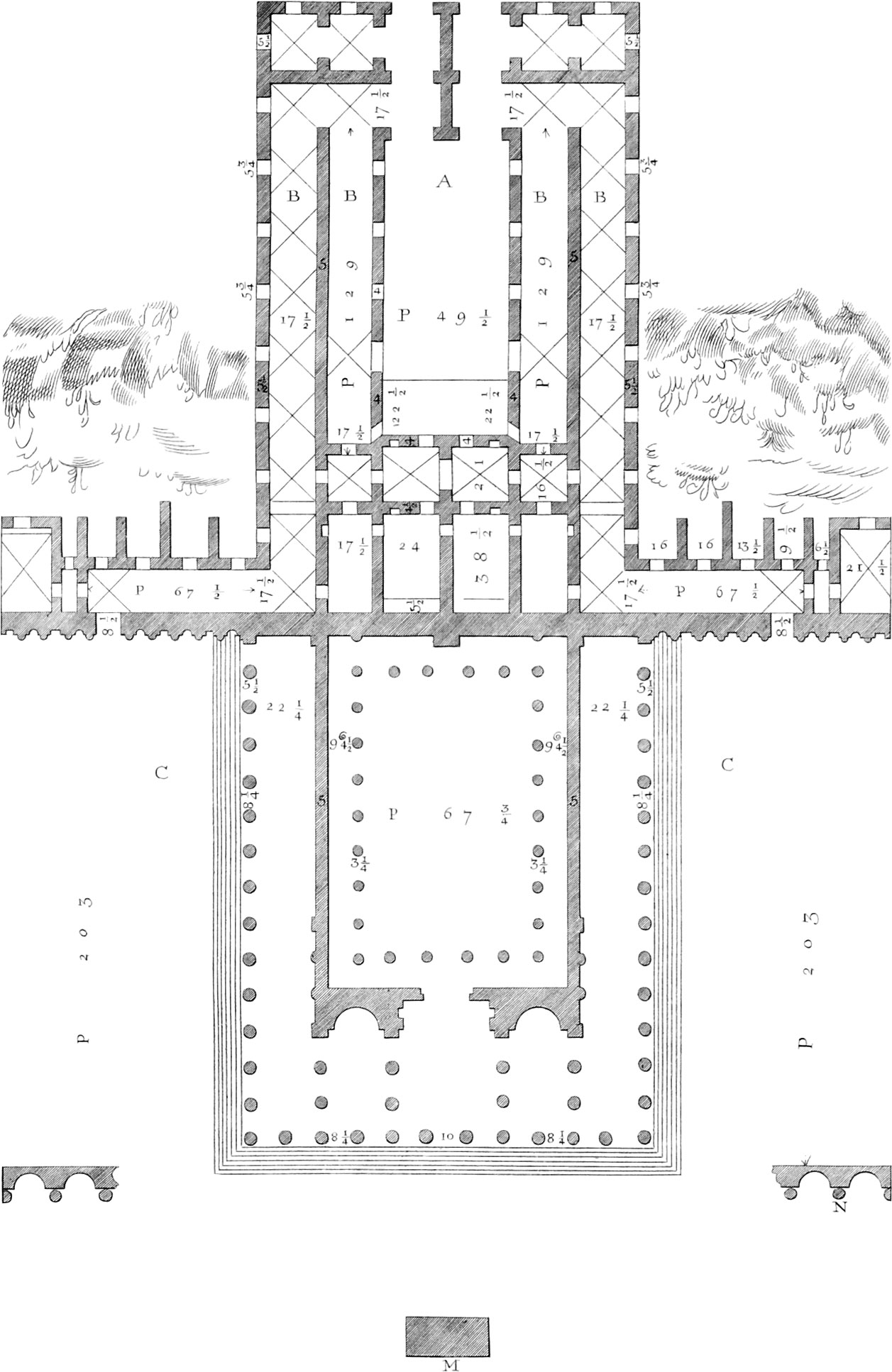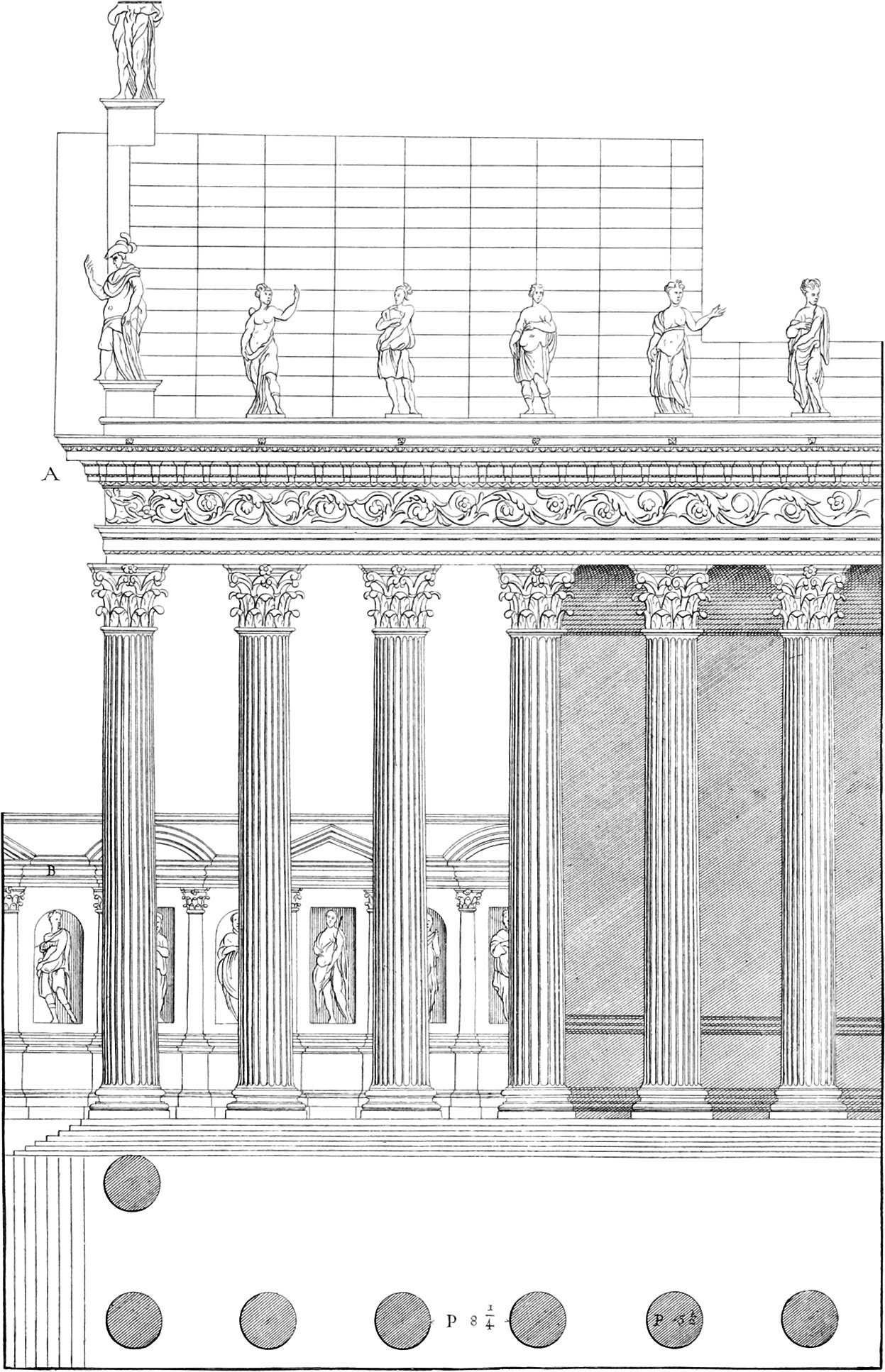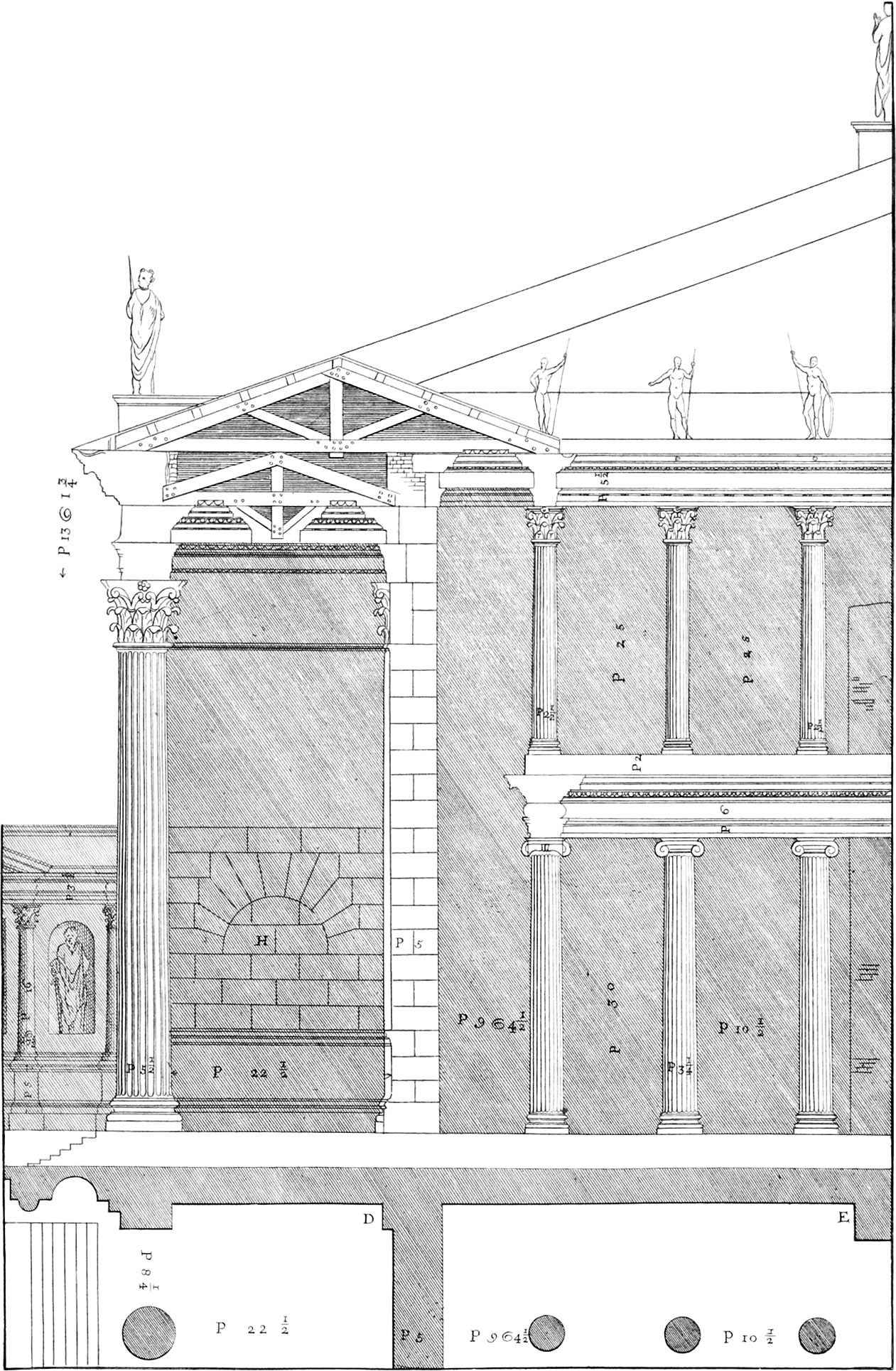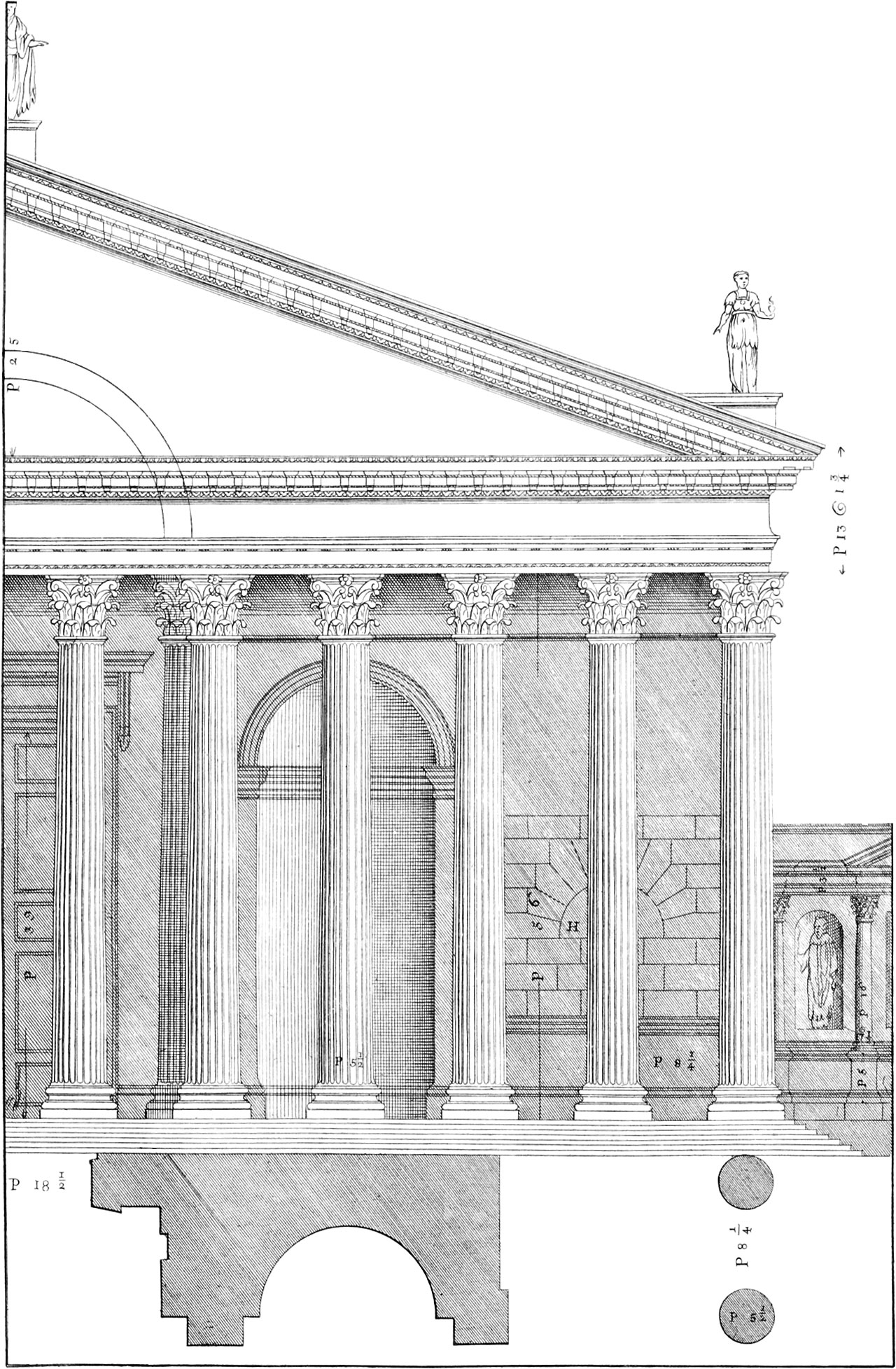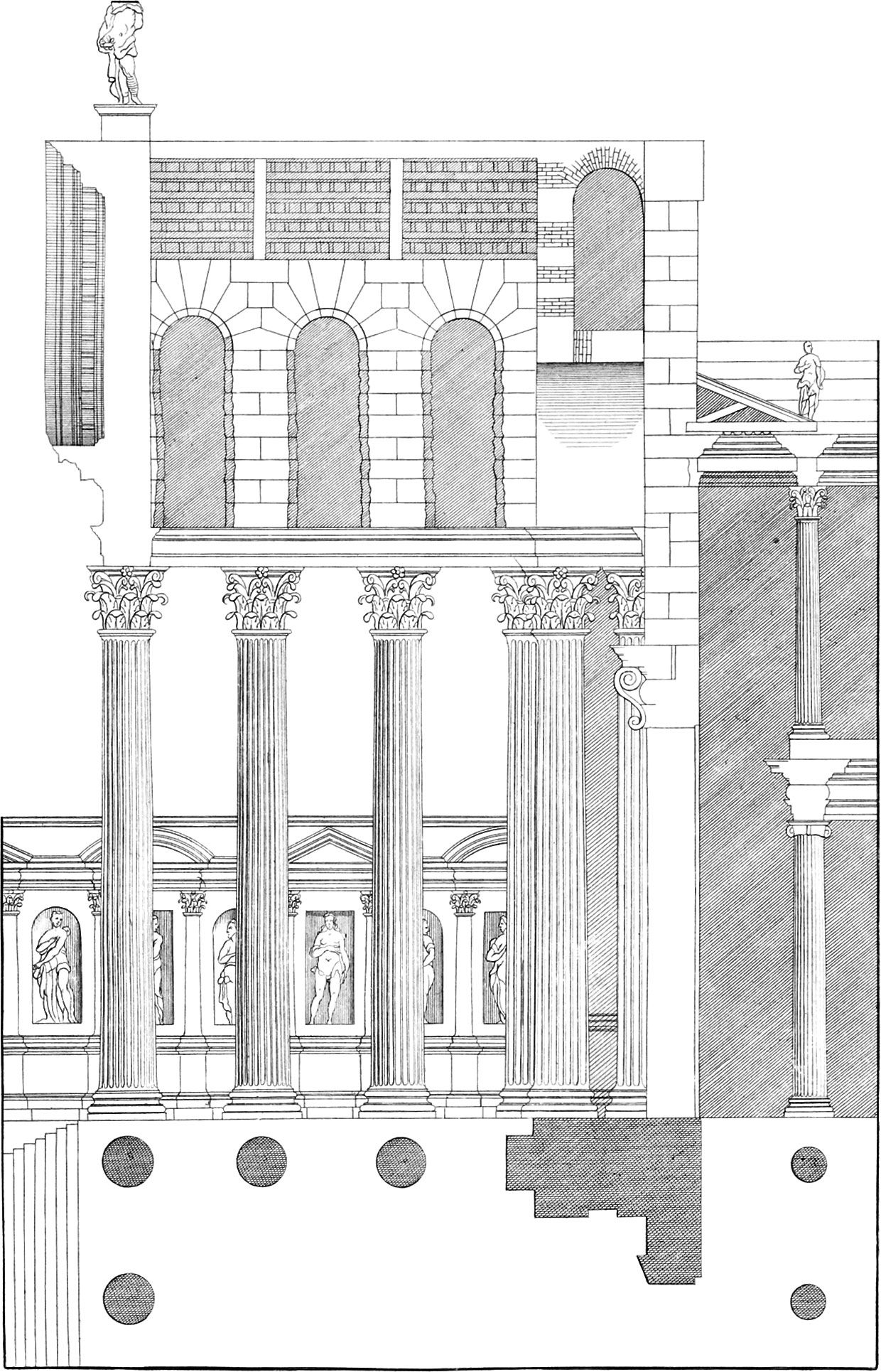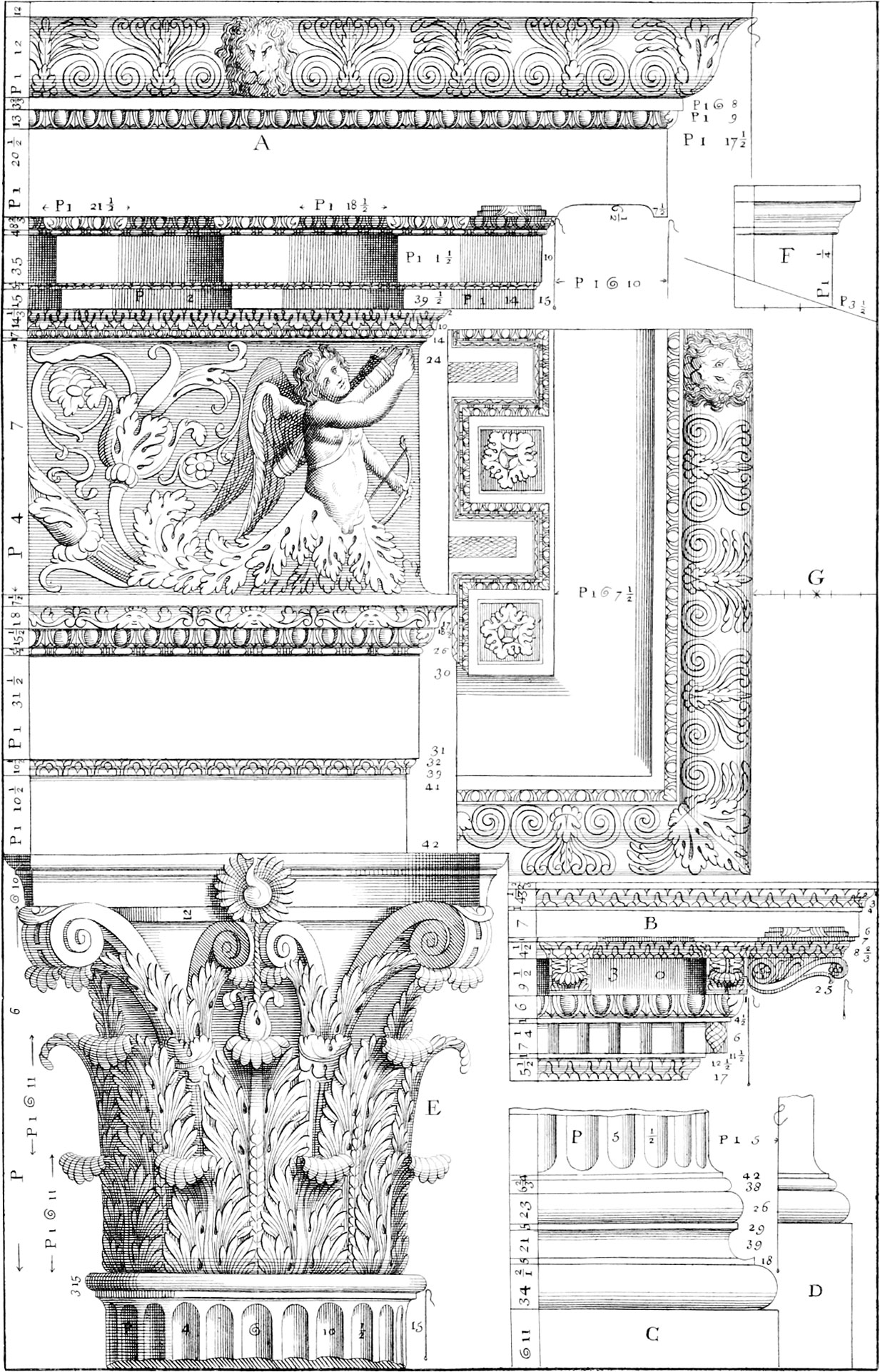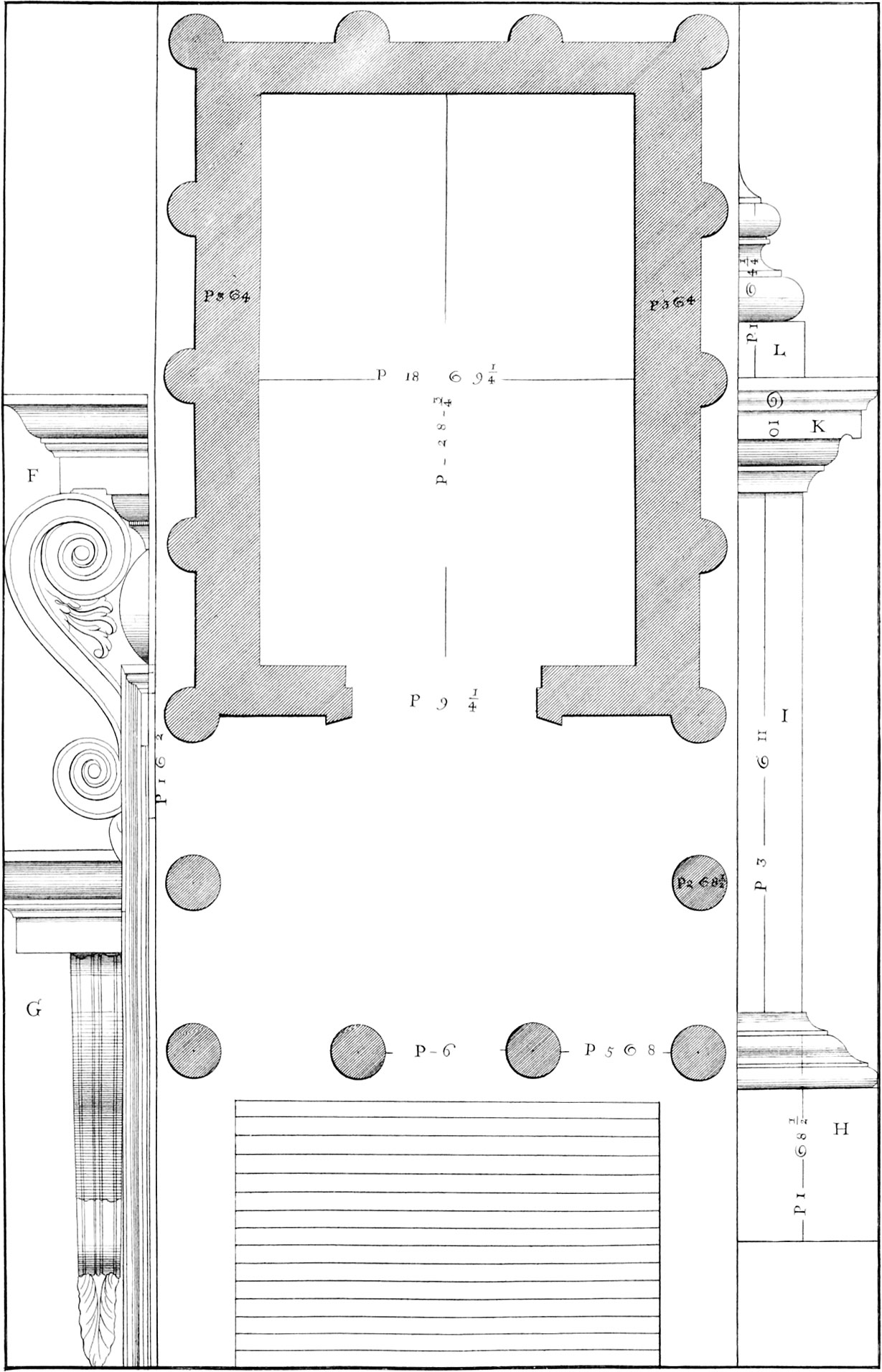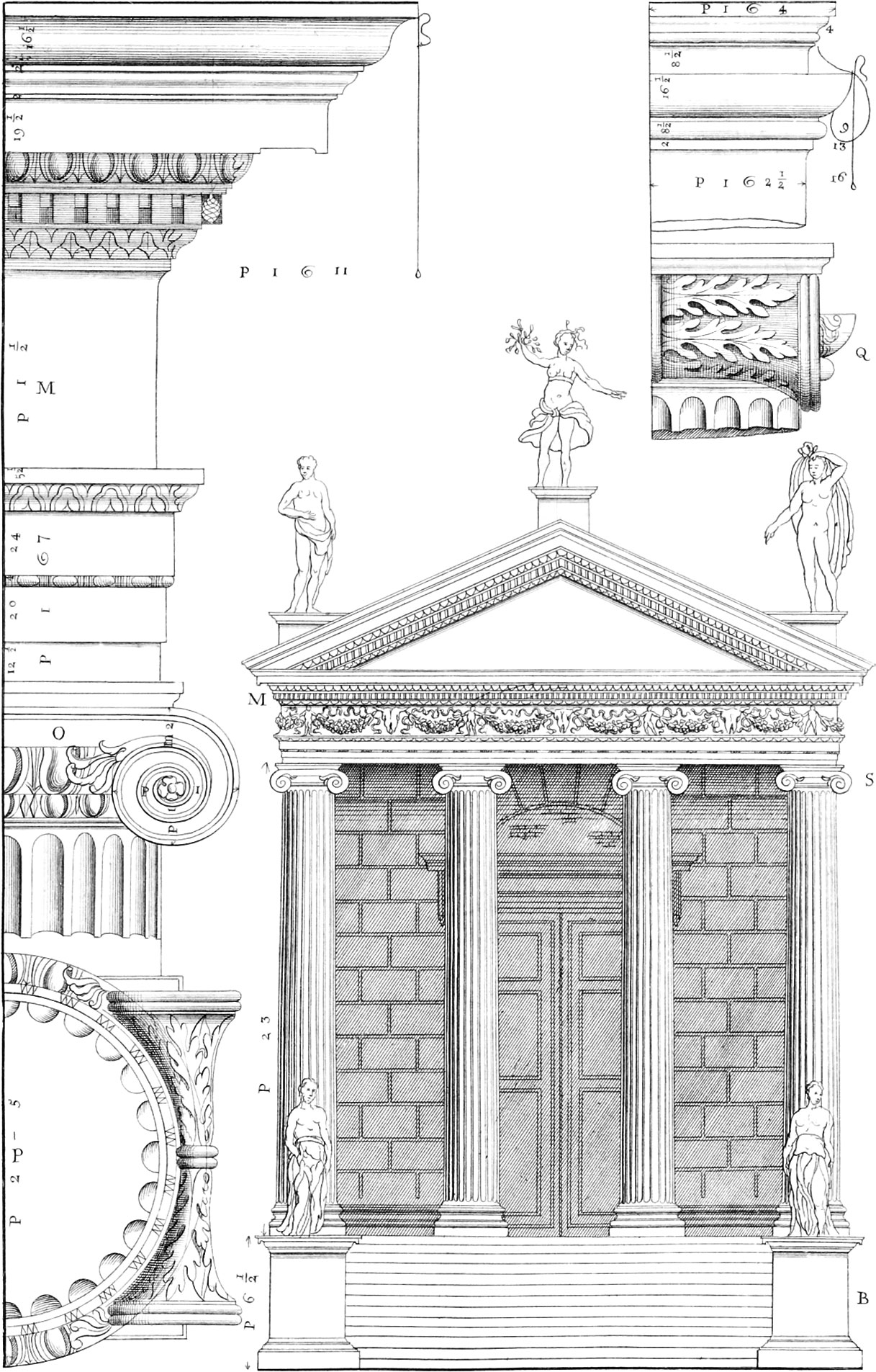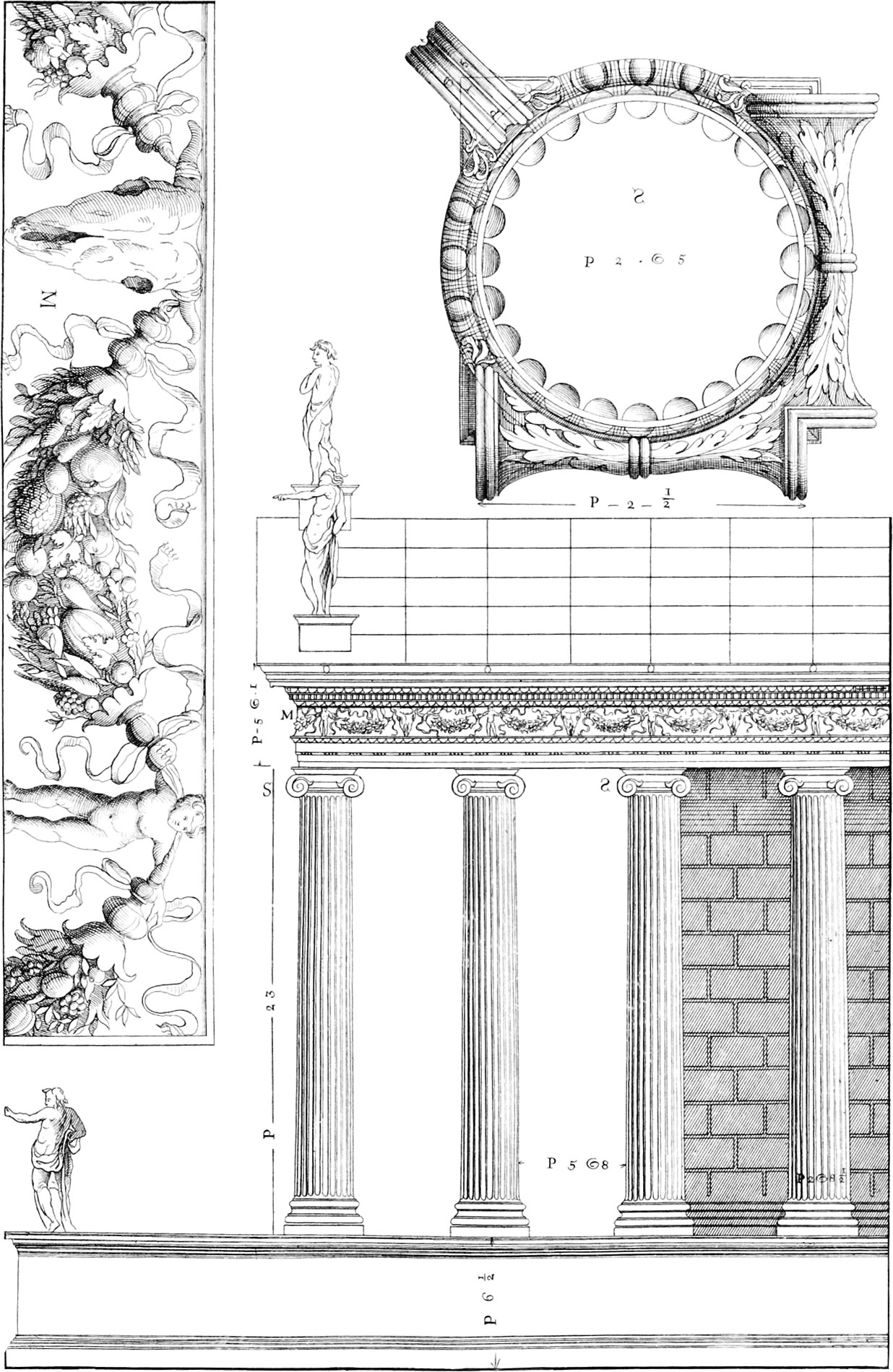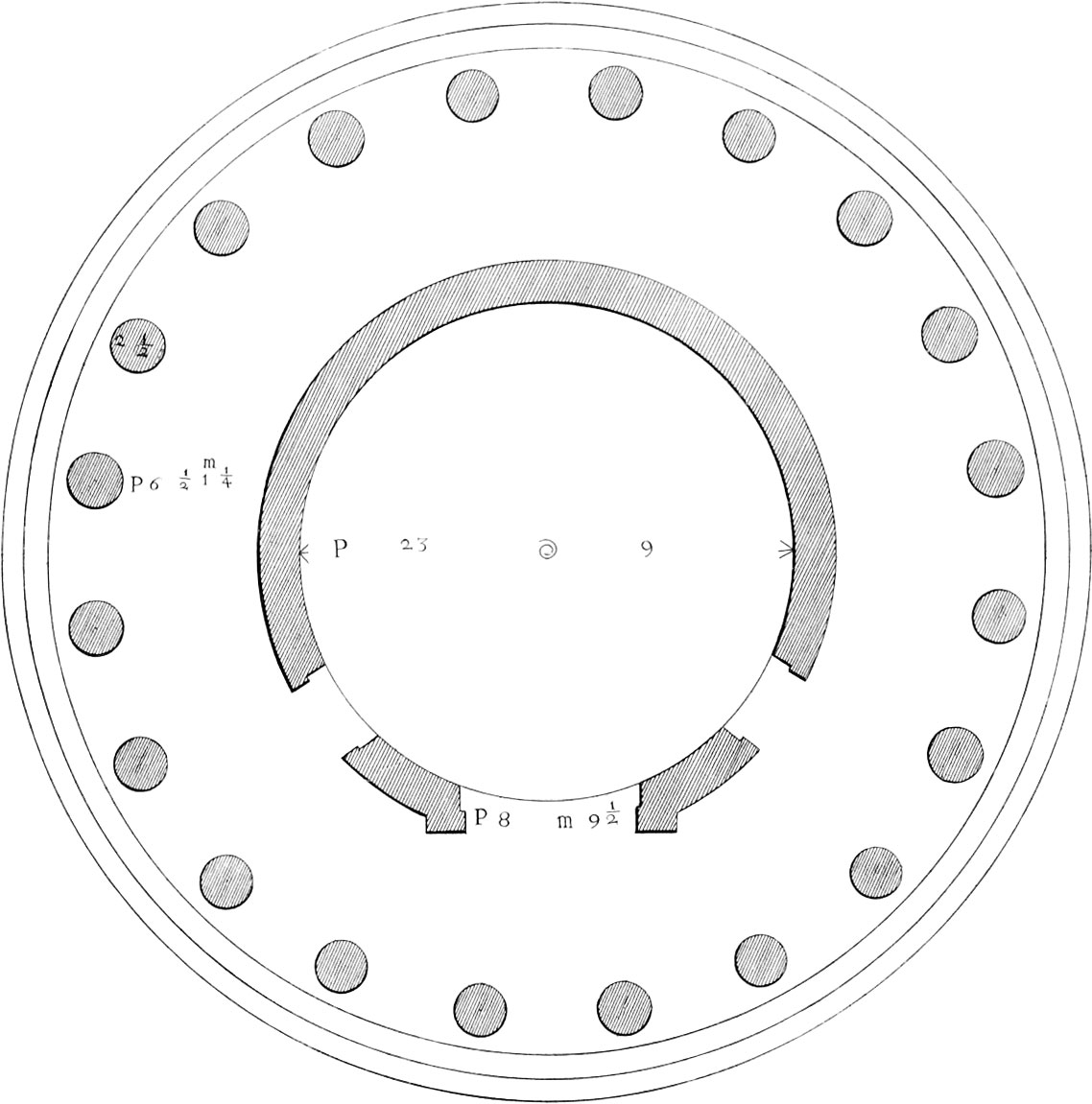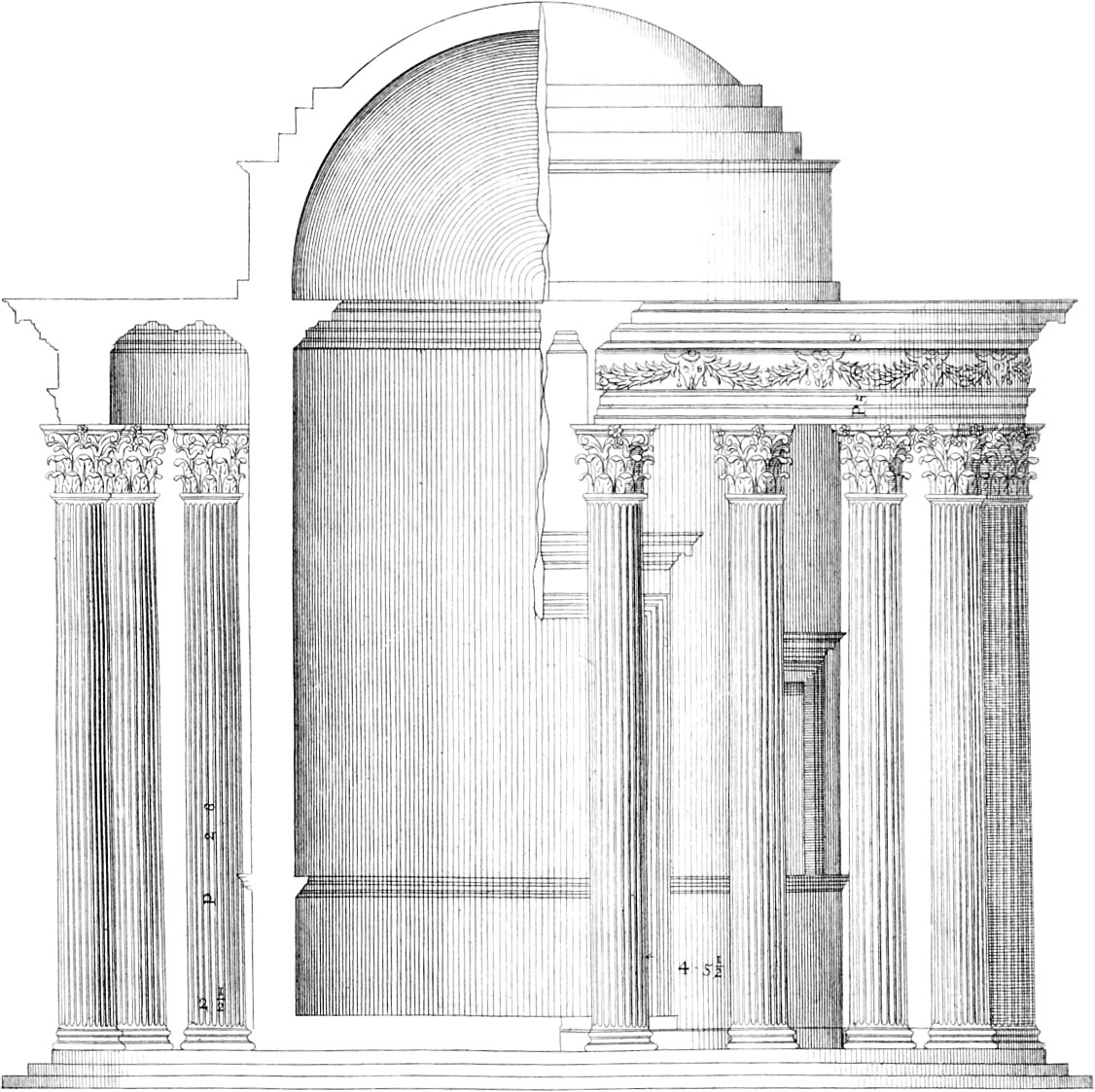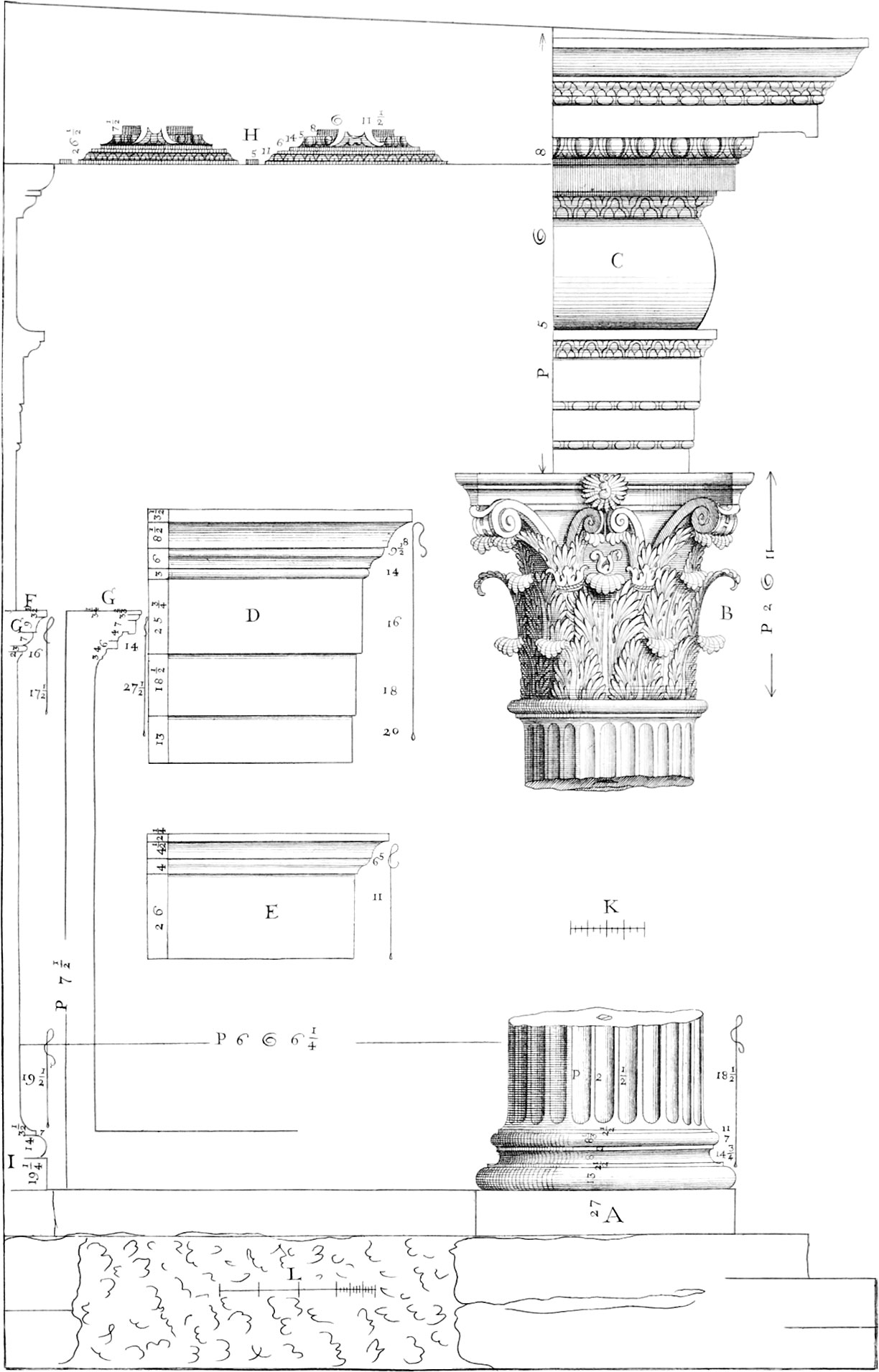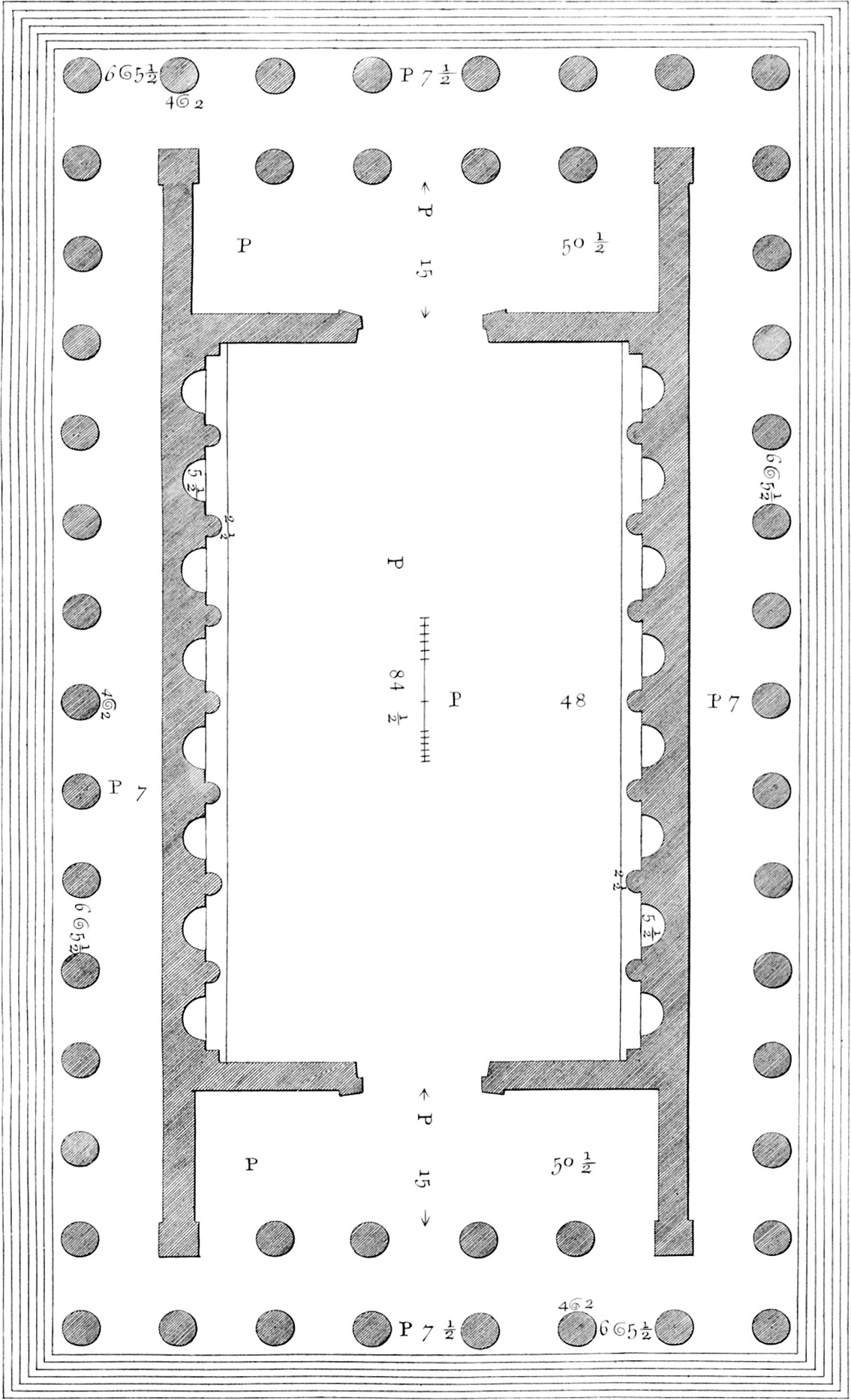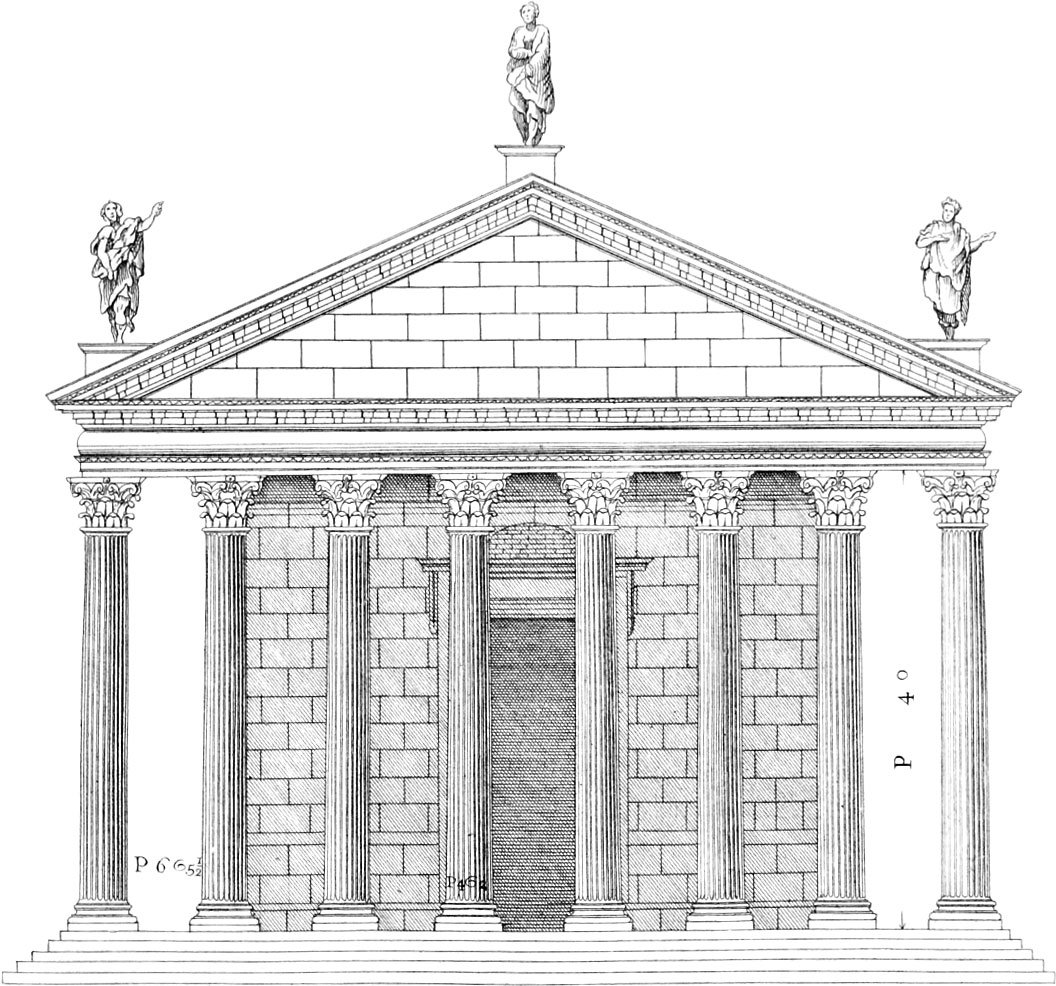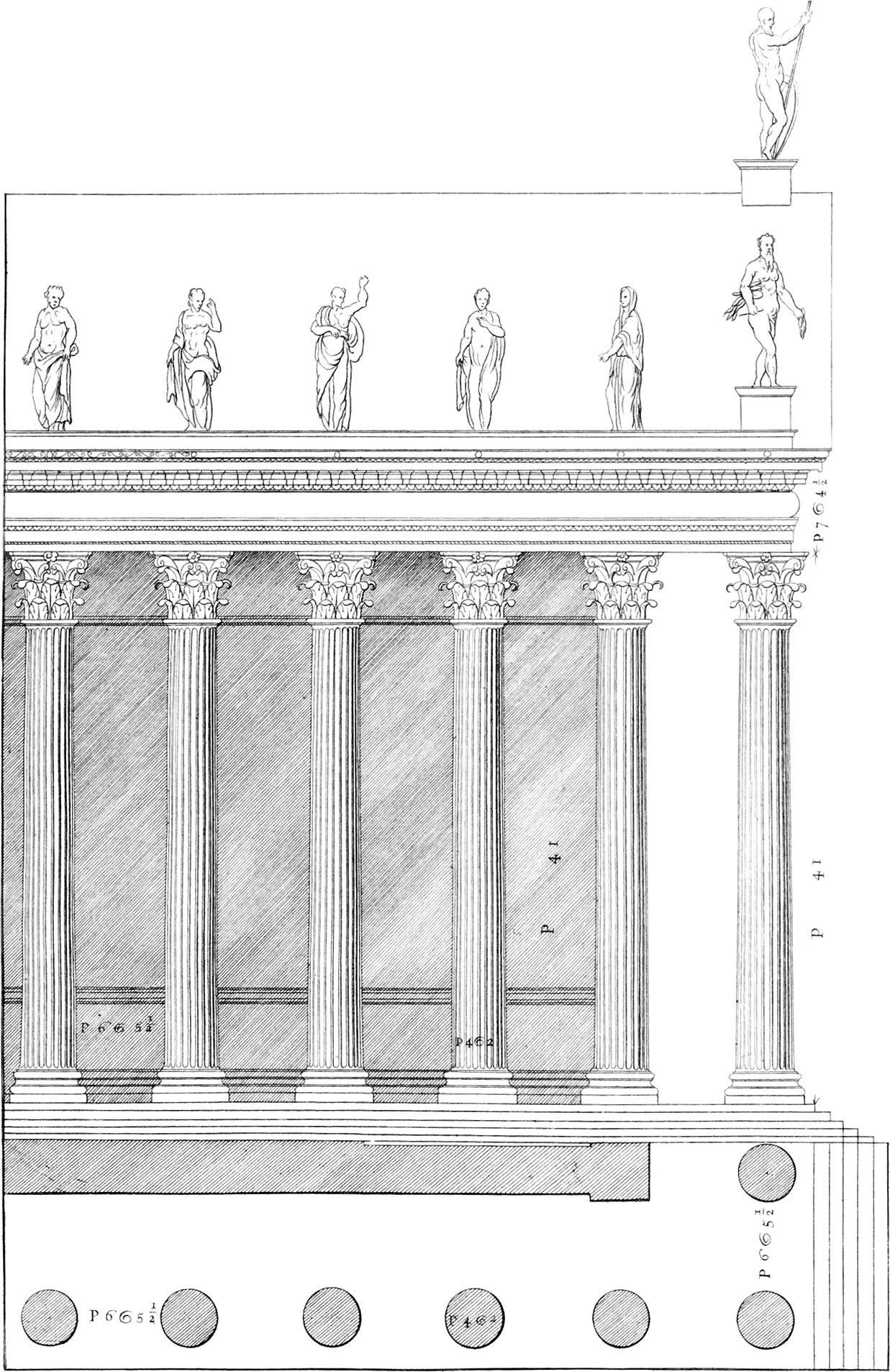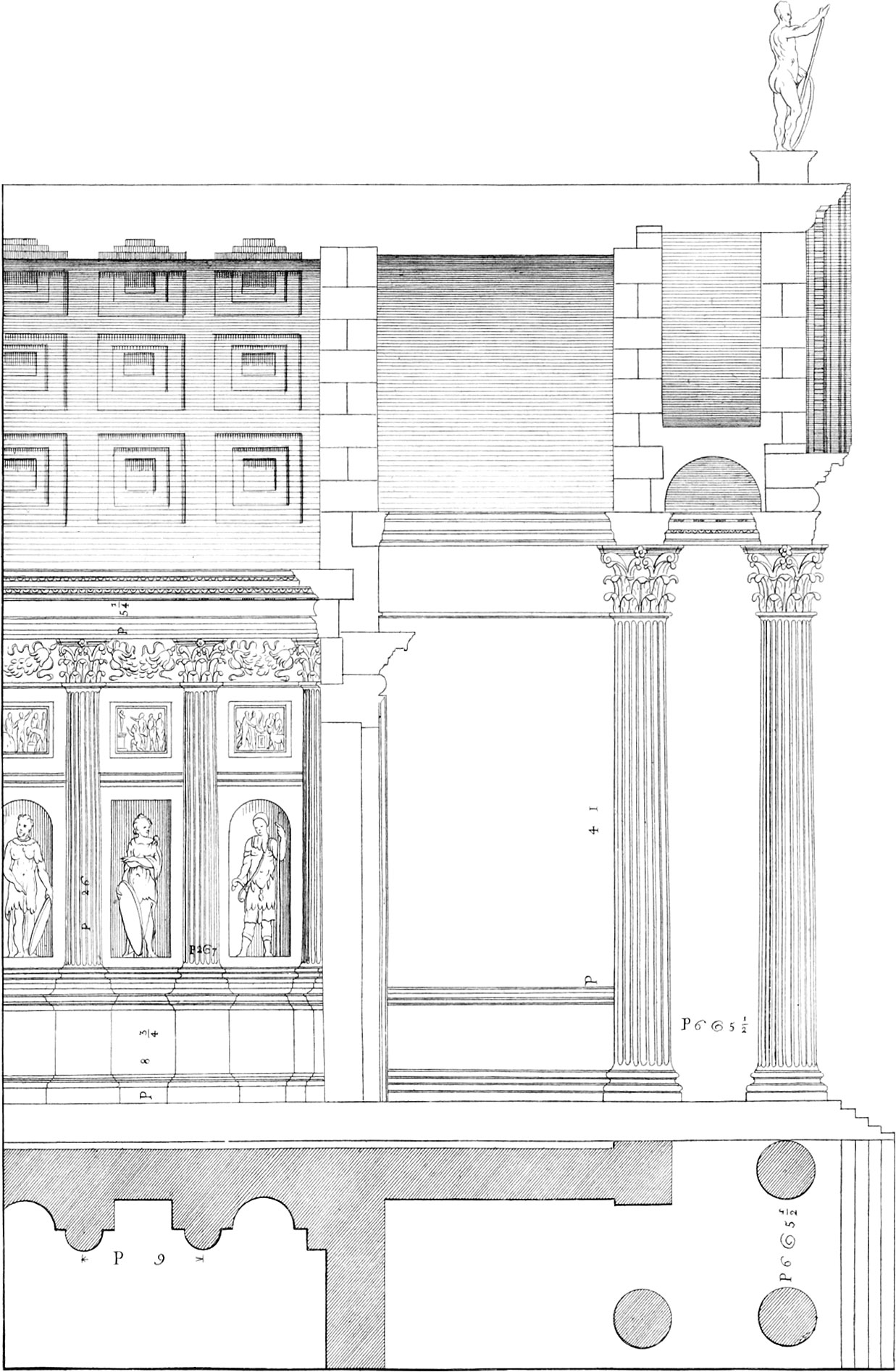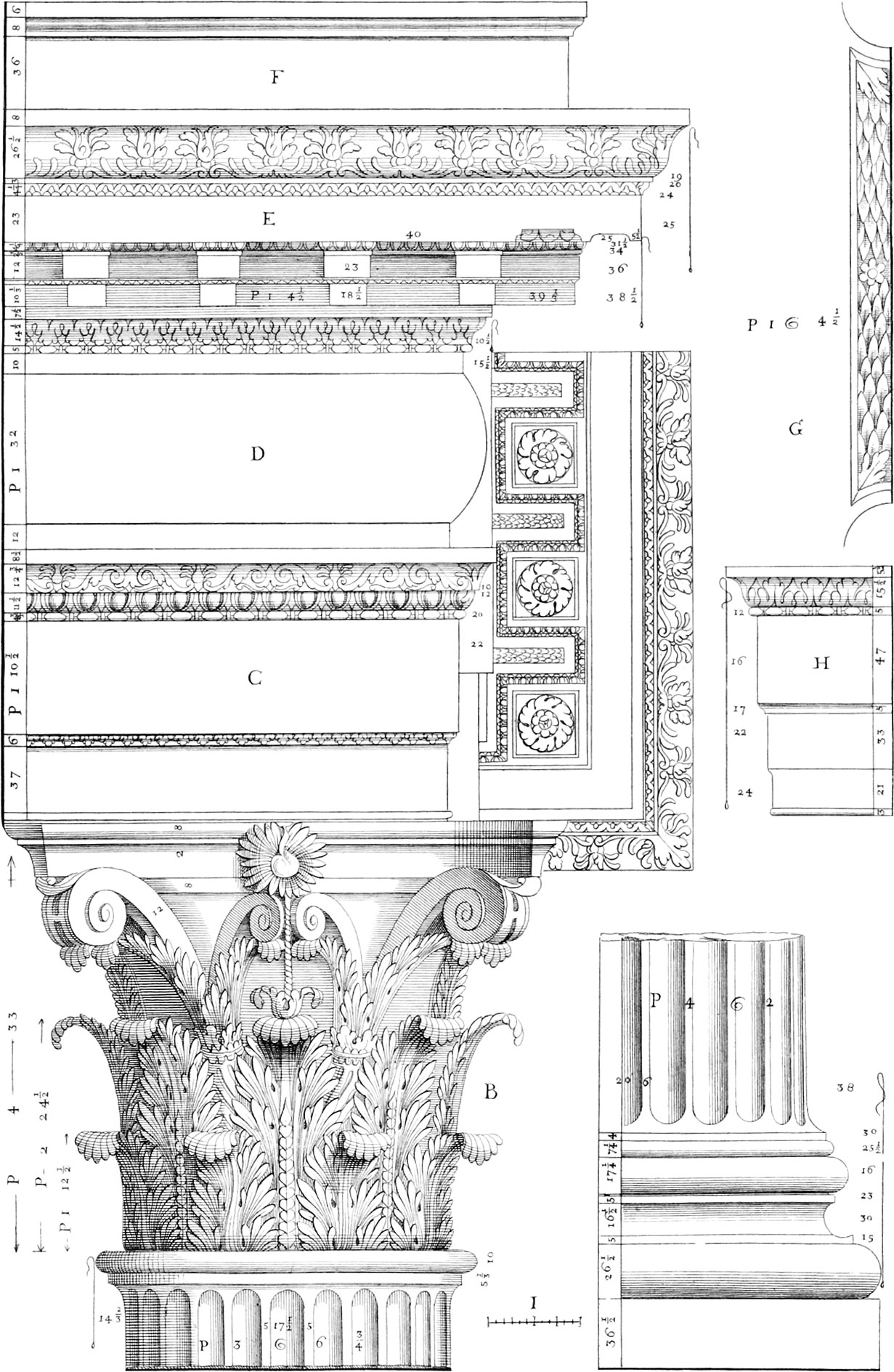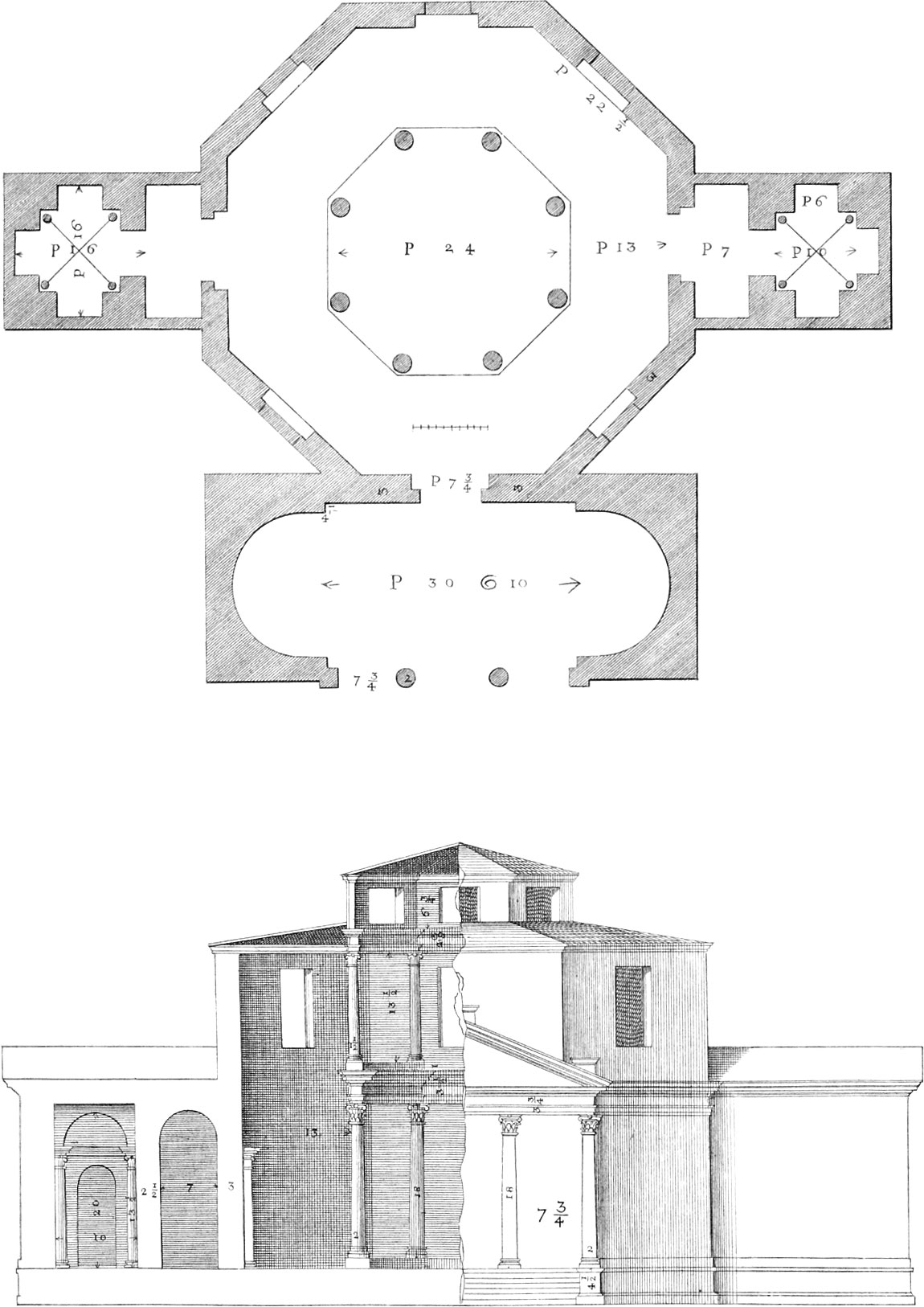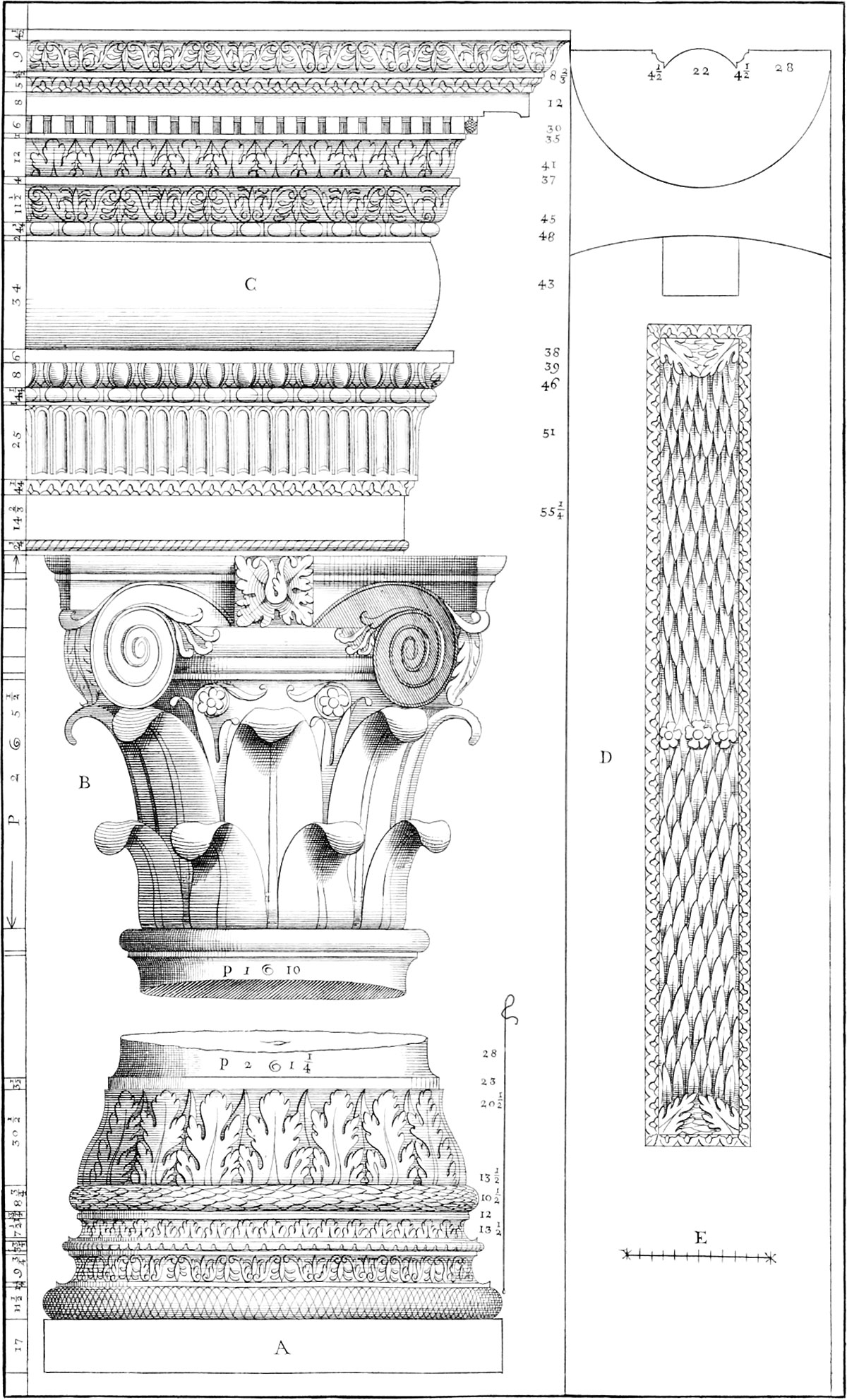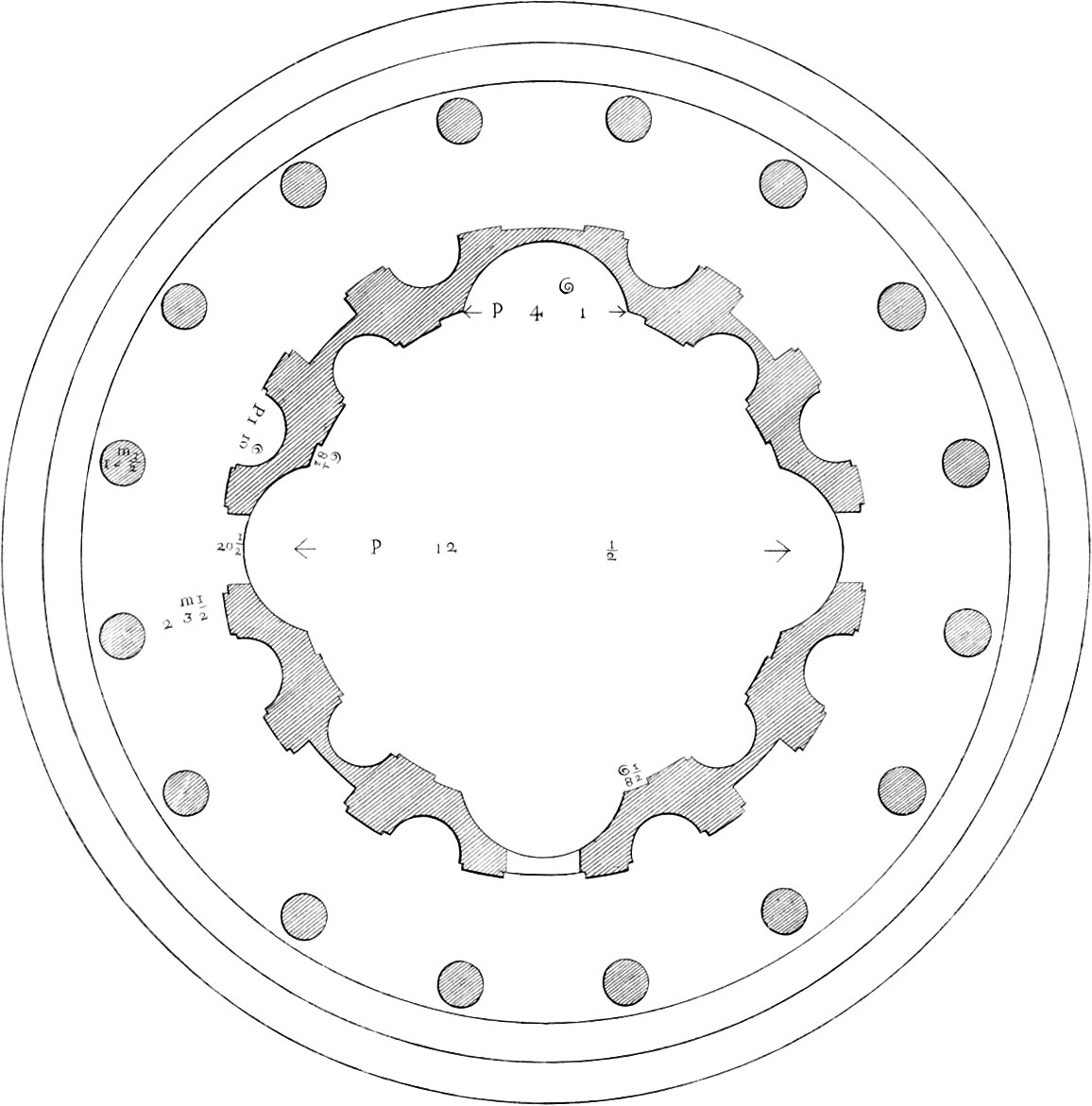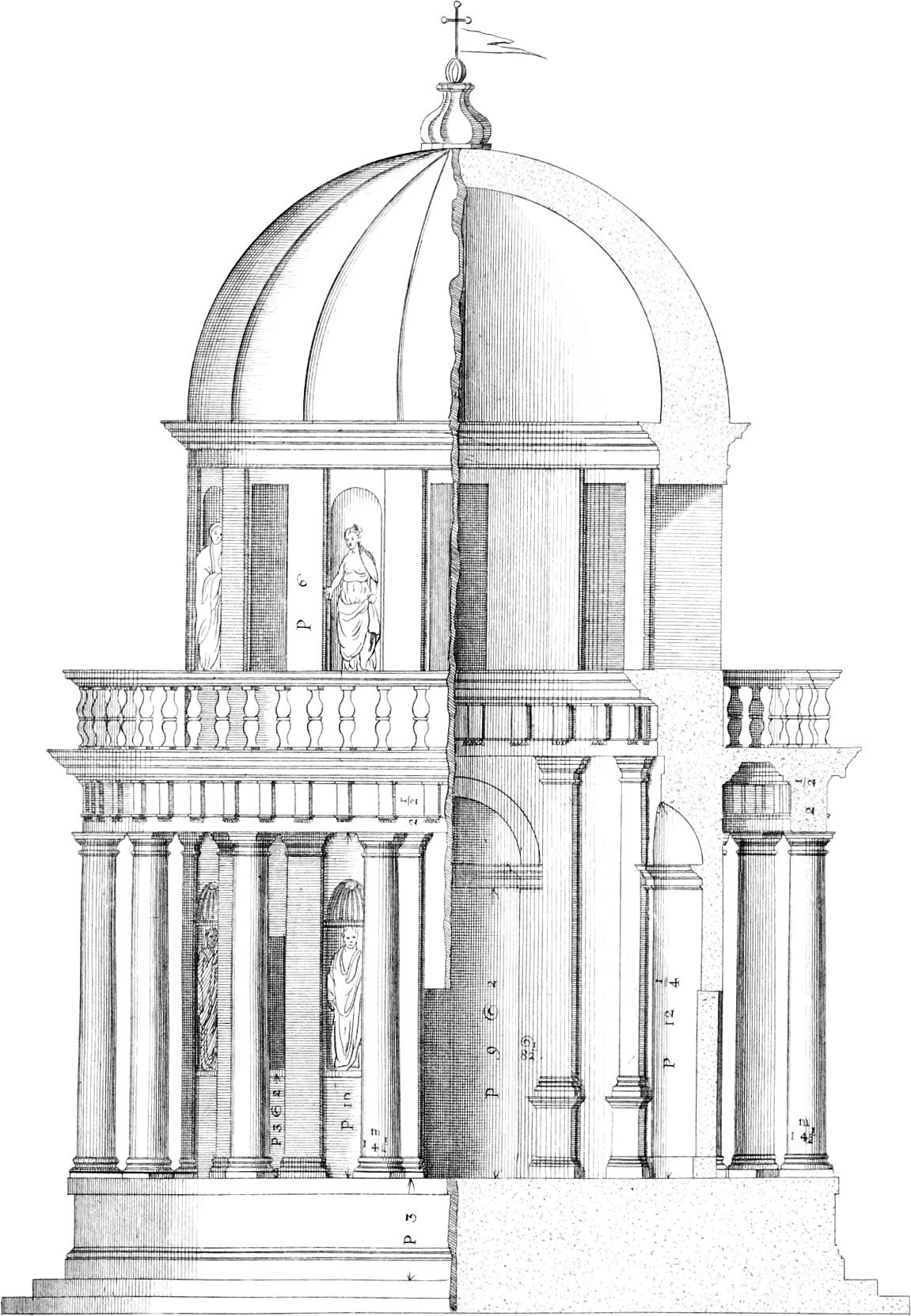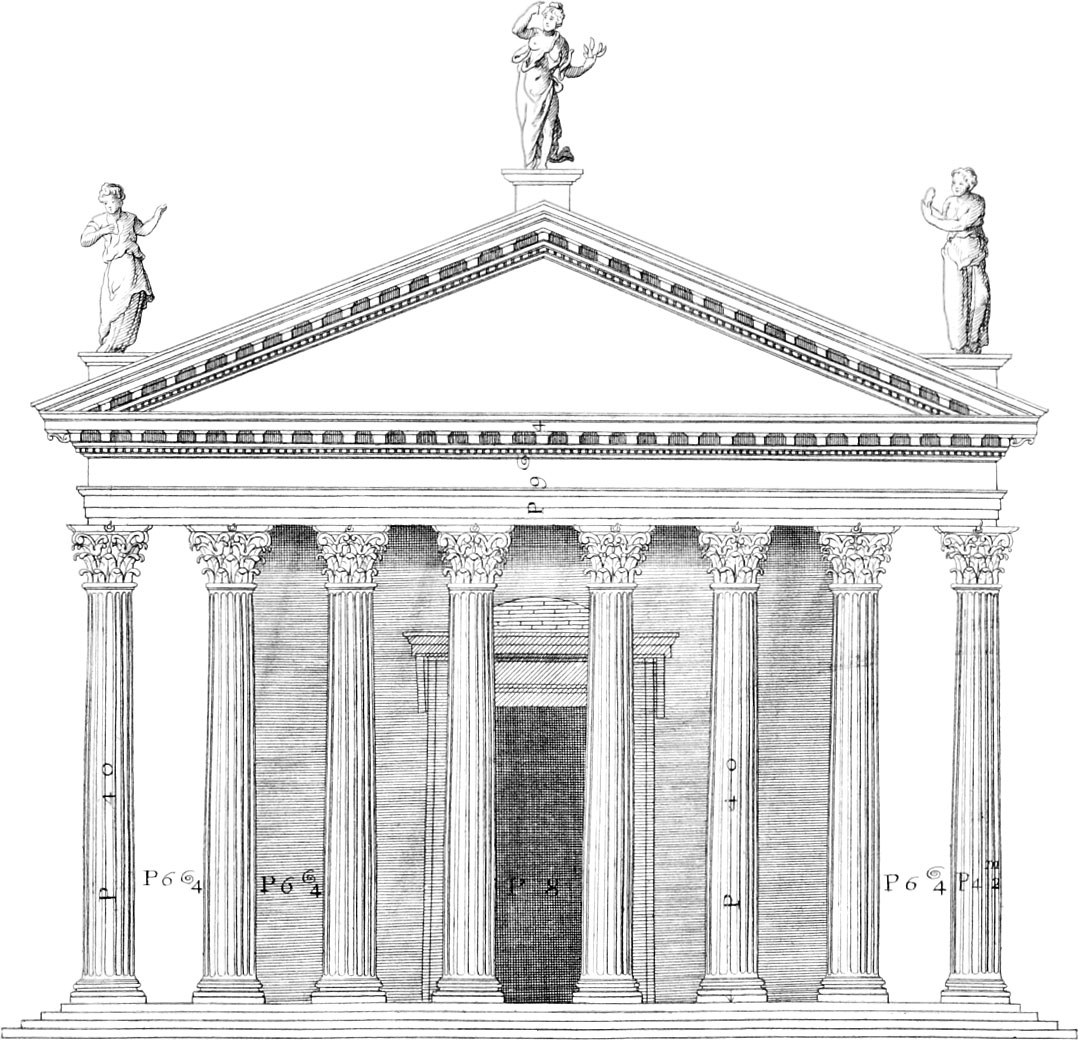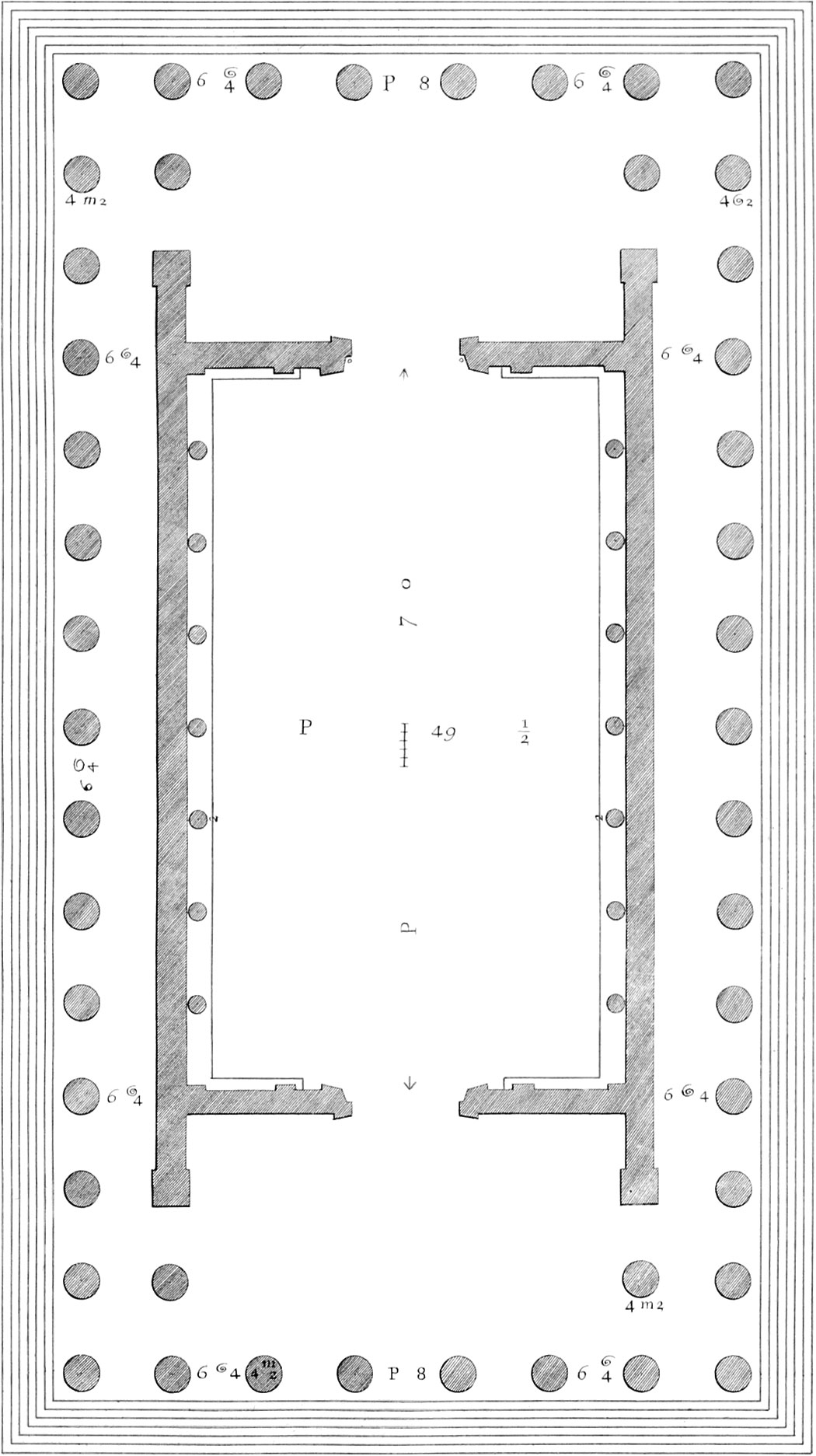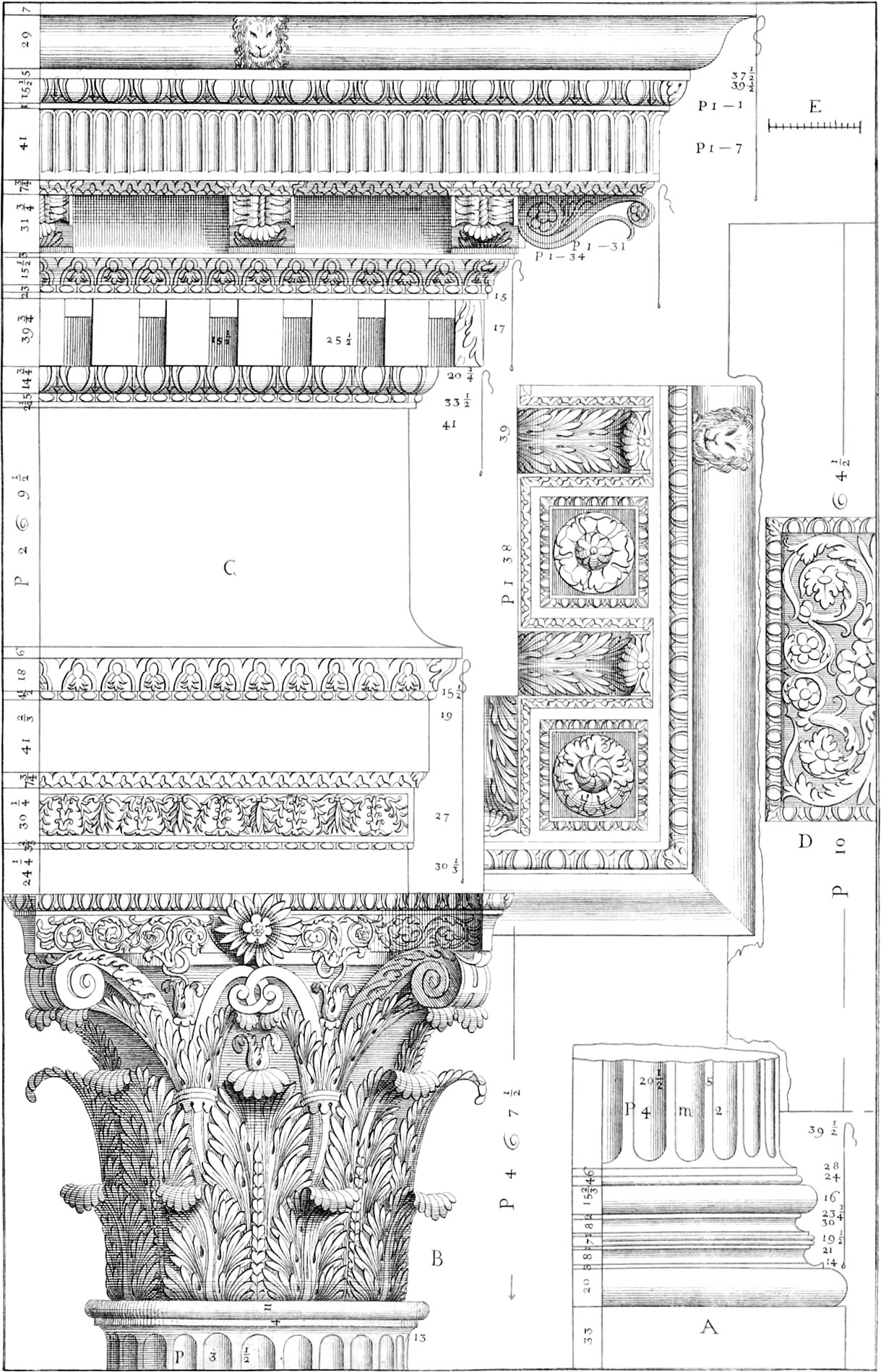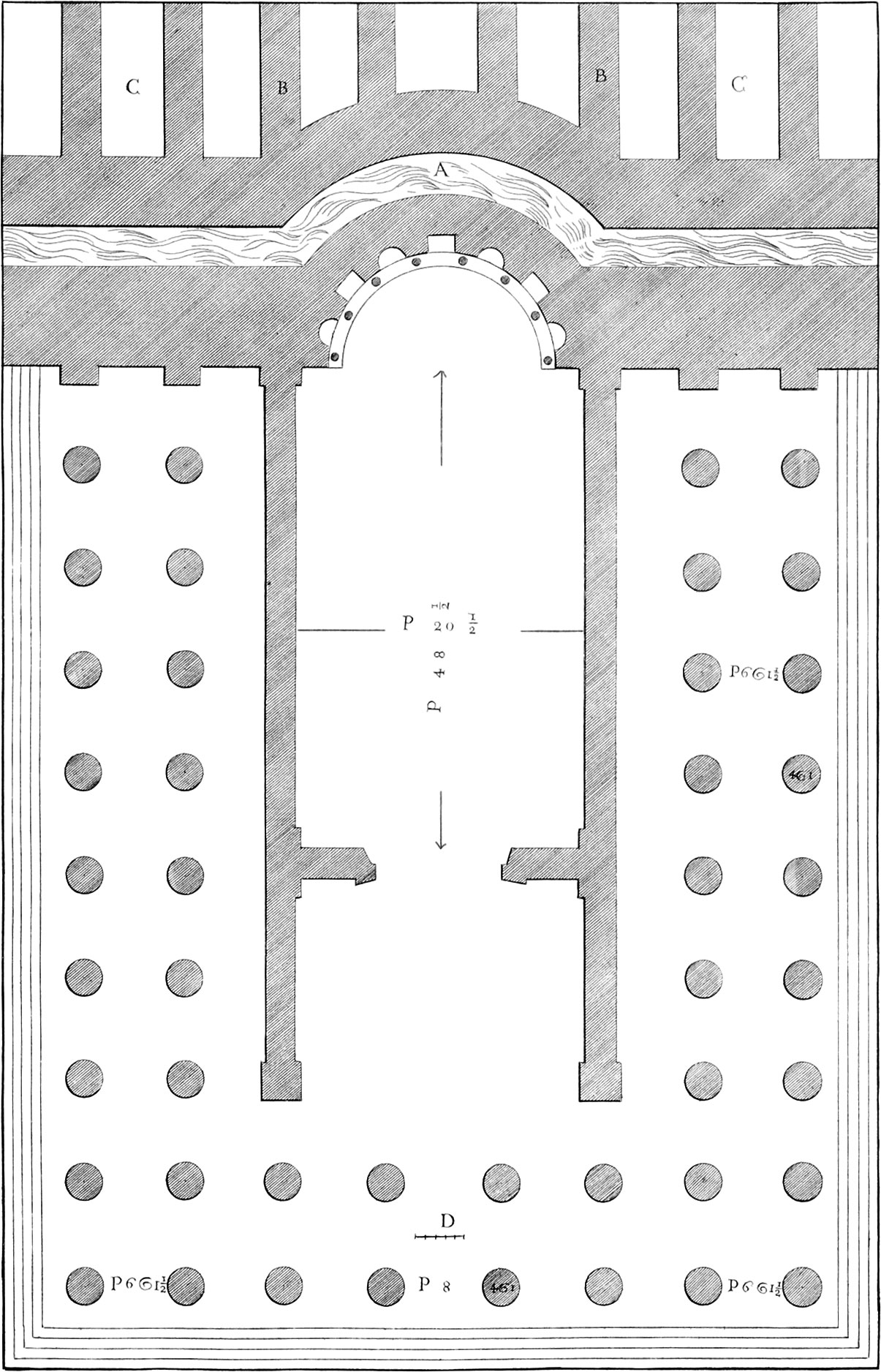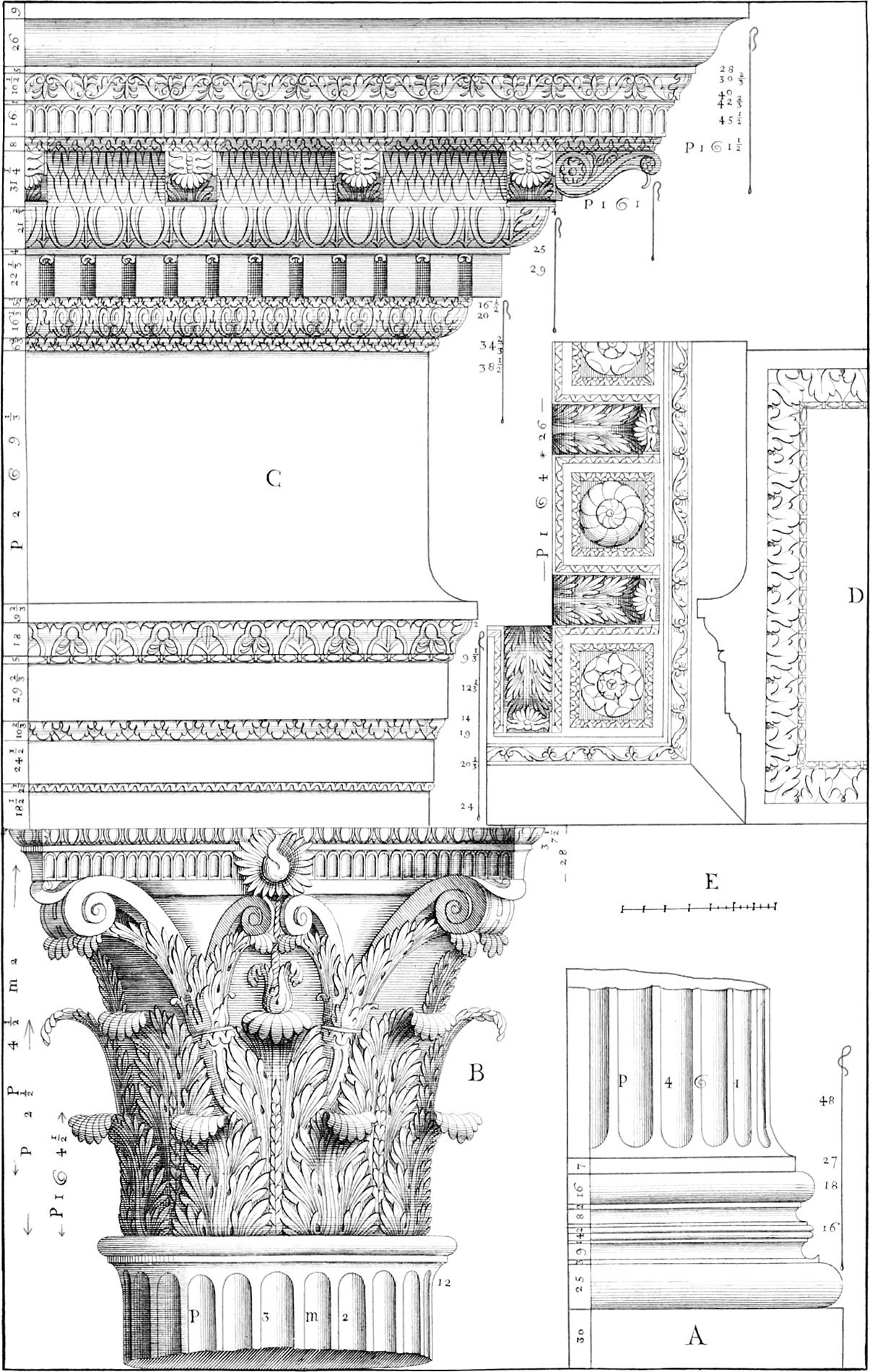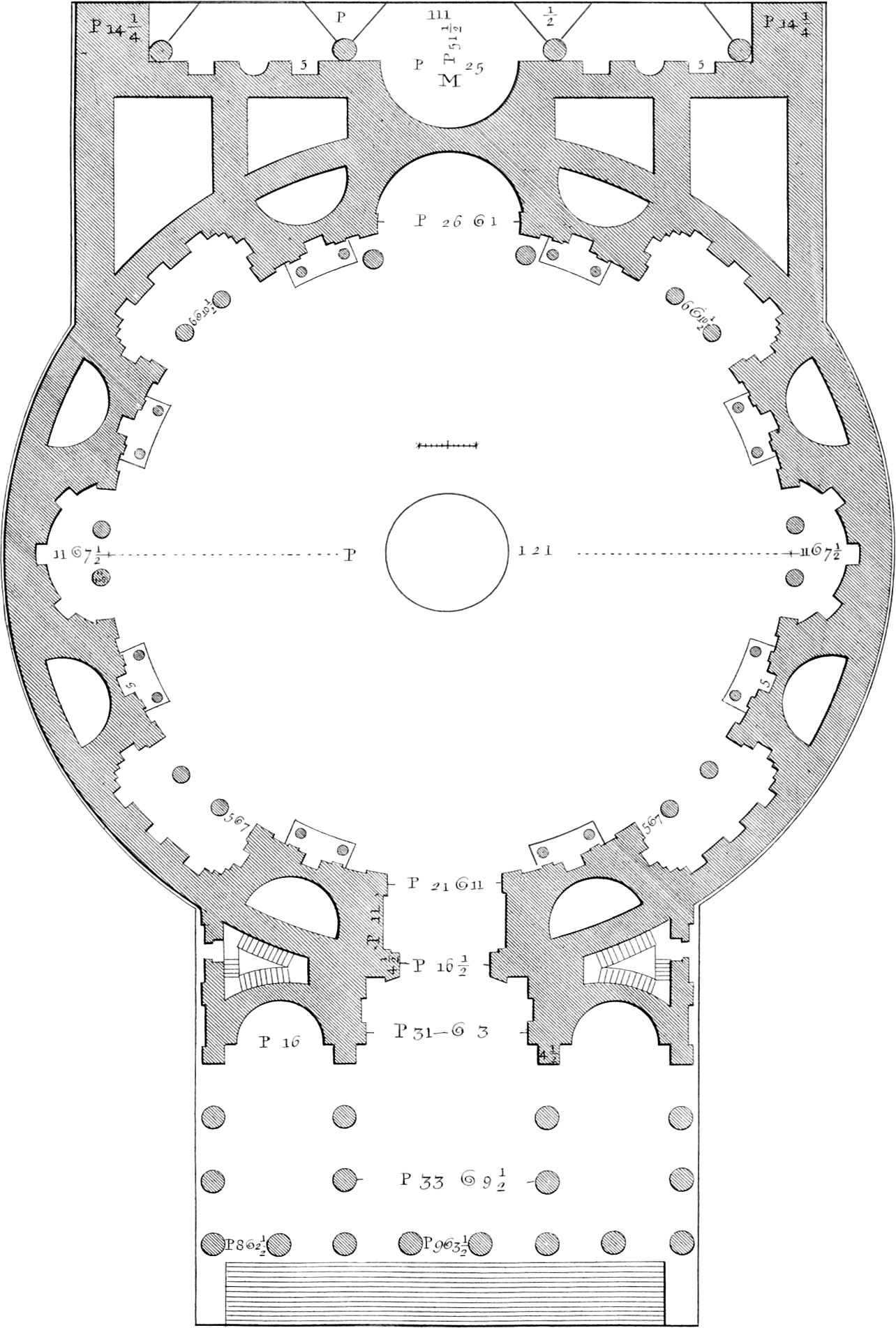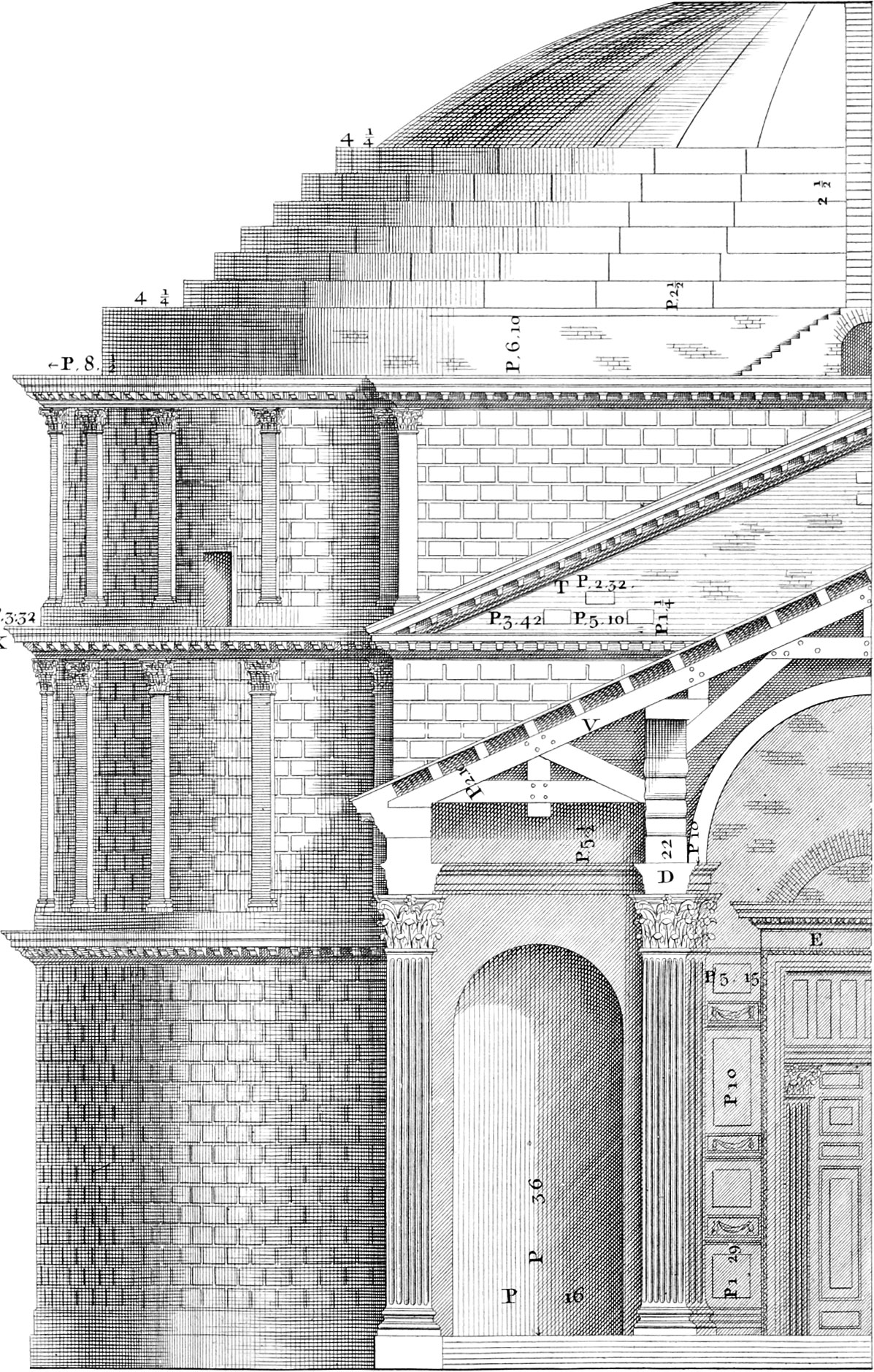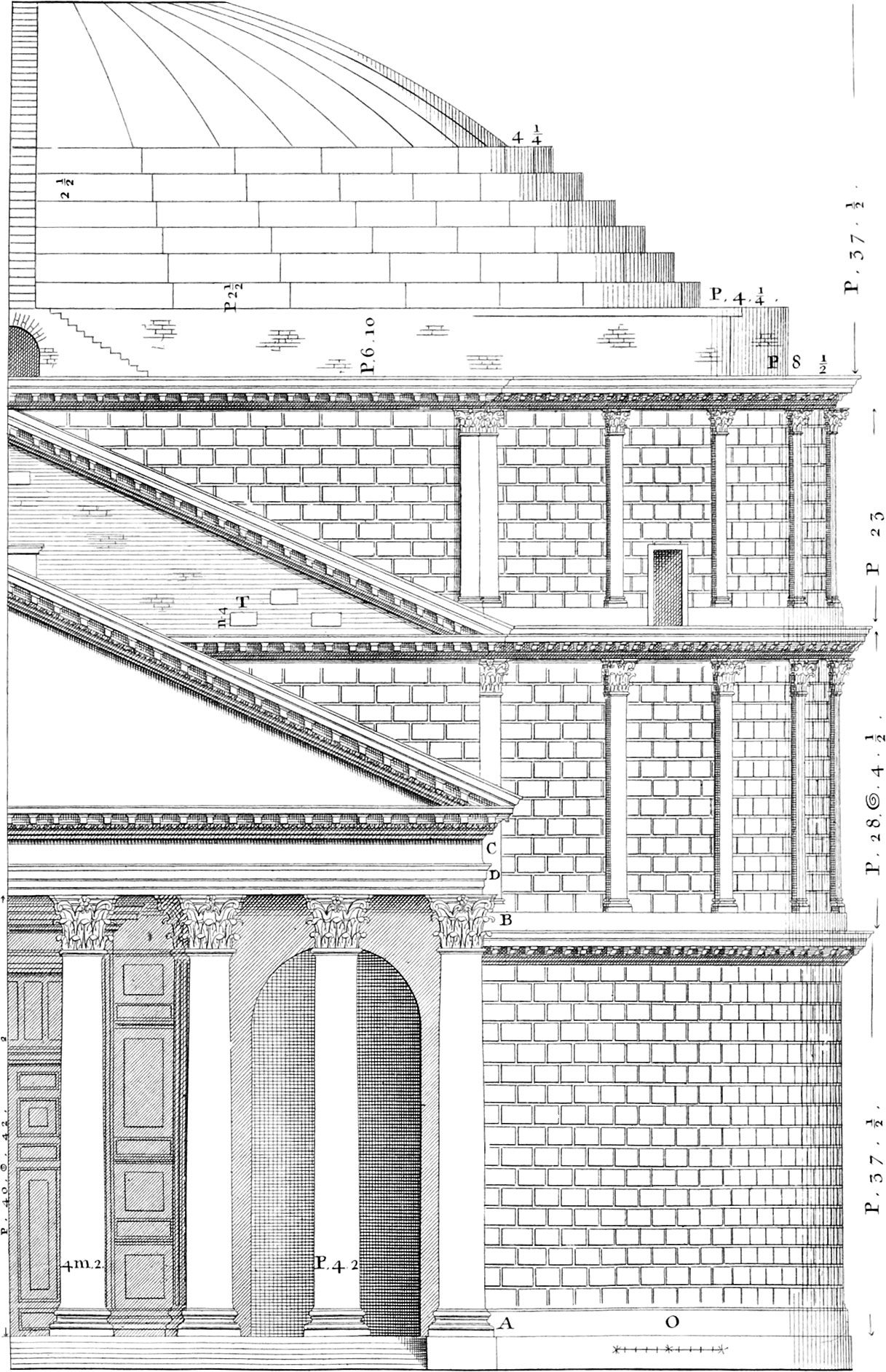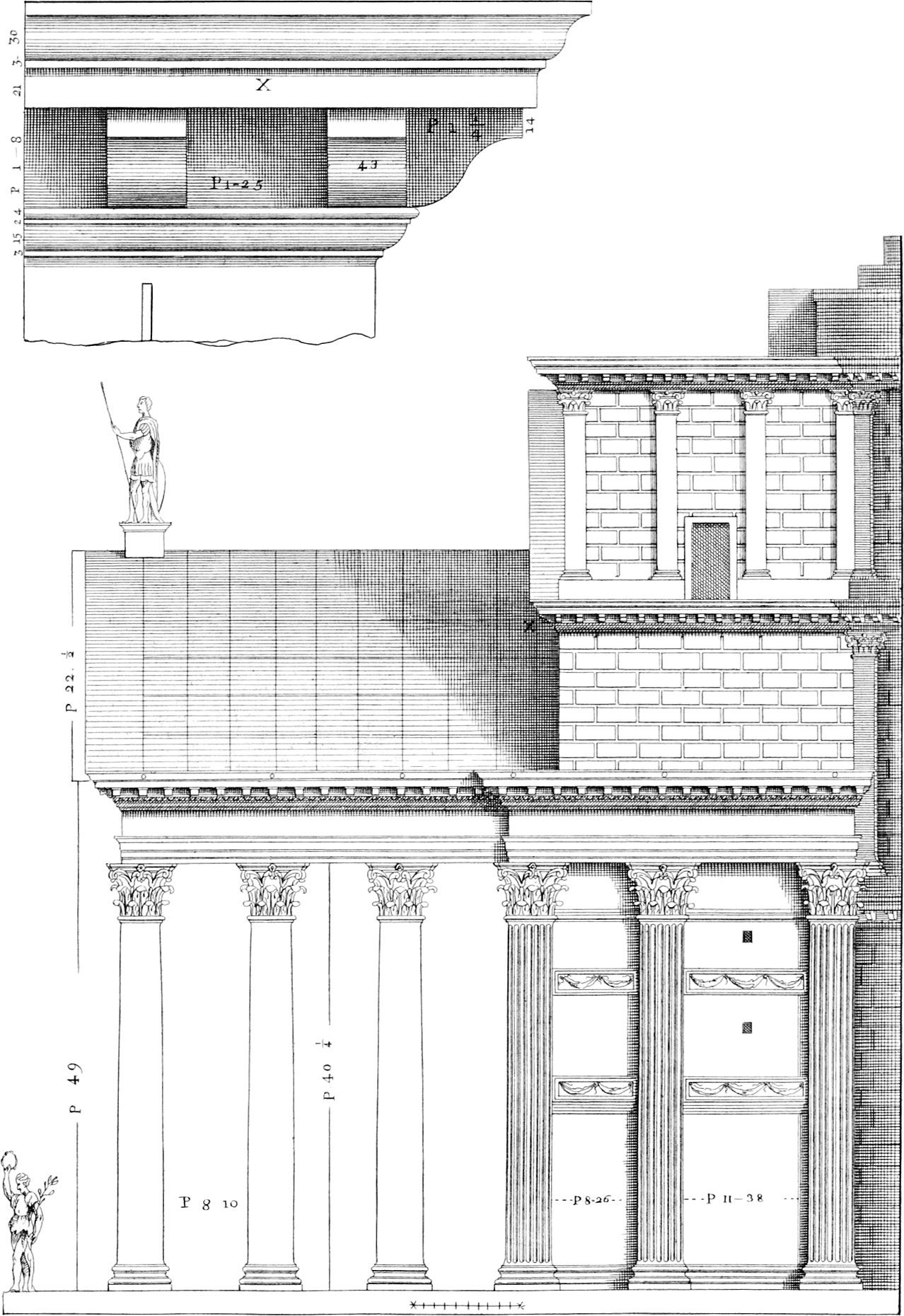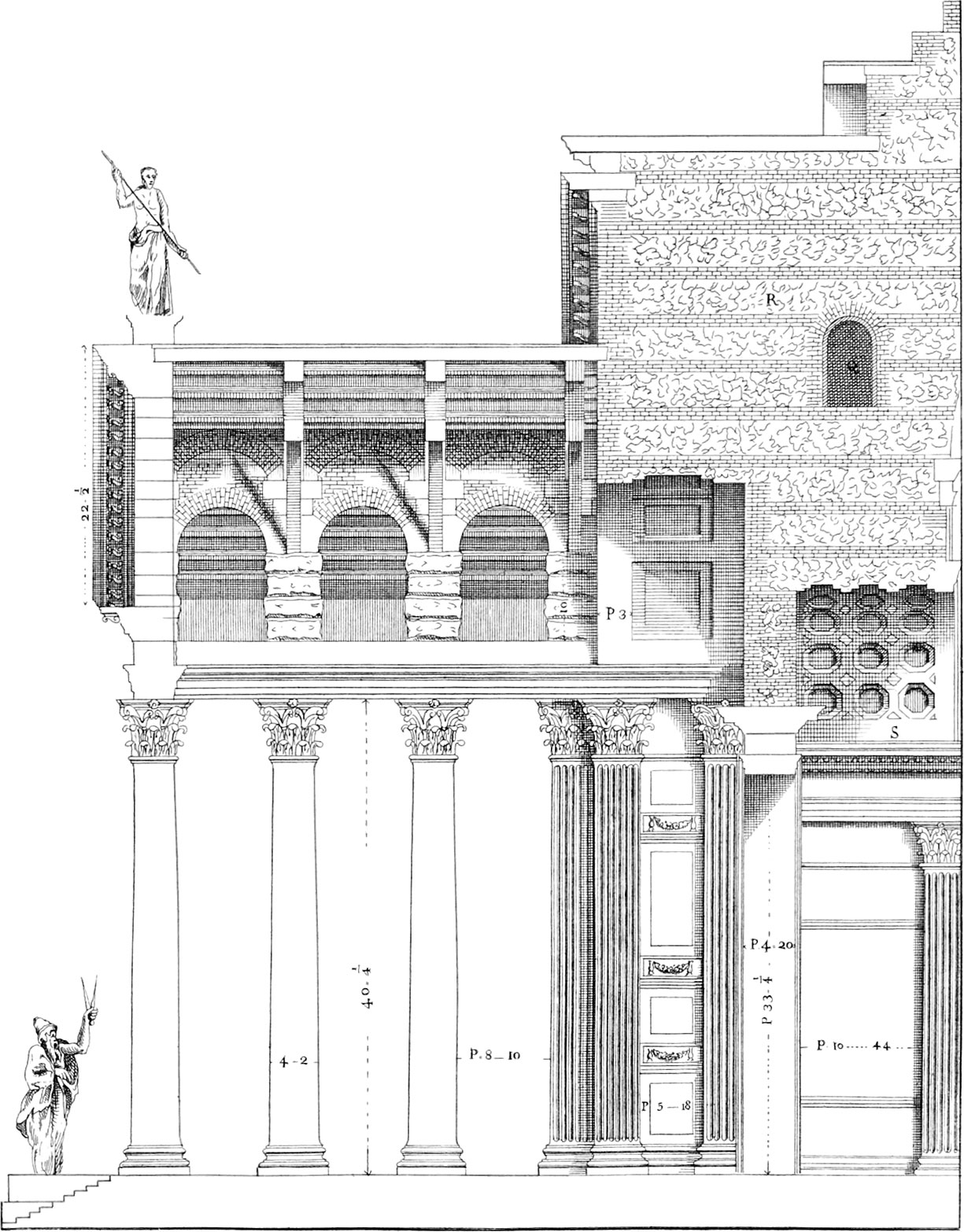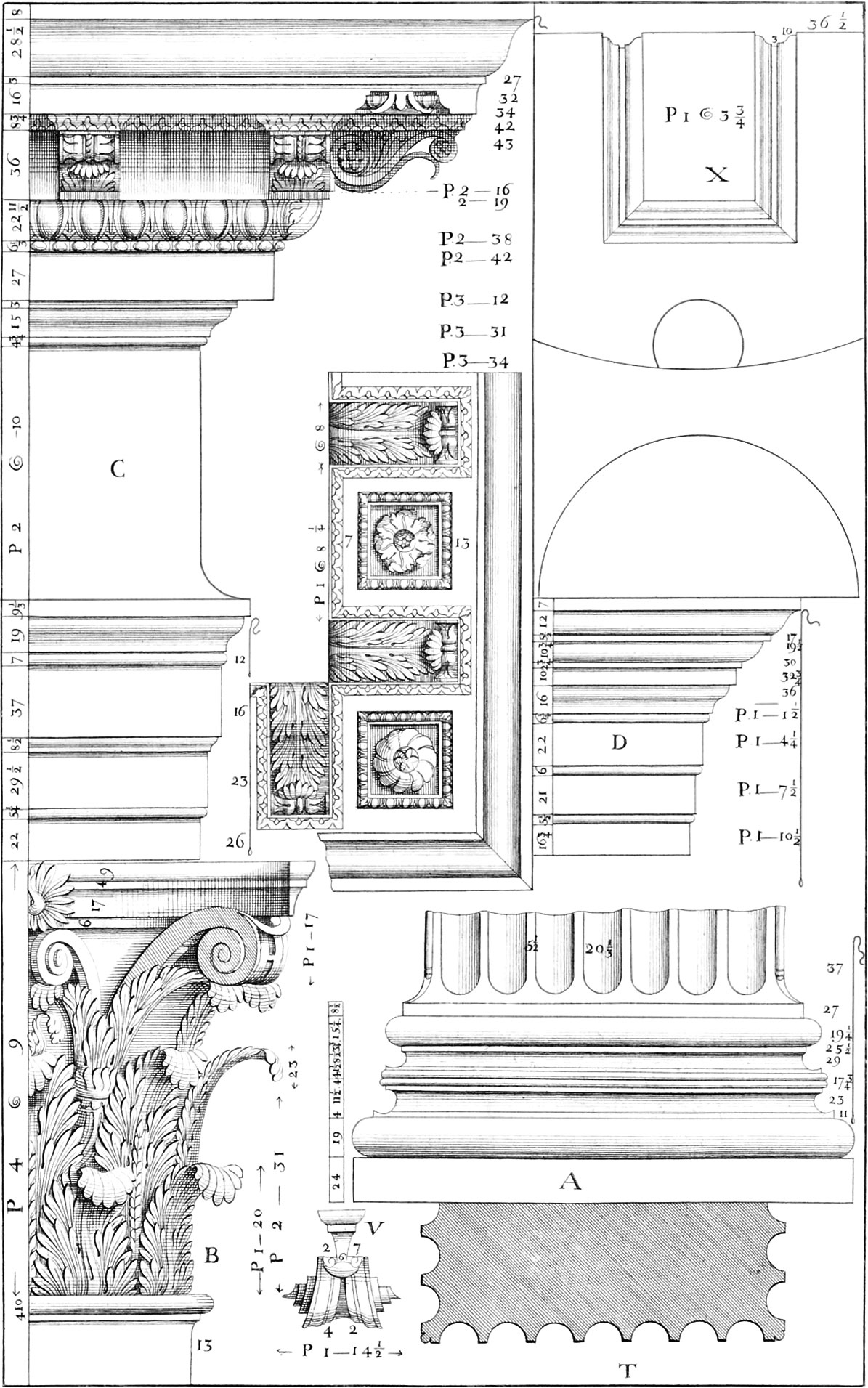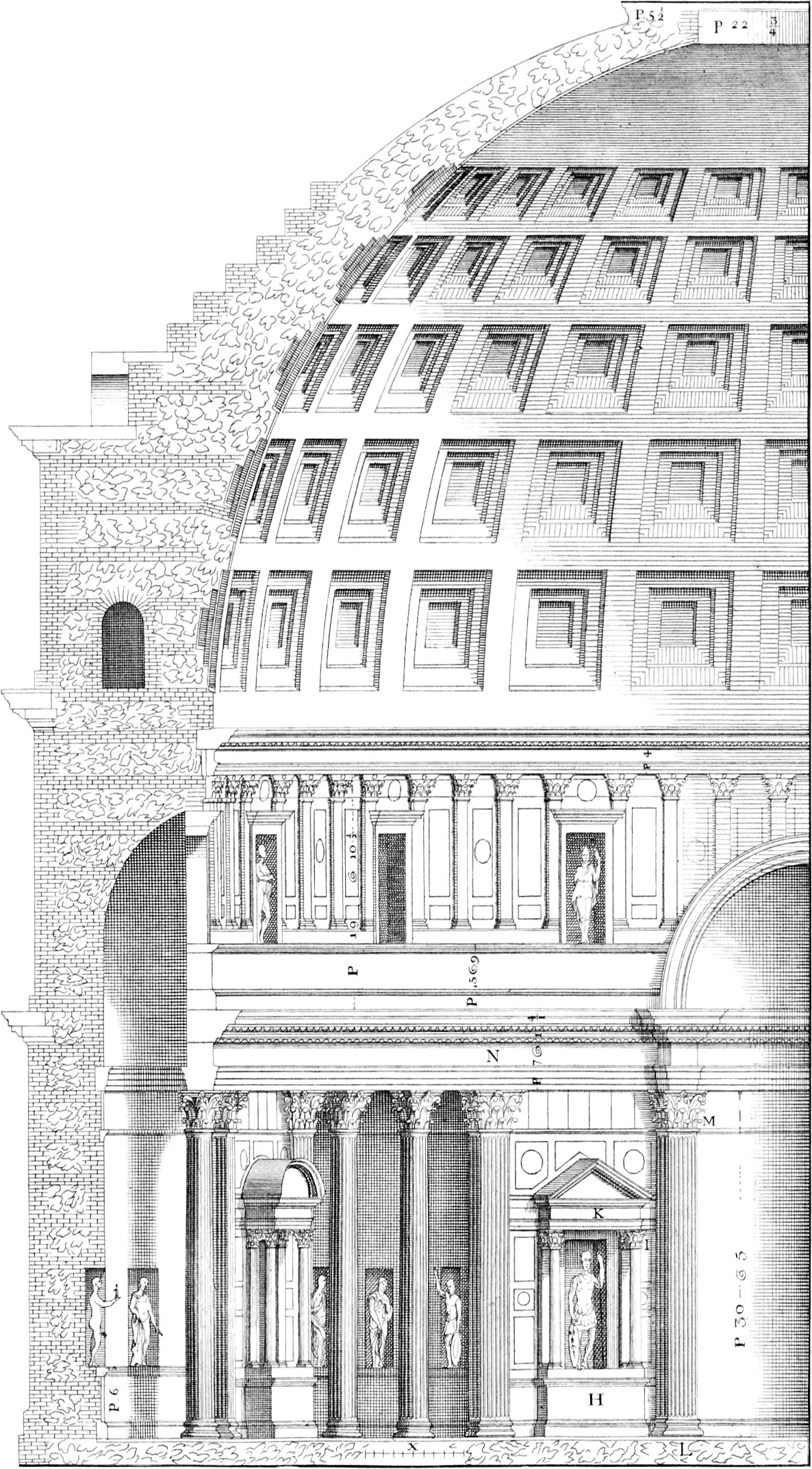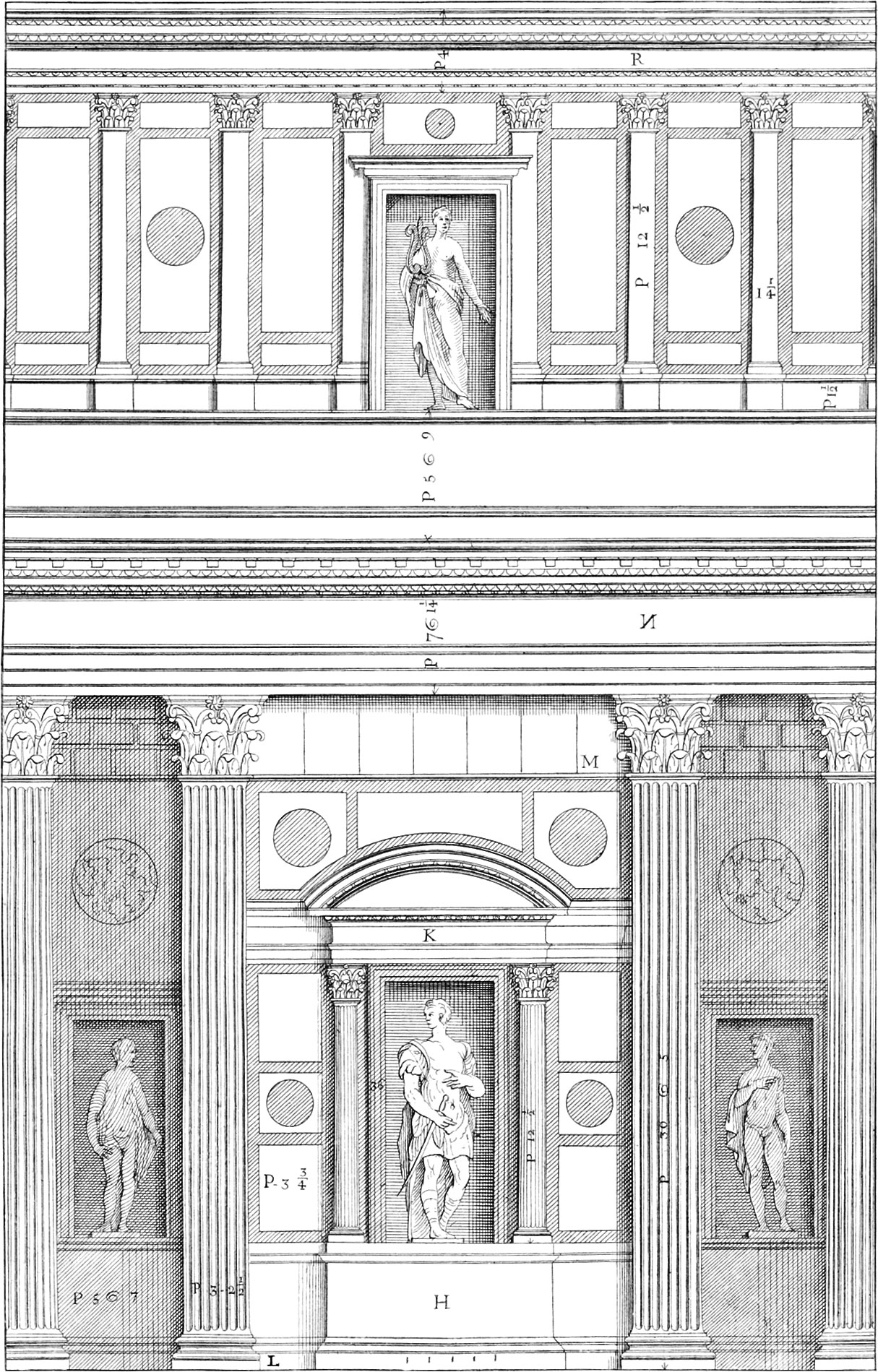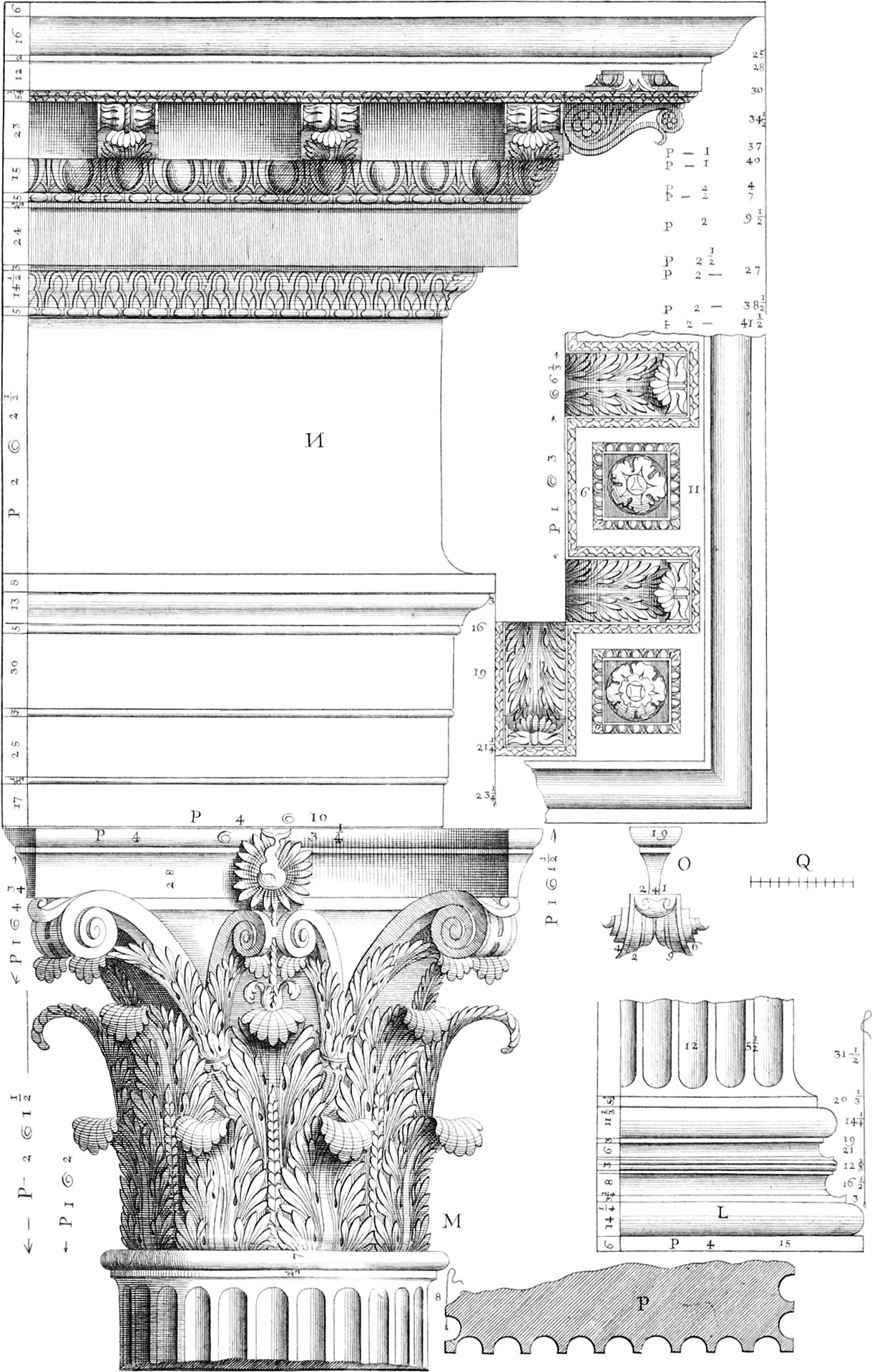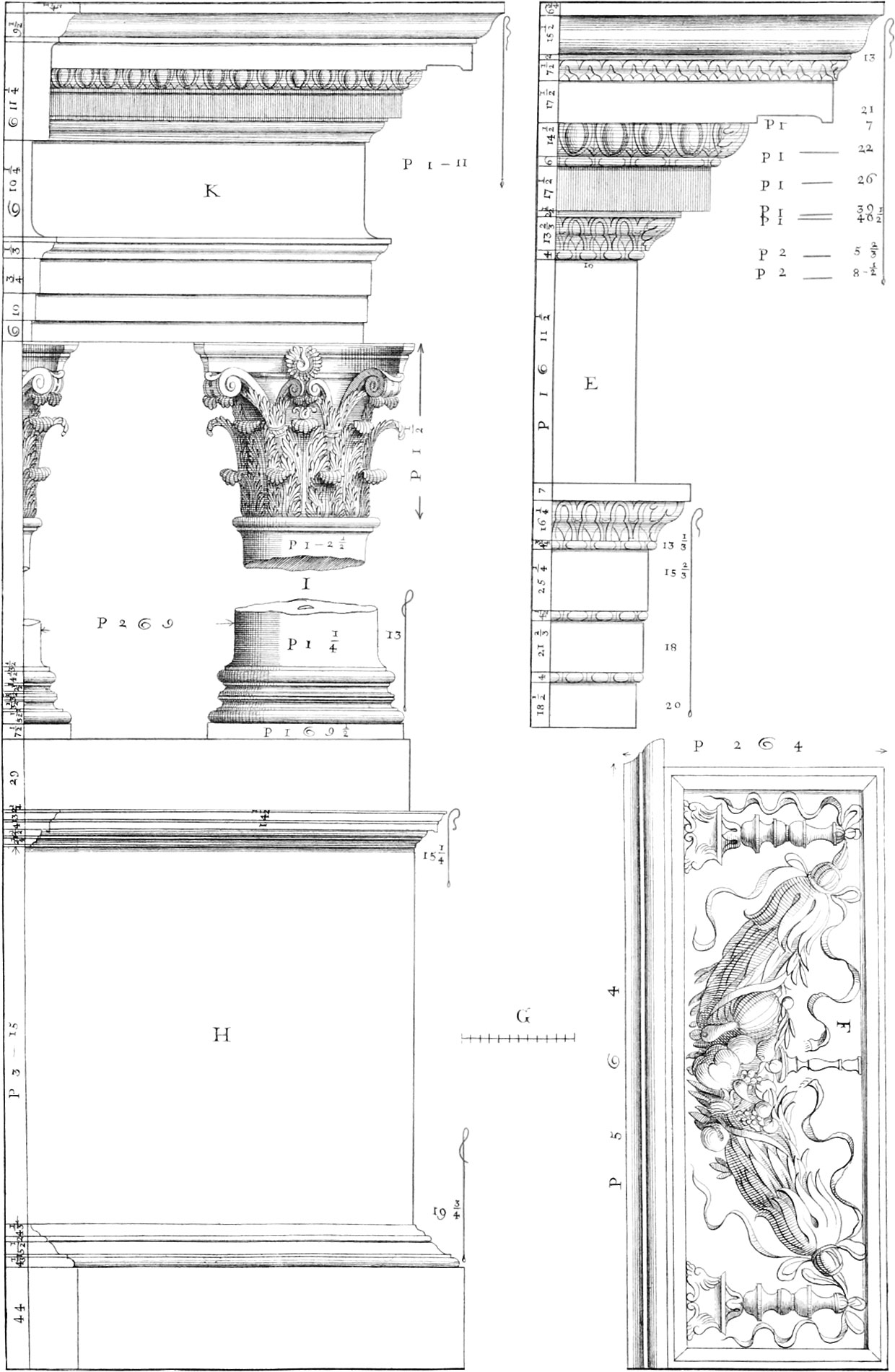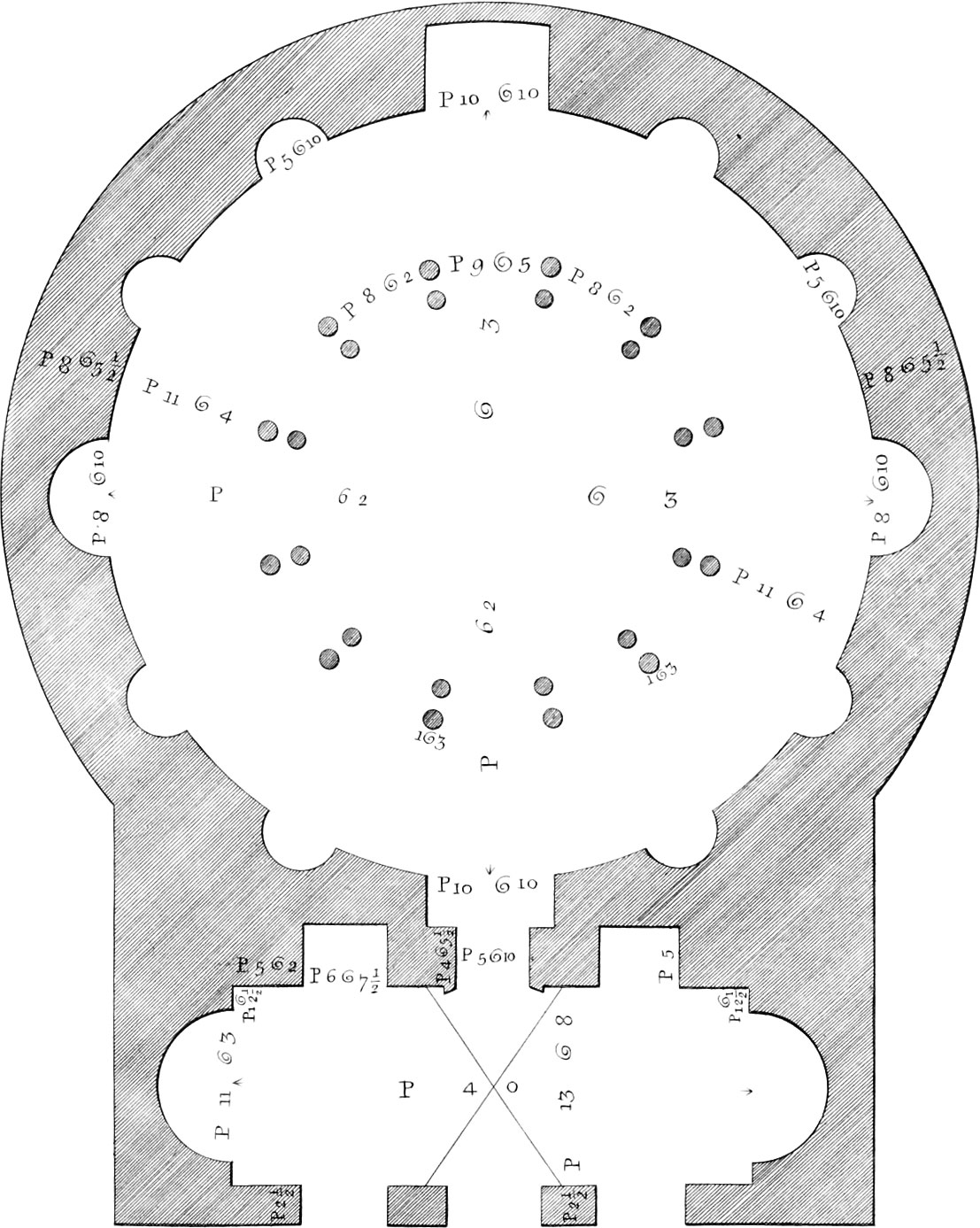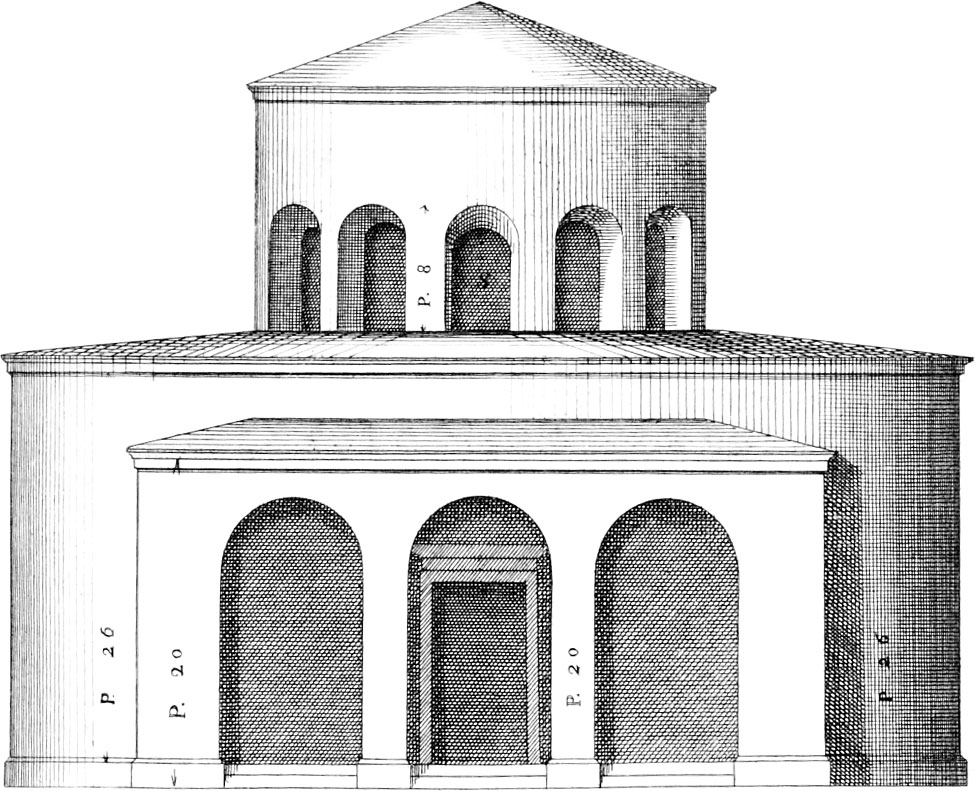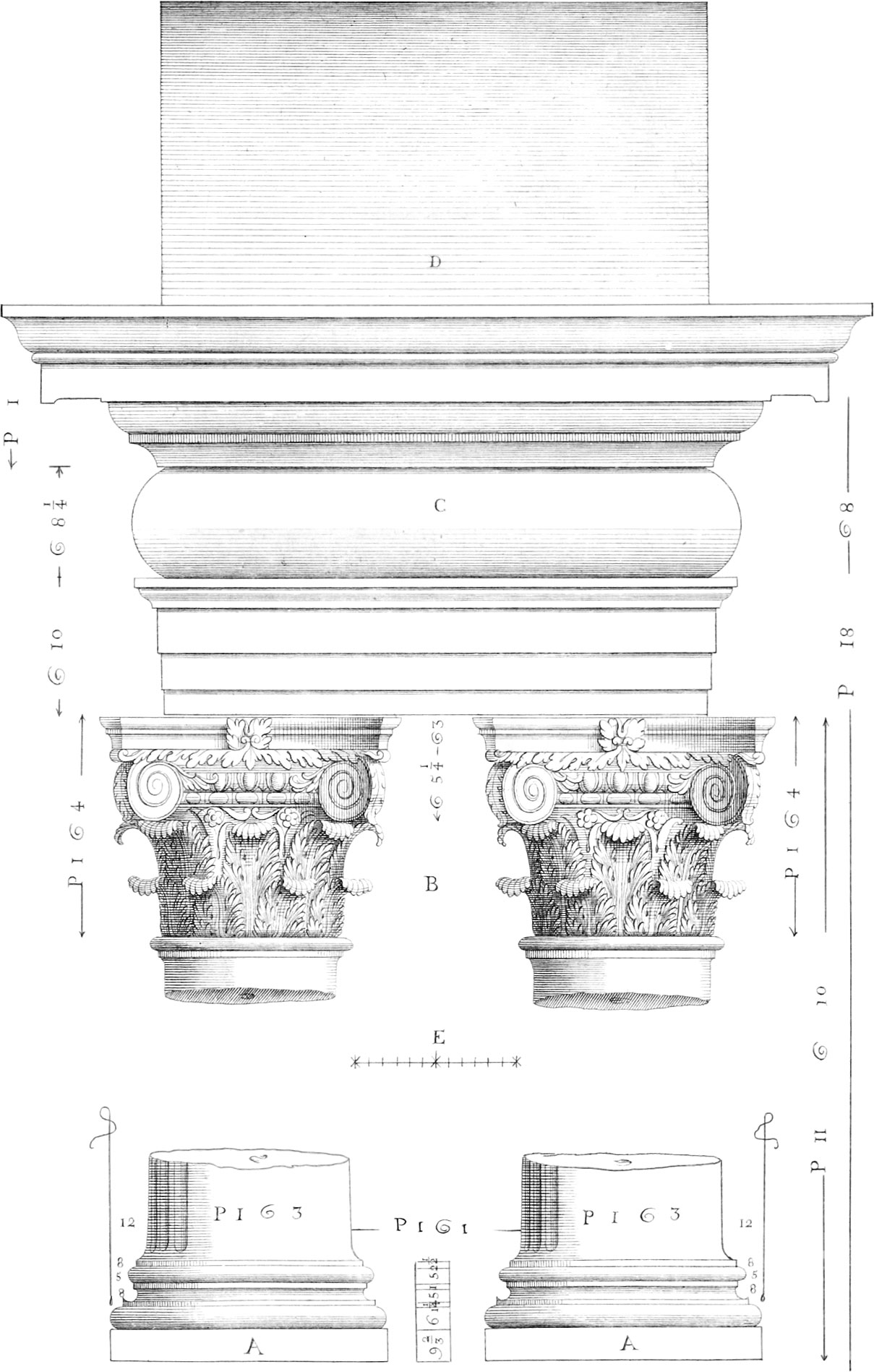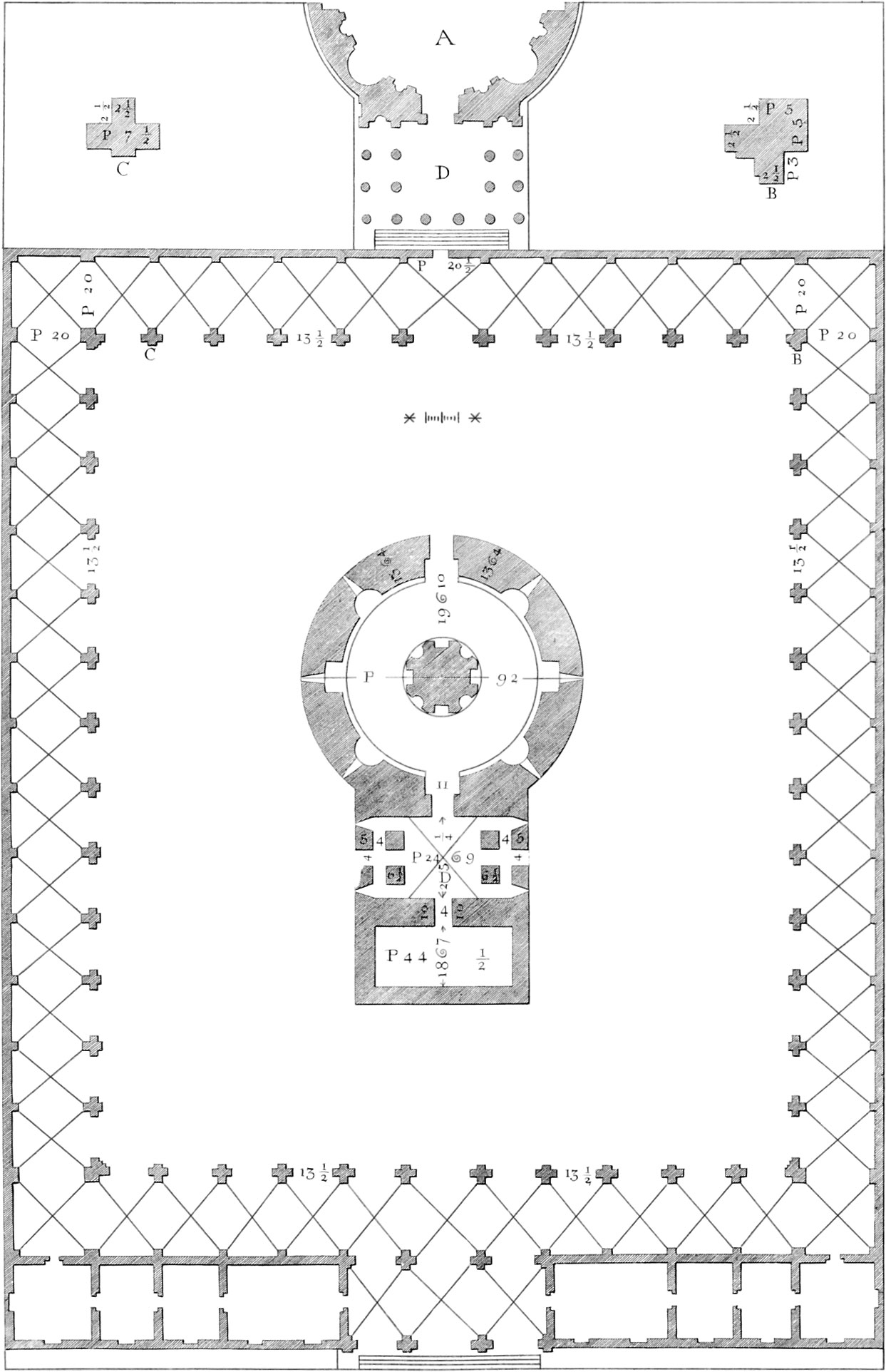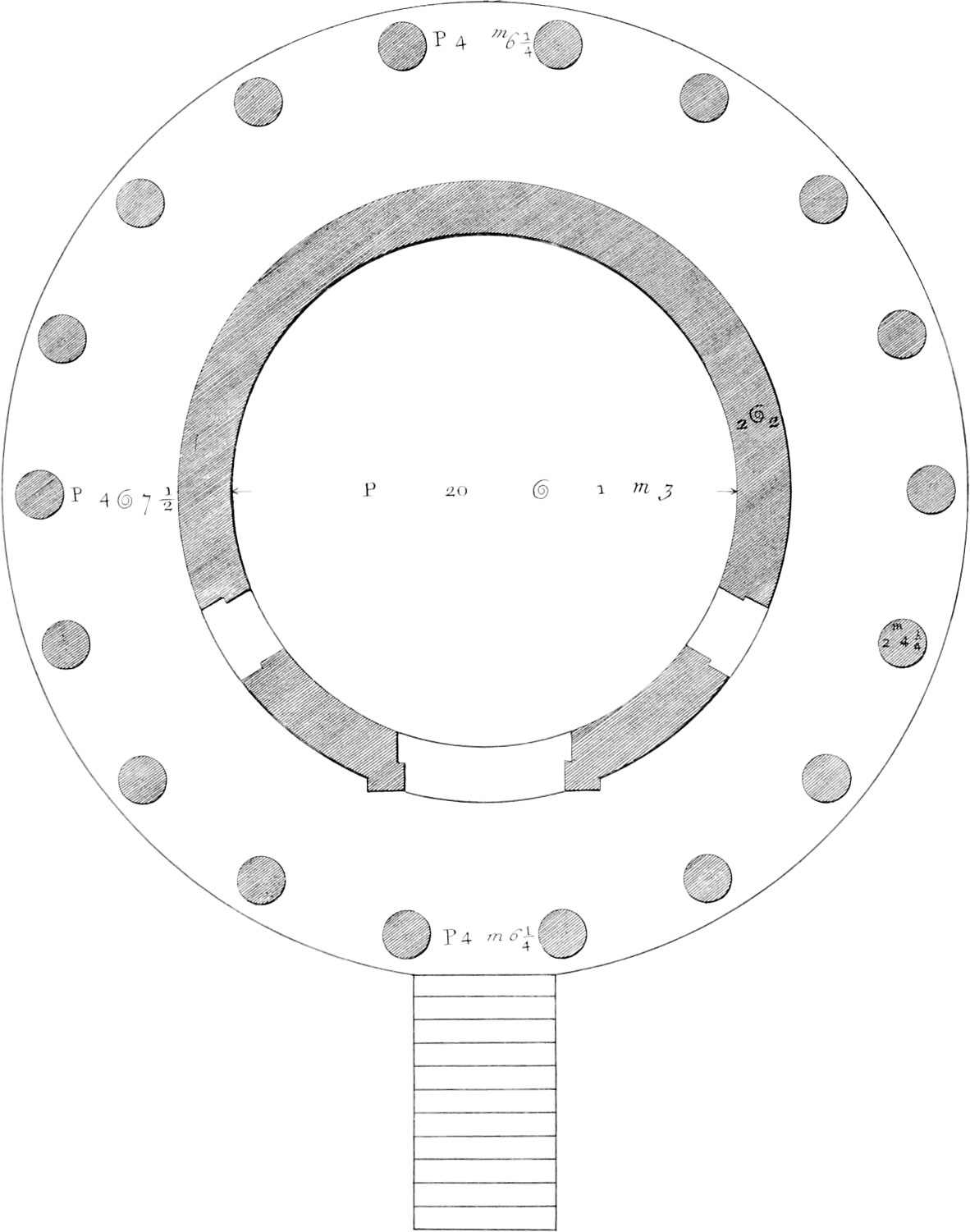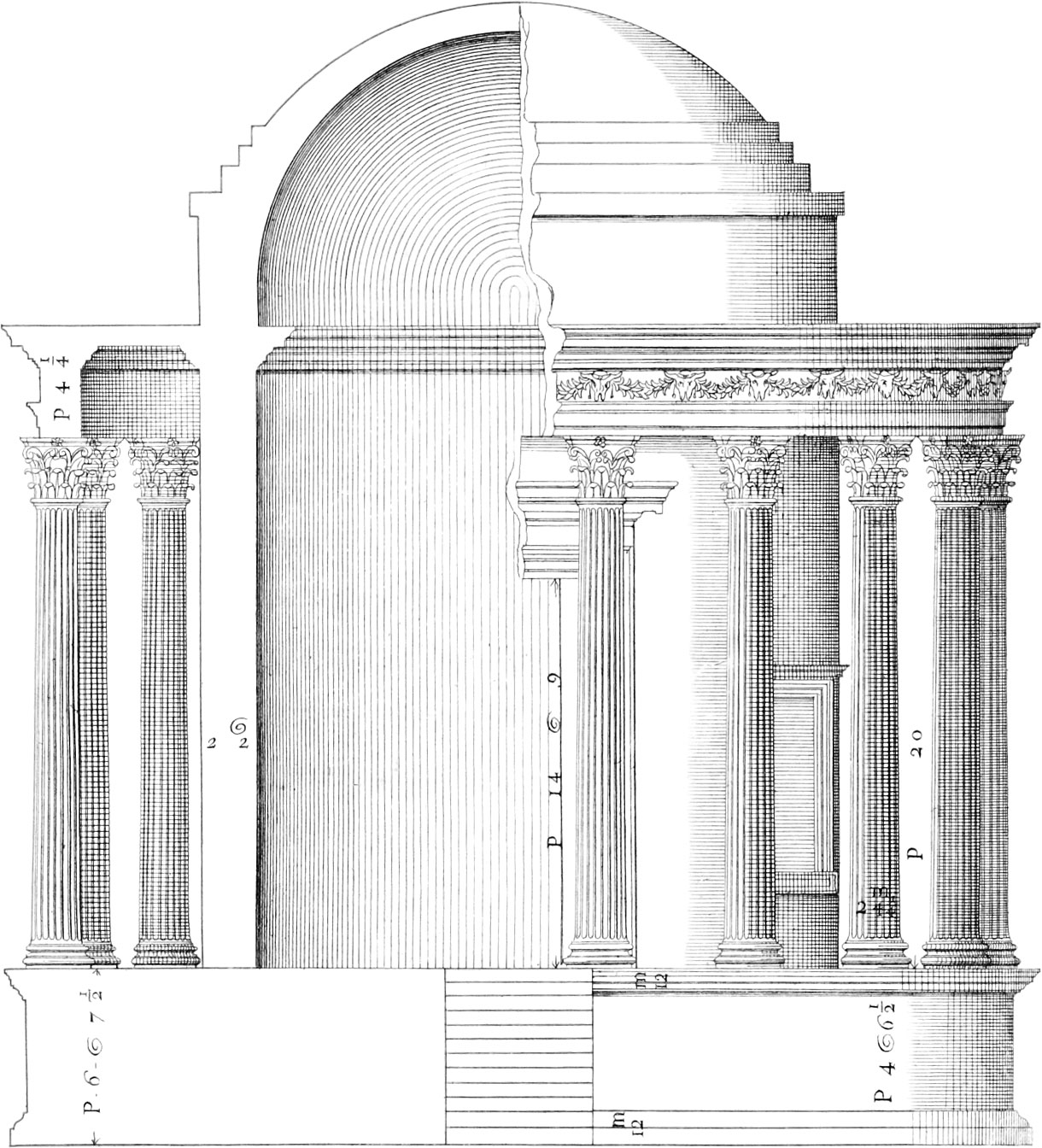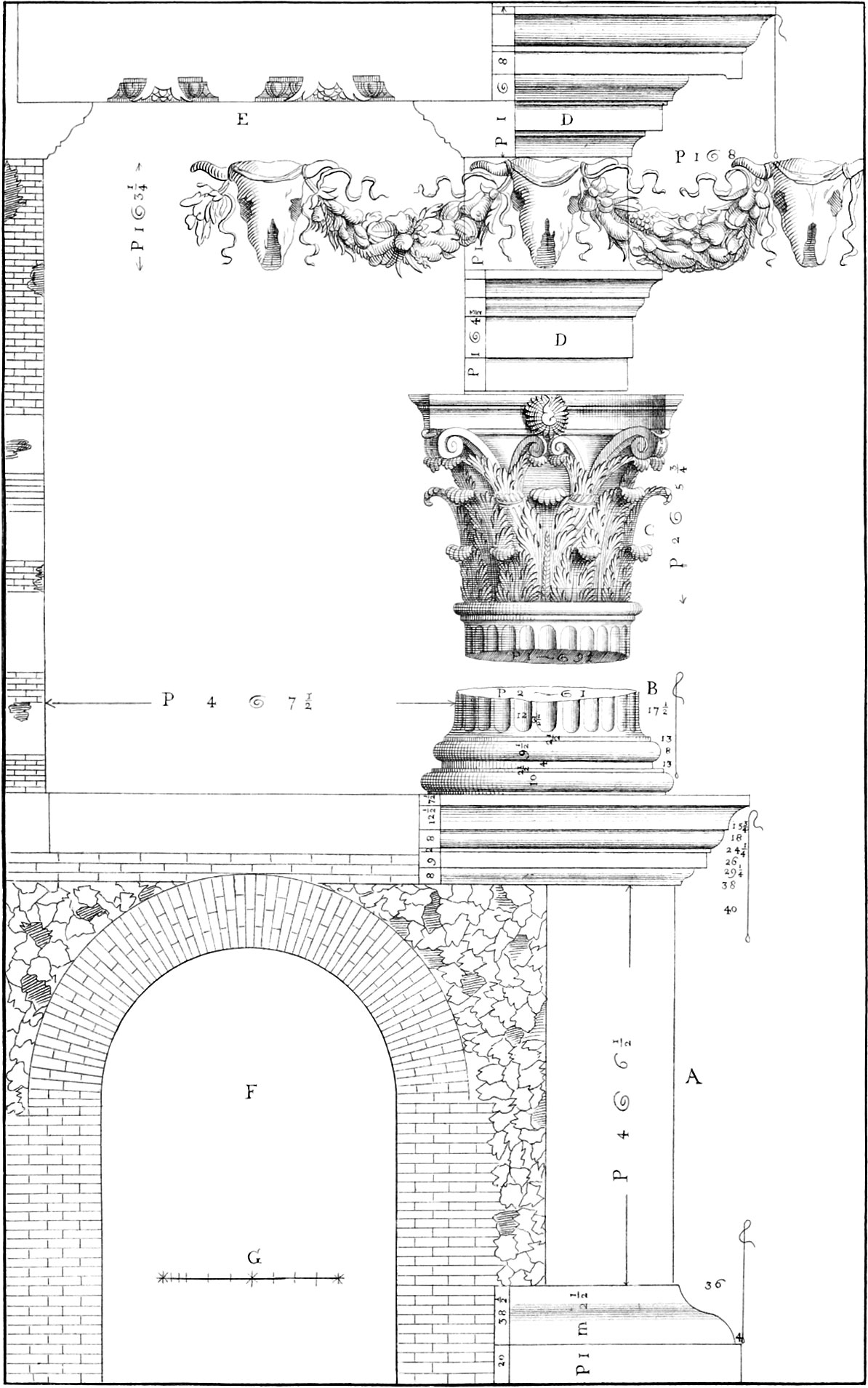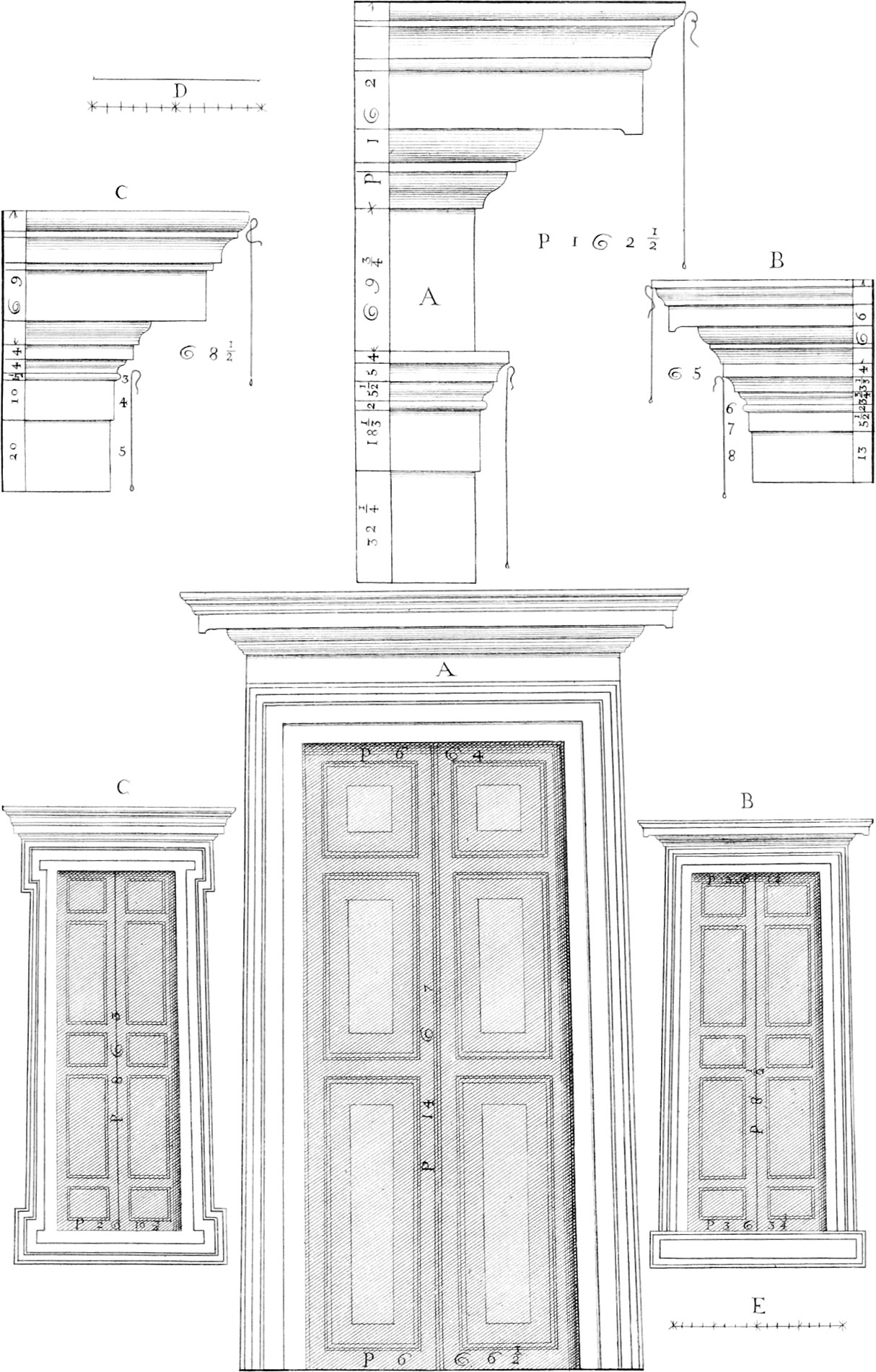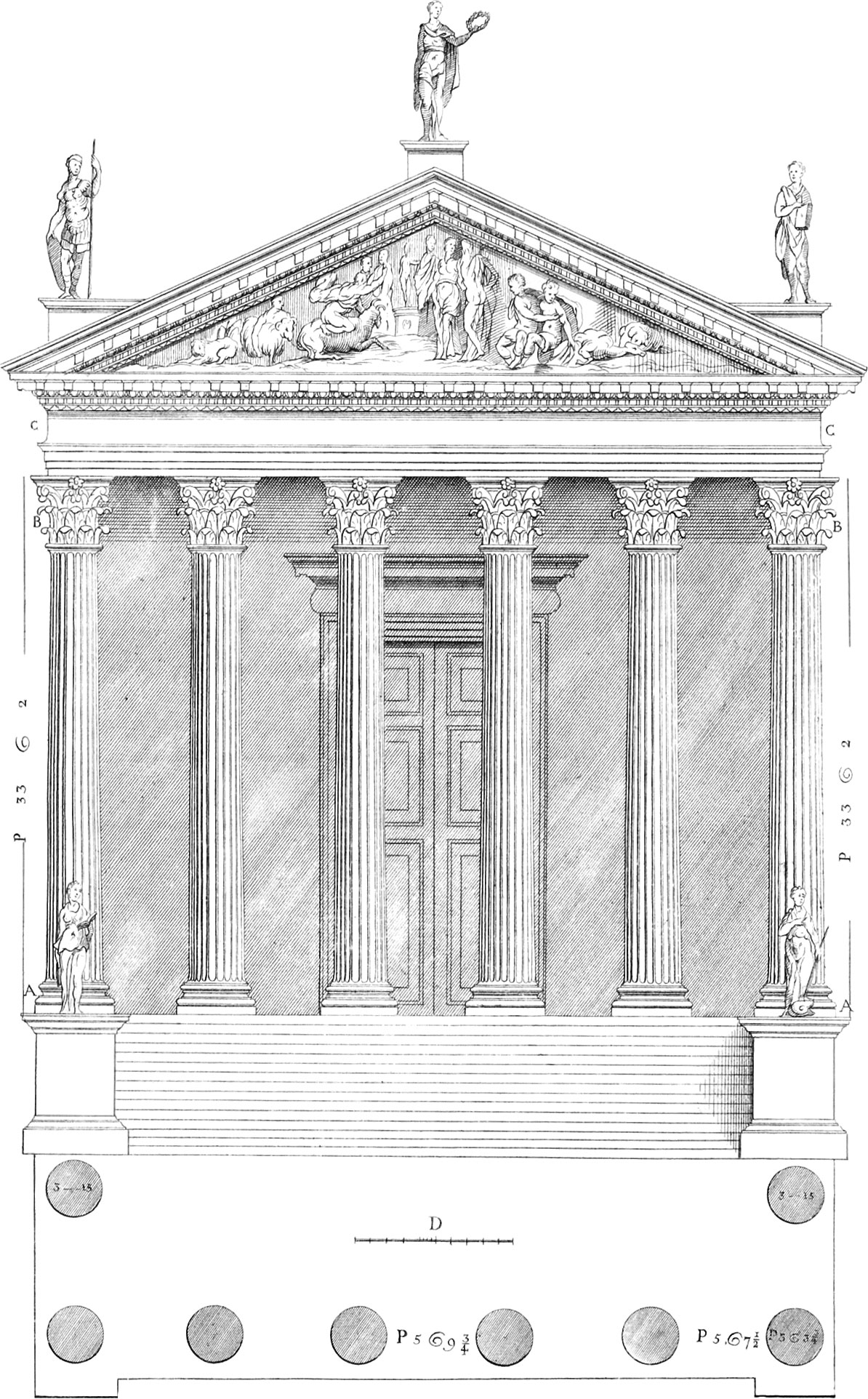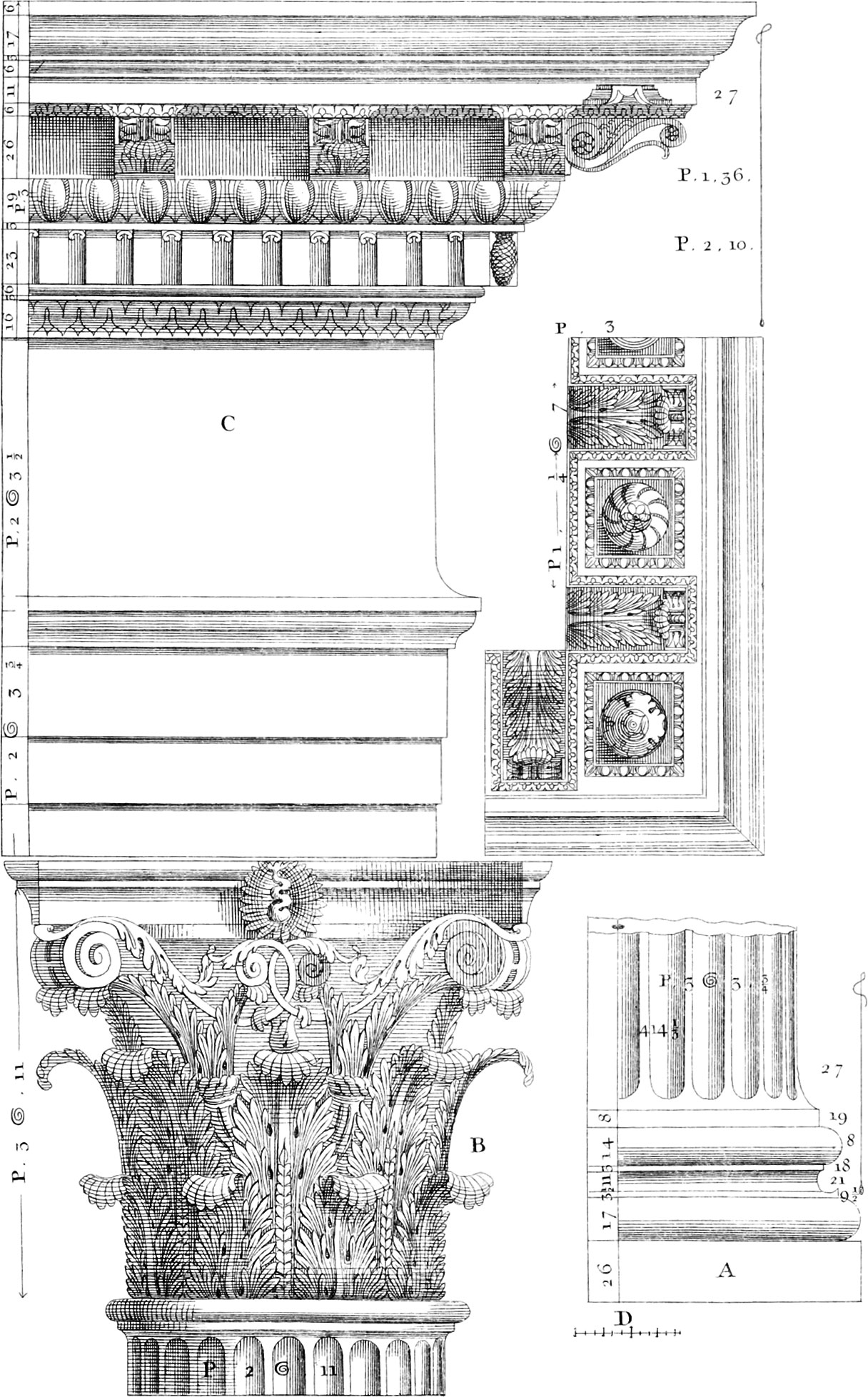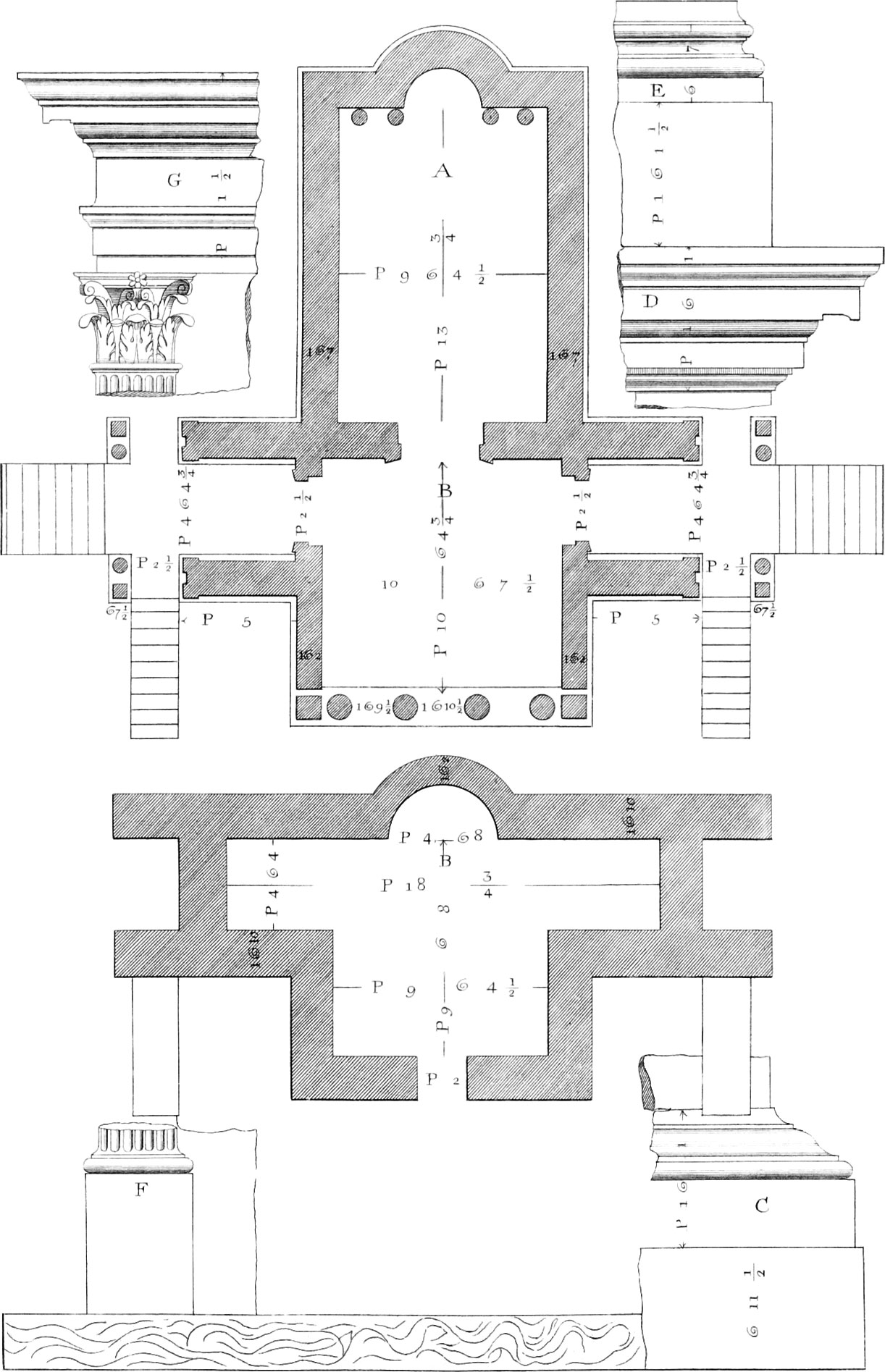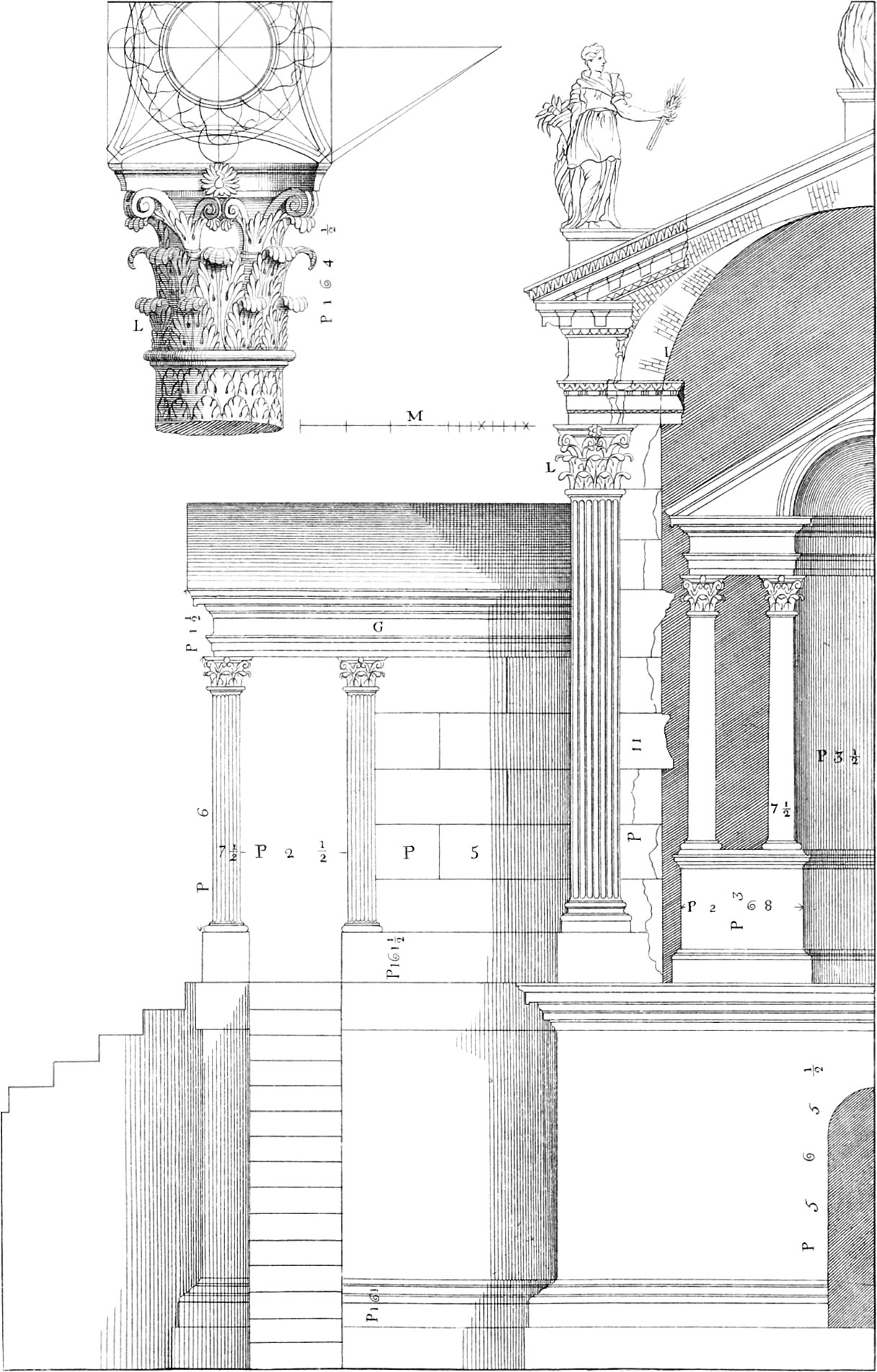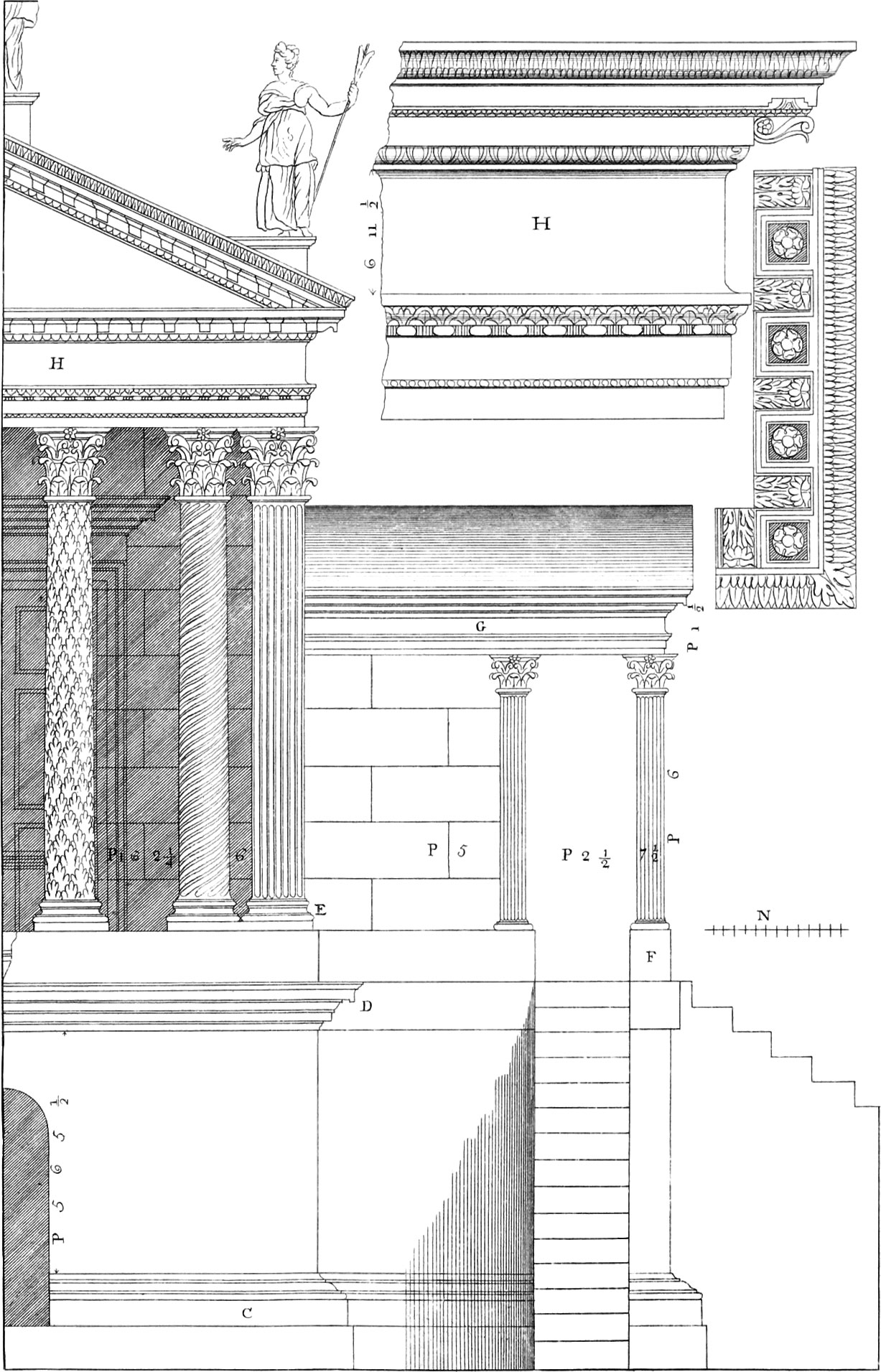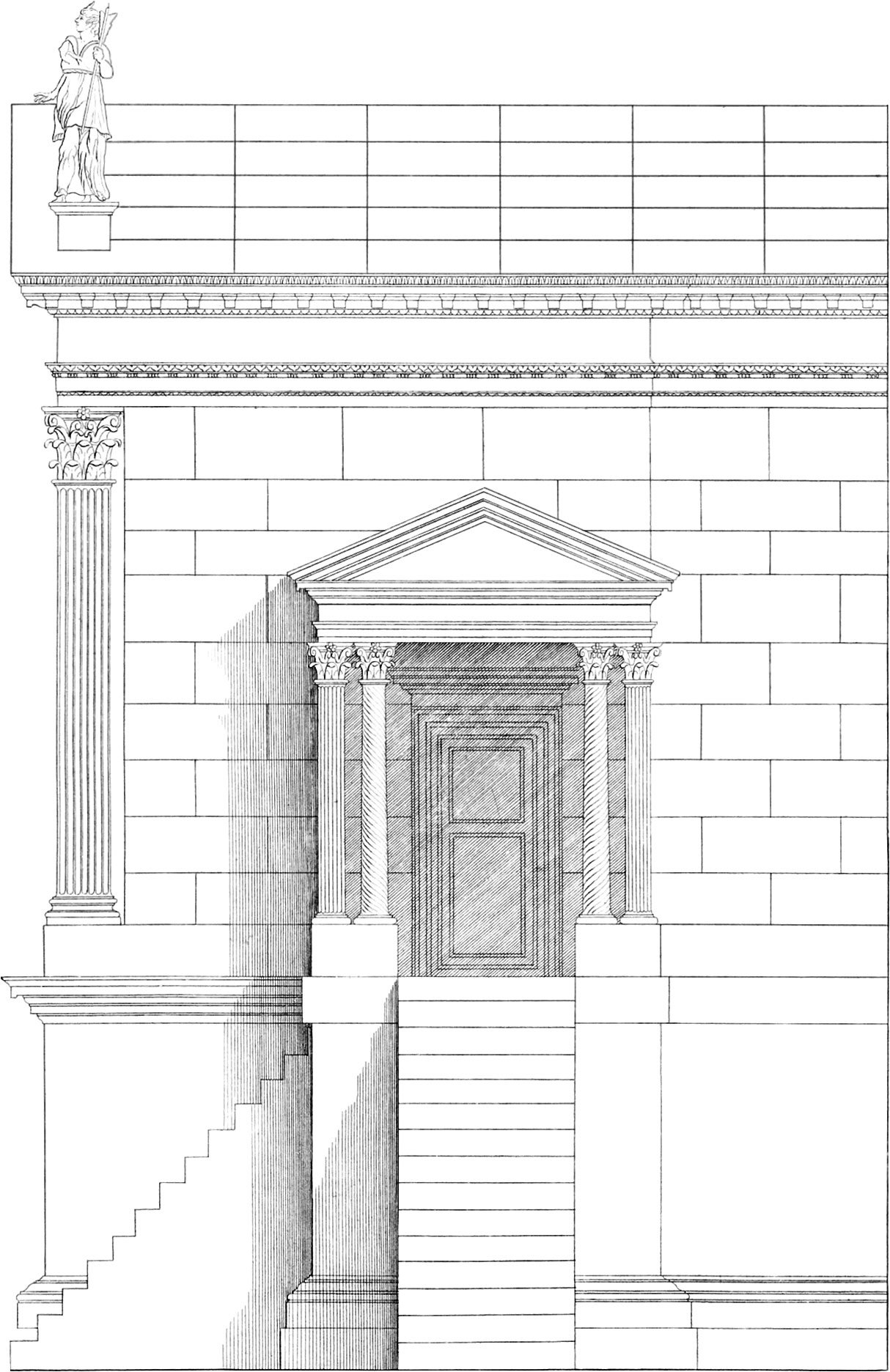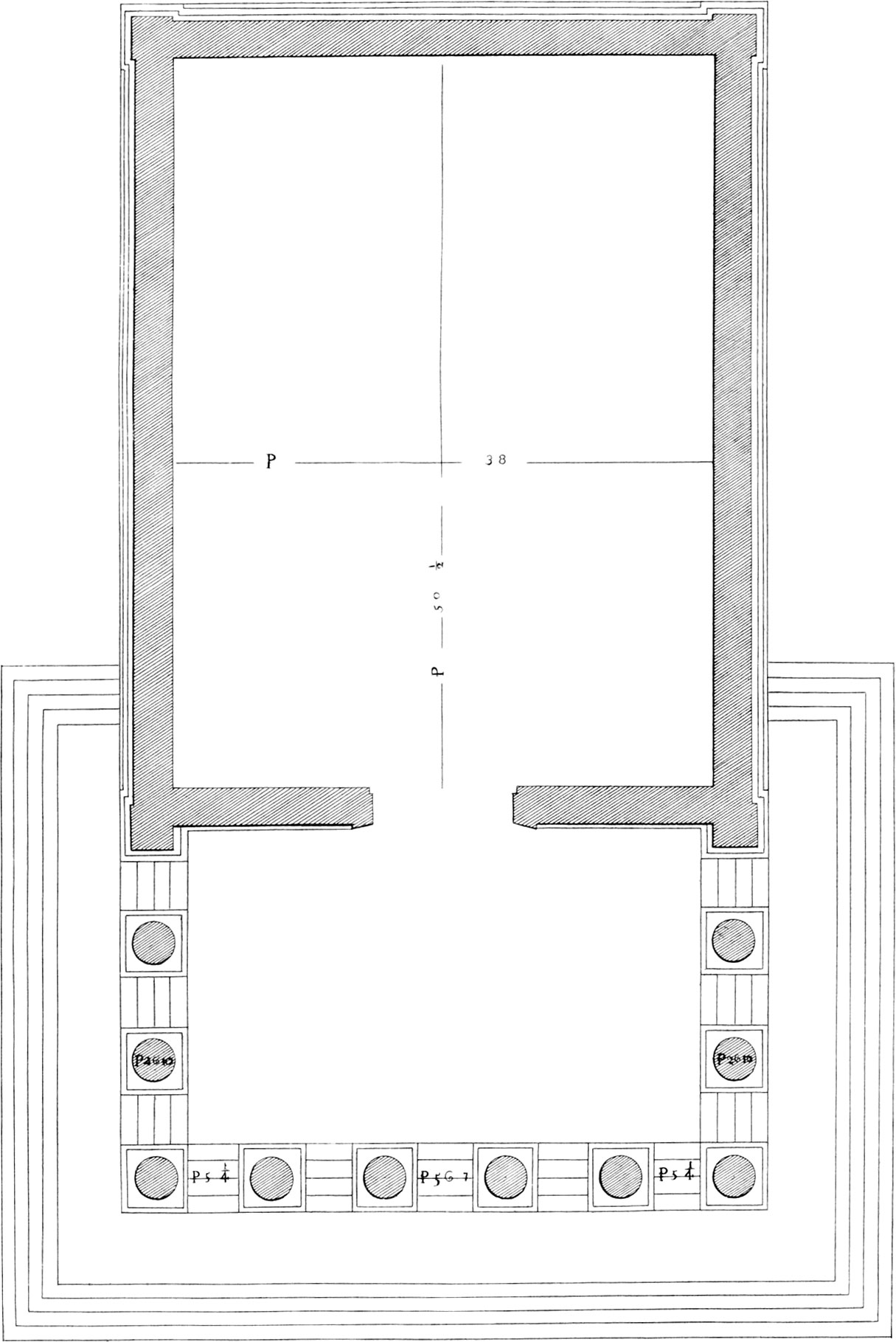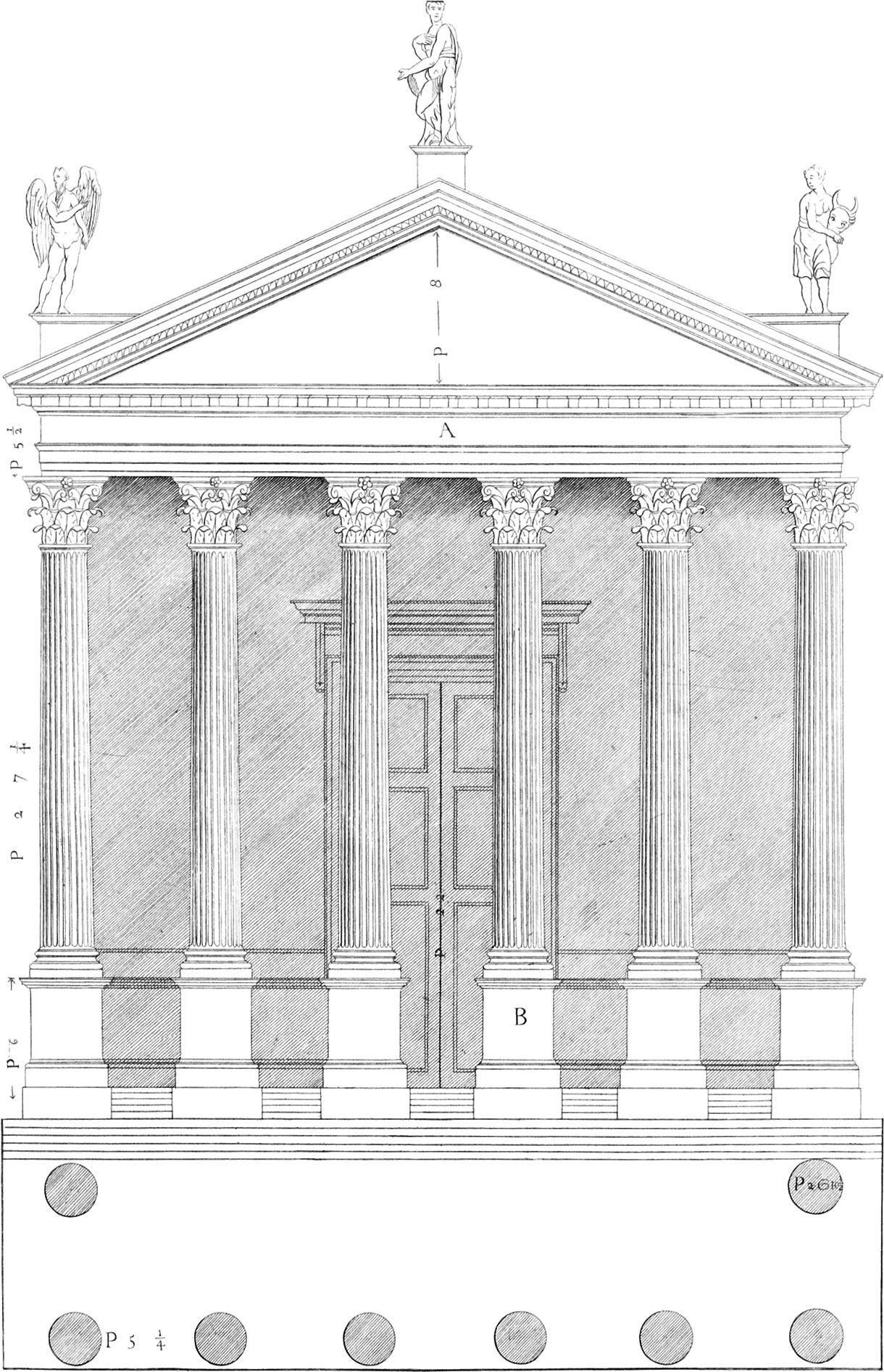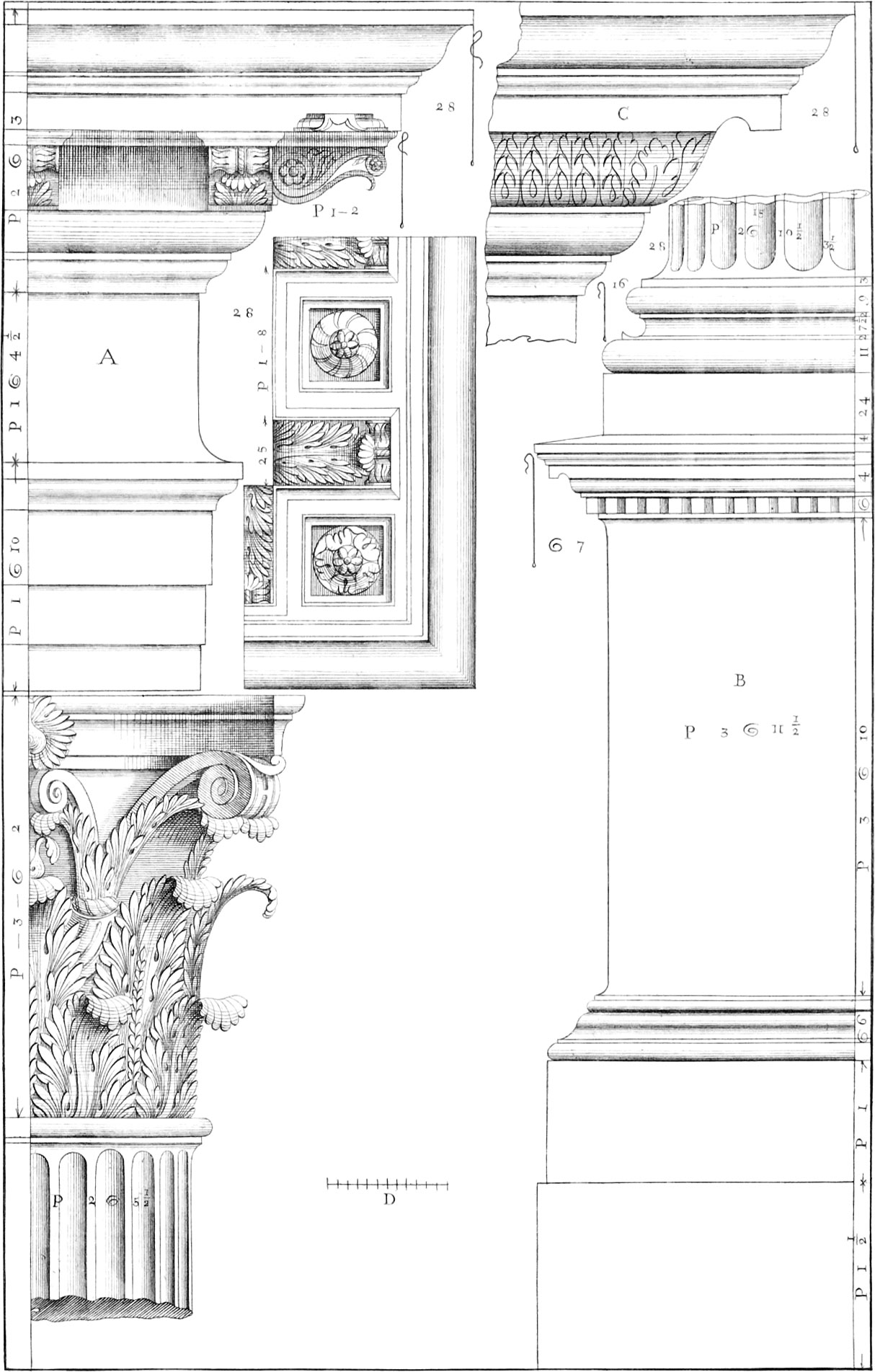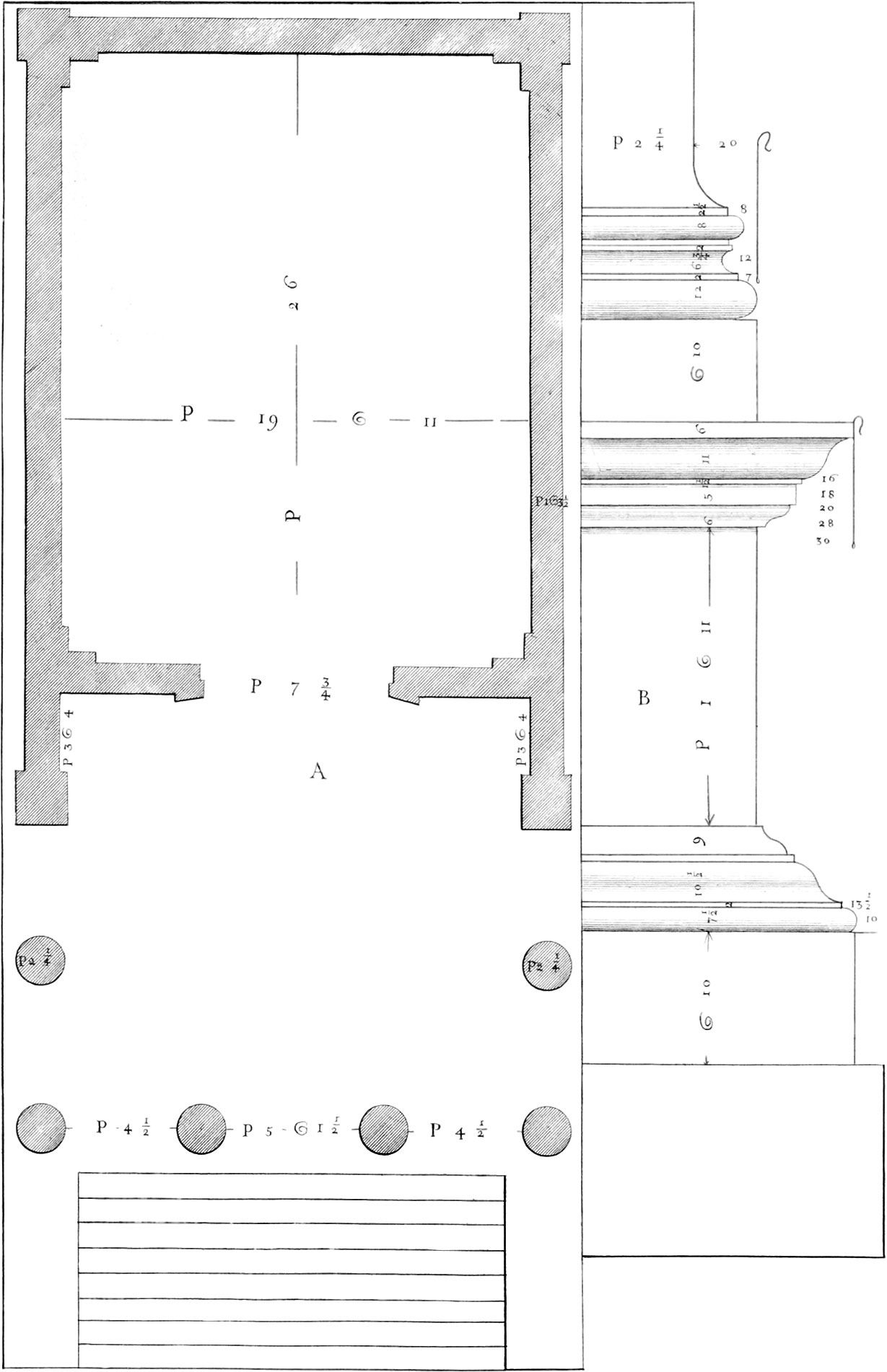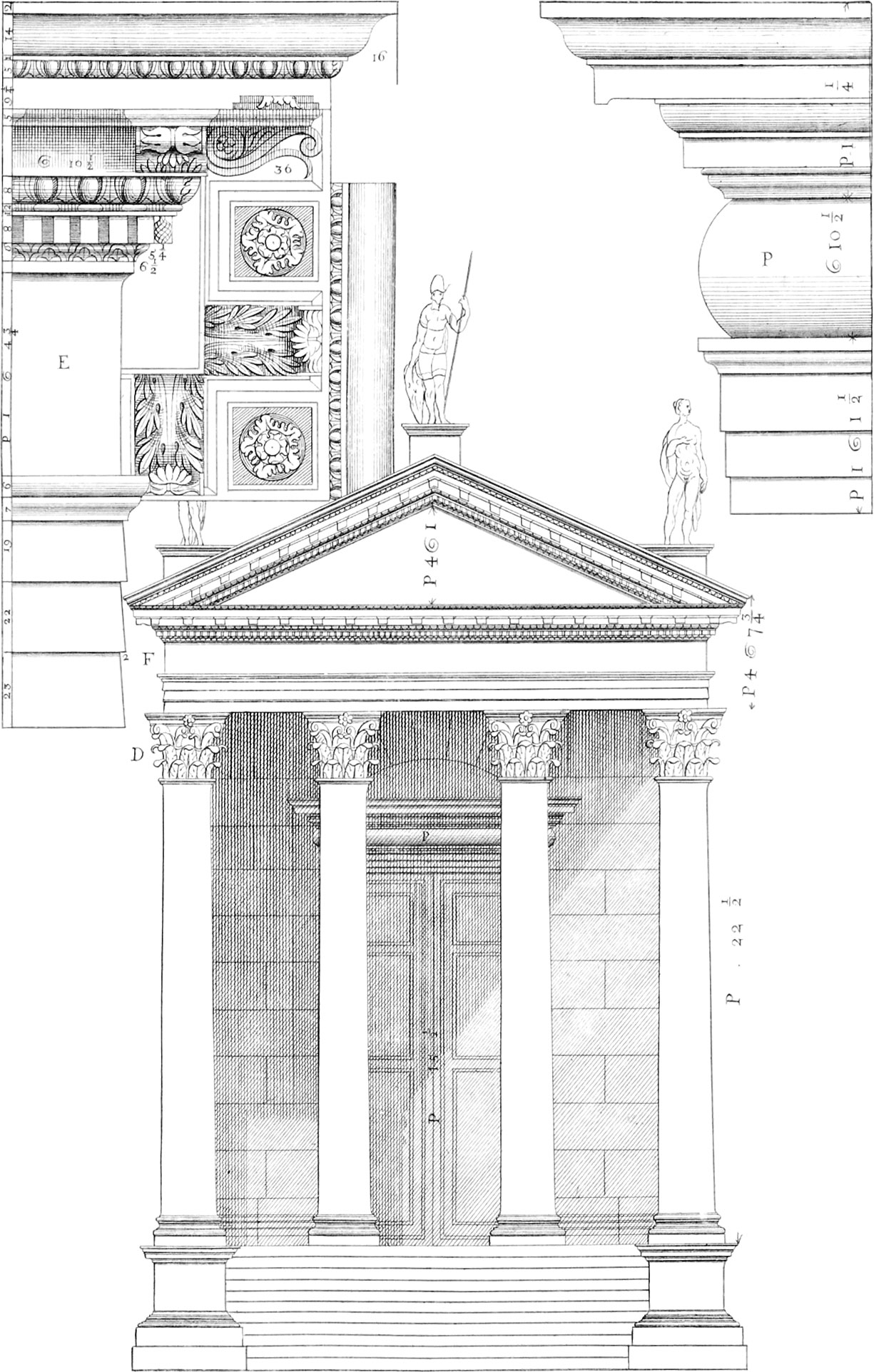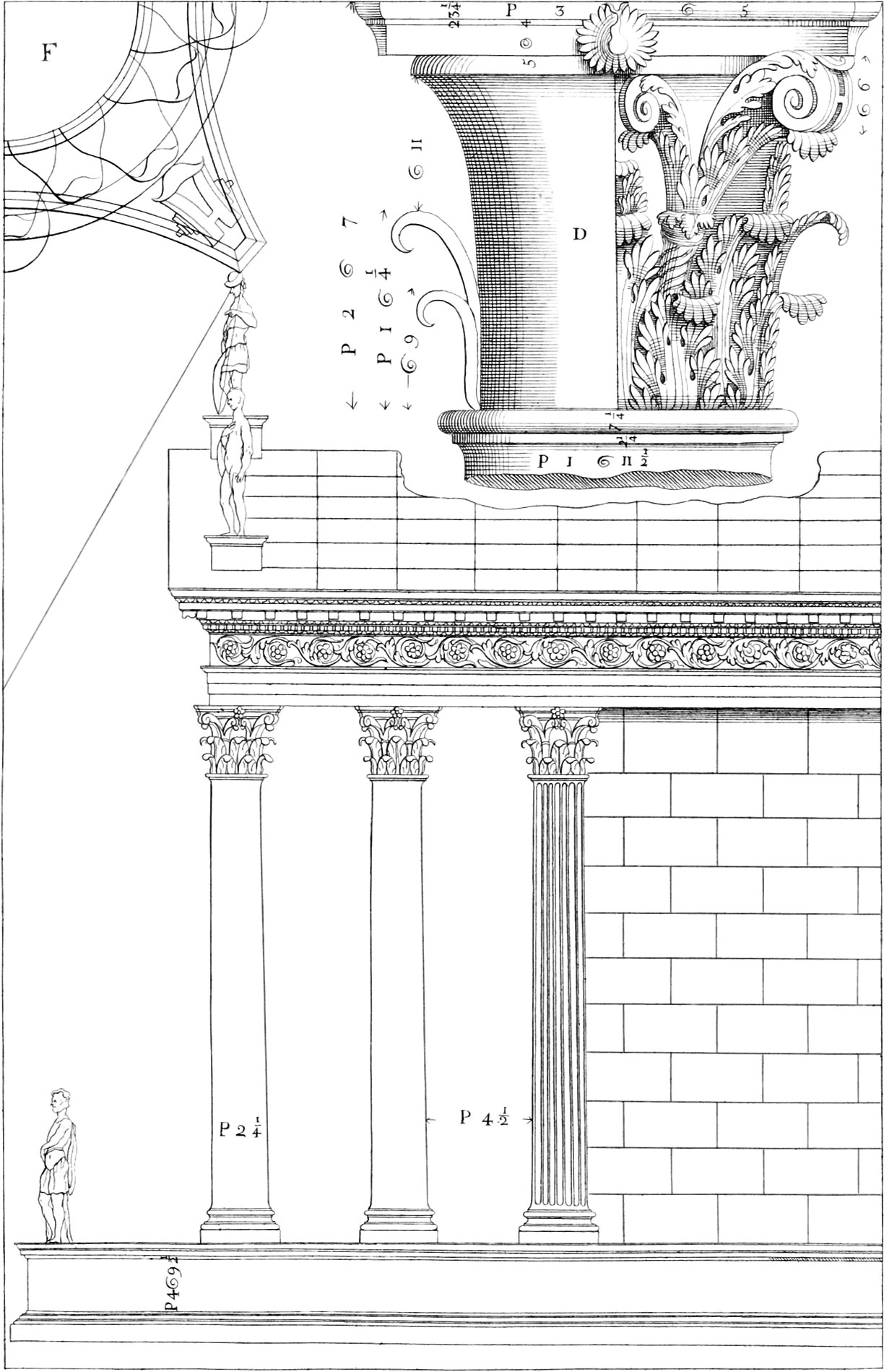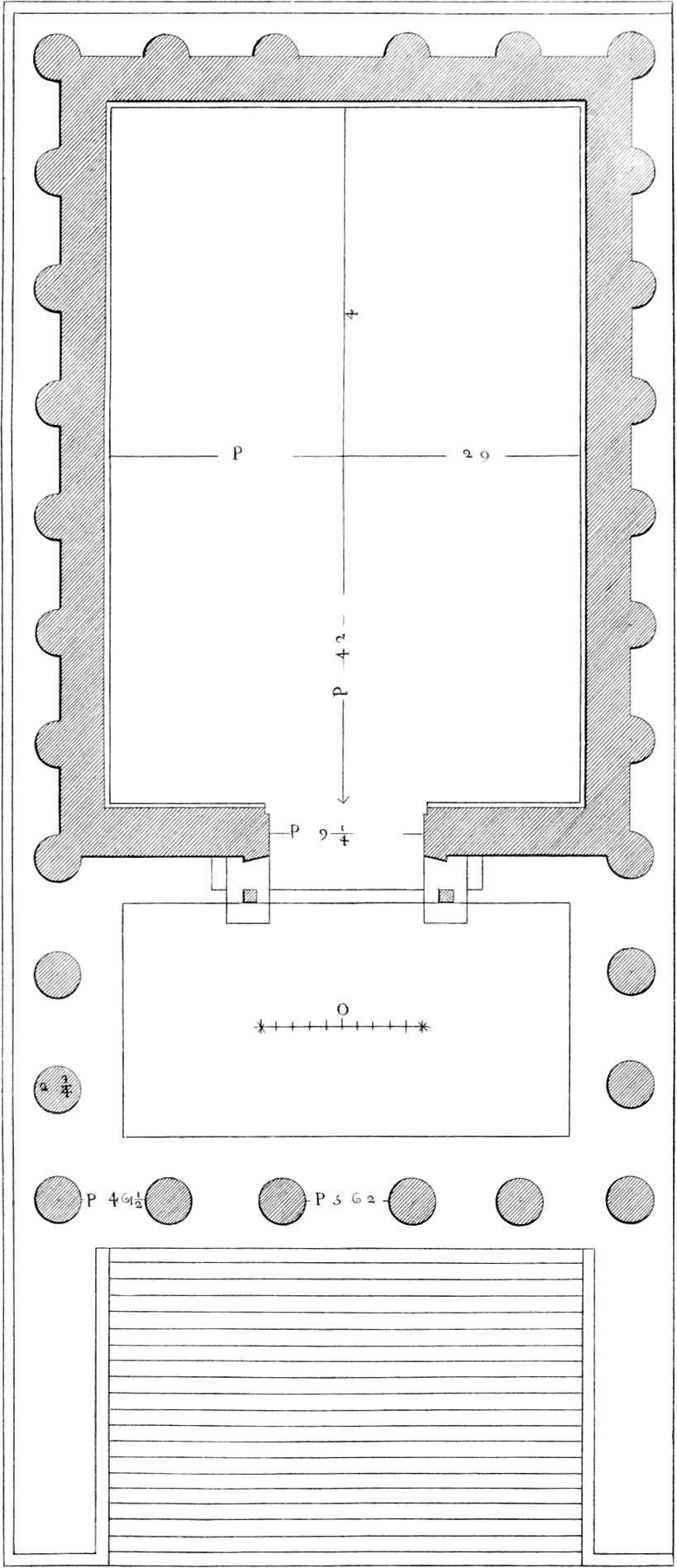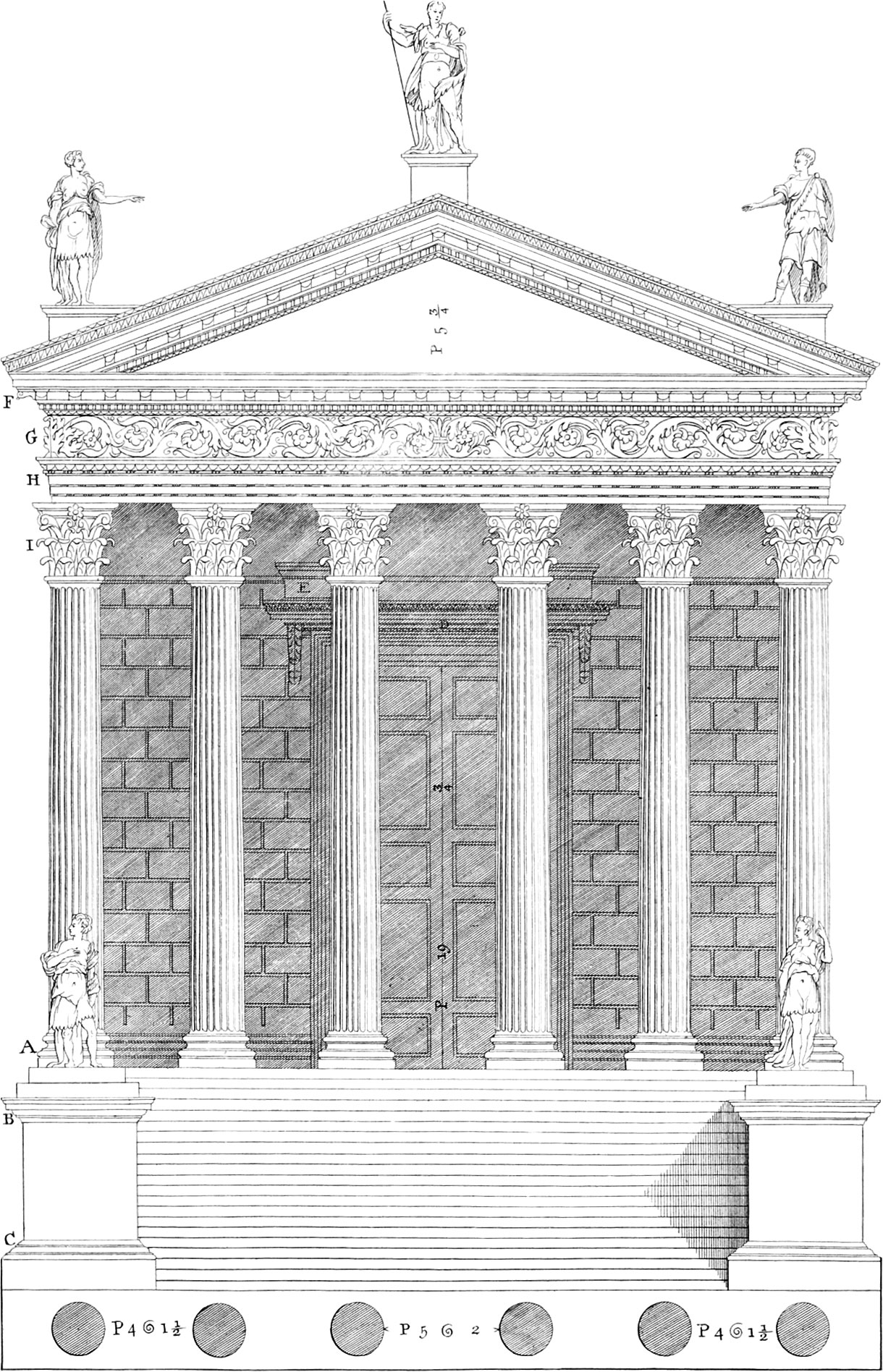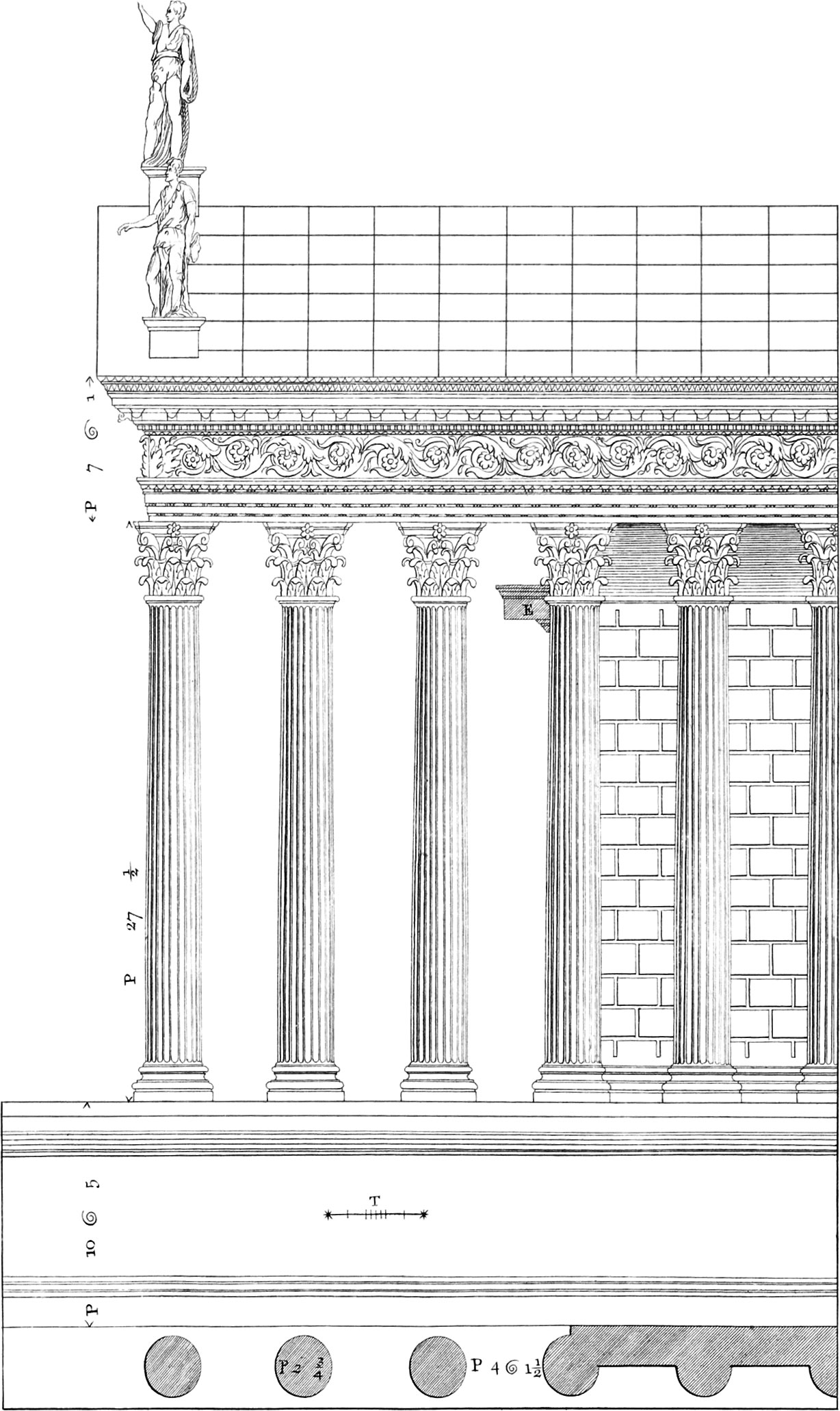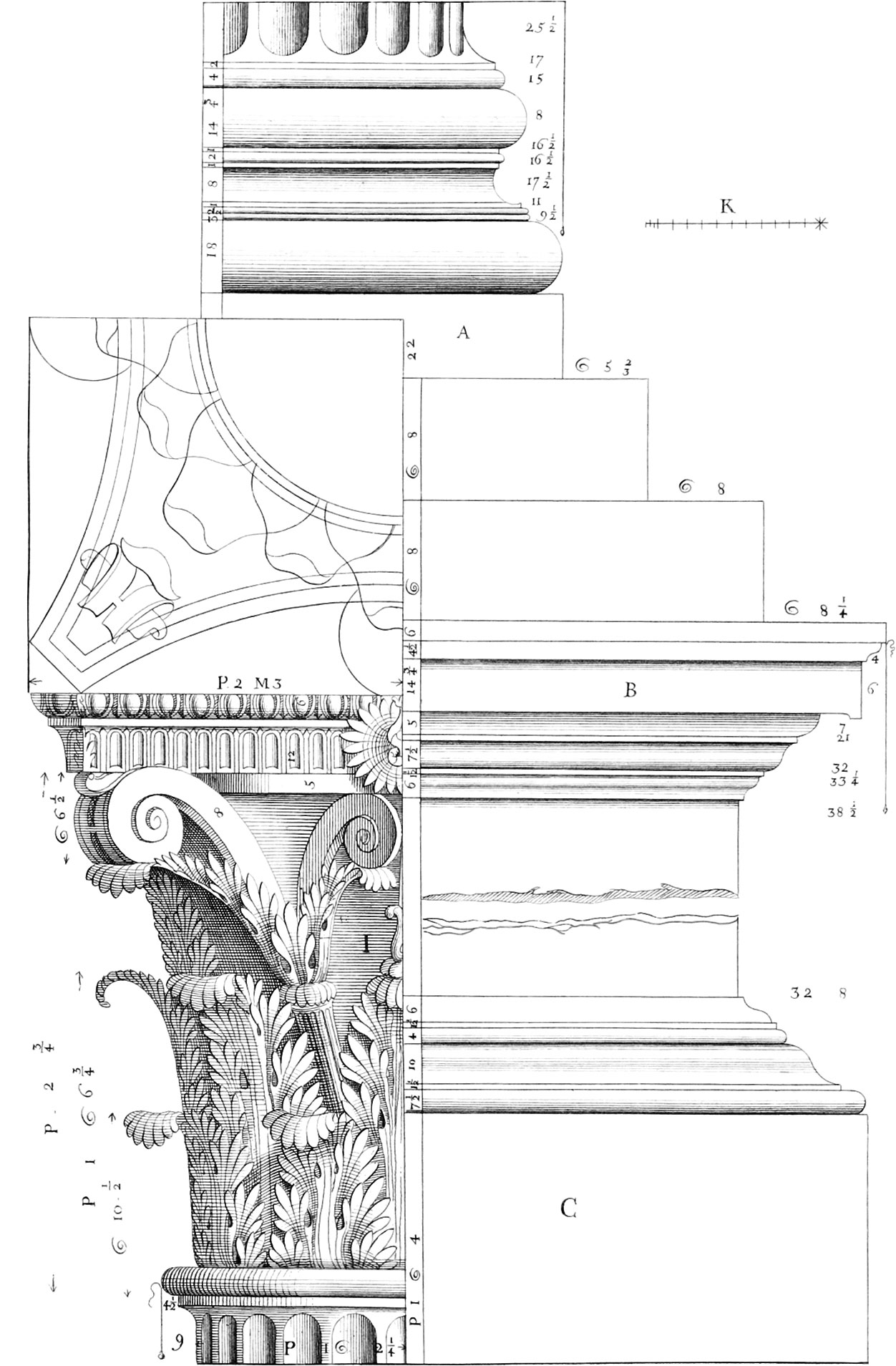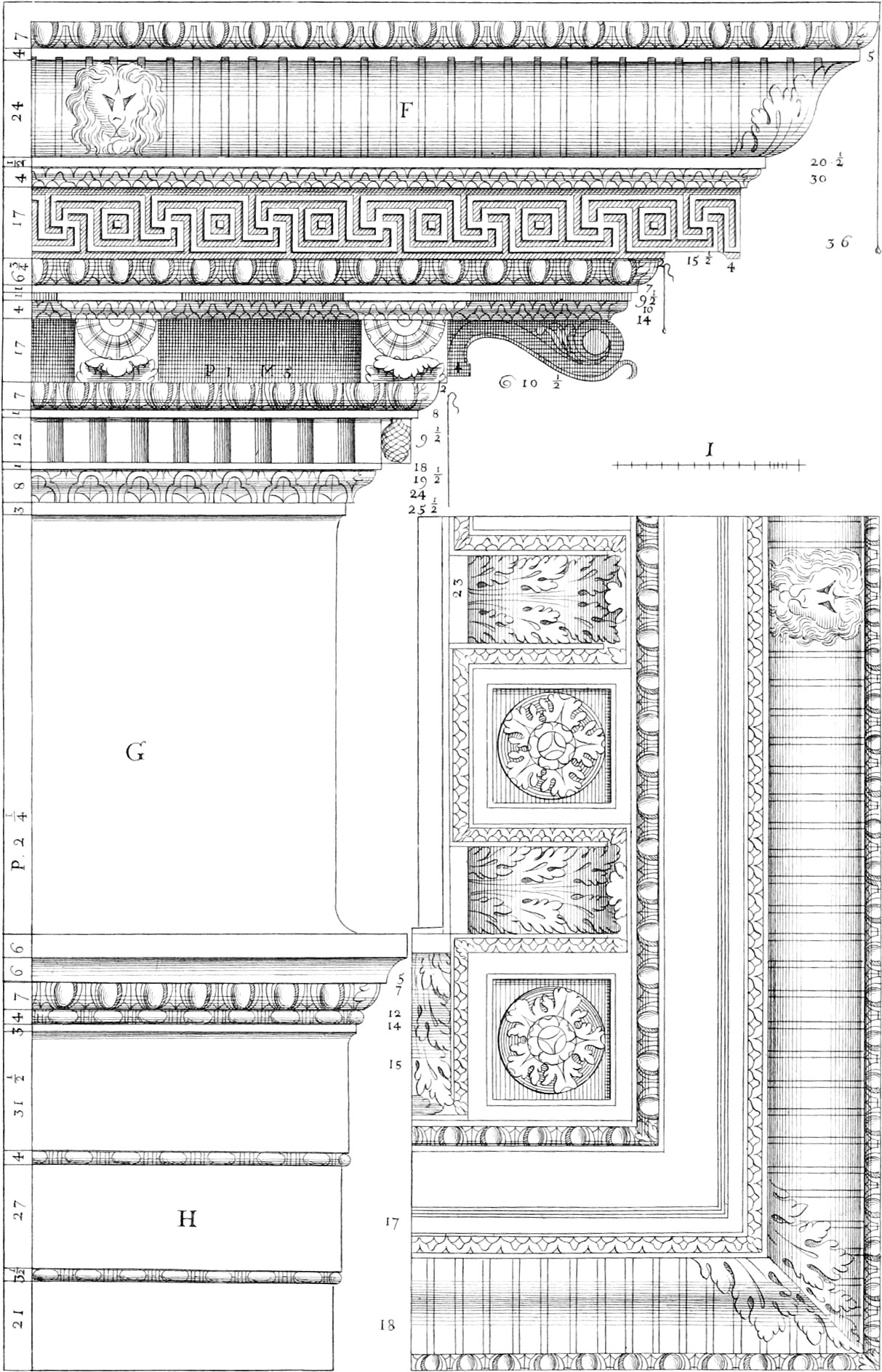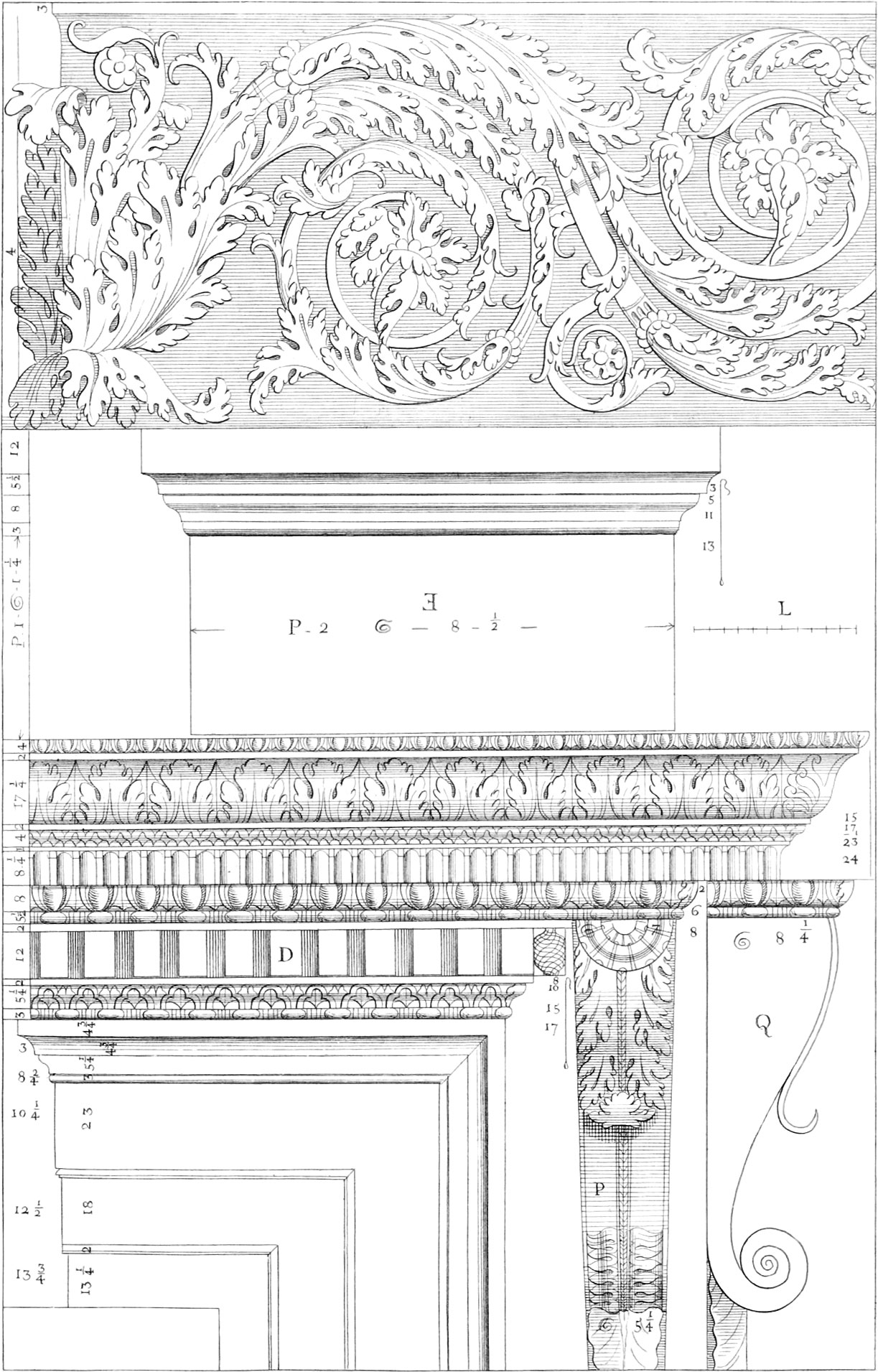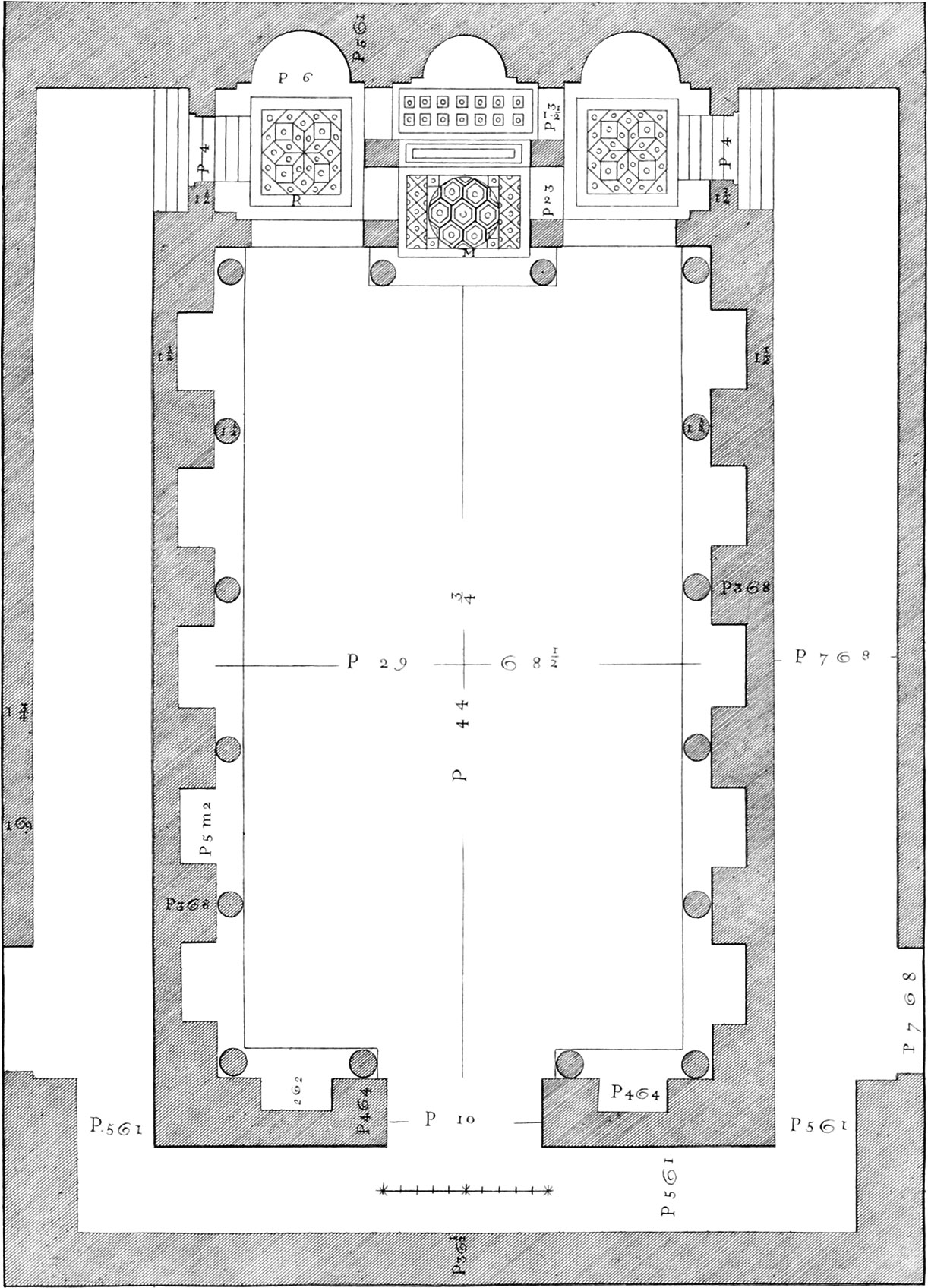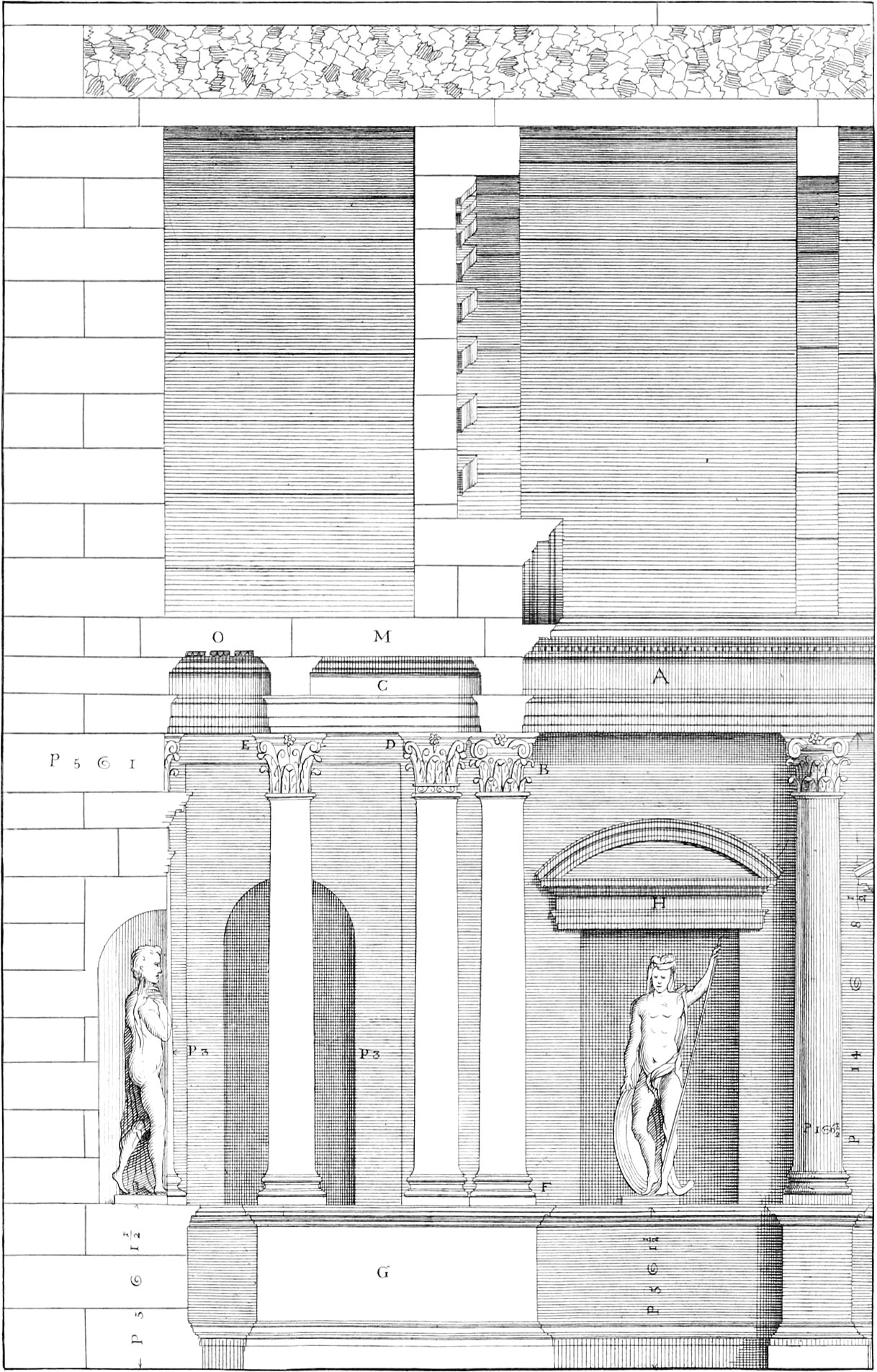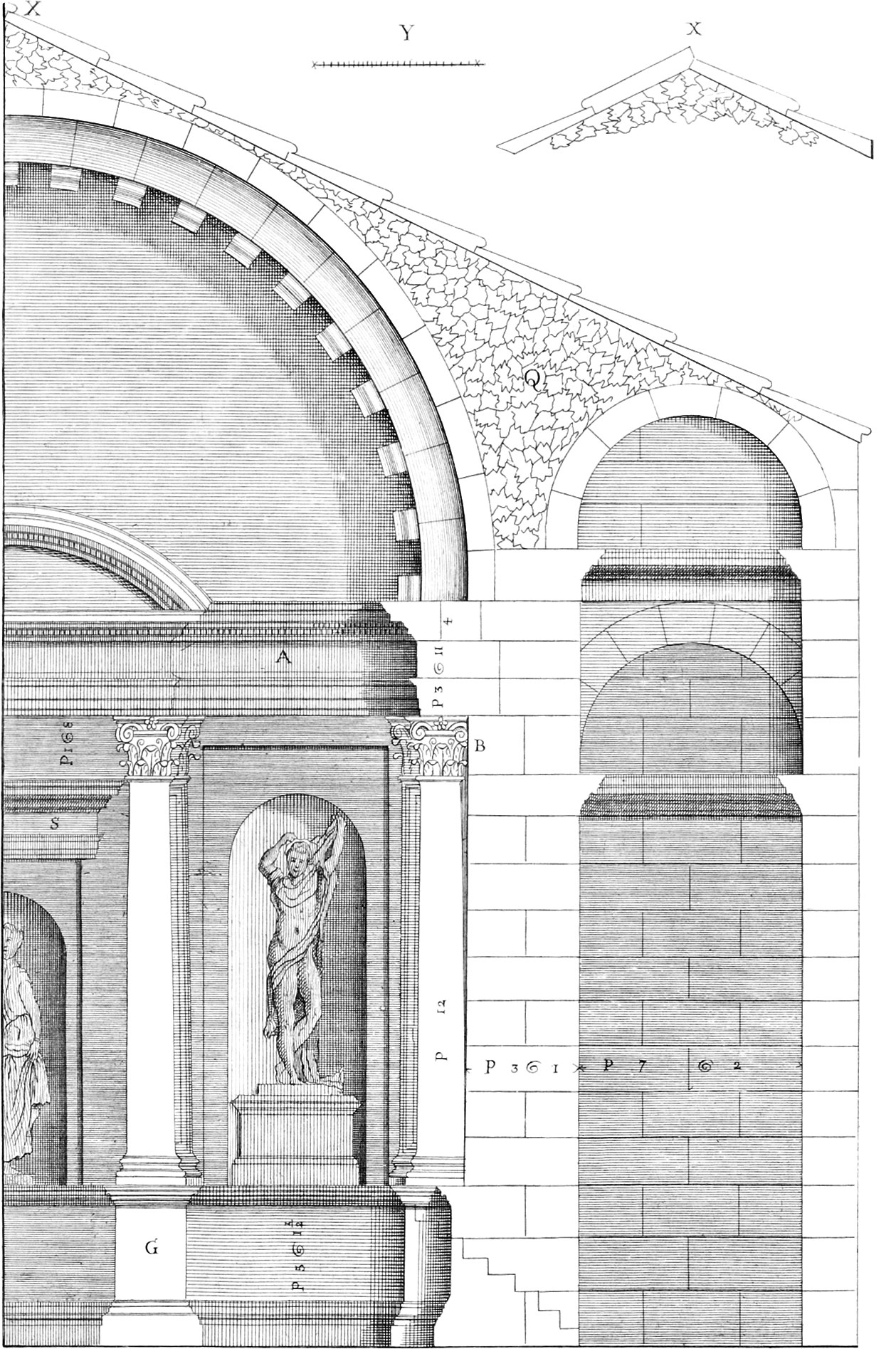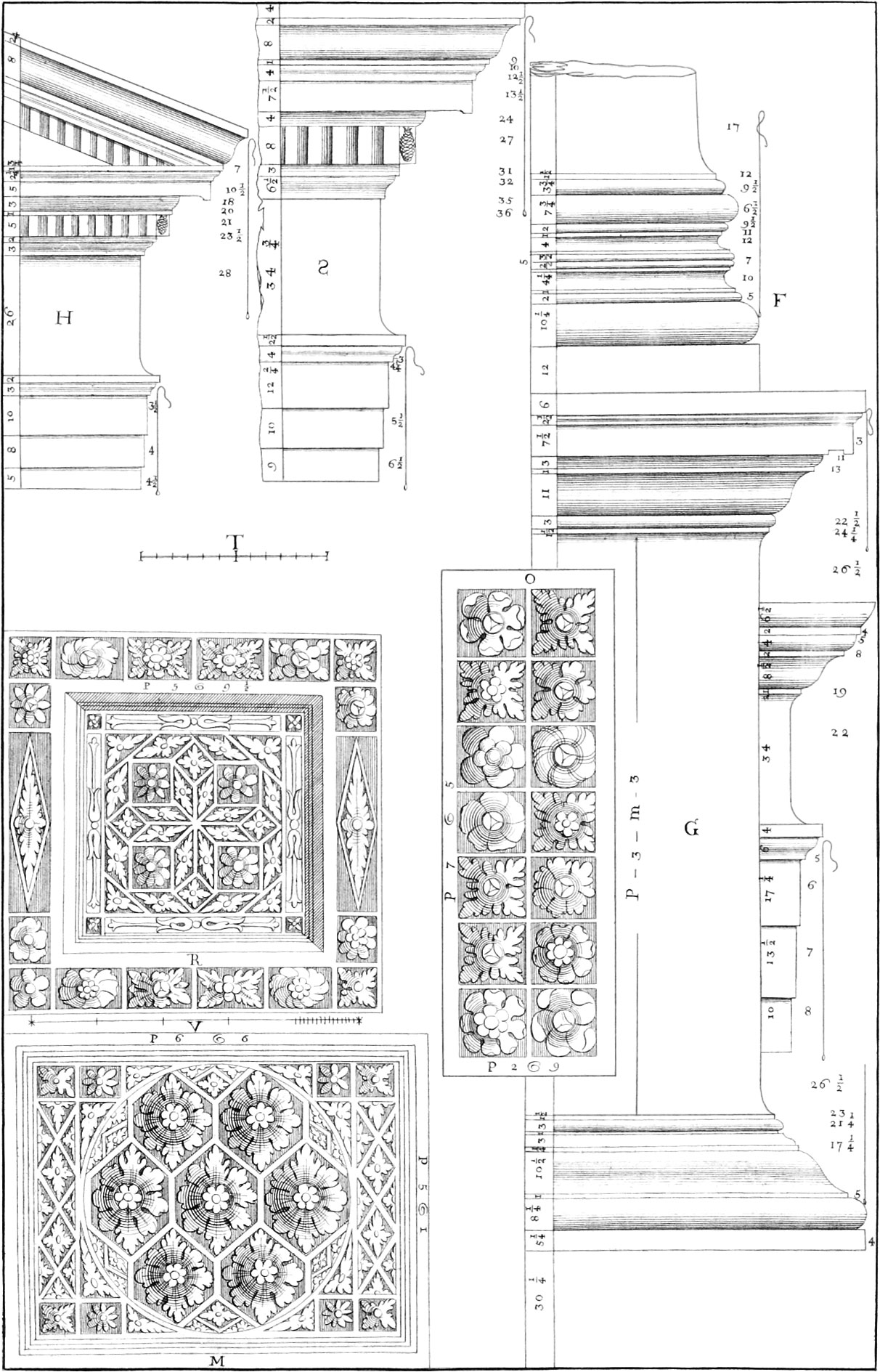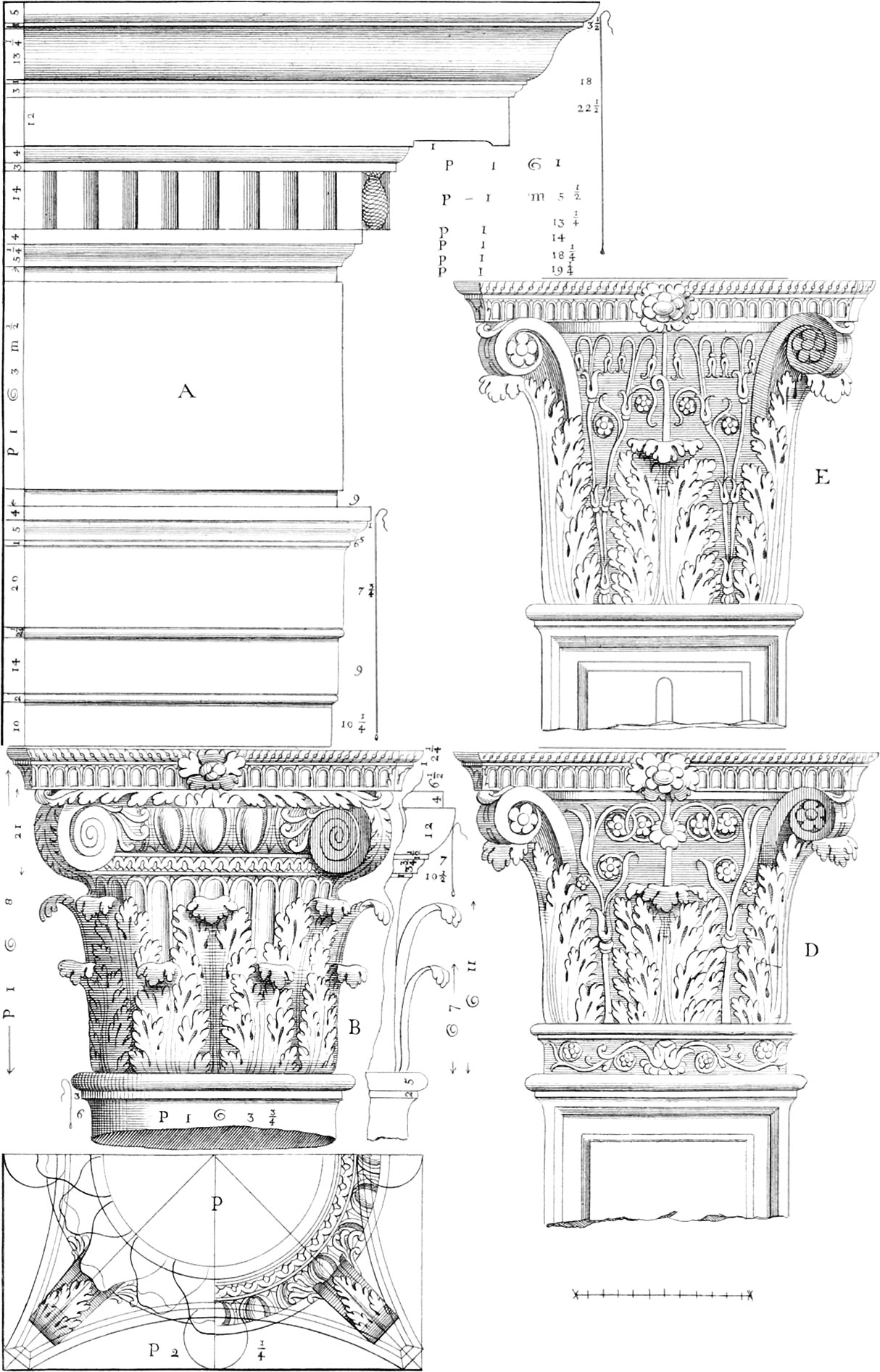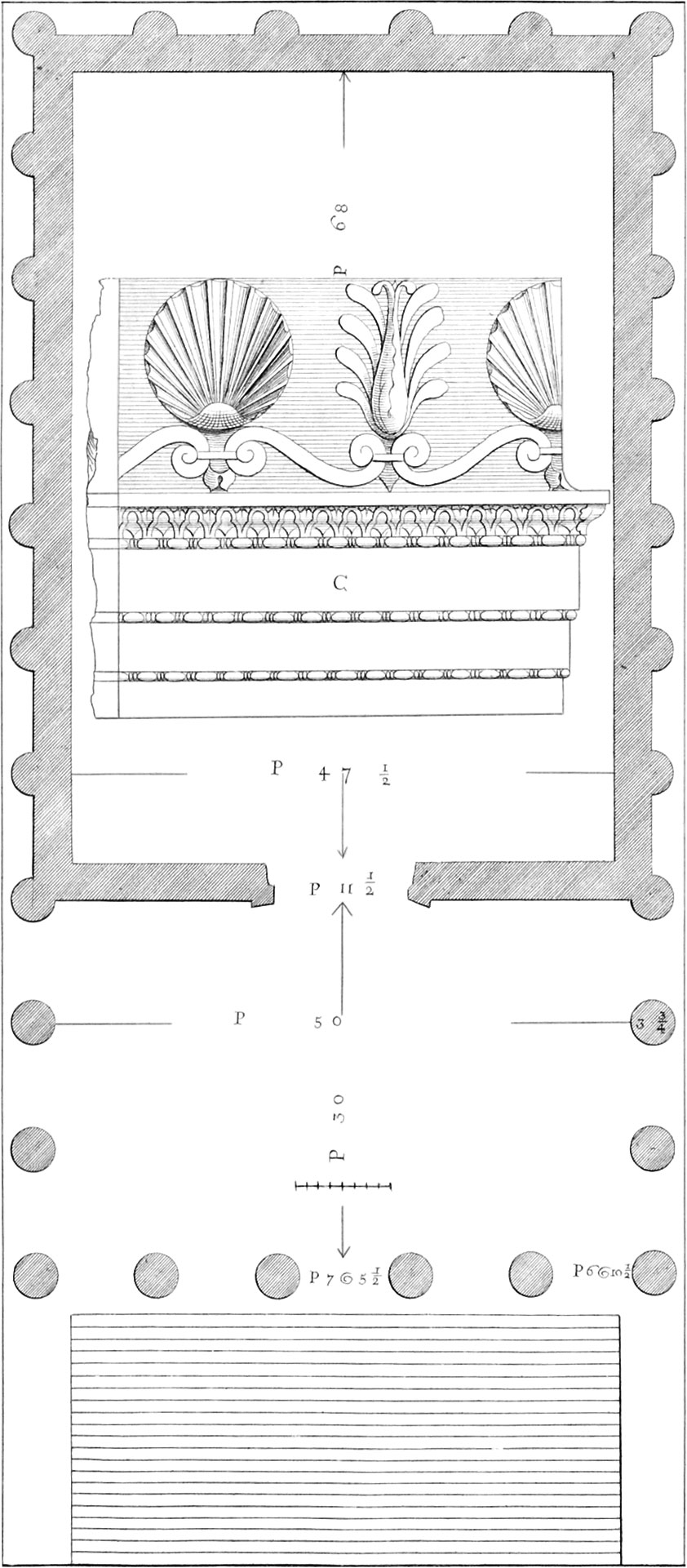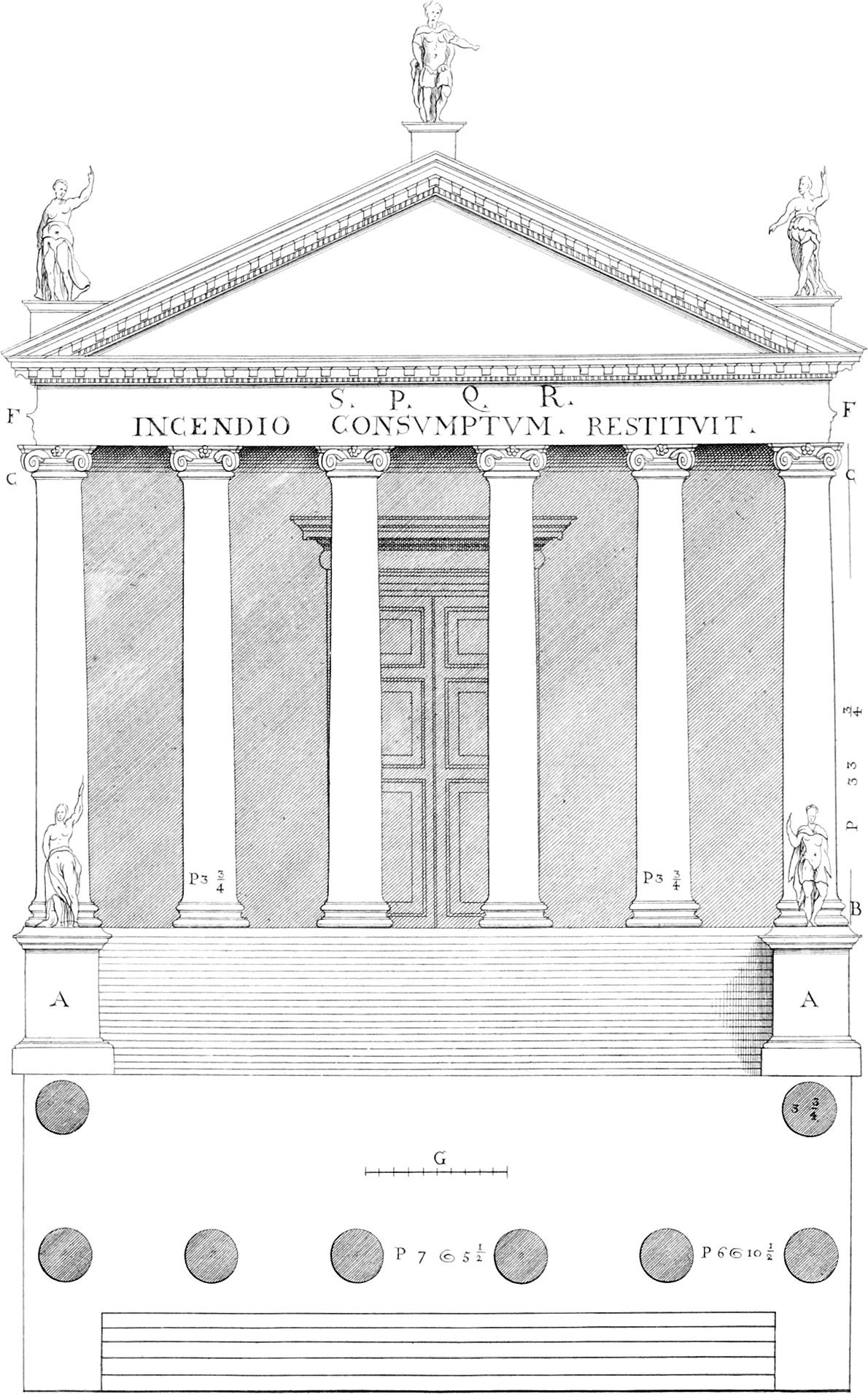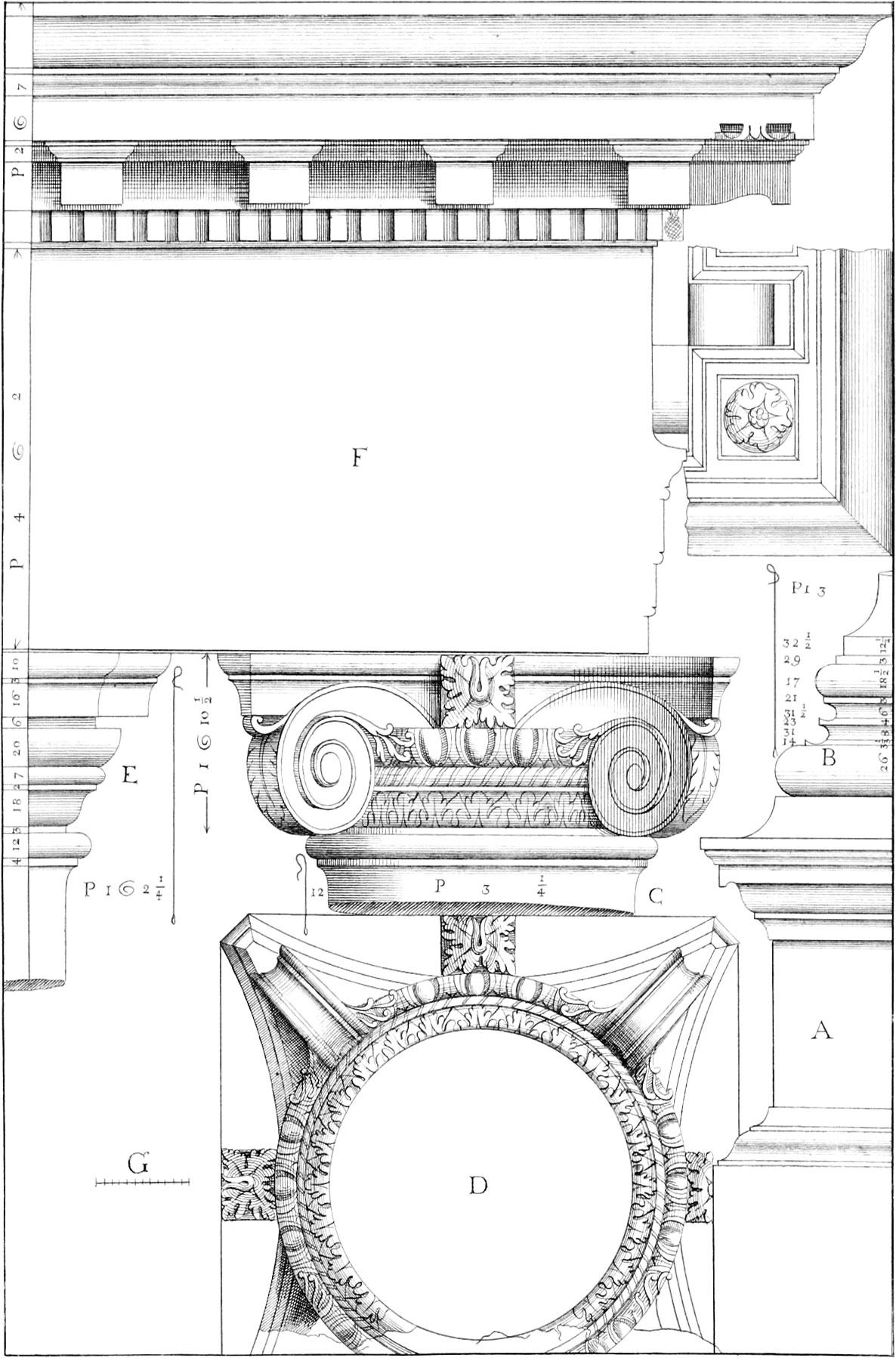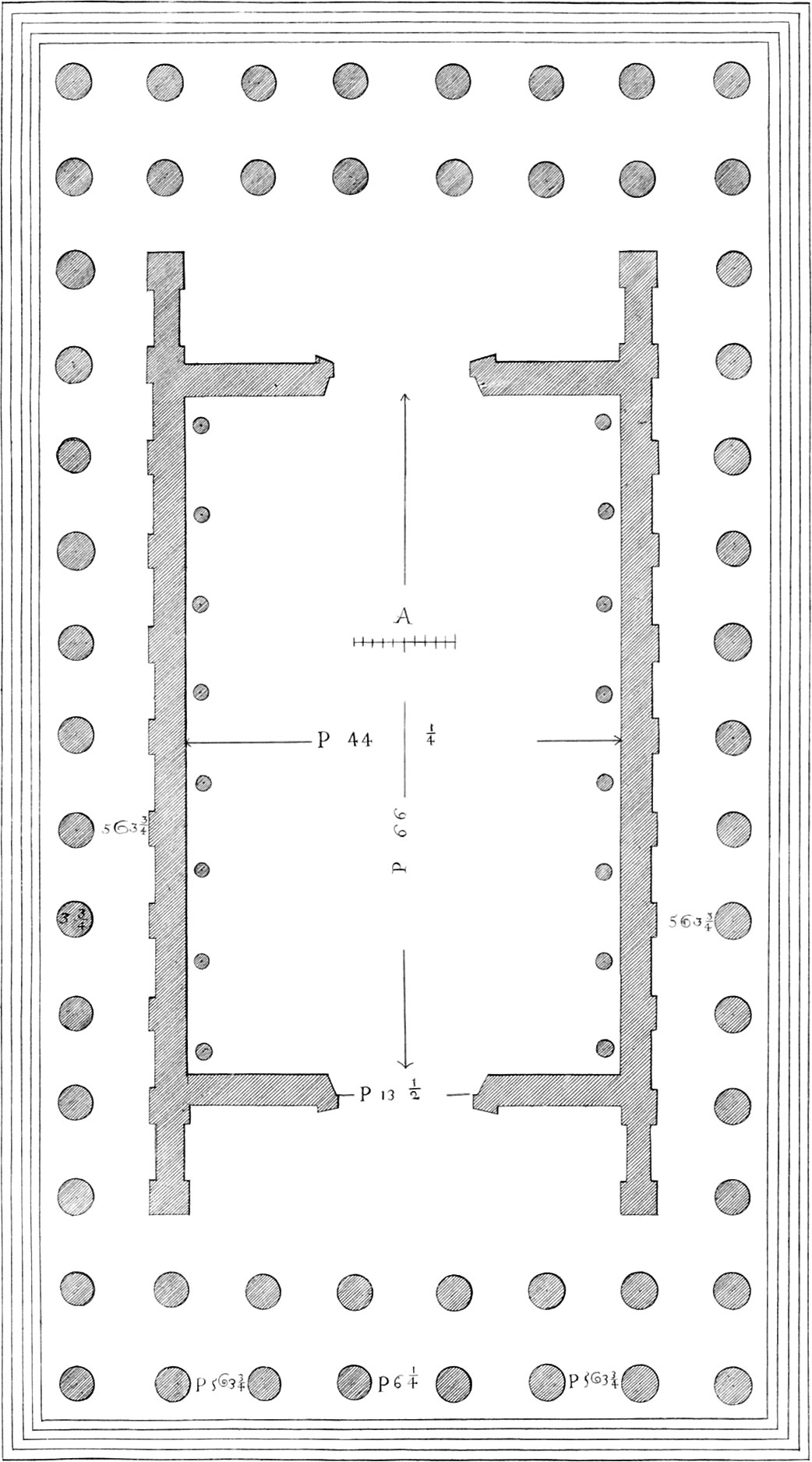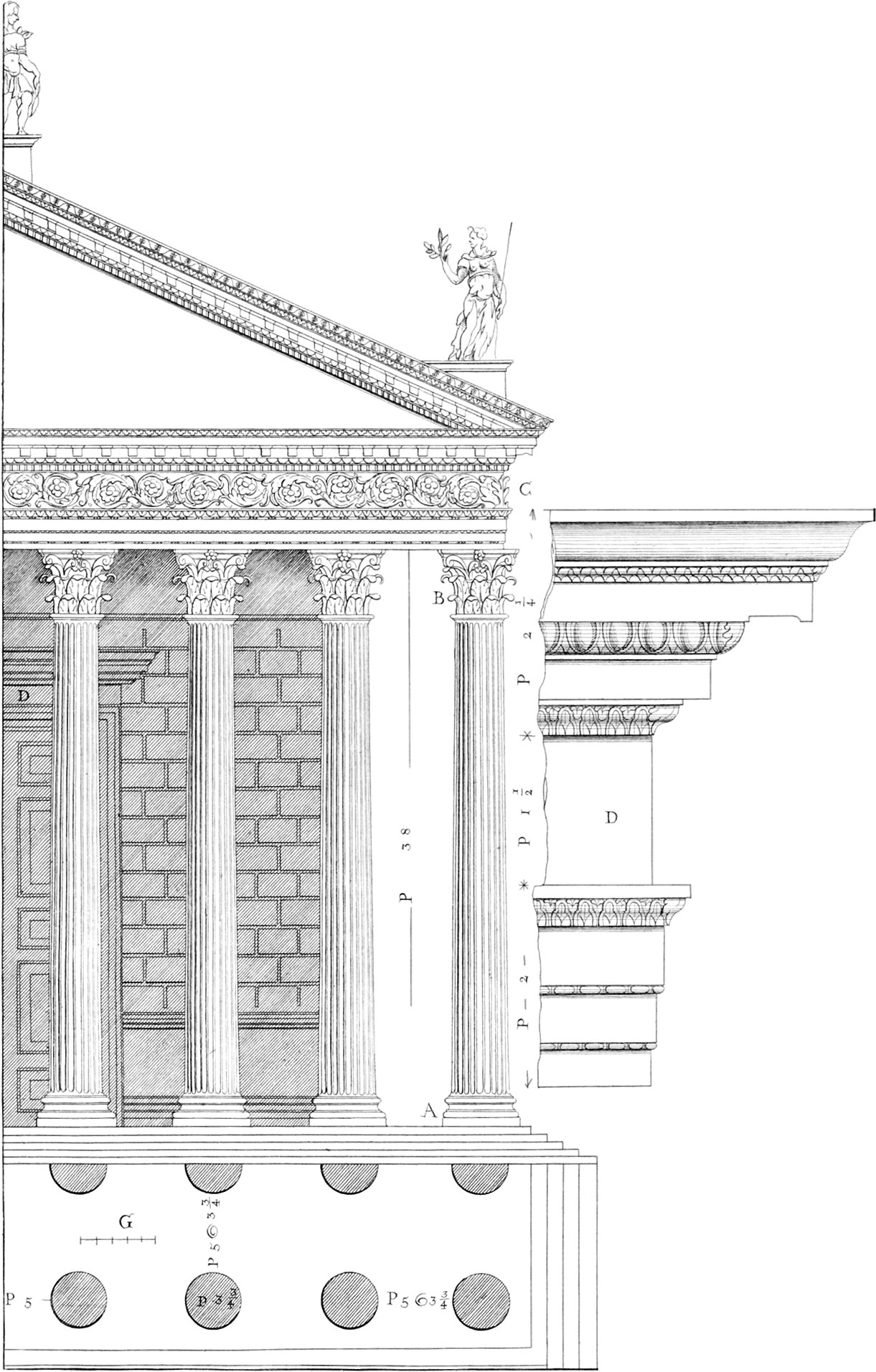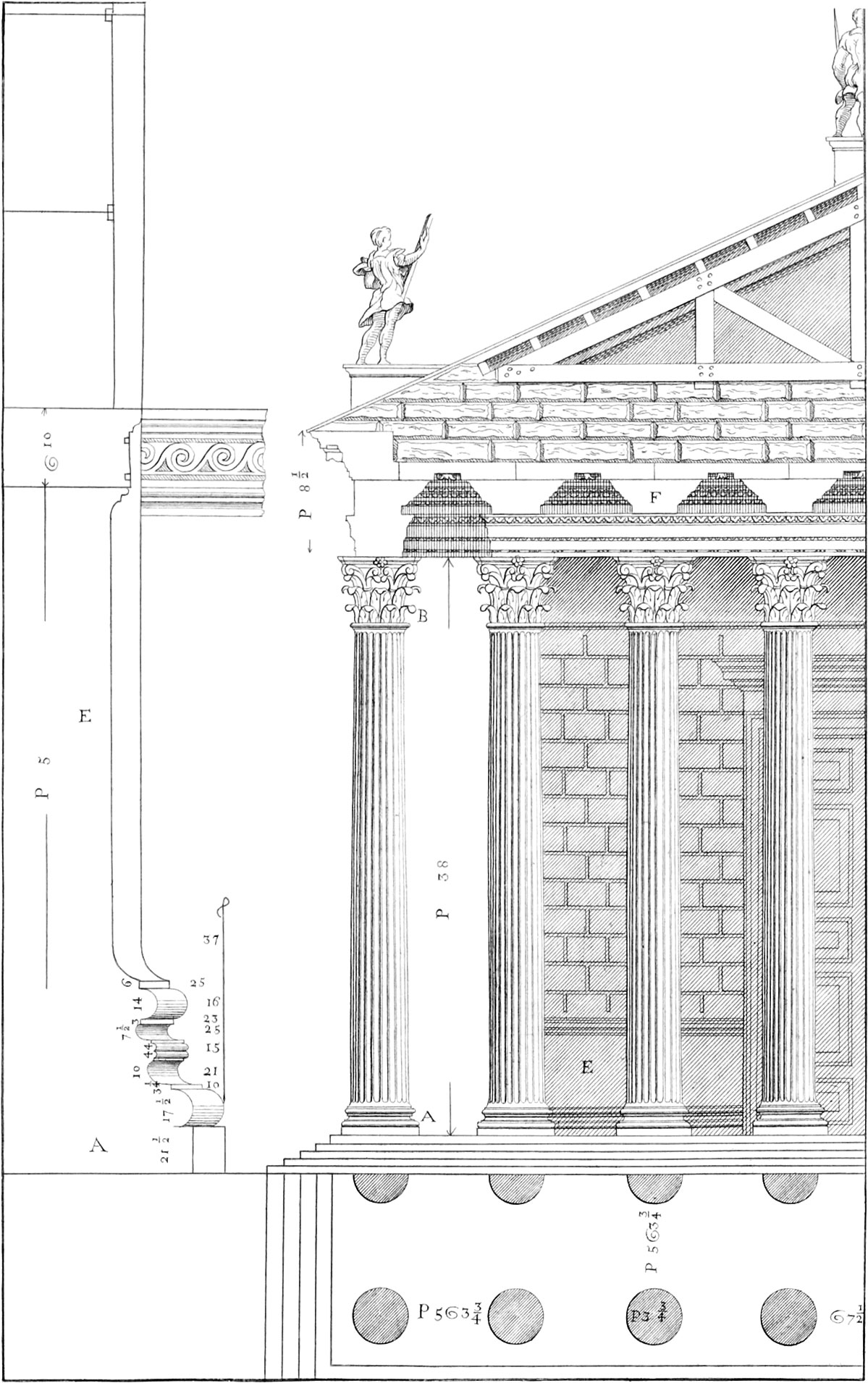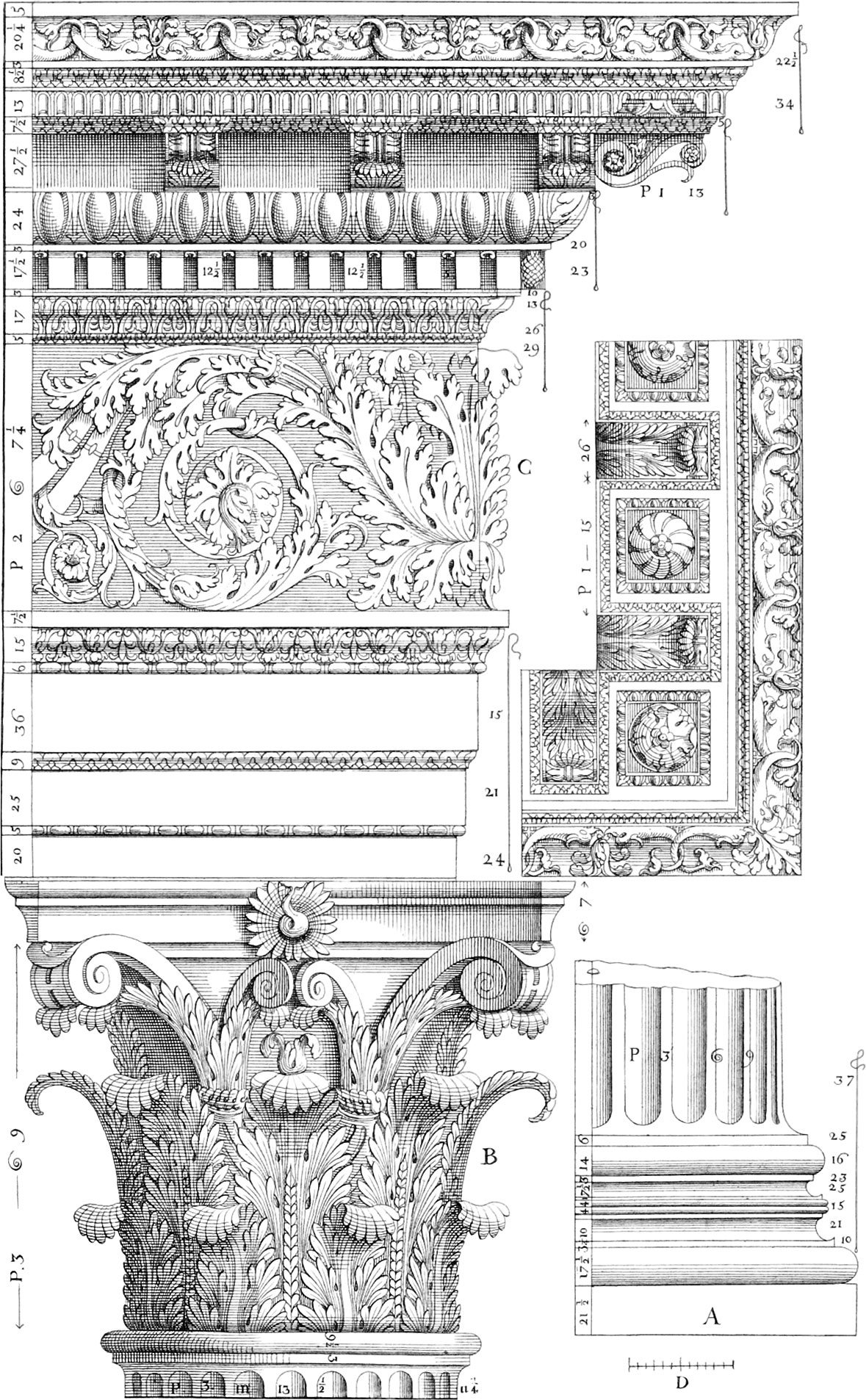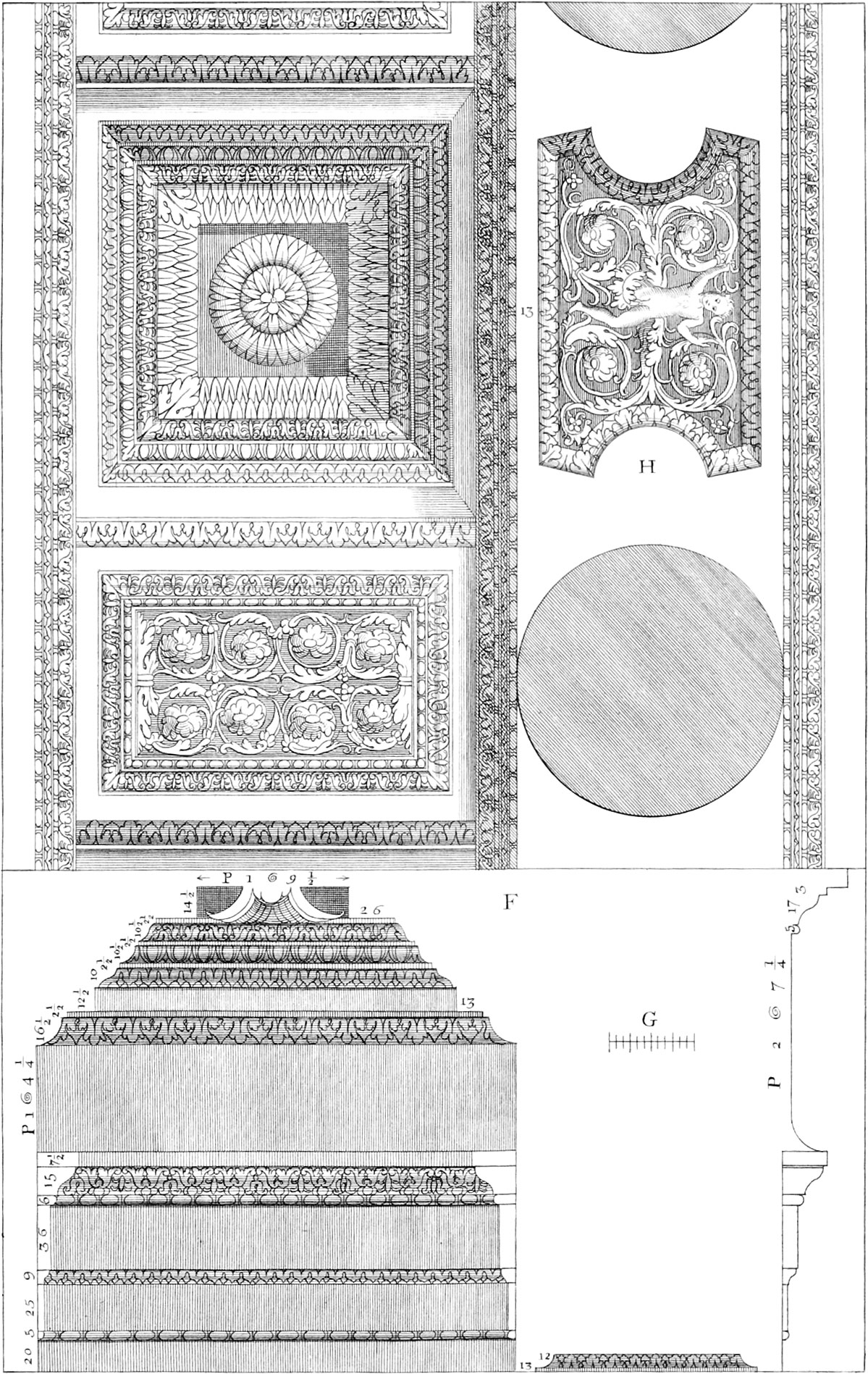Book IV Ancient Temples
The Preface to the Reader
If upon any fabric labour and industry may be bestowed, that it may be comparted with beautiful measure and proportion; this, without any doubt, ought to be done in temples; in which the maker and giver of all things, the almighty and supreme God, ought to be adored by us, and be praised, and thanked for his continual benefactions to us, in the best manner that our strength will permit. If, therefore, men in building their own habitations, take very great care to find out excellent and expert architects, and able artificers, they are certainly obliged to make use of still much greater care in the building of churches. And if in those they attend chiefly to conveniency, in these they ought to have a regard to the dignity and grandeur of the Being there to be invoked and adored; who being the supreme good, and highest perfection, it is very proper, that all things consecrated to him, should be brought to the greatest perfection we are capable of. And indeed, if we consider this beautiful machine of the world, with how many wonderful ornaments it is filled, and how the heavens, by there continual revolutions, change the seasons according as nature requires, and their motion preserves itself by the sweetest harmony of temperature; we cannot doubt, that the little temples we make, ought to resemble this very great one, which, by his immense goodness, was perfectly completed with one word of his; or imagine that we are not obliged to make in them all the ornaments we possibly can, and build them in such a manner, and with such proportions, that all the parts together may convey a sweet harmony to the eyes of the beholders, and that each of them separately may serve agreeably to the use for which it shall be appointed. For which reason, although they are worthy to be much commended, who being guided by an exceeding good spirit, have already built temples to the supreme God, and still build them; it does not seem, nevertheless, that they ought to remain without some little reprehension, if they have not also endeavoured to make them in the best and most noble form our condition will permit.
Hence, because the ancient Greeks and Romans employed the utmost care in building the temples to their Gods, and composed them of the most beautiful architecture, that they might be made with so much greater ornaments, and in greater proportion, as that they might be suitable for the God to whom they were consecrated; I shall show in this books the form and the ornaments of many ancient temples, of which the ruins are still to be seen, and by me have been reduced into designs, that everyone may know in what form, and with what ornaments churches ought to be built. And although there is but a small part of some of them to be seen standing above-ground, I nevertheless for that small part, (the foundations that could be seen being also considered) have endeavoured, by conjecture, to show what they must have been when they were entire. And in this Vitruvius has been a very great help to me; because, I saw, agreeing with what he teacheth us, it was not difficult for me to come at the knowledge of their aspect, and of their form.
But to the ornaments, that is, the bases, columns, capitals, cornices, and such like things, I have added nothing of my own; but they have been measured by me with the utmost attention, from different fragments, found in the places where these temples stood. And I make no doubt, but that they, who shall read this book, and shall consider the designs in it carefully, may be able to understand many places, which in Vitruvius are reputed very difficult, and to direct their mind to the knowledge of the beautiful and proportionable forms of temples, and to draw from them various very noble inventions; making use of which in a proper time and place, they may show, in their works, how one may, and ought to vary, without departing from the precepts of the art, and how laudable and agreeable such variations are.
But before we come to the designs, I shall, as I usually do, briefly mention those advertences, that in building of temples ought to be observed; having also taken them from Vitruvius, and from other very excellent men, who have written of so noble an art.
Chapter I Of the Site that ought to be chosen for the building of temples
Tuscany was not only the first to receive architecture into Italy, as a stranger, from whence the order called Tuscan had its measures; but also the things belonging to the Gods, which the greatest part of the world, led into blind error, adored. She was mistress of the neighbouring people, and showed what sort of temples, and in what place, and with what ornaments, respecting the quality of the Gods, they ought to be built; which observations, although in many temples one may see, they have not been considered, I shall briefly relate nevertheless, how they have been left us by writers; that such as delight in antiquity, may remain in this part satisfied, and that the mind of everyone may be roused and inflamed to employ all suitable care in the building of churches; because it would be a very unseemly, and a blameable thing, that we, who have the true worship, should be out-done in this point, by those who had not light of truth.
And, because the places, in which sacred temples are to be built, are the first things that ought to be considered, I shall make mention of them in this chapter.
I Say therefore, that the ancient Tuscans directed that the temples dedicated to Venus, to Mars, and to Vulcan, should be made without the city, as to those who incited men’s minds to lasciviousness, to wars, and to broils; and within the city to those that presided over chastity, over peace, and good arts; and that so such Gods, into whose care particularly the city might be put; and those to Jupiter, Juno, and to Minerva, whom they also esteemed to be protectors of the city.
Temples should be built upon very high places, in the middle of the country, and on a rock. And to Pallas, to Mercury, and to Isis, because they presided over artificers and merchants, they usually built temples near the piazzas, and sometimes over the very piazza; to Apollo, and to Bacchus near the theatre; to Hercules near the circus, and the amphitheatre.
Those to Æsculapius, to Health, and to those Gods by whose medicines they thought men recovered their health, they built in places extremely healthy, and near wholesome waters; that by coming from a bad and pestilential air, to a good wholesome one, and by drinking those waters, the inform might the sooner, and with less difficulty, be cured, whereby a zeal for religion might be increased.
And, to the rest of the other Gods, they likewise thought it necessary to find places to build their temples, persuant to the properties they attributed to them, and to the manner of their sacrifices. But we, who are by the special grace of God freed from that darkness, having departed from their vain, and false superstition, shall choose those sites for temples, that shall be in the most noble, and most celebrated part of the city, far from dishonoured places, and on beautiful and ornamented piazzas, in which many streets finish, whereby every part of the temple may be seen with its dignity, and afford devotion and admiration to whomever sees and beholds it. And if they city there be hills, the highest part of them is to be chosen; but in case there be no elevated places, the floor of the temple is to be raised, as much as is convenient, above the rest of the city. One is besides to ascend to the temple by steps; since the ascent alone to a temple is what affords greater devotion and majesty.
The fronts of temples must be made to face the greatest part of the city, that religion may seem to be placed as the safeguard and protetrix of citizens.
But if temples are built without the city, then their fronts must be made to face the public streets, or the rivers, if they are built near them; that passengers may see them, and make their salutations and reverences before the front of the temple.
Chapter II Of the forms of Temples, and of the decorum to be observed in them
Temples are made round, quadrangular, of six, eight, and more sides; all which terminate in the capacity of a circle, in the form of a cross, and of many other forms and figures, according to the various inventions of men, which, when they are done with beautiful and suitable proportions, and distinguished by elegant and ornamented architecture, they deserve to be praised. But the most beautiful, and most regular forms, and from which the others receive their measures, are the round, the quadrangular; and therefore Vitruvius only mentions these two, and shows us how they are to be comparted, as shall be inserted when the compartment of temples comes to be treated of. In temples that are not round, one ought carefully to observe, that all the angles be equal, let the temple be of four, of six, or of sides and angles.
The ancients had a regard to what was suitable to every one of their gods; not only in the choice of the places in which they were to build temples, as has been said before; but also in the choice of the form. Hence to the fun, and moon, because they continually revolve round the world, and by their revolution produce effects manifest to everybody, they made temples of a round form, or at least such as came near to roundness; and thus also to Vesta, which they said was goddess of the earth, which we know is a round body.
To Jupiter, as patron of the air, and of the heavens, they made temples uncovered in the middle, with porticos round them, as I shall hereafter observe. In the ornaments also, they had very great consideration to what God they built: therefore to Minerva, to Mars, and to Hercules, they made of the temples of Doric work; because to the Gods of the soldiery, of which they were made presidents, hey said fabrics without delicacy and neatness were most suitable.
To Venus, to Flora, to the Muses, to the Nymphs, and to the more delicate goddesses, they said temples ought to be made that were suitable to the blooming and tender virgin age: hence they gave the Corinthian work to them; it appearing to them, that delicate and blooming works, ornamented with leaves, and with volutas, were more suitable to that age.
But to Juno, to Diana, to Bacchus, and to other gods, whom neither the gravity of the first, nor the delicacy of the second, seemed to suit, they assigned Ionic works, which between the Doric and Corinthian hold the middle place.
Thus we read, that the ancients in building their temples endeavoured to observe the decorum, in which consists the most beautiful part of architecture. And therefore we also, that have no false gods, in order to observe the decorum concerning the form of temples, must choose the most perfect, and most excellent. And since the round is such, because it is the only one amongst all the figures that is simple, uniform, equal, strong, and capacious, let us make our temples round. For which purposes this figure is particularly fit, because it being enclosed by one termination only, in which is to be found neither beginning nor end, nor are they to be distinguished one from the other; but having its parts similar one to another, and all participating of the figure of the whole; in a word the extreme being found in all its parts, equally distant from the middle, it is exceeding proper to demonstrate the infinite essence, the uniformity, and the justice of God.
Besides which, it cannot be denied, but that strength and perpetuity, is more sought after in churches, than in all other fabrics; since they are dedicated to the omnipotent and supreme God and that in them are preserved the most celebrated and most memorable things of the city. Hence, and for this reason also, it ought to be said, that the round figure, in which there is never an angle, is particularly suited to temples.
Temples ought also to be very capacious, that many people may there be able to assist at divine service. And amount all the figures that are terminated by an equal circumference, none is more capacious than the round. Those churches also are very laudable, that are made in the form of a cross, which have their entrance in the part that representing the foot of the cross, and opposite to which should be the principal altar, and the choir; and in the two branches, that are extended from either side like arms, two other entrances, or two other altars; because that being fashioned in the form of the cross, they represent to the eyes of the beholders that wood from which depended our salvation. And of this form, I have made the church of San. Giorgio Maggiore at Venice.
Temples ought to have ample porticos, and with larger columns than other fabrics require; and it is proper that they should be great and magnificent (but yet not greater than the bigness of the city requires) and built with large and beautiful proportions. Whereas for divine worship, in which all magnificence and grandeur is required, they ought to be made with the most beautiful orders of columns, and to each other ought to be given its proper and suitable ornaments. They must be made of the most excellent, and of the most precious matter; and the divinity may be honoured as much as possible, both as well with the form, as matter: and if it were possible, they ought to be so made, that they might have so much beauty, that nothing more beautiful could be imagined; and so disposed in each of their parts, that those who enter there, may be astonished, and remain in a kind of ecstasy in admiring their grace and beauty.
Of all the colours, none is more proper for churches than white; since the purity of colour, as of the life, is particularly grateful to God. But if they are painted, those pictures will not be proper, which by their signification alienate the mind from the contemplation of divine things, because we ought not in temples to depart from gravity, or those things, that being looked on render our minds more inflamed for divine service, and for god works.
Chapter III Of the aspects of Temples
By aspect is understood the first view which a temple exhibits to such as approach it. The most regular and the best understood aspects of temples are seven, concerning which is seemed to me necessary to insert here, what Vitruvius says, in the first chapter of the first book, that this part, which, by reason of the little attention paid to antiquity, has been by many reputed difficult, and by few hitherto well understood, may be made easy and clear by what I shall mention of it, and by the designs that are to follow, which may serve as an example of what he teaches us. And I thought it proper to make use also of the names which he does, that they who shall apply themselves to the reading of Vitruvius, to which I exhort every one, may therein observe the same names, to the end that they may not seem to read of different things.
To come therefore to our purpose, temples are either made with porticos or without: those that are made without porticos may have three aspects; the one is named Antis, that is, fronted with pilasters, because of the pilasters are called Ante, which are made in the angles or corners of the fabrics. Of the other two, the one is called Prostilos, that is, fronted with columns; and the other Amphiprostilos. That which is called in Antis, must have two pilasters in the corners, that turn also on the sides of the temples, and in the middle of the front, between the said pilasters, two columns, must project forward, and support the frontispiece that shall be over the entrance. The other, which is called Prostilos, must have more than the first, also columns in the corners opposite to the pilasters, and on the right and left in turning the corner, two other columns, that is, one on a side. But if in the part backwards the same disposition of columns is observed, and the frontispiece, then the aspect must be called Amphiprostilos.
Of the two first aspects of temples there are not in our days any remains, and therefore there shall be no examples of them in this book; neither did it seem to me necessary to make designs of them, the aspects of each of these being delineated in the plan, and the upright in the Commentary upon Vitruvius by Monsignor Reverendissimo Barbaro.
But if porticos are made to temples, they are either to be made round the temple, or in the front only. Those that have porticos in the forefront only, it may be said also that they have the aspect called Prostilos. Those that are made with porticos round them, may be made with four aspects; because they either may be made with six columns in the front and in that backwards, and with eleven columns on each side, computing those in the angles; and this aspect is called Peripteros, that is, winged round, and the porticos round the cell come to be as broad as an intercolumniation.
Ancient temples are to be seen, that have six columns in the front, and have no porticos round them notwithstanding; but in the walls of the cell, in the part without, there are half columns, which accompany those of the portico, and have the same ornaments; as Nismes in Provence. Of this sort also it may be said, that the temple of the Ionic order in Rome is, now the church of Santa Maria Egittiaca. These architects made to make the cell larger, and two avoid expense; the same aspect of the alato round it remaining nevertheless so those who saw the temple in flank. Or if the temples eight columns be put in the front, and fifteen on the sides, with the angular ones; these come to have double porticos round them, and therefore their aspect is called Dipteros, that is, double winged.
Temples may also be made, which have like the abovesaid, eight columns in front, and fifteen on the sides; but the porticos round them are not made double, because one order of columns is taken away. Hence these porticos come to be as broad as two intercolumniations, and the thickness of a column, and their aspect is called Pseudodipteros, that is, false winged round. This aspect was the invention of Hermogenese, a very ancient architect, who in this manner made the porticos round the temples broad and convenient, to take off the expense and labour, without taking anything from the aspect. Or, finally, they are so made, that in each front there be ten columns, and the porticos round them double, and in those that have the aspect Dipteros.
These temples had in the part within, other porticos with two others of columns, one above the other, and these columns were less than those without. The roof came from the columns without to those within, and the whole space encompassed by the columns within was uncovered. Hence the aspects of these temples was called Hipethros, that is, uncovered.
These temples were dedicated to Jupiter, as patron of heaven, and of the air. And in the middle of the court the altar was placed. Of this sort I believe the temple was, of which some small vestigia are of to be seen upon Monte Cavallo at Rome; and that it was dedicated to Jupiter Quirinalis, and built by the emperors: because in Vitruvius’s time (as he says) there was none.
Chapter IV Of the five kinds of Temples
The ancients used (as has been before said) to make porticos to their temples, for the conveniency of the people, that they might have where to entertain one another, and to walk in without the cell, in which the sacrifices were offered, and to give greater majesty and grandeur to those fabrics. Hence, because the intervals that are between one column and the other, may be made of five sizes, according to these five kinds of anners of temples, that Vitruvius distinguishes: the name of which are Picnostilos, that is, thick with columns; Sistilos, wider; Diastilos, still wider; Areostilos, wider than is convenient; and Eustilos, which has reasonable and convenient intervals: of all which intercolumniations, they be, and what proportions they ought to have, with the length of the columns, has been mentioned before in the first boo, and the designs of them inserted.
It is not necessary therefore to said here anything more, than the four first manners are defective. The two first, because the intercolumniations being but of one diameter and an half, or of two diameters of a column, are very little and narrow, (hence two persons a breast cannot enter into the porticos, but are obliged to go one behind the other,) and because the doors and their ornaments cannot be seen at a distance: and, finally, because that by the straightness of the spaces, walking round the temple is hindered. These two manners are nevertheless tolerable when the columns are made large, as my be seen in almost all the ancient temples.
The third, as three diameters of a column can be put between the columns, the intercolumniations come to be very wide: hence the architraves split, by reason of the greatness of the spaces. But one may provide against this defect, by making over the architrave, in the height of the frieze, arches, or remenati, that support the weight, and leave the architrave free.
The fourth manner, although not subject to the defect of the abovementioned, because architraves of stone, or of marble, are not made use of, but that over the columns beams of timber are put; one may nevertheless say that it is also defective, because it is low, and wide, and mean, and is properly of the Tuscan order; so that the most beautiful and the most elegant manner of temples is that which is called Eustilos, which is when the intercolumniations are of two diameters and a quarter of a column; because it serves exceedingly well for use, beauty and strength.
I have called the manners of temples by the same names that Vitruvius makes use of, as I have also the aspects, not only for the abovementioned reason, but also because hose names have already been received in our language, and that they are understood by everybody, I shall therefore make use of them in the designs of temples that shall follow.
Chapter V Of the Compartments of Temples
Although in all fabrics it is requisite, that their parts should correspond together, and have such proportions, that there may be none whereby the whole cannot be measured, and likewise all the other parts; this however ought to be observed in temples with the utmost care, because they are consecrated to divinity, for the honour and reverence whereof one ought to work as beautifully and exquisitely as is possible. As therefore the round and quadrangular are the most regular forms for temples, I shall mention how each of these ought to be comparted; and shall also insert some things belonging to temples that we Christians make use of.
Round temples were anciently made, sometimes open, that is, without a cell, with columns that supported the cupola, like those that were dedicated to Juno Lacinia; in the middle of which the altar was placed, and upon which the fire was never extinguished. There are comparted in this manner: the diameter of the whole space is so divided, that the temple is to take up three equal parts; one is given to the steps, that is, to the ascent to the floor of the temple, and two remain to the temple and the columns, which are placed upon pedestals, and are high with base and capital, as the diameter of the lesser course of steps, and the tenth part of their height in thickness.
The architrave, the frieze, and the other ornaments, are to be made as well in this, as in all the other temples, according to what was said in the first book. But those that are made close; that is, with a cell, are either made with wings round them, or with one portico only in the front. Of those that have wings round them, the rules are these; in the first place, two steps are to be made round them, and upon them the pedestals are to be placed, on which the columns stand; the wings are as broad as the fifth part of the diameter of the temple, taking the diameter in the part within the pedestals. The columns are as long as the cell is broad, and are the tenth part of their length in thickness.
The tribuna, or cupola, must be raised above the architrave, frieze, and cornice of the wings, one half the whole work. Thus Vitruvius comparts the round temples.
In ancient temples however there are no pedestals to be seen, but the columns begin from the floor of the temple: which pleases me much better, not only because the pedestal obstructs the entrance very much; as also because the columns, which begin from the ground, add more grandeur and magnificence. But if in round temples the portico is to be placed in the front only, then it must be made as long as the breadth of the cell, or and eighth part less, and may also be made shorter; but yet it must not be shorter than three quarters of the breadth of the temple, nor must it be made wider than the third part of its length.
In quadrangular temples the porticos in the front must be made as long as the breadth of these temples. And if they are to be after the manner Eustilos, which is both beautiful and elegant, then they are to be thus cocmparted. If the aspect is to be made with four columns, all the front of the temple (excepting the projection of the bases of the columns, which are in the angles) must be divided into eleven parts and an half, and one of these parts shall be called a module, that is, a measure, with which all the other parts must be measured; because that making the columns a module in thickness, four must be given to them, three to the intercolumniations in the middle, and four and a half to the other two columniations, that is, two and a quarter inch. If the front is to be of six columns, then it must be divided into eighteen parts; if of eight, into twenty four and an half; and if of ten, into thirty one: always giving these parts to the thickness of the columns, three to the void in the middle, and two and a quarter to each of the other voids. The heart of the columns must be according to what they shall be, whether Ionic or Corinthian.
How the aspects of the other manners of temples ought to be regulated, that is, of Picnostilos, Sistilos, Diastilos, and Aereostilos, has been fully set down in the first book, when we treated of intercolumniations.
Beyond the portico one finds the anti-temple, and then the cell. The breadth is divided into four parts; eight of which are given to the length of the temple, and five of these eight are given to the length of the cell, including the walls, in which are the doors; and the other three remaining are for the anti-temple, which has on the sides two wings of wall, continued to the walls of the cell, in the ends of which are made two anti, that is, two pilasters as thick as the columns of the portico. And because it may happen that between these wings there may be, either little or much space, if the breadth be greater than twenty foot, between the said pilasters two columns may be put, and more also according as necessity shall require, directly opposite to the columns may be put, and more also according as necessity shall require, directly opposite to the columns of the portico; and those three or more voids, which shall be between the pilasters, must be closed up with wood, or with marble parapets, leaving however the openings through which one may enter into the anti-temple. If the breadth be more than forty foot, other columns must be put in the part within, opposite to them, that shall have been put between the pilasters, and must be made of the same height of those without, but somewhat smaller, because the open air will lessen the thickness of those without, and the enclosed will not permit the smallness to be discerned of those within, and so they will appear equal.
And although the said compartment answers exactly in temples of four columns, the same proportion and manner nevertheless do not suit the other aspects; because it is necessary that the walls of the cell should meet with the columns without, and be in a line. Hence the cells of these temples will be somewhat larger than what has been mentioned.
Thus the ancients comparted their temples, as Vitruvius teacheth us, and were willing that a portico should be made, under which in bad weather men might avoid the sun, the rain, the hail, and the snow; and on solemn days be amused until the hour of sacrifice came on: but we, by omitting the porticos round the temples, build them very like basilicas, in which, as it has been said, porticos were made in the part within, as we now do in temples. Which happened, because the first who, enlightened by truth, gave themselves up to our religion, were accustomed, for fear of the Gentiles, to assemble in basilicas of private men: whence seeing that this form succeeded very well, because the altar was placed, with great dignity, in the place of the tribunal, and the choir stood very conveniently round the altar, and the remaining part was free for the people, it has not been altered since. And therefore in the compartment of the wings that we make in temples, what has been said, when we treated of basilicas, must be observed.
To our churches is joined a place separate from the remainder of the temple, which we call the sacrisity; where are kept in sacerdotal vestments, the vessels, the sacred books, and the other things necessary for divine service, and here the priests dress themselves. Near to it are towers built, in which bells are hung to call the people to the divine offices, which are not made use of by any but christians. Near the temple the habitations for the priests are made; which ought to be commodious, with spacious cloisters, and find gardens; and particularly the places for the sacred virgins ought to be secure, high, remote from noise, and from the sight of the people.
It is sufficient to have said thus much concerning the decorum, the aspects, the manners, and the compartments of temples, I shall insert now the designs of many ancient temples, in which I shall observe this order. First, I shall put the designs of the temples that are at Rome; afterwards those that are out of Rome, in other parts of Italy; lastly, those that are out of Italy. And for the sake of being better understood, and to avoid being tedious, and fatiguing to the readers, as I minutely to mention the measures of every part, I have marked them with figures in the designs.
The Vicentine foot, with which all the following temples have been measured, is in the second book, Page 39.
The whole foot is divided into twelve inches, and each inch into four minutes.
Chapter VI Of the designs of some ancient Temples that are at Rome; and, first, of that of Peace
We shall, for the sake of good omen, begin with the designs of the temple formerly dedicated to Peace, of which the vestigia are to be seen near the church of Santa Maria Nuova, in the Via Sacra: and writers say, that it is in the same place where the Curia of Romulus, and Hostilia was first; then the house of Menius, the Basilica Portia, and the house of Cæsar, and the portico that Augustus (after pulling down the said house of Cæsar, which he thought too large and suptuous an edifice) built, calling it after the name of Livia Drusilla his wife.
This temple was begun by the emperor Claudius, and finished by Vespasian after he returned victorious from Judea, in which he preserved all the vessels, and ornaments (which he carried in his triumph) of the temple of Jerusalem. One reads, that this temple was the greatest, the most magnificent, and the richest of the city; and certainly its vestigia, ruinous as they are, represent so much grandeur, that one may very well judge what it was when whole.
Before the entrance there was a loggia of three spaces, made of brick; and the remainder was a continued wall equal to the breadth of the front. In the pilasters of the arches of the loggia in the part without, there were columns placed for ornament, the order of which followed also in the wall continued. Over this first loggia there was another uncovered, with its poggio; and directly over each column there must have been a statue. In the part within the temple there were eight marble columns of the Corinthian order, five foot four inches thick, and fifty three foot long, with the base and capital. The architrave, the frieze, and the cornice were ten foot and an half, and supported the vault of the middle nave. The base of these columns was higher than half the diameter of the column, and had the orlo thicker than the third part of its height; which they perhaps thus made, supposing that it thus would support the weight that was put upon them the better. Its projection was the sixth part diameter of the column. The architrave, the frieze, and the cornice, were carved with very beautiful inventions. The cimacium of the architrave is worthy of attention, being different from the others, and very gracefully made. The cornice has mogdilions instead of a gocciolatio. The cases of the roses that are between the mogdilions are square; and they ought so to be made, as I have observed they are in all the ancient edifices.
Writers say that this temple was burnt in the time of the emperor Commodus; but I can’t see how that can be so, there not being the least in it wood. But it might easily happen that it has been ruined by earthquakes, or some other such accident, and afterwards restored at some other time, when what related to architecture was not so well understood as it was in the time of Vespasian. What makes me believe this, is because the sculptures are not so well made, or worked with that diligence that one observes in those which are in the arch of Titus, and of other edifices that were made in good times. The walls of this temple were adorned with statues, and with pictures, and all the vaults were made with a compartment of stucco, neither was there any part but what was highly adorned. Of this temple I have made three draughts.
In the first the plan is designed.
In the second the upright of the outward part, of the part within, of the front, and of the inward part of the flank.
In the third are the particular members.
- the base of the columns that support the middle nave
- the capital of the columns that support the middle nave
- architrave, frieze, and cornice of the columns that support the middle nave
- the compartment of stucco made in the vaults
Chapter VII Of the temple of Mars, the Avenger
Near the tower of the Contis the ruins are to be seen of the temple built formerly by Augustus to Mars the Avenger, to fulfill a vow he made, (when begin together with Mark Antony at Pharsalia, against Brutus and Cassius) to revenge the death of Cæsar, he engaged and overcame them.
By those parts that remain, one comprehends that this was a most adorned and marvellous edifice; and the forum that was before it must have made it much more admirable, into which, one reads, those that returned into the city, conquerors and triumphant, carried the ensigns of the triumph and victory; and that Augustus, in its most beautiful parts placed to pictures, in which were represented the manner of giving battle, and triumphing; and two other pictures done by the hand of Apelles, in one of which there were Castor and Pollux, the goddess of Victory, and Alexander the great; in the other representation of a battle, and an Alexander. There were two porticos, in which Augustus dedicated the statues of all those who returned triumphant to Rome.
Of this forum there are not any vestiges to be seen, unless those wings of wall, which are on the sides of the temple, should perhaps be part of it; which is very likely, from the many places for statues that are therein.
The aspect of the temple is alato a torno, which we before have called, from Vitruvius periptros. And because the breadth of the cell exceeds twenty foot, and there are columns placed between the two anti, or pilasters of the anti-temple opposite to those of the porico, as has been before said ought to be done in the like case, the portico is not continued round the temple: and also in the wings of the walls joined from one side to the other, the same order is not observed in the part without, although all the parts correspond within. Hence one comprehends, that behind, and on one side, there must have been the public street; and that Augustus was willing to accommodate himself to the site, not to incommode, nor take away the neighbouring houses from their owners.
The manner of this temple is the picnostilos. The porticos are as large as the intercolumniations. In the part within, that is, in the cell, there is not the least mark or vestigum to be seen, neither is there anything in the wall, whence it may positively be said that there were either ornaments or tabernacles; however, as it is very likely that some were, I have made them of my own invention. The columns of the porticos are of Corinthian work. The capitals are wrought in the manner of olive leaves. They have the abaco much larger than what is usually seen in others of the same order, regarding the bigness of the whole capital. The first leaves may be seen to swell a little in the place where they come forth, which gives them a good grace. These have very beautiful soffits, or what we call ceilings, therefore I have made their profile and their aspect in a plan. Round this temple there were very high walls of peperino, which in the part without were of Rustic work; and in that within, they had many tabernacles, and places to place statues in.
And that the whole might be perfectly seen, I have made seven plates of it.
In the first there is all in the plan in a small form; and all the elevation of as much as is to be seen if the edifice, as well in the part without, as in that within.
In the second there is the upright of the flank of the portico, and the cell.
In the third there is the upright of half the front, with part of the walls that are on the sides of the temple.
In the fourth there is the upright of the inward part of the portio, and of the cell, with the ornaments which I have added to it.
In the fifth there are the ornaments of the portico.
- the capital
- the architrave, frieze and cornice
- the ceilings of the portico, that is, the soffits
In the sixth, is designed the soffit of the portico, and how it turns in the anti, or pilasters of the anti-temple.
- the soffit of the architrave between the columns
In the seventh are the other members.
- the base of the columns of the portico, which also continues in the wall round the temple
- the cauriola, from which begin the divisions of the squares made for an ornament in the wall under the porticos
- the plan of the columns placed for the ornament of the tabernacles in the cell
- the base
- is the capital
Which ornaments in the inside have been added by me, taken from some ancient fragments found near this temple.
- is the cornice that is seen in the wings of the walls, that form a piazza on the sides of the temple
Chapter VIII Of the temple of Nerva Trajanus
Near the said temple built by Augustus, the vestigia are to be seen of the temple of Nerva Trajanus, the aspect of which is the prostilos; its manner is thick of columns. The portico, together with the cell, is in length somewhat less than two squares.
The floor of this temple is raised from the ground with a basement that goes round the whole fabric, and forms the sides of the stairs by which one ascends to the portico. In the extreme parts of those side there are two statues, that is, one on each head of the basement.
The base of the columns is Attic, different in this from what Vitruvius teaches, and from what I have said in the first book, that there are in it two tondinos more, the one under the cavetto, and the other under the cimbia.
The tongues of the capital are carved in the form of olive leaves, and those leaves are disposed by fives, as are the fingers in the hands of men. I have observed, that all the ancient capitals are made in this manner, and succeed better, and have more grace than those in which the said leaves are made by fours.
In the architrave are very beautiful carved works, intaglios, that divide one fascia from the other; and these intaglios, and these divisions are on the sides of the temple only, because the architrave in the front, and the frieze were made all even, that the inscription might conveniently be put there; of which these few letters still to be seen, although jagged and spoilt by time.
Impe ator nerva caesar avg. point. max.
Trib. pot. II. imperator II. procos.
The cornice is very well carved, and has very beautiful, and very convenient projections. The architrave, the frieze, and the cornice are, all together, the fourth part of the length of columns. The walls are made of peperino, and were coated with marble. In the cell along the wall I have put tabernacles with statues, as by the ruins it should seem there have been.
Before this temple there was a piazza, in the middle of which the statue of the said emperor was placed: And writers say, that so many and so wonderful were its ornaments, that they astonished those that beheld them, as not thinking them the work of men, but of giants.
Hence the emperor Constantius when he came first to Rome, was struck with the rare structure of this edifice; then turning to his architect, said, that he would in Constantinople make a horse that of Nerva, to his own memory. To whom Ormisida answered (so was that architect’s name) that it was first necessary to make him such another stable, showing him this piazza.
The columns that are round it have no pedestals, but rise from the ground; and it was very reasonable, that the temple should be more eminent than the other parts. These are also of Corinthian work. And upon the cornice directly over them there were small pilasters, upon which statues must have been placed. Nor must anybody wonder, that I have put such a number of statues in these edifices, because one reads that there were in Rome so many, that they seemed there a second people.
Of this edifice I have made six plates.
In the first is half the front of the temple.
- the entrance that is on the flank of it
In the second in the elevation of the part within, and near it is the plan of the temple, and of the piazza together.
- is the place where the statue of Trajan was
In the third is the upright of the flank of the portico; and by the intercolumniations may be seen the orders of the columns that were round the piazza.
In the fourth there is the half front of the piazza opposite to the temple.
In the fifth are the ornaments of the portico of the temple.
- the basement of the whole fabric
- the base
- the architrave
- the frieze
- the cornice
- the soffit of the architrave between the columns
In the sixth are the ornaments that were round the piazza.
- the base
- the architrave
- the frieze, which was carved with figures in the basso relievo
- the cornice
- the small pilasters, upon which statues were placed
- the ornaments of the square doors, that were in the front of the piazza, opposite to the portico of the temple
Chapter IX Of the temple of Antoninus and of Faustina
Near to the abovementioned temple of Peace, is to be seen of the temple of Antoninus, and of Faustina. Hence it is the opinion of some, that Antoninus was by the ancients placed in the number of their gods, since he had a temple, and had Salian priests, and Antonin priests.
The front of this temple is made with columns. Its manner is the picnostilos. The floor or pavement of the temple is raised from the ground the third part of the height of the columns of the portico; and to that one ascends by steps, to which the two basements that continue with their order round the whole temple, make the sides. The base of these basements is thicker than half the cimacia, and is made more plain, and thus I have observed the ancients made all such basements, and also in the pedestals that are placed unobserved the ancients made all such basements, and also in the pedestals that are placed under the columns, which much reason, since, all the parts of fabrics the nearer they are to the ground, so much the more solid they ought to be. In the extreme part of these, directly over the angular columns of the portico, there were two statues, that is, upon the head of the basement one. The base of the columns is Attic. The capital is carved in the manner of olive leaves. The architrave, the frieze, and the cornice, are the fourth and one third of the said fourth part of the height of the columns.
In the architrave are also read these words:
Divo Antonio et
Divae Favstinae exs. c.
In the frieze there are griffons carved, which face each other, and put their fore-feet upon candlesticks, after the same form, as those made use of the sacrifices. The cornice has not a hollow dentello, and is without modiglions; but it has been between the dentello, and the gocceiolatio a very large ovolo.
One cannot discover that, in the inside of the temple, there were any ornaments; but I am apt to believe, the magnificence of those emperors being considered, that there must have been some, and therefore I have put statues.
This temple had a court before it, which was made of peperino. In its entrance opposite to the portico of the temple, there were very beautiful arches, and everywhere round it were columns, and a great many ornaments, of which the least vestigium is not at present to be seen. Being in Rome, I saw a part of it demolished, that was then standing.
On the sides of the temple there was two other open entrances, which were without arches. In the middle of this court there was a statue of Antoninus on horseback, of bronzo, which is now in the piazza of Campidoglio.
I have made five plates of this temple.
In the first is the elevation of the flank of the outside. By the intercolumniations of the portico may be seen the order of the columns, and the ornaments that were round the court.
In the second is the upright of half the front of the temple, and of the return of the court.
In the third is the elevation of the portico, and of the inward part of the cell.
- the wall that divides the portico from the cell
On one side of it is designed the plan of the temple, and of the court.
- the place where the statue of Antoninus was
- the entrance on the flank of the temple
- the entrance opposite of the portico of the temple
In the fourth is the elevation of half the entrance that was in the front of the temple.
In the fifth are the ornaments of the portico of the temple.
- the basement
- the base
- the capital
- the architrave, where the inscription is
- the frieze
- the dentello, not hollowed
- a little cornice placed between in the sides of the temple in the part without
Chapter X Of the temple of the Sun and of the Moon
Near the arch of Titus, in the garden of Santa Maria Nova, there are two temples to be seen, of the same form, and with the same ornaments; one of which, because it is placed in the east, is thought to have been the temple of the Sun; the other, because it looks towards the west, to be that of the Moon.
These temples were built, and dedicated by Titus Tatius, king of the Romans. They come very near that round form, because they are as broad as they are long; which was done in respect of the course of the said planets, which is circular round the heavens.
The loggias that were before the entrance of these temples are all ruined; neither are there any other ornaments to be seen, but those that are in the vaults, which have compartments of stucco most exquisitely wrought, and of a beautiful invention.
The walls of these temples are very thick, and between one temple and the other on the flank of the great chapels, which are opposite to the entrance, the vestigia are to be seen of some stairs, which must have led up to the roof.
I have the loggias forwards, and the ornaments within as I have imagined they must have been, consideration being had to that which is seen above ground, and that little that it has been possible to see of the foundations.
I have made two tables of this temple.
In the first are the plans of both, as they are joined together; and one may see where the stairs were, as was said led up to the roof. Near these plans are the elevation of the outward part, and of that within.
In the second are the ornaments, that is, those of the vaults, the others being ruined, no vestigia of them are to be seen; and the elevations on the flank.
- the compartments of the chapels that are opposite to the doors, and are each of them twelve squares
- the profile and sacoma of the said squares
- the compartments of the great nave; it is divided into nine squares
- the profile and modeno of the said squares
Chapter XI Of the temple of vulgarly called the Galluce
Near the trophies of Marius the following edifice is to be seen, in a round form, which, next to the Pantheon, is the greatest round fabric in Rome. They vulgarly call this place the Galluce; hence some have said, that in that place was the basilica of Caius and of Lucius, together with a beautiful portico Augustus caused to be made in honour of Caius and Lucius his nephews; which I do not believe, because this edifice has not any of those parts that are required in basilicas. How such were made, I have mentioned before in the third book, when, according to Vitruvius, I divided the places of the piazzas; and therefore I believe that it was a temple.
This edifice is all of brick, and must have been coated with marble; but now it is entirely stripped. The cell in the middle, which is perfectly round, is divided into ten faces, and in each face it has a chapel hidden in the thickness of the walls, excepting in the face where the entrance is. The two cells that are on the sides must have been very much adorned, because there are many niches to be seen; and it is very likely that there were columns, and other ornaments which accompanying the said niches, must have made a very beautiful effect. Those who directed the emperor’s chapel at San Pietro, and of the king of France, which have since been ruined, took example from this edifice; which having members on all its parts, instead of abutments, is exceeding strong, and after so long a time is still standing. Of this temple, because (as I have said) there are not any ornaments to be seen, I have made only one table, in which is the plan and the elevation of the inside.
Chapter XII Of the temple of Jupiter
Upon Monte Quirinale, now called Monte Cavallo, behind the houses of Signori Colonna, the vestigia are to be seen of the following edifice, which is called the frontispiece of Nero. Some would have it that there stood the tower of Mæcenas, and that from this place Nero, with great delight, saw the city of Rome burnt: In which they are very much deceived, because the tower of Mæcenas was upon Monte Esquilino, not very far from the baths of Dioclesian. There have been some others that have said, that the houses of the Cornelii were in this place.
For my part, I believe that this was a temple dedicated to Jupiter; because that when I was in Rome, I saw them dig where the body of the temple was, and some Ionic capitals were found, which served for the inward part of the temple, and were those of the angles of the loggias; because the part of the middle, in my opinion, was uncovered.
The aspect of this temple was the false-winged, called by Vitruvius pseudodipteros. The manner was thick of columns. The columns of the outward porticos were of the Corinthian order. The architrave had its cimacium of a very beautiful invention. The frieze in the sides was carved with flowered work; but in the front, which is ruined, there must have been the letters of the inscription. The cornice has themodiglions squared, and one of these comes directly over the middle of the column. The modiglions that are in the cornice of frontispiece are directly plumb; and so they ought to be made. In the inward part of the temple there must have been porticos, as I have designed them. Round the temple there was a court, adorned with columns and statues; and forwards there were two horses, which are to be seen in the public way; from which this mount has taken the name of Monte Cavallo. The one of them that was made Praxiteles, and the other by Phidias. There were very commodious stairs, that ascended to the temple, and in my opinion this must have been the greatest and most adorned temple that was in Rome.
I have made six plates of it.
In the first is the plan of the whole edifice, with the back part where the stairs were, which, ascending one over the other, led to the courts that were on the sides of the temple. The elevation one over the other, led to the courts that were on the sides of the temple. The elevation of this manner of stairs, with the plan, in a large form, has been set down before in the first book, where I have treated of the different manners of stairs.
In the second is the flank of the temple outwardly.
In the third is half of the outward front of the temple.
In the fourth is the inward part; and in both these plates a small part of the ornaments of the courts be seen.
In the fifth is the flank of the inward part.
In the sixth are the ornaments.
- The architrave, the frieze and the cornice
- the base
- the capital of the columns of the portico
- the base of the pilasters, that answer to the columns
- the cornice that is round the courts
- the acroteria
Chapter XIII Of the temple of Fortuna Virilis
Near the Pons Senatorius, now called that of Santa Maria, is to be seen, almost entire, the following temple, and is the church of Santa Maria Egittiaca. It is not known for certain how it was called by the ancients. Some say that it was the temple of Fortuna Virilis; of which one reads, as a wonderful thing, that when it was burnt with all that was in it, only the gilded wooden statue, that was there, of Servius Tullius was found safe, and in no part damaged by the fire.
But because regularly the temples to Fortune were made round, some others have said, that it was no temple, but the basilica of C. Lucius; grounding this their opinion upon some letters that have been found there. Which in my judgement cannot be; not only because this edifice is little, and the basilicas were necessarily large edifices, by reason of the great number of people who did business there; as also, because in basilicas porticos were made in the part within, and in this temple there are not any vestigia of portico; I therefore believe certainly that it was temple.
Its aspect is the prostilos, and has half columns in the walls of the cell in the part without, that accompany those of the portico, and have the same ornaments. Hence to those that view it in flank, it affords the aspect of the alato a torno. The intercolumniations are of two diameters and a quarter, so that its manner is the sistilos. The pavement of the temple is raised from the ground six foot and an half, and one ascends to it by steps, to which the basements which support the whole fabric form a poggio. The columns are of the Ionic order. The base is Attic, although it seems that it ought to have been Ionic, as well as the capital. It is not, however, found in any edifice, that the ancient made use of the Ionic, described by Vitruvius. The columns are fluted, and have twenty four channels. The volutas of the capital are oval; and the capitals that are in the angles of the portico, and of the temple, make a front two ways: which I do not remember to have seen anywhere else. But because it has appeared to be a beautiful and graceful invention, I have made use of it in many fabrics; and how it is made, will appear in the design. The ornaments of the door of the temple are very beautiful proportion. All this temple is made of peperino, and is covered with stucco.
I have made three plates of it.
In the first is the plan with some ornaments.
- the base of the basements that support the whole fabric
- the dado of the basements that support the whole fabric
- the cimacium of the basements that support the whole fabric
- the base of the columns upon the basement
- the ornaments of the door
- the scroll of the said door in front
In the second is the front of the temple.
- the architrave, the frieze, and the cornice
- the front of the capital
- the plan of the capital
- the flank of the capital
- the shaft without the voluta
In the third is the flank of the temple.
- part of the frieze, that goes with those carvings round the whole temple
- the plan of the angular capitals, by which it may easily be known how they are to be made
Chapter XIV Of the temple of Vesta
Following the bank along the Tyber, near the said temple is found another round the temple, which is at present called St. Stefano. They say that it was built by Numa Pompilius, and dedicated to the goddess Vesta; and he would have it of a round form, in resemblance of the element of the earth, by which the human generation is subsisted, and of which they say that Vesta was the goddess.
This temple is of the Corinthian order. The intercolumniations are of one diameter and an half. The columns with the base and capital, are eleven teste in length. (By a teste is understood the diameter of the foot of the column, as has been said elsewhere.) The bases are without zoccolo or dado; but the step whereon they rest, serves for it, which was done by the architect who ordered it, that the entrance into the portico might be less encumbered, the manner being thick of columns.
The cella, computing also the thickness of the walls, has as much in diameter as the columns are long.
The capitals are carved in the manner of olive leaves. The cornice is not to be seen, but it has been added by me in the design. Under the soffit of the portico there are very beautiful compartments. The door and the windows have very beautiful and plain ornaments. Under the portico, and in the inward part of the temple, there are cimacias that support the windows, and go quite round, affording the aspect of a basement, upon which the wall is founded, and upon which rests the tribuna. This wall in the outward part, that is, under the portico, is distinguished from the cornice by squares up to the soffit; and in the inward part it is polished, and has a cornice even with that of the porticos, which support the tribuna.
Of this temple I have made three plates.
In the first is designed the plan.
In the second of the elevation, as well of the part without, as of that within.
In the third are the particular members.
- is the base of the columns
- is the capital
- the architrave, the frieze, and the cornice
- the ornaments of the door
- the ornaments of the windows
- the outside little cornice round the cella, from which the squares begin
- the inward little cornice, upon which is soglios of the windows
- the soffit of the portico
Chapter XV Of the temple of Mars
At the Piazza vulgarly called de i Preti, which is found in going from the Rotonda to the column of Antoninus, the remains of the following temple are to be seen; which according to some, was built by Emperor Antoninus, and dedicated to the God Mars.
Its aspect is the alato a torno. The manner is thick of columns. The intercolumniations are one diameter and an half. The porticos round it are so much broader than intercolumniation, as the projections of the anti project from the remainder of the walls. The columns are of the Corinthian order. The base is Attic, and has a bastoncino under the cimbia of the column. The cimbia, or listello, is very small, and succeeds thus very graceful. It is made so small always when it is joined with a bastoncino over the torus of the base. It is also called a bastone, because there is no danger of its breaking.
The capital is carved after the manner of olive leaves, and is very well contrived. The architrave, instead of an intavolato, has an half ovolo, and over it a cavetto; and the cavetto has very beautiful intaglios, and are different from those of the temple of Peace, and of the temple which we have said was on Monte Quirinale, dedicated to Jupiter.
The frieze projects out one eighth part of its height, and is swelled in the middle. The cornice has its modiglion square, and over that the gocciolatoio, and has no dentello, which Vitruvius says ought to be made as often as modiglions are used; that rule, however, is to be seen observed in very few ancient edifices.
Over the cornice in the sides of the temple, there is a small cornice, perpendicular to the font of the modiglions, and was made to place statues on, that they might all be entirely seen, and that their legs, and feet might not be hid by the projection of the cornice.
In the inward part of the portico there is an architrave of the same height of that without, but is different in this, that it has three fascias. The members that divide one fascia from the other are small intavolatos, carved in the manner of small leaves, and archetti, and the lesser fascia is also carved with leaves. Besides this, instead of an intavolato, it has a fusiaolo over the gola diritta, worked very delicately, frieze, and the cornice, are one of the five parts, and an half, or two elevenths of the length of the columns; and although they are less than a fifth part, they nevertheless admirably succeed, and with much grace.
The walls in the outward part of the peperino, and within the temple there are other walls of baked stone, that they might be the better able to support the vault, which was made with beautiful squares wrought with stucco.
These walls are coated with marble, and there were niches and columns round them for ornament.
Almost a whole flank of this temple is to be seen; I have however endeavoured to represent it whole, by means of what I could collect from its ruins, and from the doctrine of Vitruvius: and therefore have made five plates of it.
In the first I have designed the plan.
In the second elevation of the front forwards.
In the third part of the side without.
In the fourth one part of the side of the portico, and of the temple within.
In the fifth are the ornaments of the portico.
- the base
- the capital
- the architrave
- the frieze
- the cornice
- the small cornice, upon which the statues were placed
- the soffit of the architrave between the columns
- the architrave in the inward part of the portico, which supports the vault
Chapter XVI Of the Bapisterium of Constantine
The designs that follow are of the Baptistrium of Constantine, which is at St. Giovanni Laterano. This temple, in my opinion, is modern work, made of the ruins of ancient edifices; but because it is a beautiful invention, and has the ornaments well carved, and with various manners of intaglias, of which an architect may upon several occasions make use; it appeared to me fit to be placed among the ancient, and the rather, because it is by everybody esteemed to be so.
The columns are of porphyry, and of the Composite order. The base is composed of Atric and of the Ionic; having two bastones of Attic, and the two cavettos of the Ionic. But instead of two astragals or tondinos, which are made between the cavettos in the Ionic, this has only one, which occupies that space which the two should take up.
All these members are beautifully wrought, and have most beautiful intaglias. Upon the bases of the loggia there are Fusarolo, that support the shafts of the columns; which are worthy of notice. And the judgement of the architect is to be praised, who understood so well to accommodate them (the shafts of the columns not having as much length as was requisite) without taking from the work any part of its beauty and majestry.
I have also made use of this invention in the columns that I have put for an ornament to the door of the church of S. Giorgio Maggiore in Venice, which did not hold out in length as far as was requisite; and are of so beautiful marble, that they could not well be left out of the work. The capital, are composed of the Ionic and Corinthian, the method of which has been mentioned in the first book, and the have acanthus’ leaves.
The architrave is beautifully carved. Its cimacium has, instead of the gola reversa, a fusaiolo, and over it a half ovolo.
The frieze is plain. The cornice has two gola dirittas, the one upon the other, a thing very seldom seen, that is, that two members of the same sort should be placed the one upon the other, without any other member between except the listello or gradetto. Over these golas there is a dentello, and then the gocciolatoio with the intavolato; and last of all, the gola diritta: so that in this cornice the architect observed not to make modiglions, by making dentels in it.
Of this temple I have made two plates.
In the first is designed the plan and the elevation, as well as of the part without, as that within.
In the second are the particular members.
- the base
- the capital
- the architrave, frieze, and the cornice
- the soffit of the architrave between one column and the other
- the foot divided into twelve inches
Chapter XVII Of the temple of Bramante
After the grandeur of the Roman empire began to decline, through the continual inundations of the Barbarians, architecture, as well as all the other arts and sciences, left its first beauty and elegance, and grew gradually worse, till there scarce remained any memory of beautiful proportions, and of the ornamented manner of building, and it was reduced to the lowest pitch that could be.
But, because (all human things being in a perpetual motion) it happens that they are at one time rise to the summit of their perfection, and at another fall to the extremity of imperfection; architecture in the times of our fathers and grandfathers, breaking out of the darkness in which it had been for a long time as it were buried, began to show itself once more to the world.
Therefore under the pontificate of pope Julius, Bramante, a most excellent man, and an observer of ancient edifices, made most beautiful fabrics in Rome; and after him followed Michael’ Angelo Buonaroti, Jacobi Sansovino, Baldassar da Siena, Antonio da San Gallo, Michel da San Michele, Sebastian Serlio, Georgio Vasari, Iacobo Barozzio da Vignola, and the Cavalier Lione; of whome wonderful fabrics are to be seen in Rome, in Florence, in Venice, in Milan, and in other cities of Italy.
Besides which, most of them have been at the same time excellent painters and sculptors, as well as writers; and some of these are still living, together with some others whom I do not name, to avoid being tedious. But to return to our subject.
Since Bramante was the first who brought good, and beautiful architecture to light, which from the time of the ancients had been hid; for several reasons it seemed to me fit, that his works should have a place among the ancients: I have therefore placed the following temple, directed by him, upon the Monte Janiculo, in this book. And because it was made in commemoration of St. Peter the Apostle, who they say was crucified there, it is called St. Pietro Martirio.
This temple of the Doric work, both within and without. The columns are of granite, the bases and the capitals of marble, the remainder is all of pietra tiburtina.
I have made two plates of it.
In the first is the plan.
In the second is the elevation of both the outside and in.
Chapter XVIII Of the temple of Jupiter Stator
Between the Campidoglio and the Palatino, near the Foro Romano, three columns are to be seen of the Corinthian order, which were, according to some, on the flank of the temple of Vulcan, and, according to others, of the temple of Romulus. There are not wanting some who say they were of the temple of Jupiter Stator. And I am of opinion that this temple was vowed by Romulus when the Sabines, having by treachery taken the Campidoglio, and the Rocca, were going towards the palace in a victorious manner.
There have been others who have asserted that these columns, together with those that are under the Campidoglio, were part of a bridge, that Caligula made to pass from the Palatino to the Campidoglio: which opinion is known to be far from truth, because, by ornaments, one sees that these columns were of two different edifices, and because the bridge that Caligula made was of wood, and passed across the Forum Romanum.
But to return to our purpose, whatever temple these columns belonged to, I have not seen any better work, or more delicately wrought. All the members have a most beautiful form, and are very well understood. I believe that the aspect of this temple was the peripteros, that is, winged round, and the manner of the picnostilos. It had eight columns in the fronts, and fifteen in the sides, reckoning those of the angles. The bases are composed of the Attic, and of the Ionic. The capitals are worthy of consideration for the beautiful invention of the intaglios made in the abaco. The architrave, the frieze, and the cornice are the fourth part of the length of the columns. The cornice alone is somewhat less in height than the architrave and frieze together, which is what I have not seen in other temples.
Of this temple I have made three plates.
In the first is the elevation of the front.
In the second is designed the plan.
In the third the particular members.
- the base
- the capital
- the architrave, the frieze, and the cornice
- is part of the soffit of the architrave between the columns
Chapter XIX Of the temple of Jupiter, the Thunderer
At the foot of the Campidoglio some vestigia of the following temple are to be seen, which some say was that of Jupiter the Thunderer, and that it was built by Augustus, for the danger that he escaped when, in the Cantabrian war, in a voyage that he made by night, the litter wherein he was, was struck with lightning, by which a servant who was before was killed, without doing the least hurt to the person of Augustus. Of which I a little doubt, because the ornaments there to be seen, are wrought most delicately with most beautiful intaglios. And it is manifest, that in the same of Augustus the works were made more solid; as may be seen in the portico of Santa Maria Ritonda, built by M. Agrippa, which is very simple, and so in other edifices. Some would have it, that the columns that are there, were of the bridge which Caligula made; which opinion I have just now shown to be entirely false.
The aspect of this temple was that which was called dipteros, that is, double winged. It is very true, that in the part towards the Campidoglio there was no portico. But by what I have observed in other edifices built near hills, I am apt to believe, that it was in this part made as the plan shows; that is, that it had a very thick wall, which enclosed the cella, and the porticos, and then leaving a little space, there was another wall, with abutments that went into the hill. Because in such cases the ancients made the first wall very thick, that the damp might not penetrate into the inward part of the edifice; and they made the other wall with abutments, that it might be the better to support the weight of the hill; and they said the space between the one and the other of the said walls, that the water which fell from the hill might there have a free course, and do no damage to the fabric. The manner of this temple was picnostilos. The architrave, and the frieze in the front were in a line, that hey might contain the carving of the inscription, and some of the letters are still there to be seen. The ovolo of the cornice over the frieze is different from any I have yet seen, with this variety, that there is in the cornice two sorts of ovolos, very judiciously made. The modiglions of this cornice are so disposed, that directly over the columns comes a plain space, and not a modiglion, as in some other cornices; although they regularly ought to be made so, that directly over the middle of the columns there should come a modiglion. And because by the designs of the temples already mentioned, the reasons for this are also comprehended, I have made only two plates of it.
In the first is the plan.
- is the space between the two walls
- are the abutments that go into the hill
- are the spaces between the abutments
In the second are the particular members of the portico
- the base
- the capital
- the architrave, the frieze, and the cornice
- the soffit of the architrave between the columns
Chapter XX Of the Pantheon, now called the Ritonda
Among all the temples that are to be seen in Rome, none is more celebrated than the Pantheon, now called the Ritonda, nor that remains more entire; since it is to be seen almost in its first state as to the fabric, and script of the statues, and other ornaments.
It was built, according to the opinion of some, by M. Agrippa about the year of Christ 14. but I believe that the body of the temple was made at the time of the Republic, and that M. Agrippa added to it only the portico; which may be apprehended from the two frontispieces that are in the front.
This temple was called the Pantheon, because after Jupiter, it was consecrated to all the gods; or perhaps (as others will have it) because it is of the figure of the world, that is, round; being as much in height from the pavement up to the opening, where it receives light, as it is in breadth from one wall to the other. As one descends now to the floor, or pavement, so one formerly ascended by steps.
Among the most celebrated things one reads that were in the temple, there was an ivory statue of Minerva, made by Phidias; and another of Venus, who had for a pendent in her ear the half of that pearl which Cleopatra drank after supper to surpass M. Antony’s liberality. This part only of this pearl they say was esteemed to be worth 250,000 gold ducats.
All this temple is of the Corinthian order, both without, and within. The bases are composed of the Attic, and of the Ionic. The capitals are carved in the manner of olive leaves; the architraves, the friezes, and the cornices have most beautiful sacomas, or modenos, and are with few intaglios.
In the thickness of the wall that encompasses the temple, there are some voids made, that in earthquakes may the less injure the fabric, and so save both materials and expense.
This temple has in the fore part a most beautiful portico, in the frieze of which these words are to be read:
M. Agrippa L. F. Cos. III Fecit.
Underneath which, that is, in the fascias of the architraves, in smaller letters, these other words are, which show that the emperors Septimius Severus, and M. Aurelius restored it, after it had been consumed by time.
Imp. Caes. Septimivs Severvs Pivs Pertanax
Arabicvs Parthicvs Pontif. Max. Trib. Pot.
XI. Cos. III. P. P. Procos. Et Imp. Caes. Marcvs.
Avrelivs Antoninvs Pivs Felix Avg. Trib.
Pot. V. Cos. Procos. Panthevm Vetvstate
Cvm Omni Cvltv Restitvervnt.
In the inward part of the temple there are, in the thickness of the wall, seven chapels with niches, in which there must have been statues; and between one chapel and the other there is a tabernacle, so that there are eight tabernacles.
It is the opinion of many, that the middle chapel, which is opposite to the entrance, is not ancient, because the arch of it breaks some columns of the second order; but that in the christian time, after pope Boniface, who first dedicated this temple to divine worship, it was enlarged; as it was proper in christian times to have a principal altar greater than the others.
But, as I observe that it accompanies all the rest of the work very well, and that it has all its members exceedingly well wrought, I look upon it as certain, that it was also made at the time when the remainder of this edifice was erected.
This chapel has two columns, that is, one on each side, which project and are fluted; and the space that is between one flute and the other, is carved very neatly with an astragal. And because all the parts of this temple are very remarkable, and that the whole may be seen, I have made ten plates of it.
In the first is the plan. The stairs that are seen on each side of the entrance lead over the chapel to a secret way, which goes quite round the temple, through which one goes out to the steps, in order to ascend up to the top of the edifice by some stairs that are round it.
That part of the edifice that is seen behind the temple, and is marked M, is part of the baths of Agrippa.
In the second is half of the front forwards.
In the third is half of the front under the portico.
This temple has, as may be seen in these two places, two frontispieces; the one of the portico, the other in the wall of the temple.
Where the letter T is, are some stones that come out a little: of what use these were I cannot imagine.
The beams of the portico are all made of bronzo.
In the fourth plate is the elevation of the flank of the part without.
- is the second cornice that goes quite round the temple
In the fifth is the elevation of the flank in the part within.
In the sixth are the ornaments of the portico.
- the base
- the capital
- the architrave, the frieze and the cornice
- is the sacoma of the ornaments made over the columns, and the pilasters in the inward part of the portico
- the pilasters of the portico, which answer to the columns
- the windings of the caulicoli of the capitals
- the soffit of the architrave between each column
In the seventh is part of the elevation of the inward part opposite to the entrance, where is to be seen how and with what ornaments, the chapels, and the tabernacles are disposed, and how the squares are comparted in the vault; which probably (by some vestigia that are there) were ornamented with silver plates. Because, if there had been any such ornaments of bronzo, there is no doubt but those of the like sort, which (as I have said) are in the portico, would also have been taken away.
In the eighth, in a form somewhat larger, is designed one of the tabernacles in front, with part of the chapels that are on the sides of it.
In the ninth are the ornaments of the columns, and of the pilasters of the inward part.
- the base
- the capital
- the architrave, the frieze and the cornice
- the windings of the caulicoli of the capitals
- the fluting of the pilasters
In the tenth are the ornaments of the tabernacles that are between the chapels; in which the fine judgement of the architect is to be observed; who, to bind the architrave, the frieze and the cornice of these tabernacles, (the pilasters of the chapels not being as much out from the wall as was necessary to contain the projection of that cornice) he only made the gola diritta, and the remainder of the members he converted into fascia.
- is the sacoma of the ornaments of the door
- the design of the festoons that are on each side of the said door
And with this temple let an end be put to the designs of the temples that are in Rome.
Chapter XXI Of the Designs of some temples that are out of Rome, in Italy; and, in the first place, of the temple Bacchus
Without the gate, as it is now called, of Santa Agnesa, and by the ancients Viminalis, from the name of the hill where it is placed, the following temple is to be seen pretty entire, which is dedicated to Santa Agnesa.
I believe that it was sepulchre, because there was a very large case of porphry found in it, very beautifully carved with vines, and little children gathering grapes; which has made some believe it was the temple of Bacchus. And because it is the common opinion, and now serves for a church, I have placed it among the temples.
Before its portico the vestigia of a court are to be seen, of an oval form, which I believe was adorned with columns, and niches in the intercolumniations, which must have been seen for its statues.
The loggia of the temple, by what is to be seen of it, was made of pilasters, and had three openings. In the inward part of the temple there were columns placed two and two, which supposed the cuba.
All these columns are of granite; and the bases, the capitals, and the cornice of marble. The bases are in the Attic manner. The capitals are of the Composite order, very beautiful, and have some leaves which project from the rosa, from which the volutas seem to spring very gracefully. The architrave, the frieze, and the cornice are not very well wrought; which makes me believe that this temple was not made in good times, but in those of the latter emperors. It is very rich with works, and with various compartments; part of them of beautiful stones, and part of Mosaic work, as well in the pavement, as in the walls, and in the vaults.
Of this temple I have made three plates.
In the first is the plan.
In the second the elevation.
In the third is to be seen how the columns were ordered that support the arches upon which the tribuna rests.
- the base
- the capital
- the architrave, the frieze, and the cornice
- the beginning of the arches
- the foot with which the said members were measured
Chapter XXII Of the Temple whose vestigia are to be seen near the church of Santo Sebastiano, upon the Via Appia
Without the gate of St. Sebastiano, which formerly was called the Appian gate, from the most famous way (which was with wonderful art and expense made by Appius Claudius) are to be seen the vestigia of the following edifice, near to the said church of St. Sebastiano. By what can be comprehended of it, it was all of baked stone.
Of the loggias that are round it there is still a part standing. The entrance into the said cortile had double loggias; and on each side of the said entrance there were rooms, that must have served for the use of the priests.
The temple was in the middle of the cortile. The part that is to be seen, and is raised from the ground, upon which the floor of the temple, is most solid work, and receives light only from the doors, and from six small windows that are in the niches, and therefore it is somewhat dark, as all the ancient temples are. In the fore part of this temple, opposite to the entrance into the cortile, there are the foundations of the portico; but the columns have been taken away. I have nevertheless placed them of the bigness, and distance, that by the said foundations may be known they were of. And because none of the ornaments of this temple to be seen, I have made one plate only of it, in which the plan is designed.
- is the floor of the temple, and of the portico from which the columns must have begun to rise
- the plan of the temple, and of the portico in the part under the said floor
- the angular pilasters of the cortile
- are the other pilasters, that form the loggias round it
Chapter XXIII Of the temple of Vesta
At Tivoli, sixteen miles distant from Rome, upon the fall of the river Aniene, now called Teverone, the following round temple is to be seen, which the inhabitants of these places say was the room of the Sibilla Tiburtina: which opinion is without any foundation. However I believe (for the reasons beforementioned) that it was a temple dedicated to the goddess Vesta.
This temple is of the Corinthian order. The intercolumniations are of two diameters. Its pavement is raised from the ground the third part of the length of the columns. The bases have no plinth, that the place to walk in under the portico might be more free and ample. The columns are as long exactly as the cell is broad, and they incline inwardly towards the wall of the cell; so that the shaft of the column above falls perpendicularly upon the shaft of the column below in the inward part.
The capitals are exceedingly well made, and are wrought in the manner of the olive leaves; I therefore believe that it was built in good times. Its door, in the windows, are narrower in the upper part than in the lower, as Vitruvius teacheth they ought to be made, in the sixth chapter of the fourth book.
All this temple is of pietra tiburtina covered with a very light stucco, hence it appears to be made of marble.
I have made four plates of this temple.
In the first the plan is designed.
In the second the elevation.
In the third are the members of the portico.
- is the basement that goes round the temple
- the base of the columns
- the capital
- the architrave, the frieze, and the cornice
In the fourth are designed the ornaments of the door and of the windows.
- are the ornaments of the door
- the ornaments of the windows in the part without
- the ornaments of the windows in the inward part
The fascias of the ornaments of the door, and of the windows, are different from the others that are usually made.
The astragals, that are under the cimacias, project beyond the said cimacias; a thing I have never seen in other ornaments.
Chapter XXIV Of the temple of Castor and Pollux
At Naples, in a most beautiful part of the city, below the piazza del Casello and the Vicaria, the portico of a temple is to be seen, built and consecrated to Castor and Pollux by Tiberius Julius Tarsus, and by Pelagon, a freedman of Augustus; as it appears by its inscription made with these Greek letters:
Τιβεριοσ ιο Ιουλιοσ Ταρσοσ Διοσ Κουροισ Και Τον Ναον Και Τα Εν Τωι ΝαΩι. Πελαγων σεβαστου Απελευθεροσ Και Επιτροποσ Συντελεσασ Εκ Των ιδιων Καθιεροσεν.
That is,
Tiberivs Ivlivs Tarsvs Jovis Filiis, Et Vrbi, Tmplvm, Et Qvae In Templo. Pelagon Avgvsti Libertvs Et Procvrator Perficiens Ex Propriis Consecravit.
Which signify, that Tiberius Julius Tarsus began to build this temple, and those things that are within it, to the sons of Jupiter, (that is, to Castor and Pollux) and to the city; and that Pelagon, the freedman, and commissary of Augustus, finished it with his own money, and consecrated it.
This portico is of the Corinthian order. The intercolumniations are more than a diameter and an half, but do not reach to two diameters. The bases are made in the Attic manner. The capitals are carve din the manner of olive leaves, and are most carefully wrought. The invention of the caulicoli is very beautiful, that are under the rosa, which bind one another together, and seem to spring out of the leaves which adorn the other caulicoli in the upper part, which support the horn of the capital. Hence, as well by this, as by many other examples scattered throughout this book, it is evident that an architect is not restrained from departing sometimes from the common custom, provided such a variation be graceful and natural. In the frontispiece is carved a sacrifice in basso relievo, by the hand of an excellent sculptor.
Some say that in this place there were two temples, one round, and the other quadrangular. No vestigia are to be seen of the round one, and the quadrangular is, in my opinion, modern; and therefore, leaving the body of the temple, I have only put the elevation of the front of the portico in the first plate, and in the second its members.
- the base
- the capital
- the architrave, the frieze and the cornice
- the foot divided into twelve inches, with which the said members are measured
Chapter XXV Of the temple that is below Trevi
Between Fuligno, and Spoleti, below Trevi, is found the little temple, of which are the designs that follow. The basement which supports it is eight foot and an half high. To this height one ascends by the steps placed on the sides of the portico, which lead to two little porticos, that project from the remainder of the temple.
The aspect of this temple is the prostilos. Its manner is thick of columns. The chapel that is opposite to the entrance into the cella has many beautiful ornaments, and the columns have wreathed flutings; and so these, as well as those of the porticos, are of the Corinthian order, delicately wrought, and with beautiful variety of intaglias. Hence, as well in this, as in all the other temples, it evidently appears, that what I have said in the first book is true; that is, that the ancients in such kinds of edifices, and particularly in the small ones, applied very great diligence in polishing each part, and in making all possible ornaments for them, that they might be well: but in large fabrics, or amphitheatres, and such like, they polished some small part only, leaving the remainder wrought, to save expense, and the time that would have been wasted in polishing the whole; as shall be seen in the book of the amphitheatres, which I hope soon to put out.
I have made four plates of this small temple.
In the first is the plan, where the floor of the temple is marked, A.
- is the plan of the portico under the said floor
- the base of the basement which encompasses and supports the whole temple
- the cimacia of the basement which encompasses and supports the whole temple
- the base of the columns of the forefront
- the base of the columns and pilasters of the little porticos, to which the steps lead
- the capital and cornice of the columns and pilasters of the little porticos, to which the steps lead
In the second is the elevation of half the front on the outside.
- the architrave, the frieze, and the cornice
In the third is the elevation of half the part within.
- the capital of the portico
In the fourth is the elevation of the flank.
Chapter XXVI Of the temple of Scisi
The following temple is upon the piazza of Scisi, a city of Umbria, and is of the Corinthian order. The pedestals placed under the columns of the portico are well worthy notice; because, as I have said before, in all the other ancient temples, the columns of the porticos are seen to come down to the ground; neither have I seen any other that had pedestals. Beneath one pedestal and the other are the steps that ascend from the piazza to the portico. The pedestals are as high as the middle intercolumniation is broad, which is two inches broader than the others. The manner of this temple is that which Vitruvius calls sistilos, that is, of two diameters.
The architrave, the frieze and the cornice together are the fifth part and a little more of the height of the columns. The cornice, which makes the frontispiece instead of the modiglions, has some leaves, and in the remainder it is entirely like that which goes directly over the columns. The cella of the temple is in length the fourth part more than its breadth.
I have made three plates of it.
In the first is the plan.
In the second is the elevation of the front forward.
In the third are the ornaments.
- the capital, the architrave, the frieze, and the cornice
- the pedestal, and the base of the columns
- the cornice which forms the frontispiece
- the foot divided into twelve inches
Chapter XXVII Of the designs of some temples that are out of Italy; and, first, of the two temples of Pola
In Pola, a city of Istria, besides the threatre, amphitheatre, and an arch, most beautiful edifices, of each of which mention shall be made, and their designs put in their places, there are upon the piazza, on the same part, two temples of the same bigness, and with the same ornaments, distant the one from the other fifty eight feet and four inches; the designs of which follow.
Their aspect is the prostilos. The manner is that, which, according to Vitruvius, I have before called sistilos, that has the intercolumniations of two diameters; and the intercolumniation in th emiddle is of two diameters and a quarter. Round these temples there goes a basement, at the height of which they have their floor, or pavement; and the ascent to it is by steps placed in the front forwards, as has been seen in many other temples. The bases of the columns are in the Attic manner, and have the orlo as thick as all the rest of the base. The capitals are in the manner of olive leaves, very neatly wrought. The caulicoli are dressed with oak leaves; which variety is seen but in few others; because its first fascia is large, the second less, and the third under the cimacium is also less. These fascias project forward in the lower part; which was done that the architrave might have but little projection, and thus might not obstruct the letters which are in the frieze in the front, which are these:
Romae Et Avgvsto Caesaris Invi. F. Pat. Patriae.
The foliage made in the said frieze goes round the other parts of the temple. The cornice has but few members, and is wrought with the usual intaglias. The ornaments of the door are not to be seen; I have, nevertheless, inserted them in the manner I think they must have been. The cella is in length one fourth part more than its breadth. The whole temple, including the portico, is above two squares in length.
I have made three plates of these temples.
In the first is designed the plan.
- is the pedestal, upon which is the base of the columns
In the second is the elevation of the front forwards.
- the architrave, the frieze and the cornice over the columns
- the ornaments of the door, made according to my invention
In the third is the elevation of the flank.
- the campana of the capital
- the plan of the said capital
Chapter XXVIII Of two temples of Nismes; and, first, of that which is called La Maison Quaree
In Nismes, a city of Provence, which was the native country of Antoninus Pius the emperor, among many other beautiful antiquities, the two following temples are to be seen. This first is by the inhabitants of that city called La Maison Quaree, because it is of a quadrangular form, and they say it was a basilica. (What basilicas were, their use, and how they were made, has been mentioned in the third book, according to what Vitruvius says of them.) As they were of a form different from this, I believe certainly that it was a temple. What its aspect is, and it smanner, by what has been said in so many other temples, is sufficiently manifest.
The floor of the temple is raised from the ground ten foot five inches. A pedestal forms a basement round it, upon whose cimacia are two steps which support the base of the columns. And it might very easily be, that it was such steps Vitruvius means, when at the end of the third chapter of the third book he says, that in making a poggio round a temple, the scamili impari should be made under the bases of the columns, which are to answer directly to the body of the pedestal, which is, under the columns, and be level under the base of the column, and above the cimacium of the pedestal; which place has perplexed many. The base of this abasement has fewer members, and is thicker than the cimacium, which, as has been elsewhere observed, ought to be done in pedestals. The base of the columns is Attic, but it has some bastoncini more; hence it may be called Composite, and is suitable to the Corinthian order.
The capitals are wrought in the manner of olive leaves, and the abaco carved. The flower placed in the middle of the front of the capital takes up the height of the abaco, and the orlo of the campana, which I have remarked was observed in all the ancient capitals of this kind. The architrave, the frieze and the cornice, are the fourth part of the length of the columns, and all their members are carved with most beautiful inventions. the modiglions are different from any I have seen; and this their difference from the ordinary is very graceful. And although the capitals are in the manner of olive leaves, they are nevertheless carved in the manner of oak leaves.
Over the gola diritta, instead of an orlo, there is an ovolo carved; which is seen but in few cornices. The frontispiece is directly made as Vitruvius teacheth in the before mentioned place.
As there are nine parts in the length of the cornice, one is given to the height of the frontispiece under the cornice. The erte, or pilasters of the door, are as thick in the front as the sixth part of the breadth of the openings. This door has very beautiful ornaments, and is very well carved. Over its cornice, and even with the pilasters, there are two pieces of stone wrought in the manner of architraves, which project forward from the said cornice, and in each of them there is a square hole ten inches and an half broad every way, in which I believe beams have been put, which reached to the ground, and where an additional door might have been made to put on and take off: which must have been made with latices, that the people standing without might see what was doing in the temple, without hindering the priests.
There are six plates of this temple.
In the first, which is this, is designed the plan.
In the second the elevation of the front forwards.
In the third is the elevation of the flank.
In the fourth is part of the members.
- the base of the columns
- the cimacia of the pedestal
- the base of the pedestal
And afterwards there is the designs of the fourth part of the upright, and of the plan of the capital.
In the fifth are the architrave, the frieze, and the cornice.
In the sixth are the ornaments of the door.
- the perforated piece of stone placed over the cornice of the door, even with the pilasters, and projecting from them
The foliages which are over it, are those of the frieze that goes quiet round the temple over the columns.
Chapter XXIX Of the other temple of Nismes
The following designs are, of the other temple of Nismes, which the people of the city say was the temple of Vesta; which in my opinion cannot be, as well because to Vesta the temples were made round, in resemblance of the element of the earth, of which they said she was the goddess; as also because this temple had passages round it, closed by continued walls, in which were doors on the sides of the cella, and the door of the cella was in the front, so that it could not receive light from any part: neither can any reason be given why temples to Vesta should be made obscure; I rather therefore believe it that it was dedicated to some of their infernal gods.
In the inward part of this temple there are tabernacles, in which statues must have been. The inward front, opposite to the door, is divided into three parts. The floor, or pavement, of the middle part, is level with the remainder of the temple. The two other parts have their floor raised to the height of the pedestals; and to it one ascends by two pair of stairs, which begin in the passages, which, as I have said, are round this temple. The pedestals are a little higher than the third part of the length of the columns. The bases of the columns are composed of the Attic, and of the Ionic, and have a most beautiful sacoma. The capitals are also composed, and very neatly wrought. The architrave, the frieze, and the cornice are without intaglias, and the ornaments placed in the tabernacles that are round the cella are also plain.
Behind the columns that are opposite to the entrance, and which make, in our way of speaking, the great chapel, there are square pilasters, which also have composed capitals, but different from those of the columns; and they differ also the one from the other, because the capitals of the pilasters that are immediately near the columns, have intaglias different from the other two; but all of them have so beautiful and graceful a form, and are of so beautiful an invention, that I don’t remember to have ever seen capitals of that sort better and more judiciously made.
These pilasters support the architraves of the chapels on the sides, to which one ascends, as I have said, by the stairs in the passages, and therefore are by this means wider than the columns are thick; which is worthy observation.
The columns that are round the cella support some arches made of squared stones; and from one of these arches to the other the stones are placed, which form the greater vault of the temple.
All this edifice is made of squared stones, and covered with flat stones placed in such a manner that the one goes over the other; that so the rain might not penetrate.
I have made use of the greatest diligence in these two temples, because they seemed to me edifices worthy of great consideration; and by which it may be known that it was in a manner peculiar to that age, that in every place the good way of building was understood. I have made five plates of this temple.
In the first the plan is designed.
In the second is half of the front opposite to the door in the inward part.
In the third is the elevation of the part of the flank.
In the fourth and fifth are the ornaments of the tabernacles, of the columns, and of the soffits, which are all marked with letters.
- the architrave, the frieze, and the cornice over the columns
- the capital of the columns
- the plan
- the capital of the pilasters behind the columns
- the capital of the other pilasters
- the base of the columns and pilasters
- the pedestal
- are the ornaments of the tabernacles, which are round the temple
- are the ornaments that belong to the tabernacle of the great chapel
- R, and O, are the compartments of the soffit of the said chapel
The sacoma or profile drawn near the dado of the pedestal is of the architrave of the frieze, and of the small cornice, which are over the pilasters, and is that which is marked C in the design of the flank.
Chapter XXX Of two other temples in Rome; and, first, of that of Concord
Besides the temples before mentioned, when those in Rome were treated of, the columns of the portico of the following temple are to be seen at the foot of the Campidoglio, near the arch of Septimius, where formerly was the beginning of the Forum Romanum, which, in consequence of a vow, was built by F. Camillus, and, according to some, dedicated to Concord.
In this temple public affairs were very often debated; by which it may be comprehended that it was consecrated, because it was in consecrated temples only, that the priests permitted the senate to assemble to transact public affairs; and those only were consecrated which were built by the Augurs; hence these temples were also called curias.
Among the statues with which it was adorned, writers make mention of that Latona, who had in her arms Apollo and Diana, her children; of that Æsculapius, and of Hygeia his daughter; of that Mars, of Minerva, of Mercury, and of that of Victoria, was in the frontispiece of the portico, which, during the consulate of M. Marcellus, and of M. Valerius, was demolished by lightning.
From what by the inscription, which is still to be seen in the frieze, appears, this temple was consumed by fire, and afterwards rebuilt by order of the senate, and of the people of Rome. Hence I believe that it was not restored to the beauty and perfection it had at first. Its inscription is this:
S. P. Q. R. Incendio Consumptum Restituit.
That is, the senate and the Roman people rebuilt this temple, after it had been consumed by fire.
The intercolumniations are less than two diameters. The bases of the columns are composed of the Attic and the Ionic, and are something different from those which are commonly made, but are nevertheless made in a beautiful manner. The capitals may be said to be a mixture of th Doric and Ionic: they are very well wrought. The architrave, and the frieze in the outward of the front are level, neither is there any distinction between them; which was done, that an inscription might be put there. But in the part within, that is, under the portico, they are divided, and have the intaglias, which are to be seen in the design. The cornice is plain, that is, without intaglias. Of the walls of the cella not the least part ancient is to be seen; but have been since rebuilt not very well; one may nevertheless know how it must have been. I have made three plates of this temple.
In the first the plan is designed.
- the architrave and the frieze, which are under the portico
In the second is the elevation of the front temple.
In the third are the members.
- the basement which went quite round the temple
- the base of the columns
- the front of the capital
- the plan of the capital
- the sacoma of the capital without the voluta
- the architrave, the frieze and the cornice
Chapter XXXI Of the temple of Neptune
Opposite to the temple of Mars the Avenger, of which the designs have been already given, in the place that is called in Pantano, which is behind Morforio, was anciently the following temple, the foundations of which were discovered in digging to build a house; and there was also found a very great quantity of marbles, all of them most excellently wrought.
It is not known by whom it was built, nor to what god it had been consecrated. But because in the fragments of the gola diritta of its cornice, one sees dolphins carved, and in some places between each dolphin there are tridents, I believe that it was dedicated to Neptune. The aspect of it is winged round. Its manner thick of columns. The intercolumniations were one twelfth part of the diameter of the columns less than a diameter and an half, which I judge worthy to be observed, as I have never seen intercolumniations so small in any other ancient edifice. Of this temple not the least part is to be seen standing; but from its remains, which are many, it is that one has come to knowledge of the whole, that is, of the plan, and of the elevation, and of its particular members, which are all wrought with wonderful artifice. I have made five plates of it.
In the first is the plan.
In the second is the elevation of half the front without the portico.
- is the modeno of the door
In the third is the elevation of half the front, under the portico, that is, the first columns being taken away.
- the profile of the pilasters that are round the cella of the temple, opposite to the columns of the portico
- the profile of the wall of the cella in the part without
In the fourth are the particular members, that is, the ornaments.
- the base
- the capital; over which are the architrave, the frieze, and the cornice
In the fifth are the compartments, and the intaglias of the soffits of the porticos which were round the cella.
- the profile of the soffits
- the foot divided into twelve inches
- the soffit of the architrave between one capital and another
